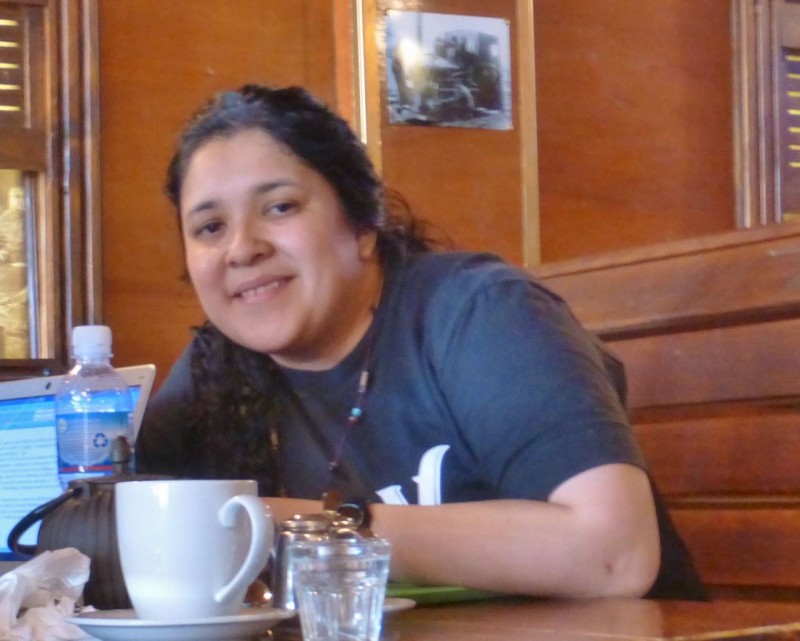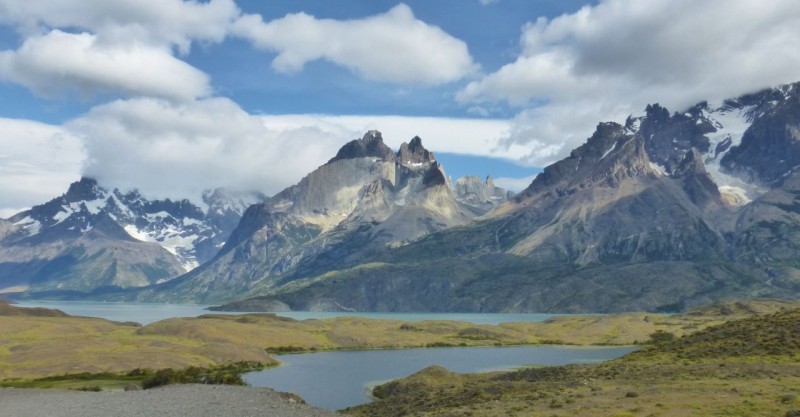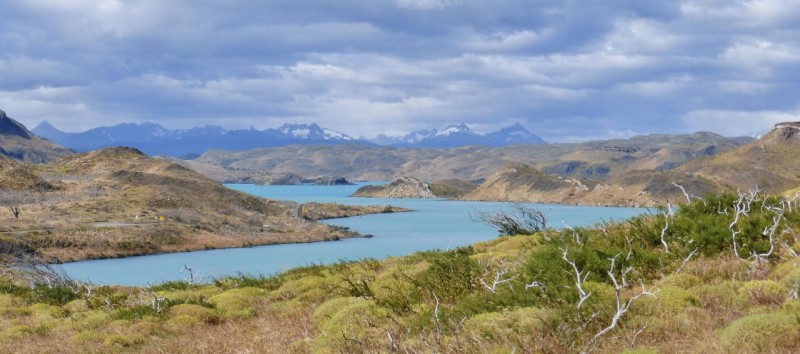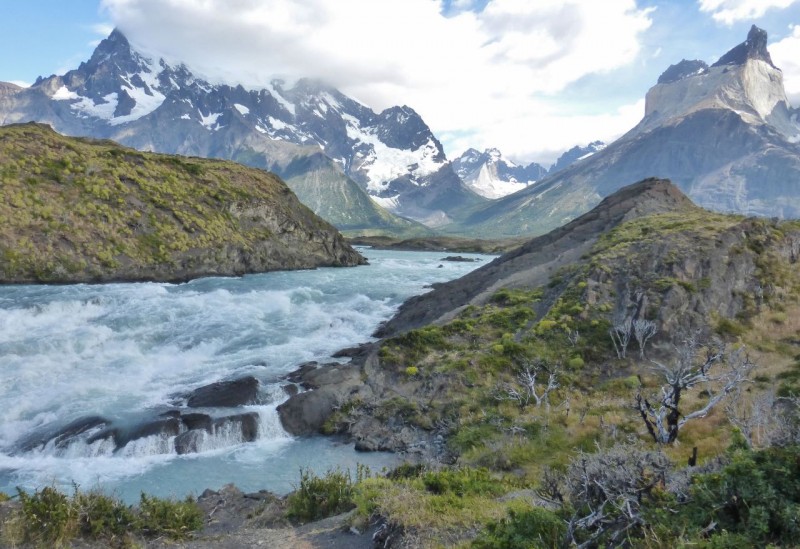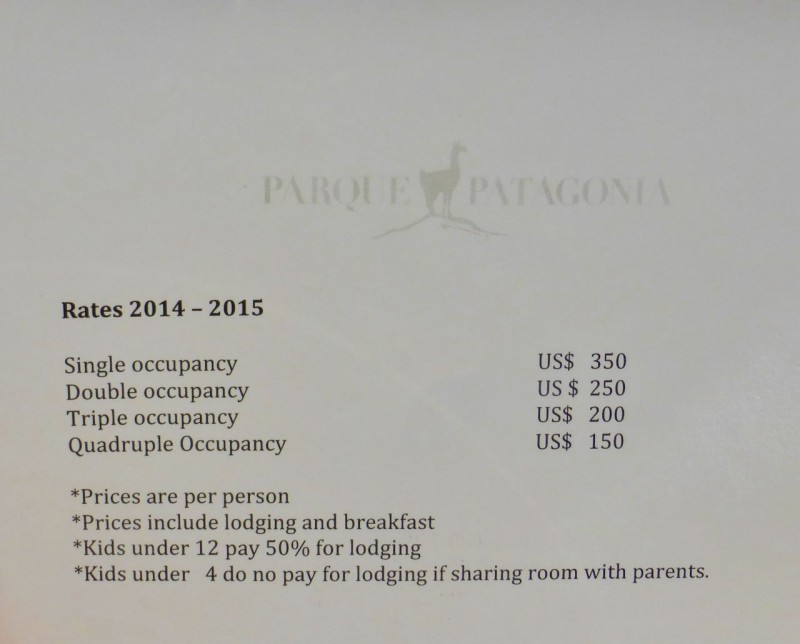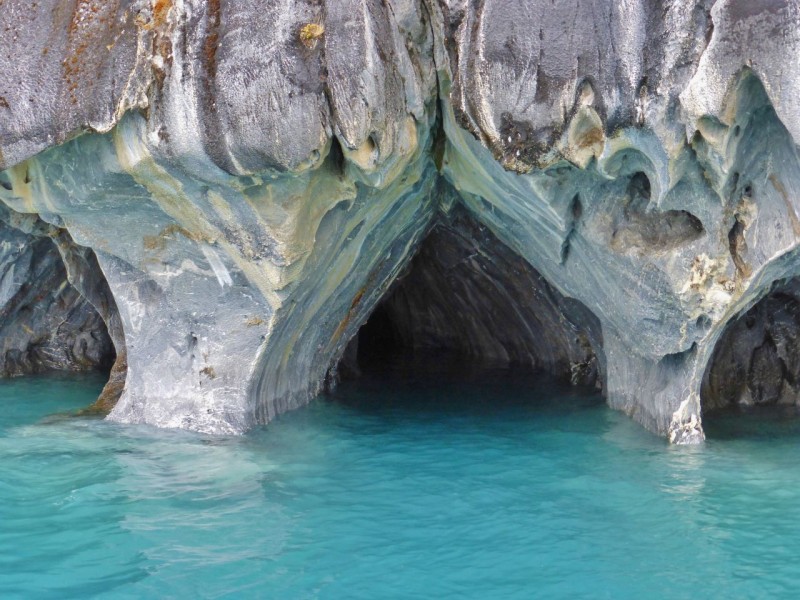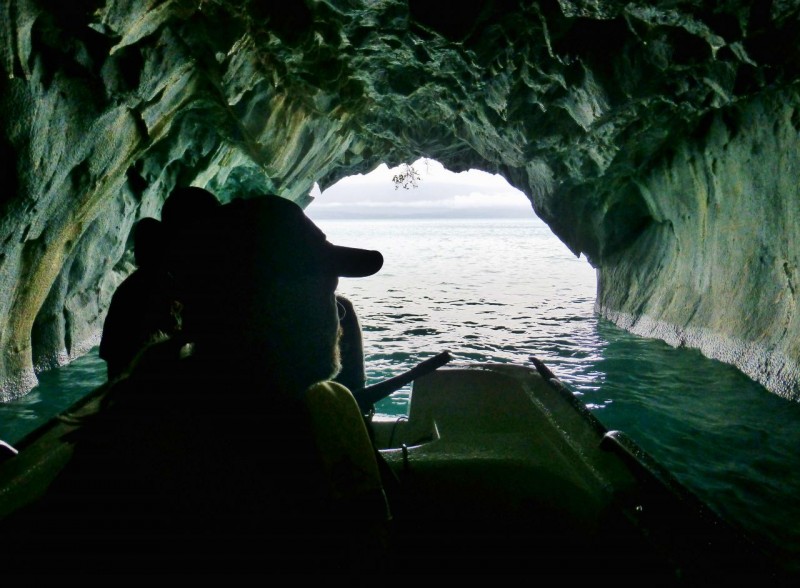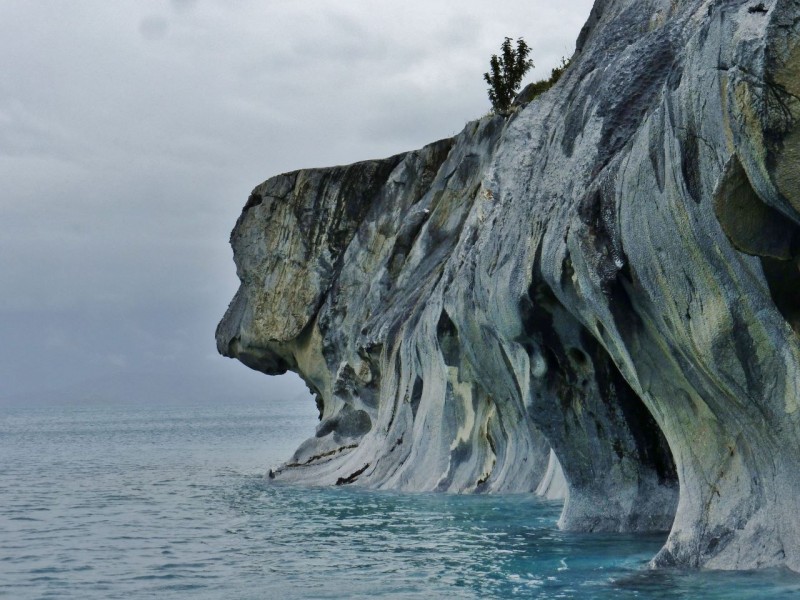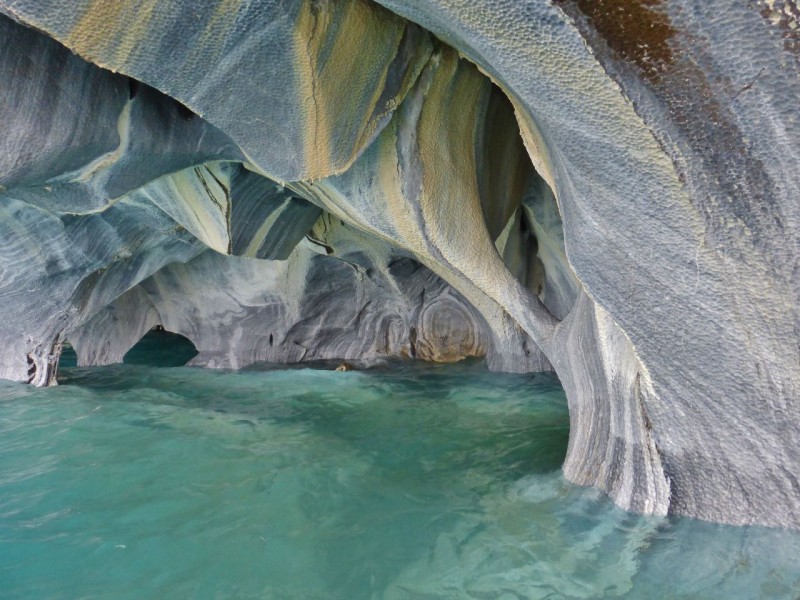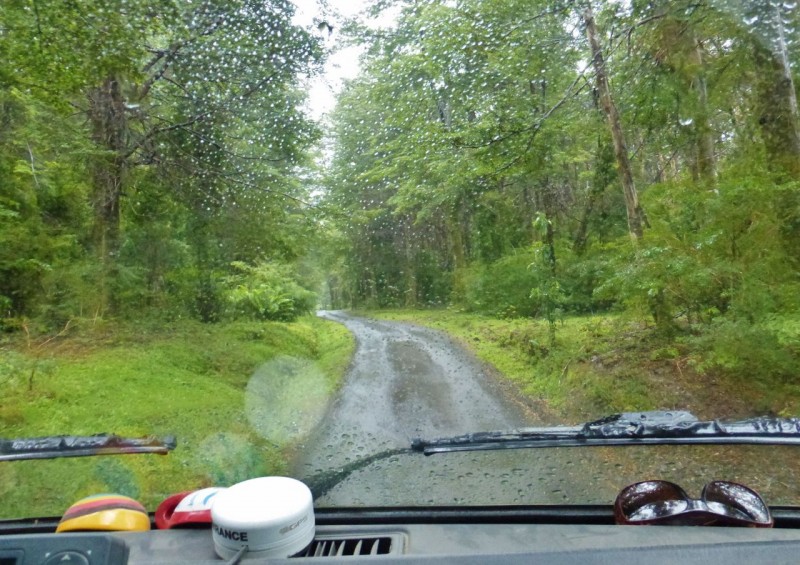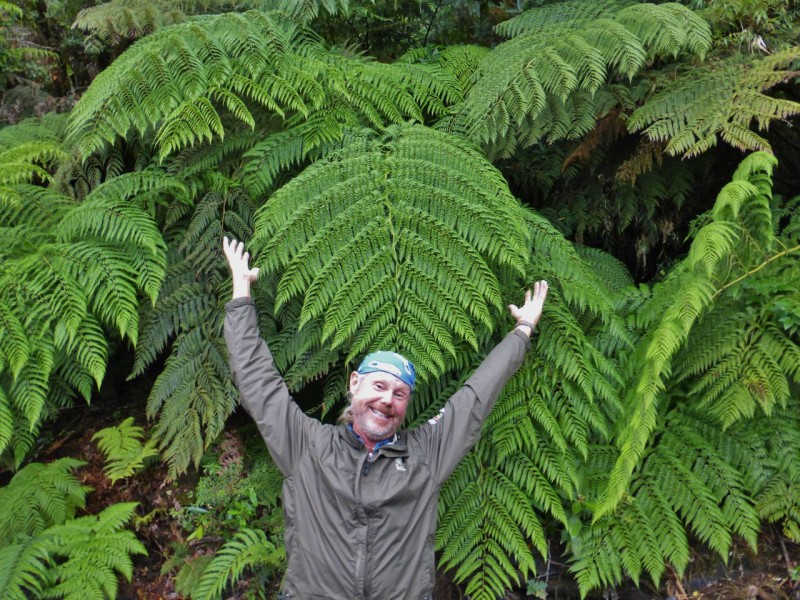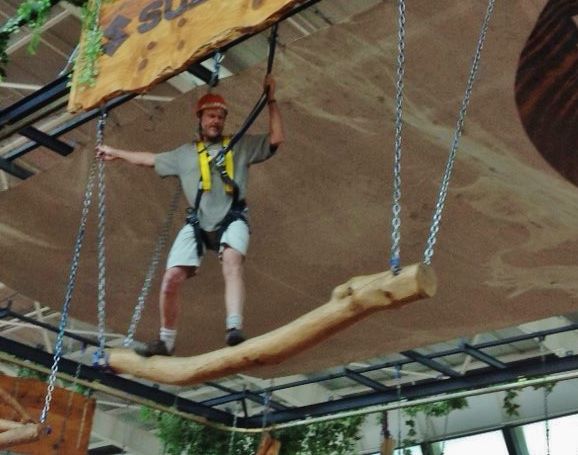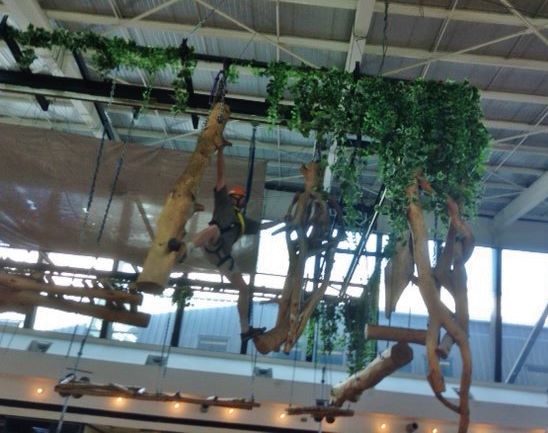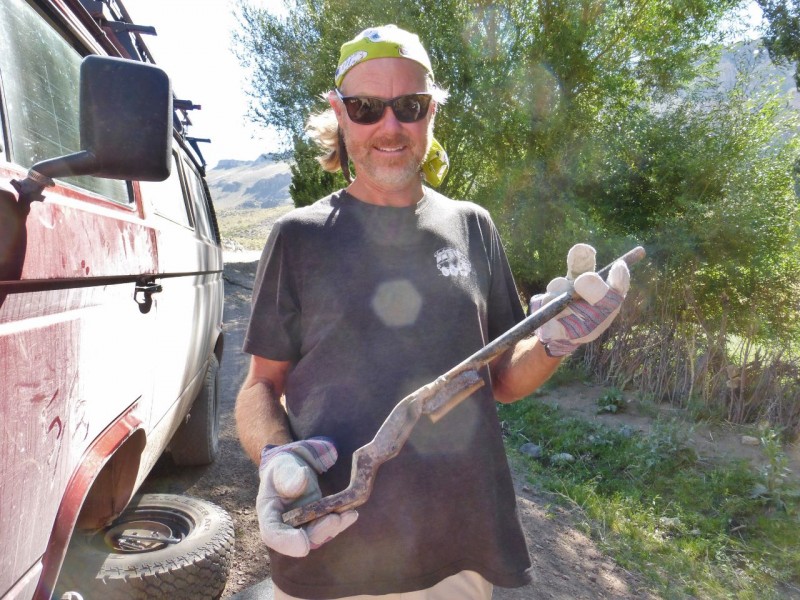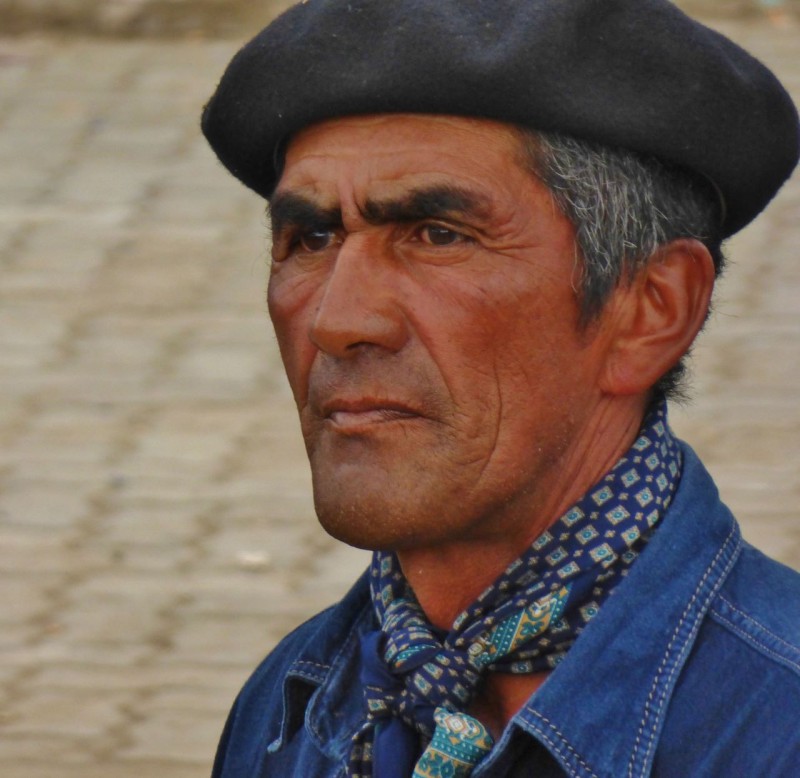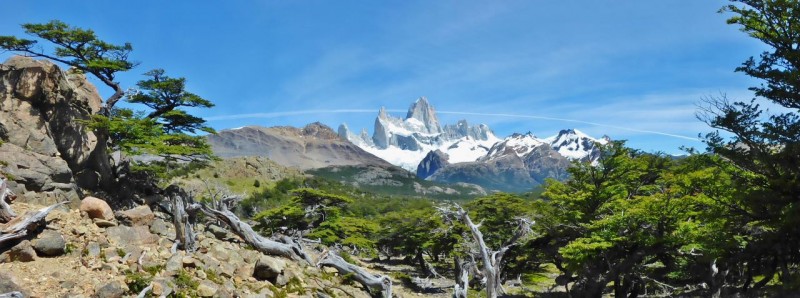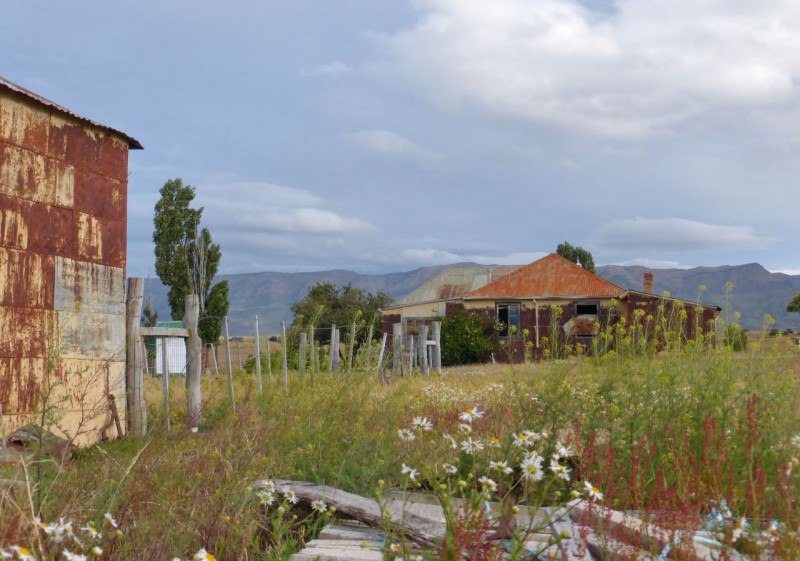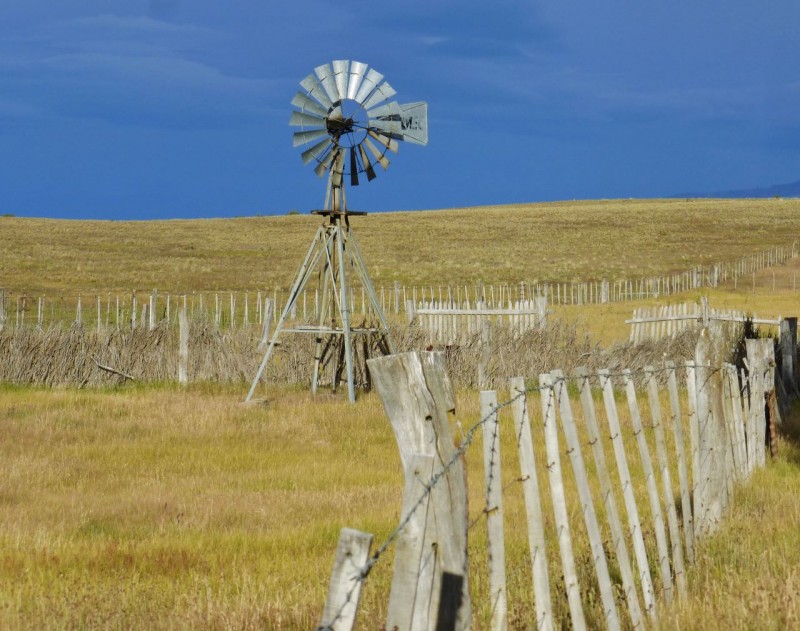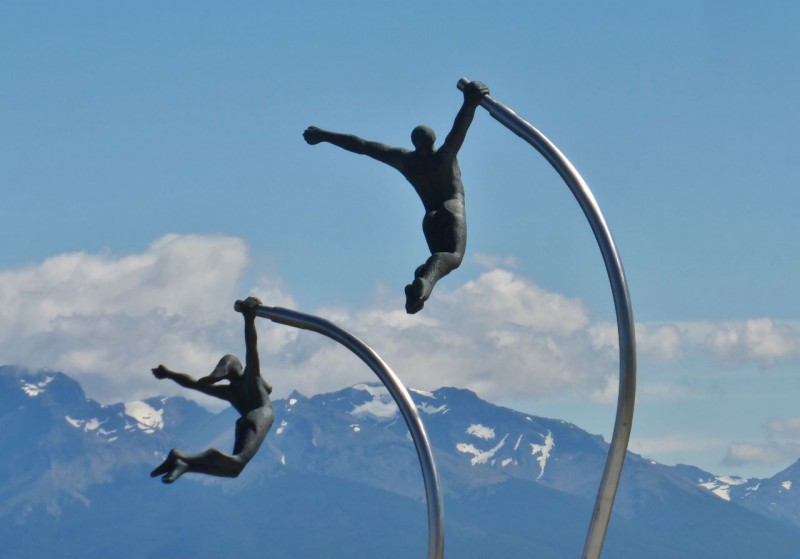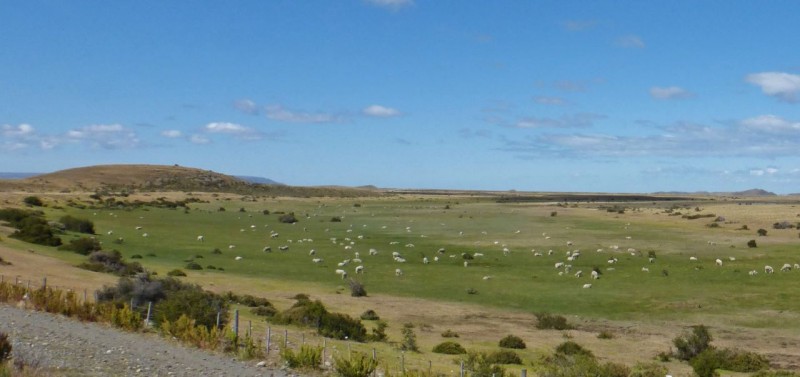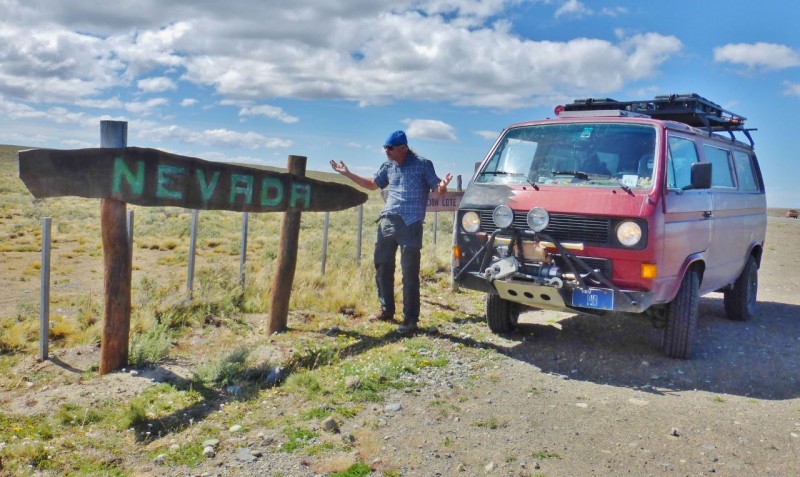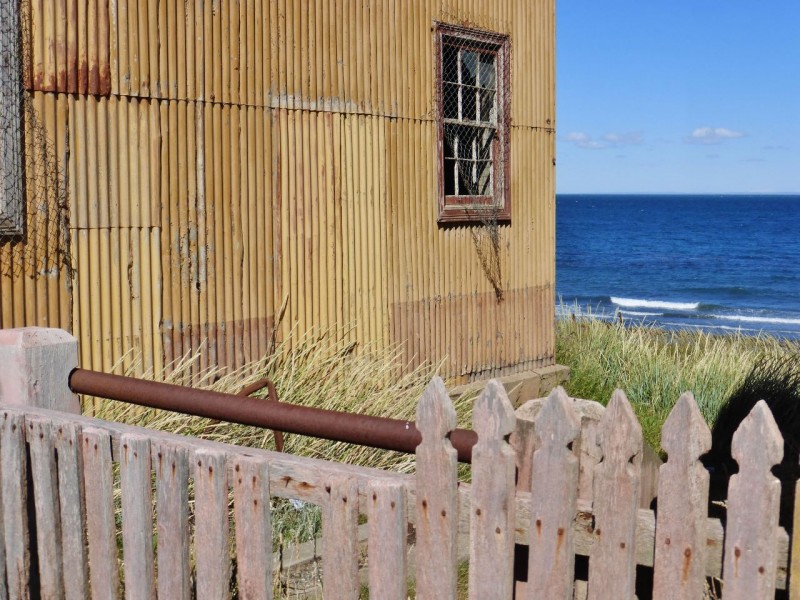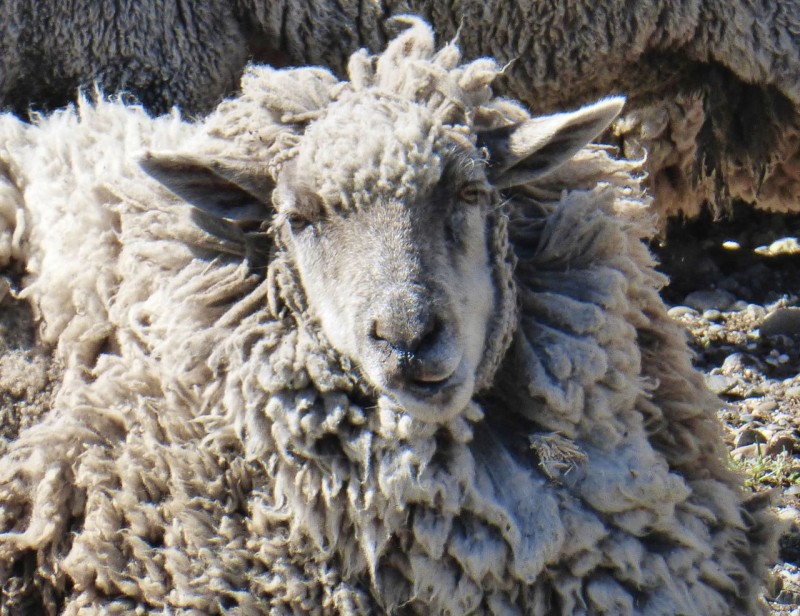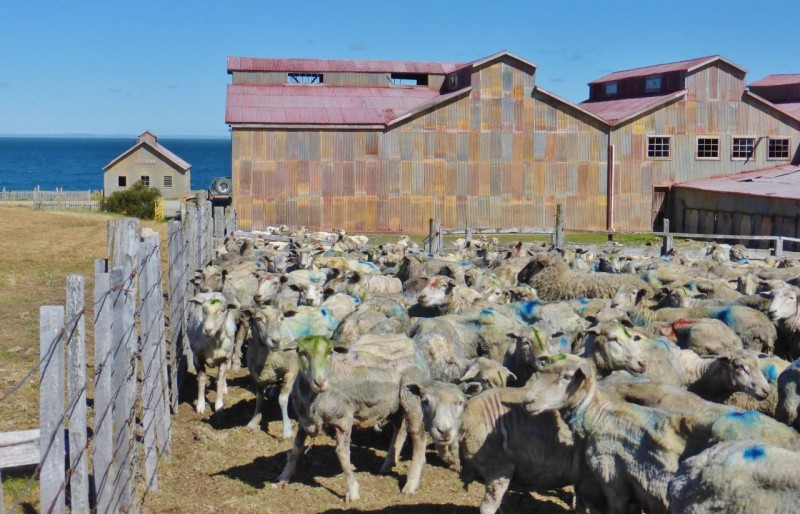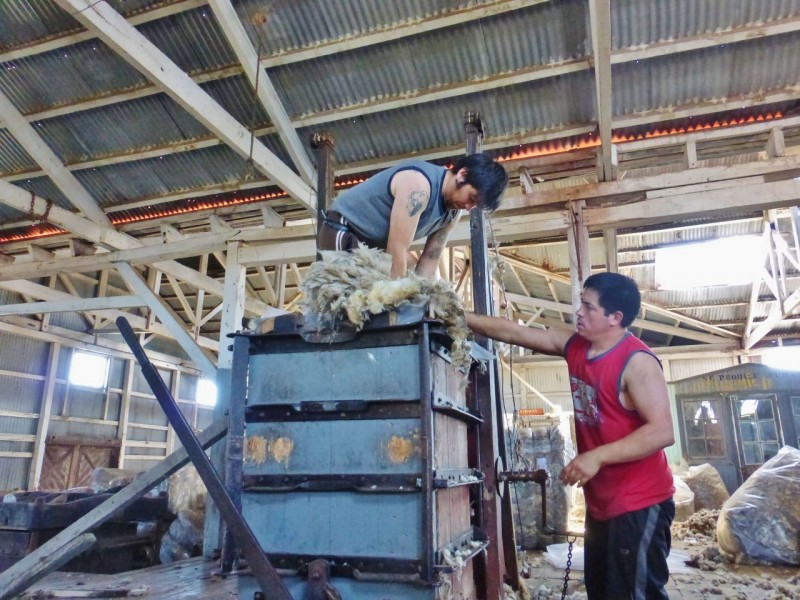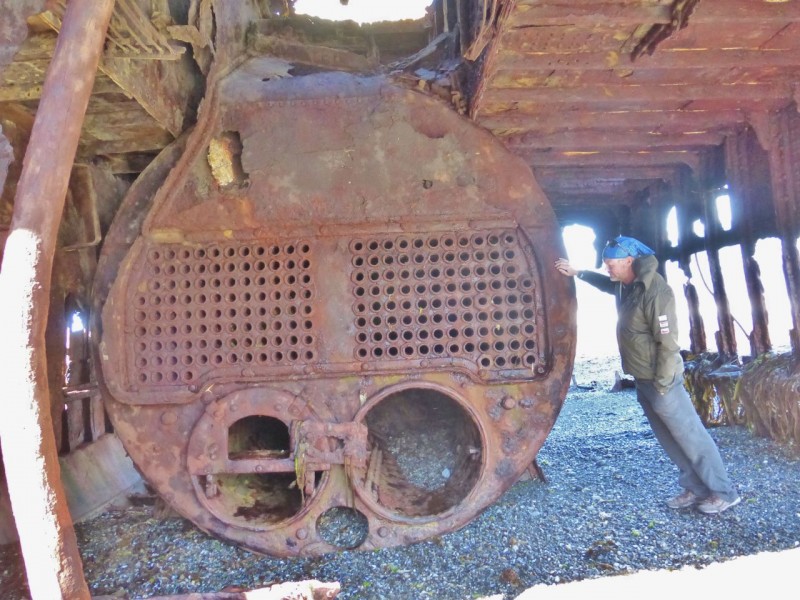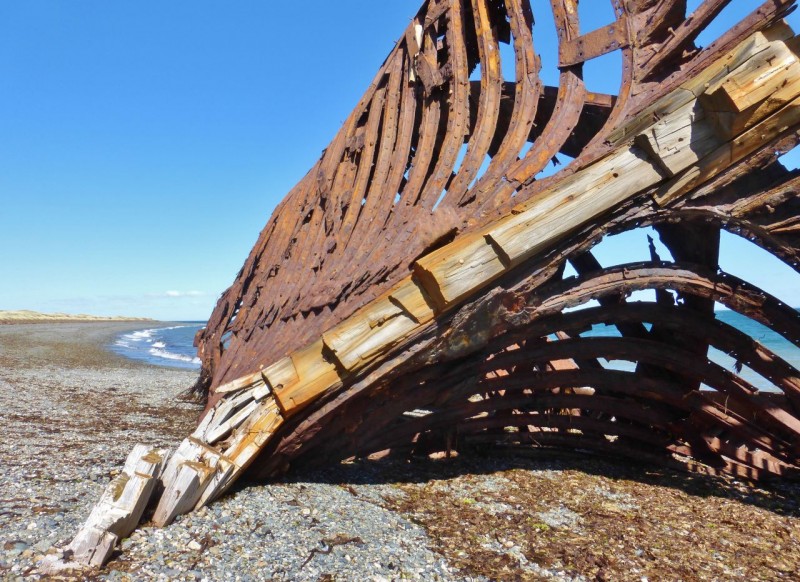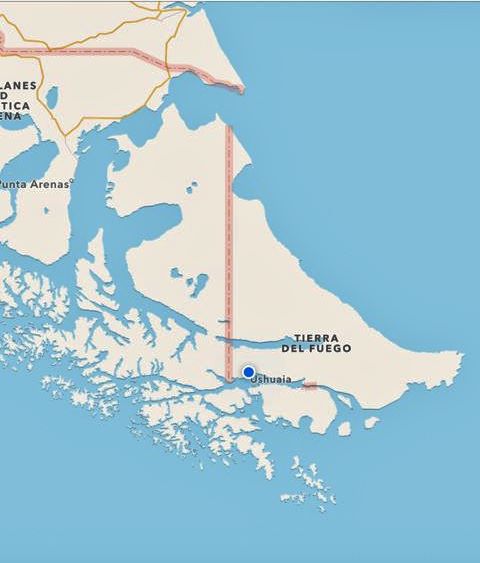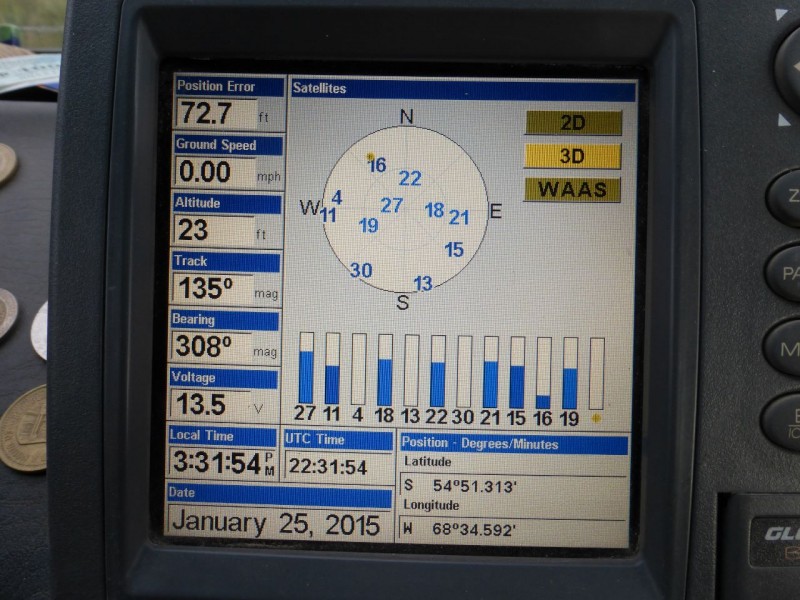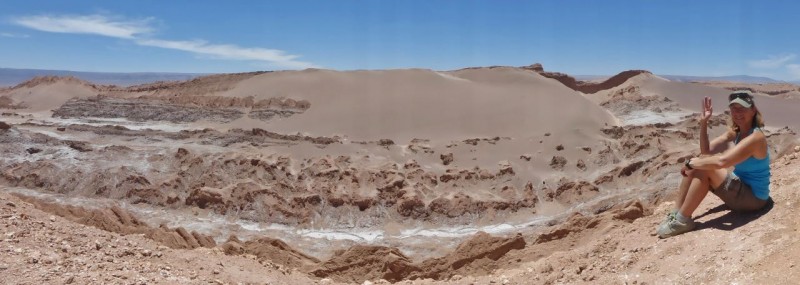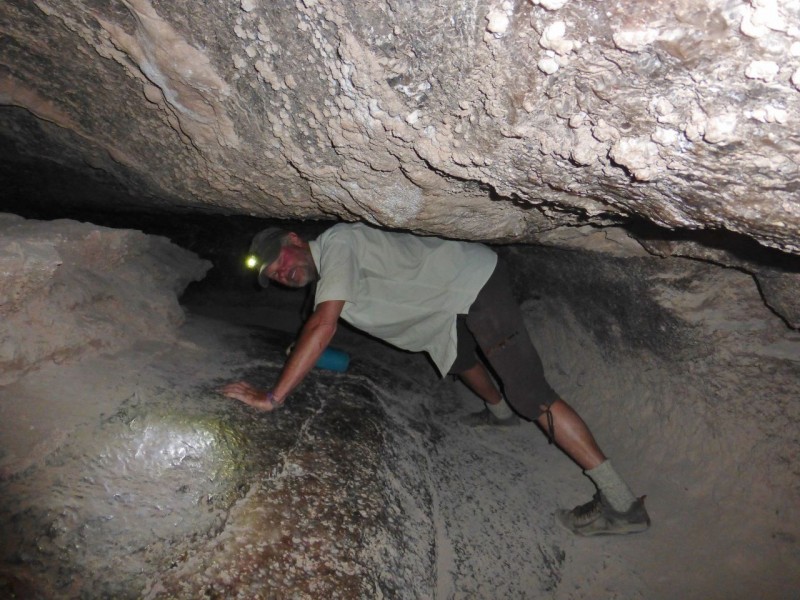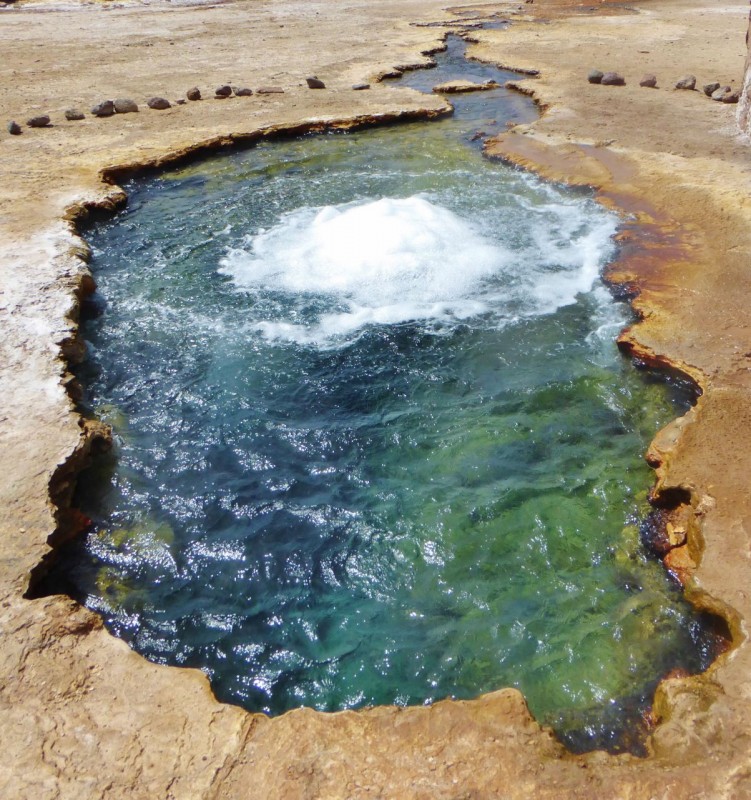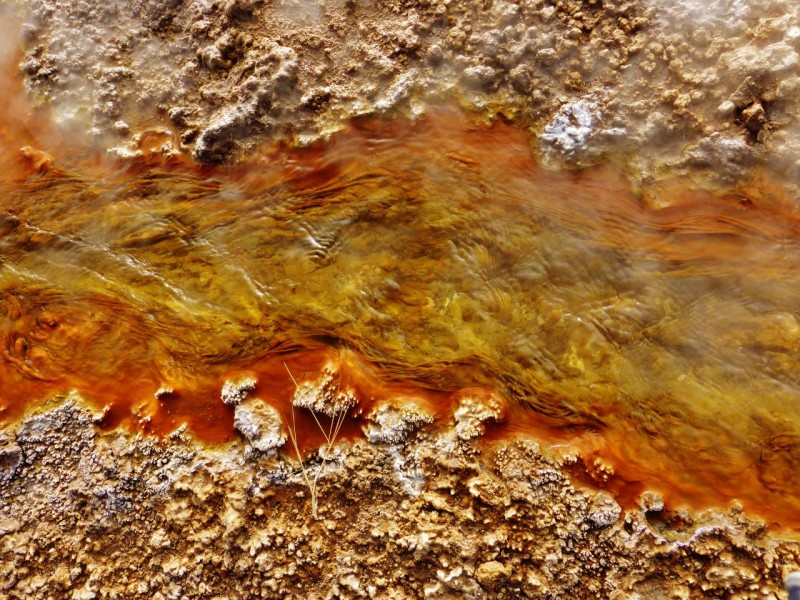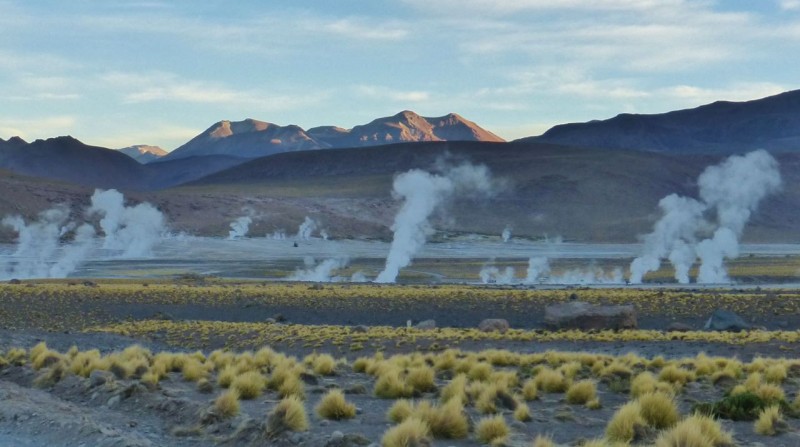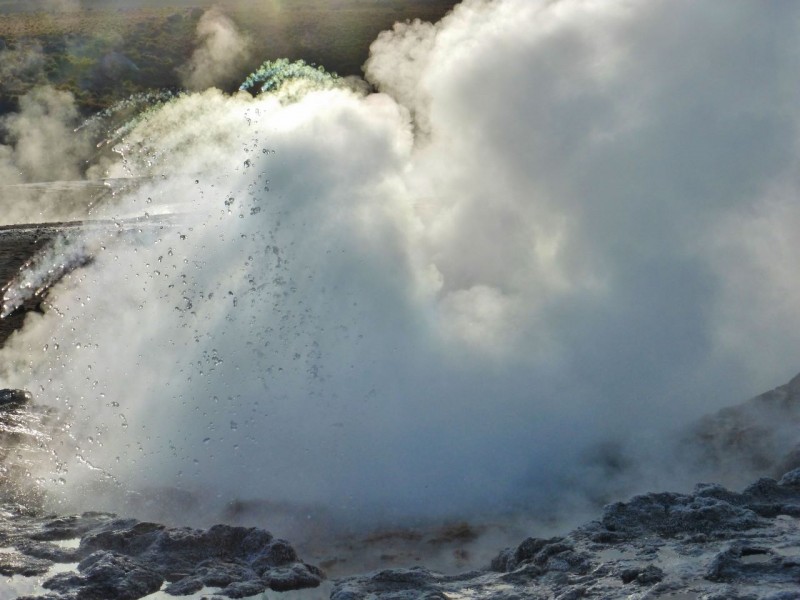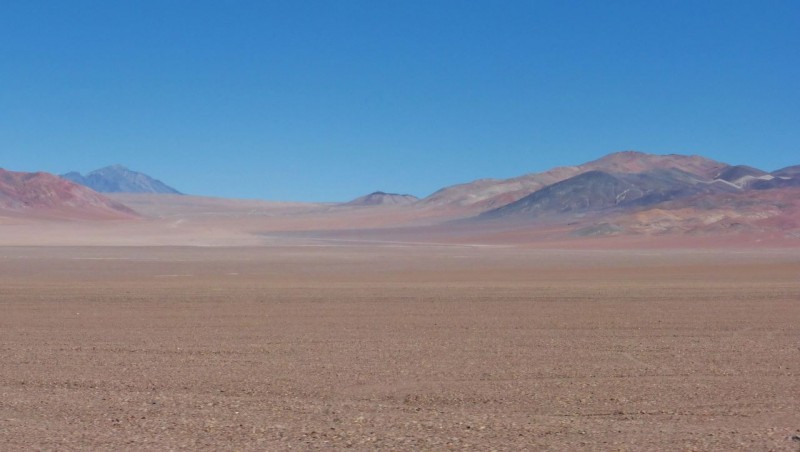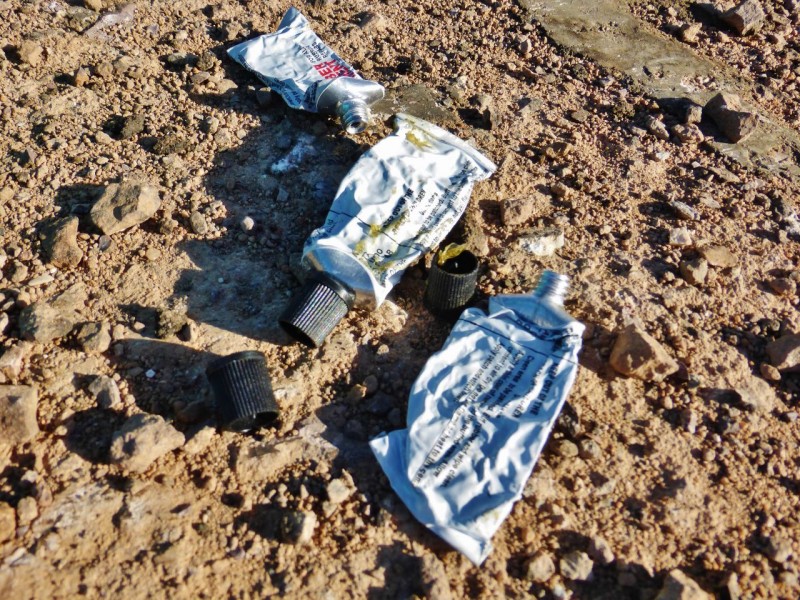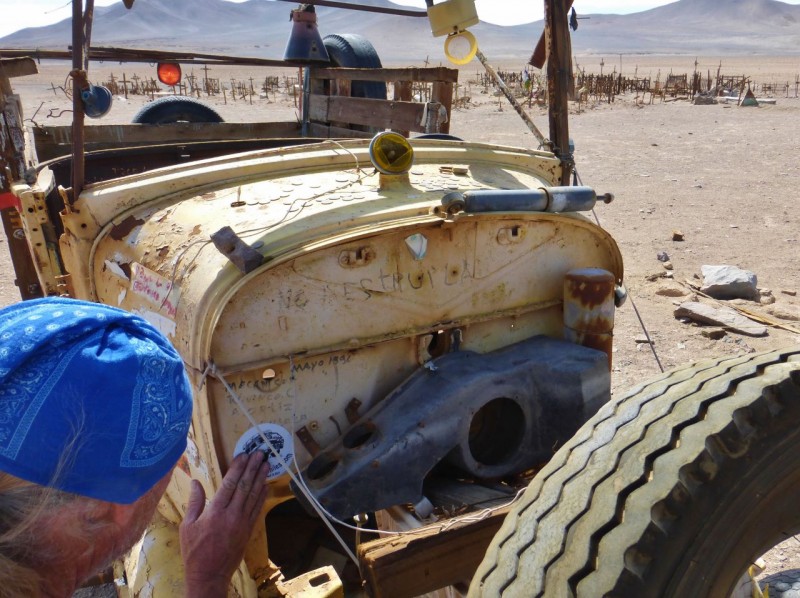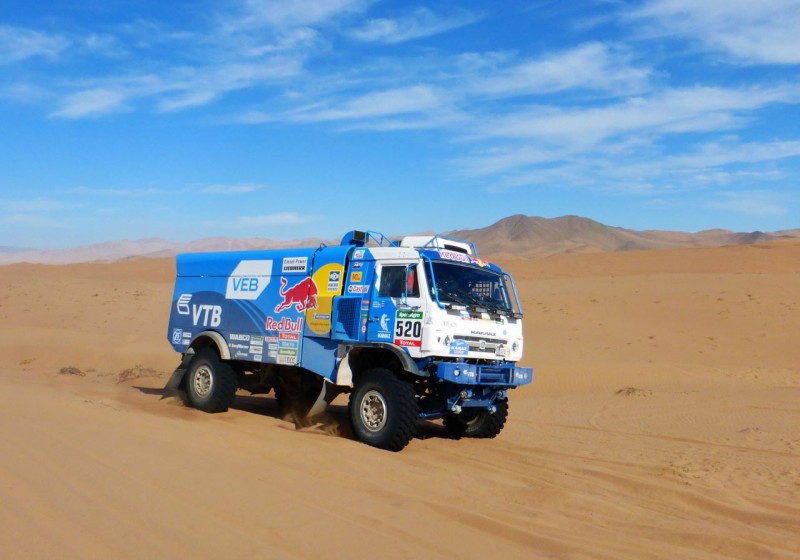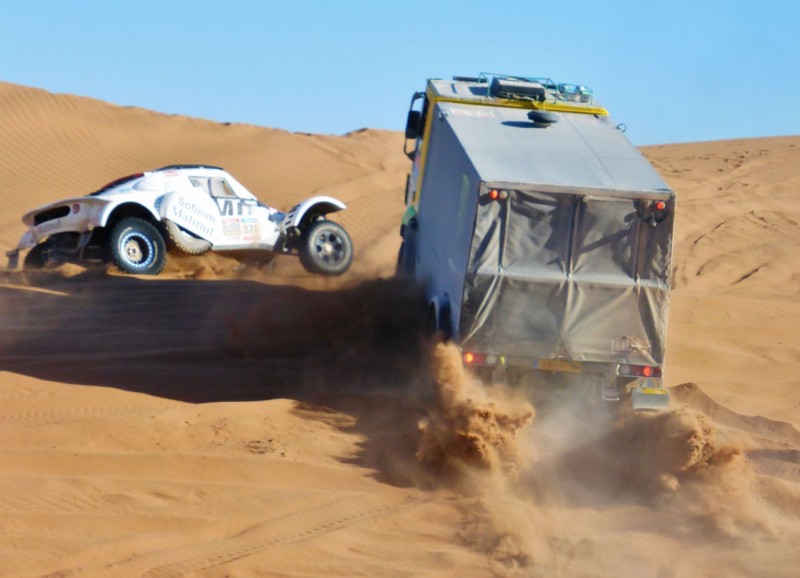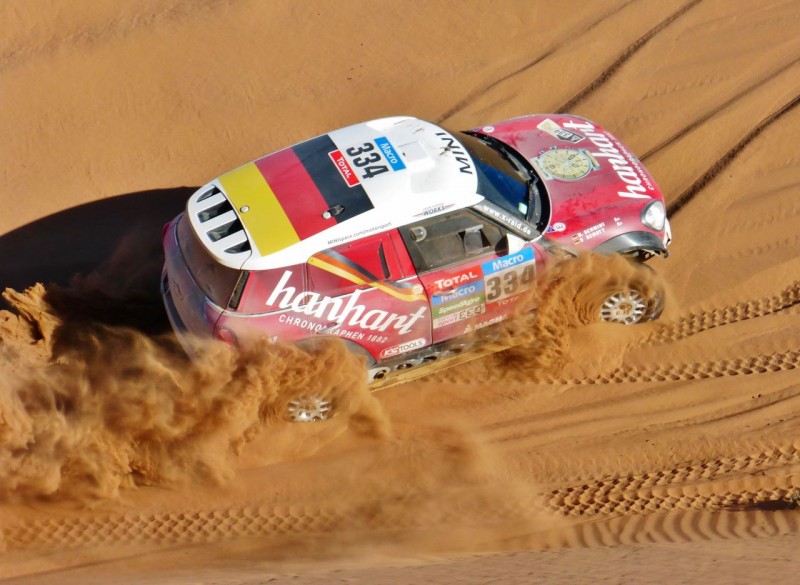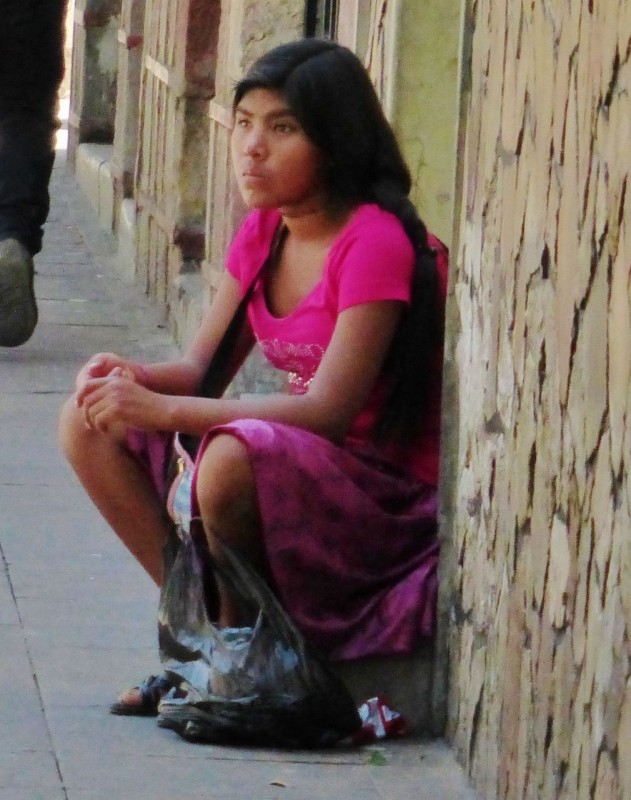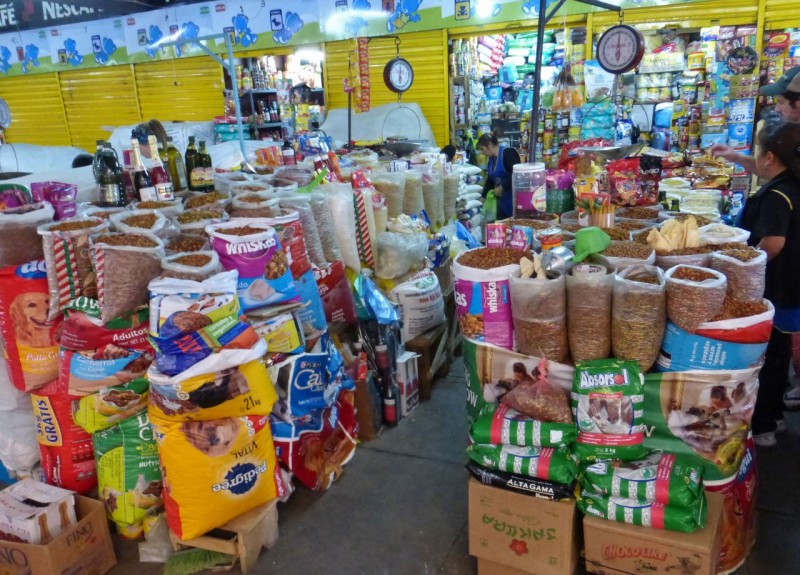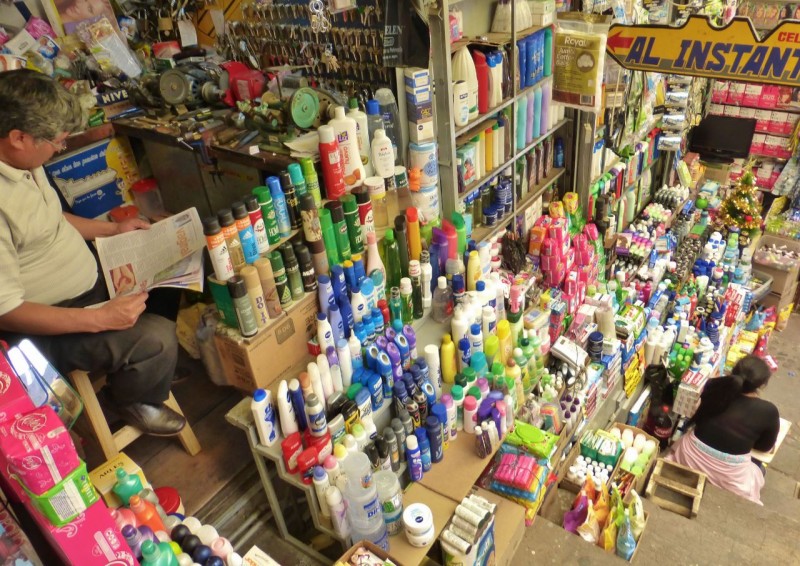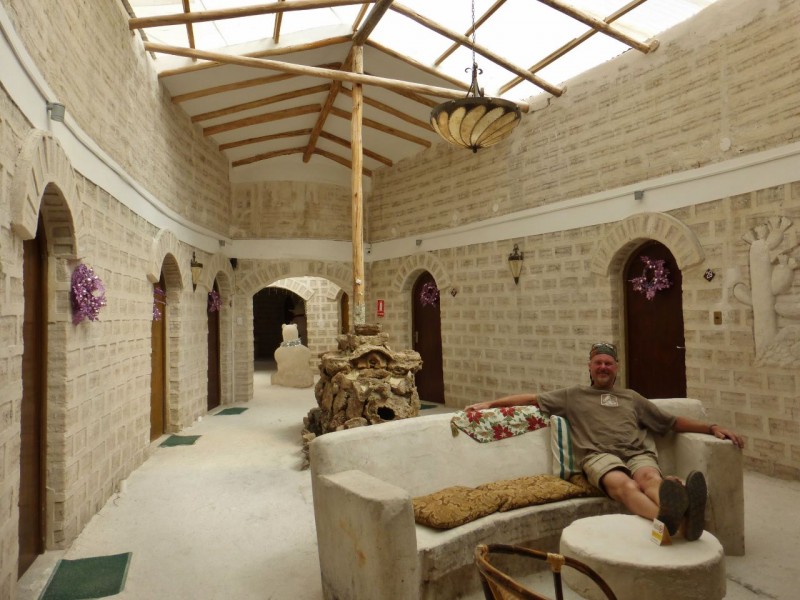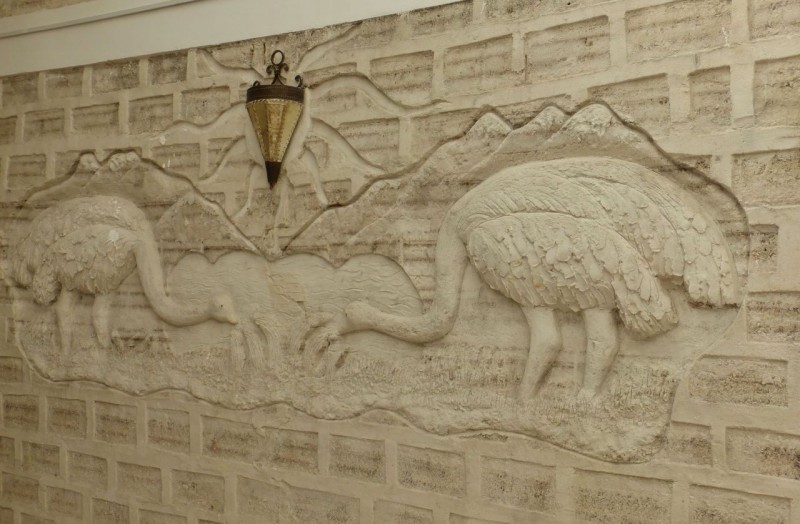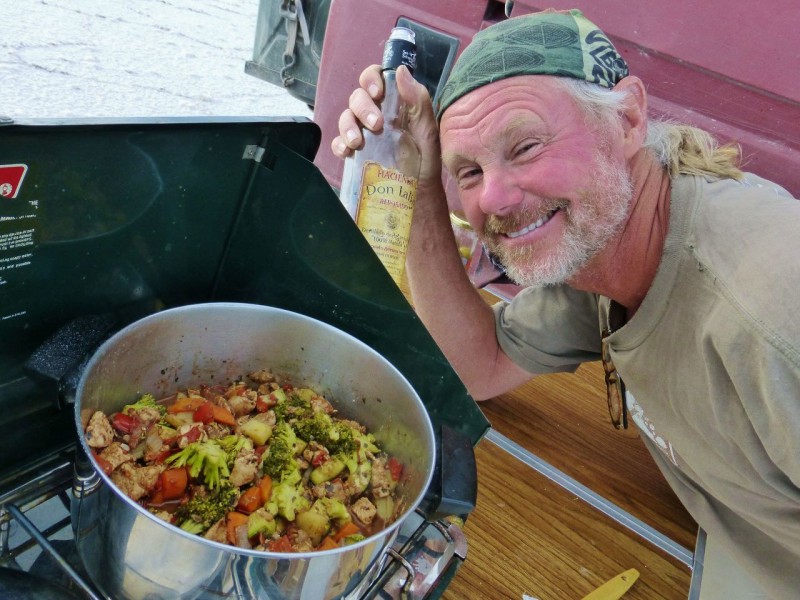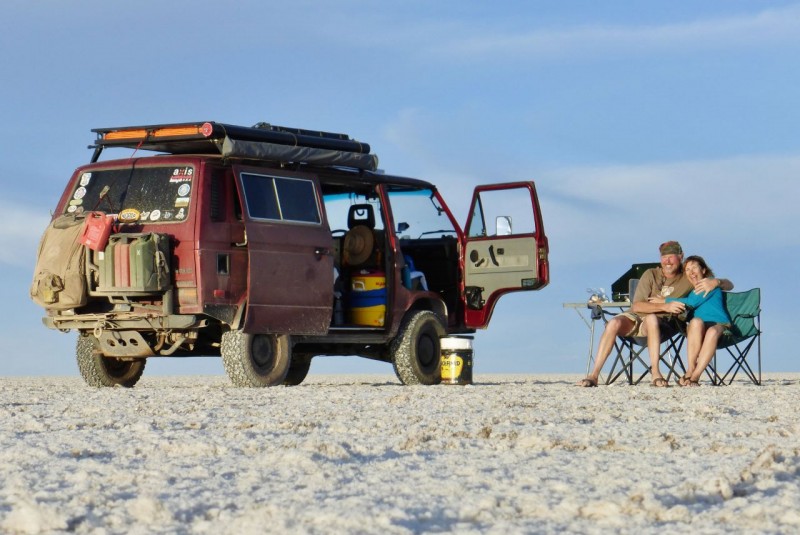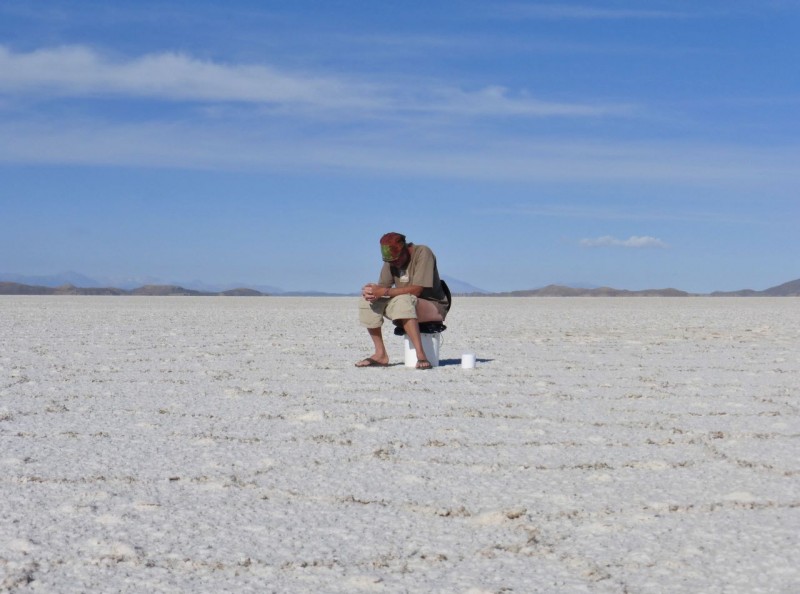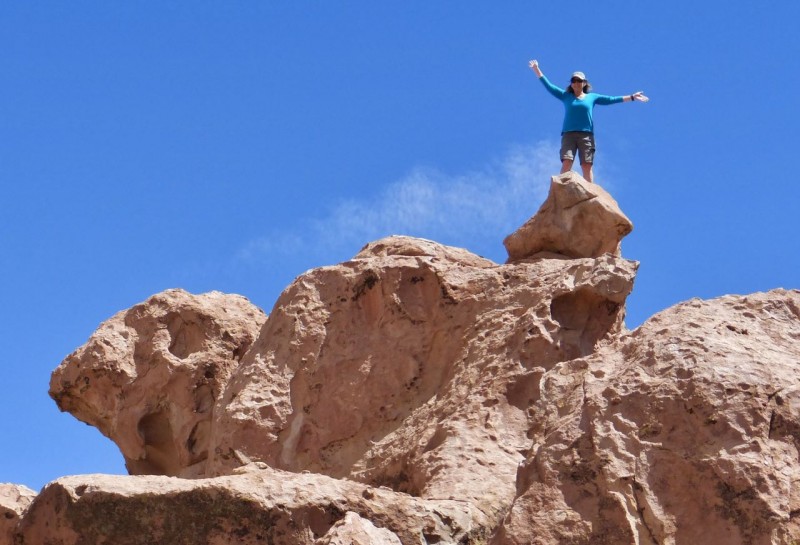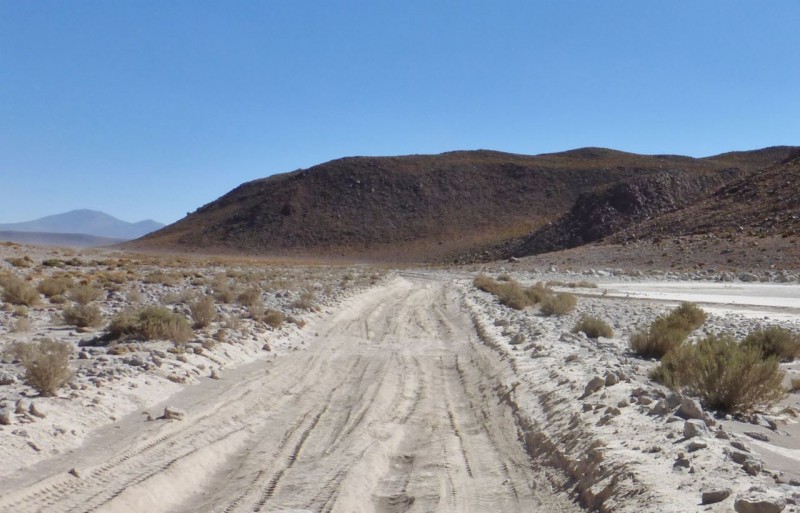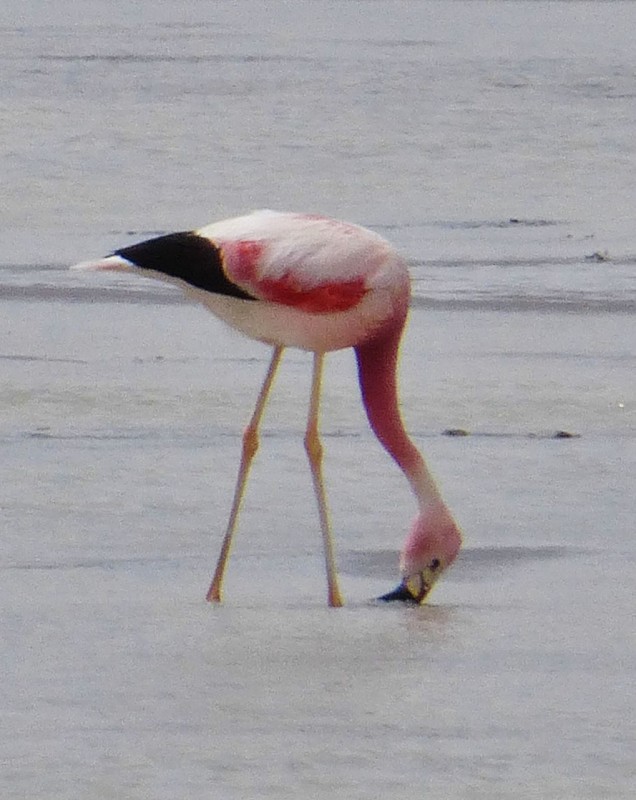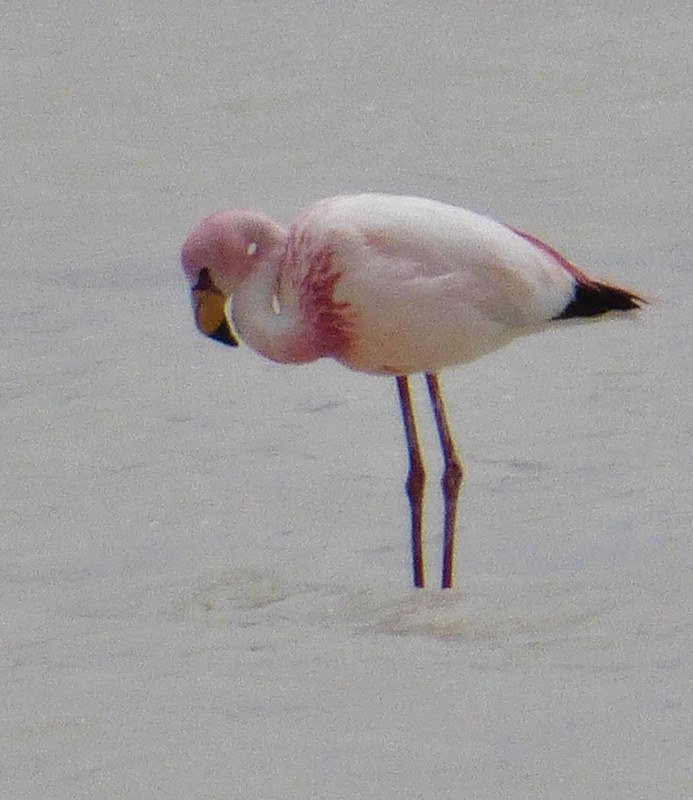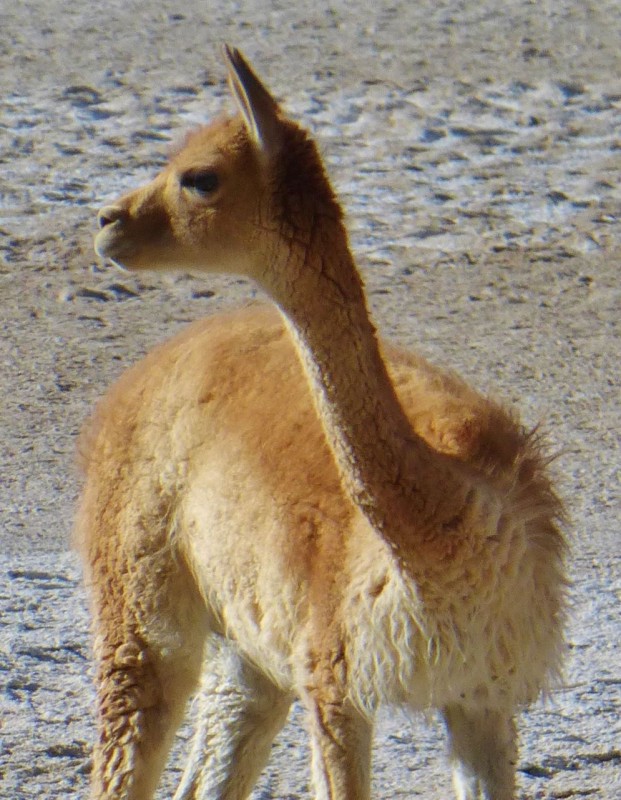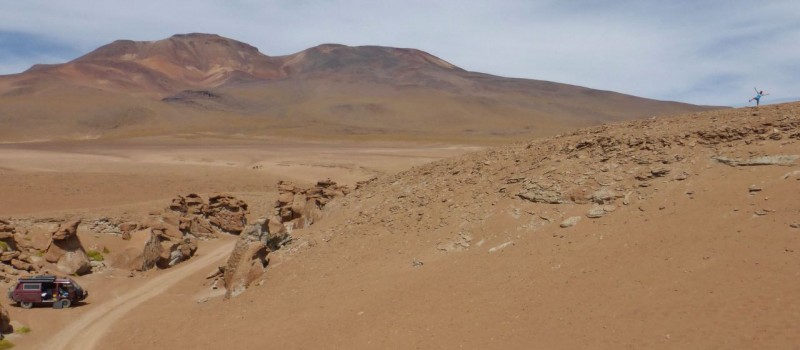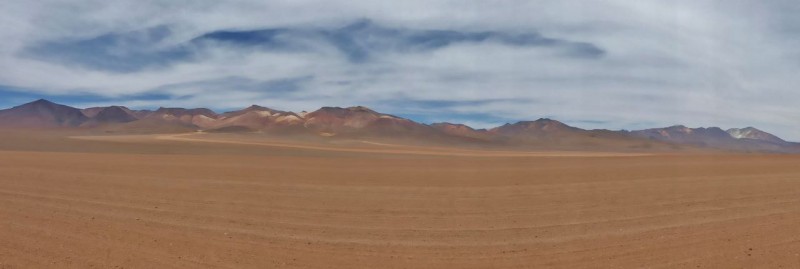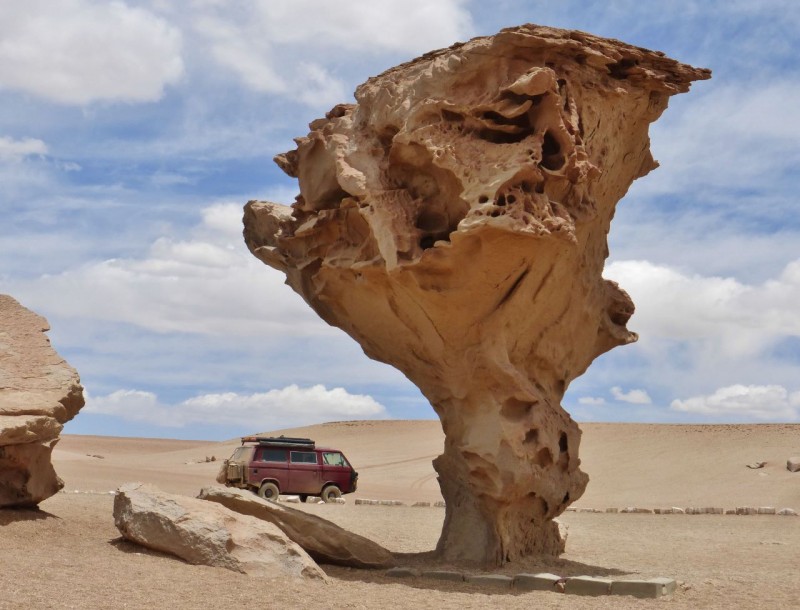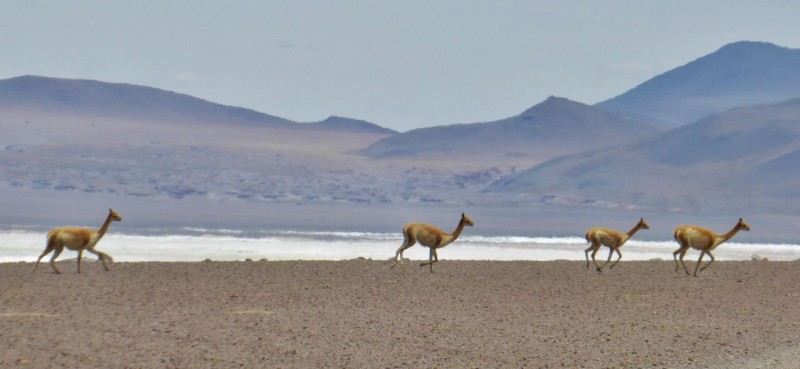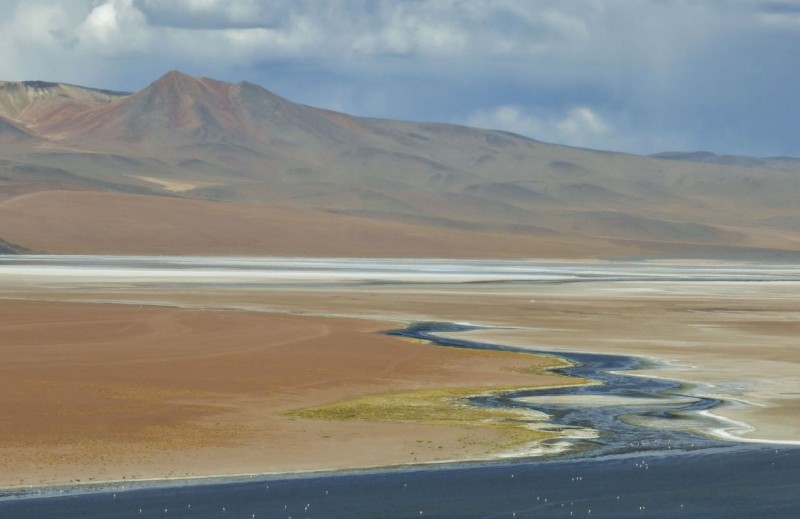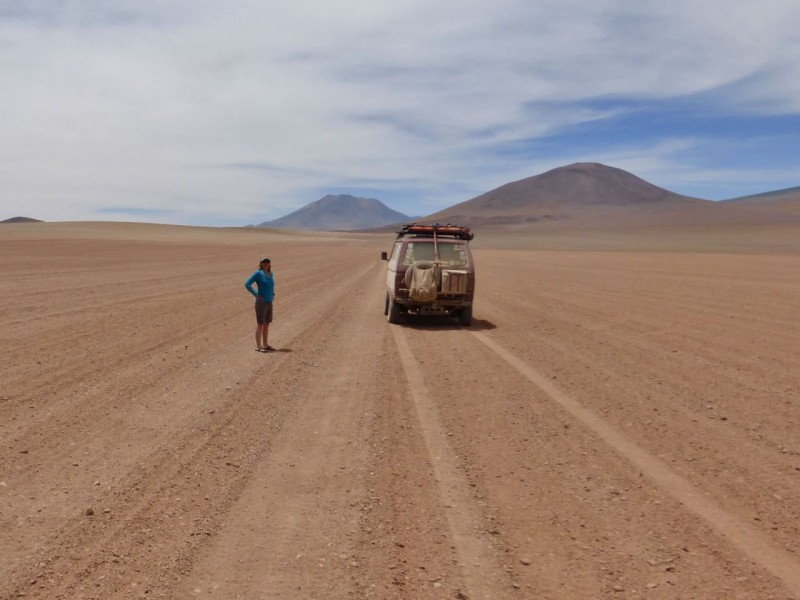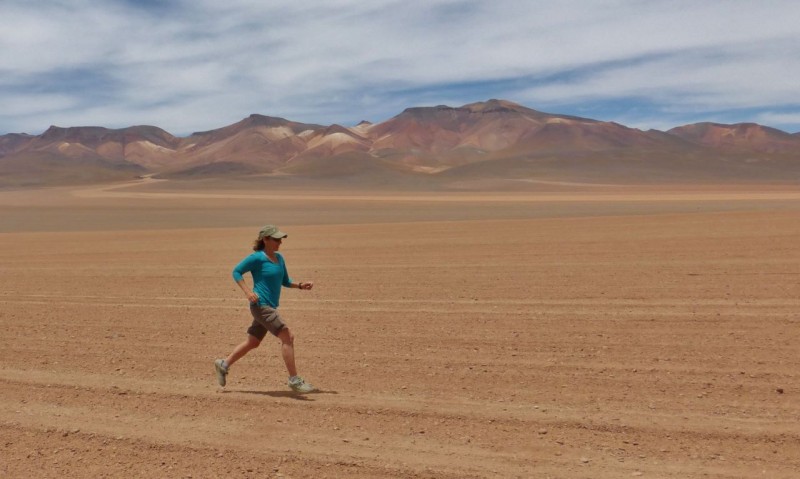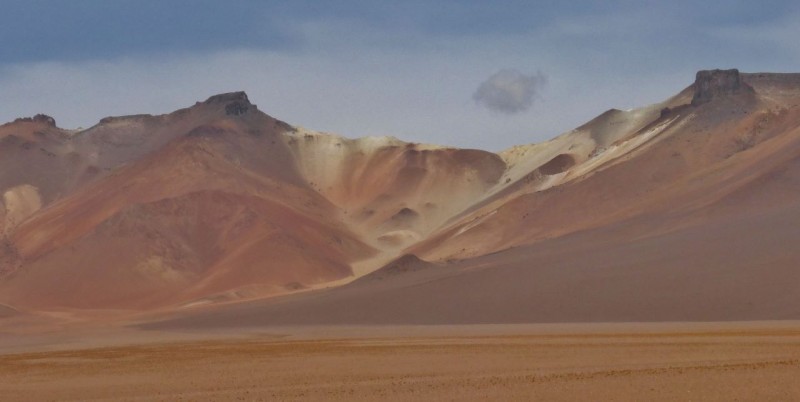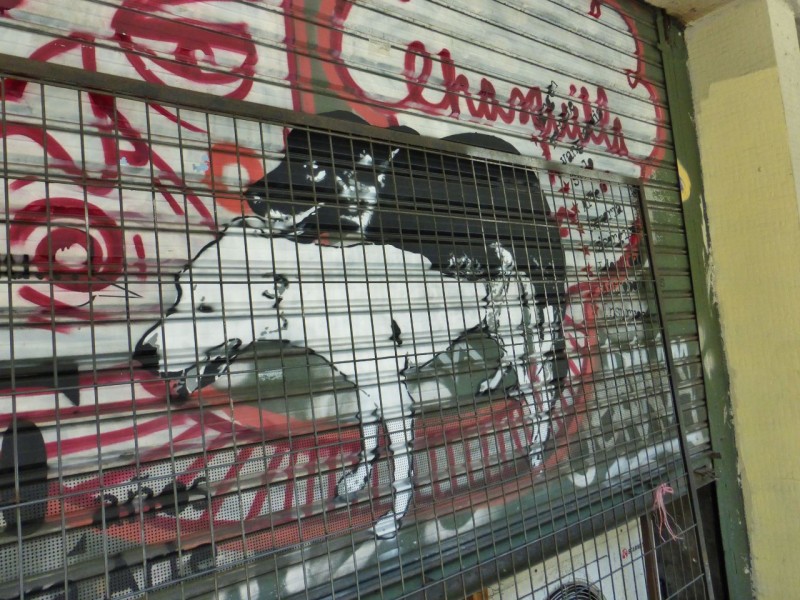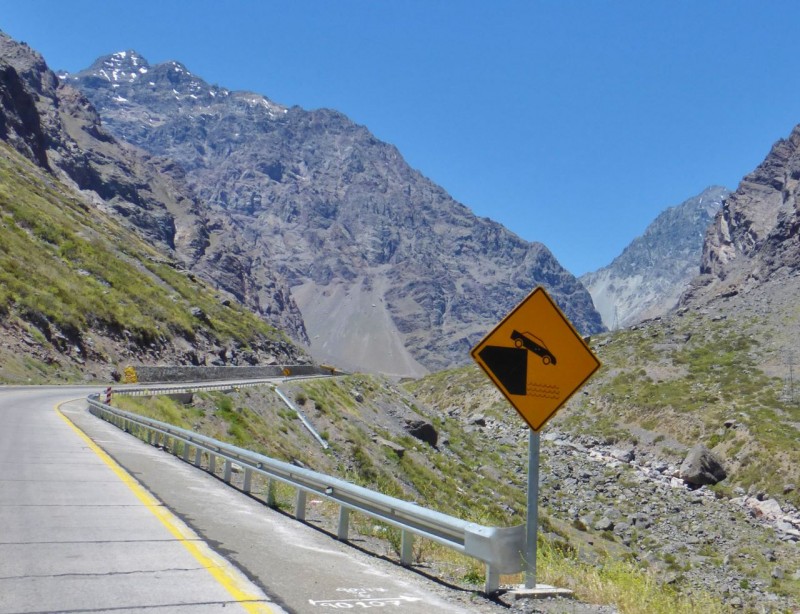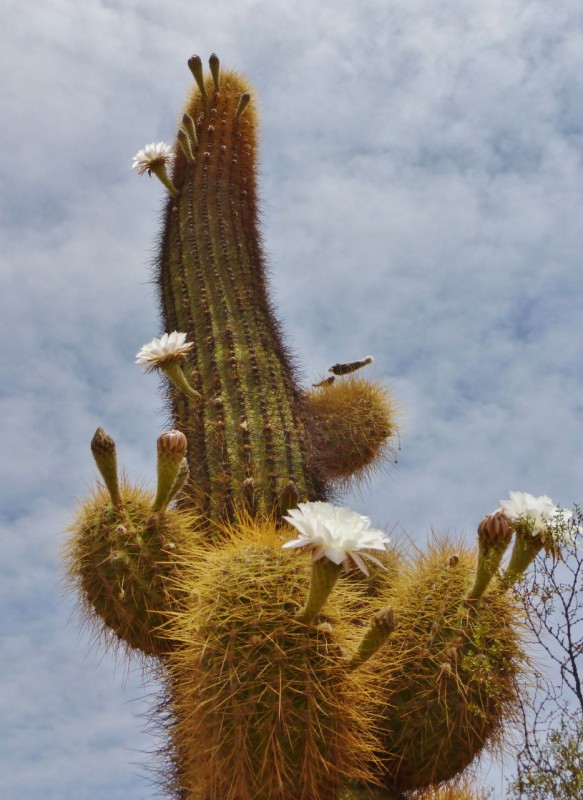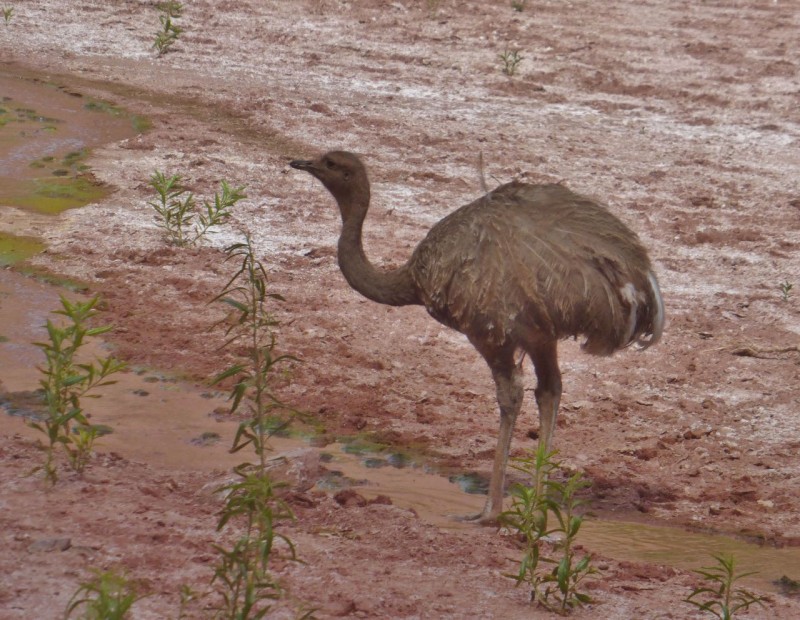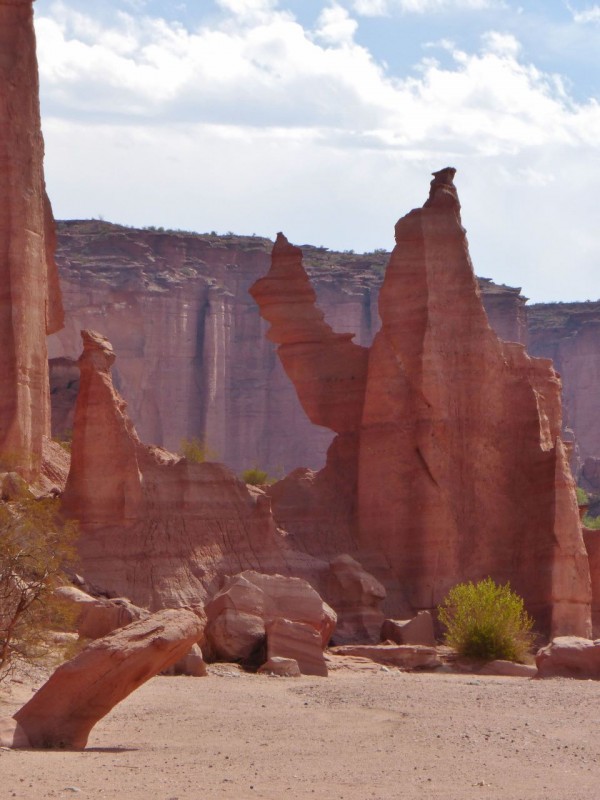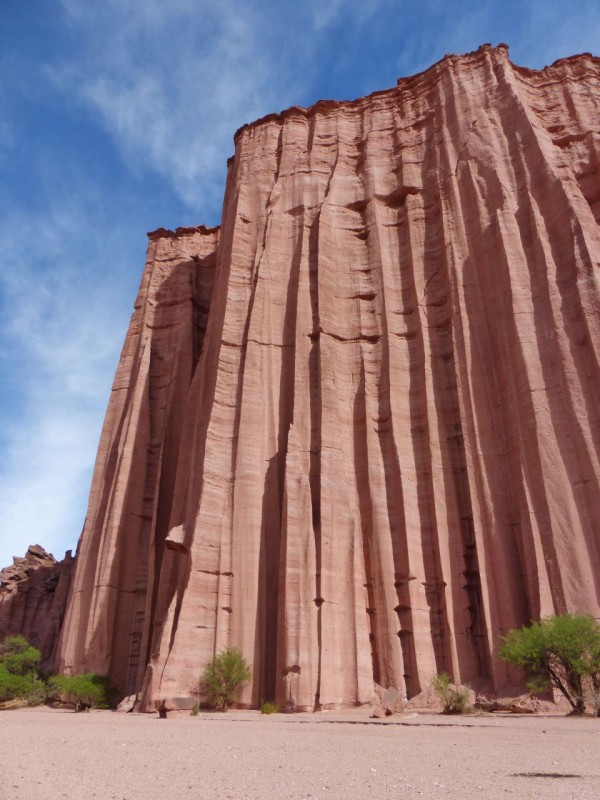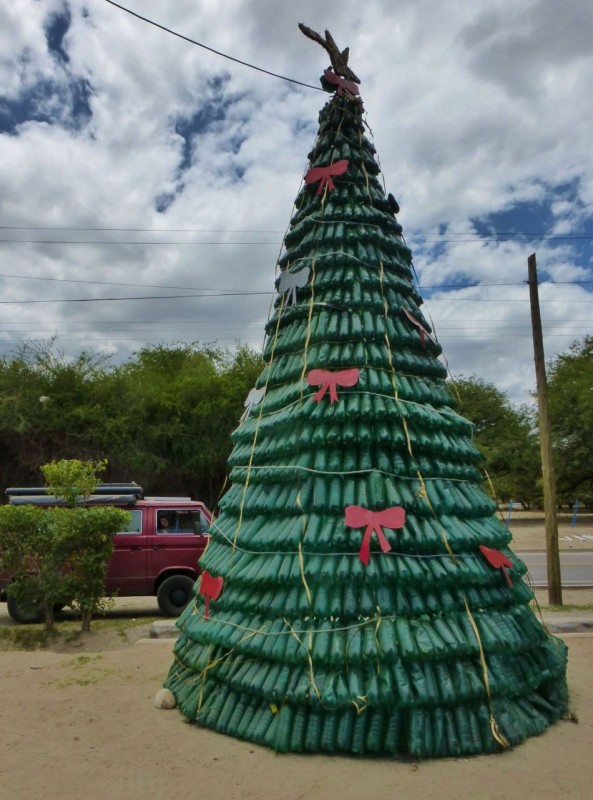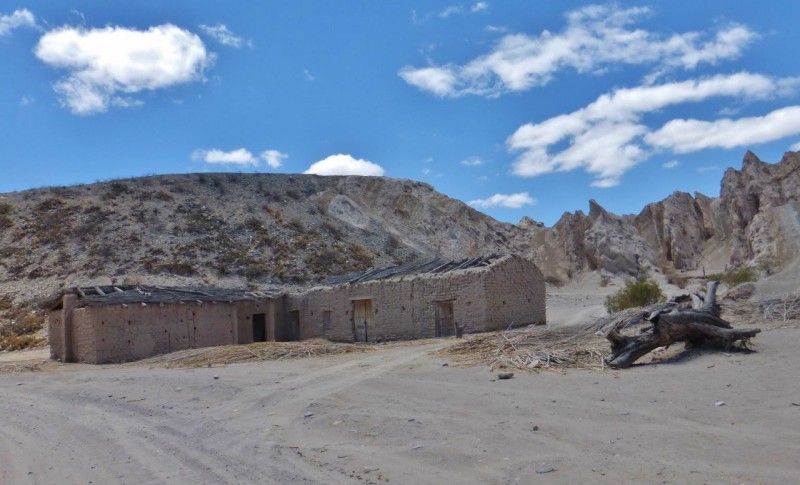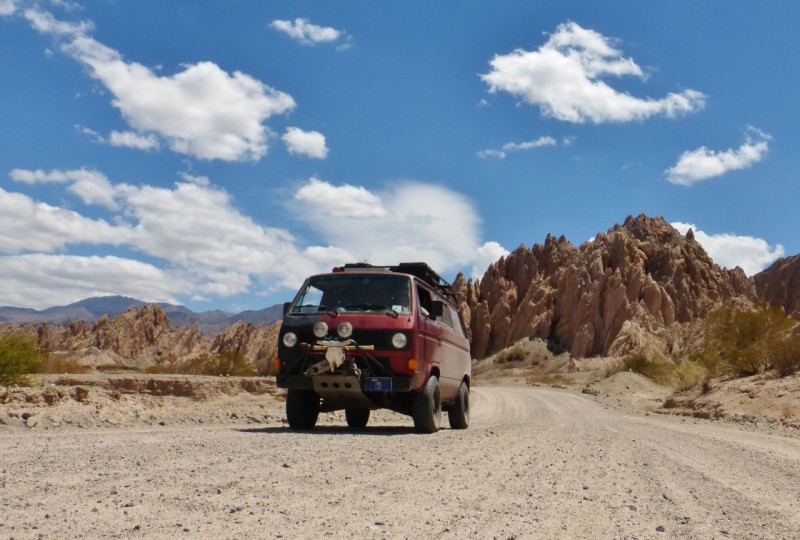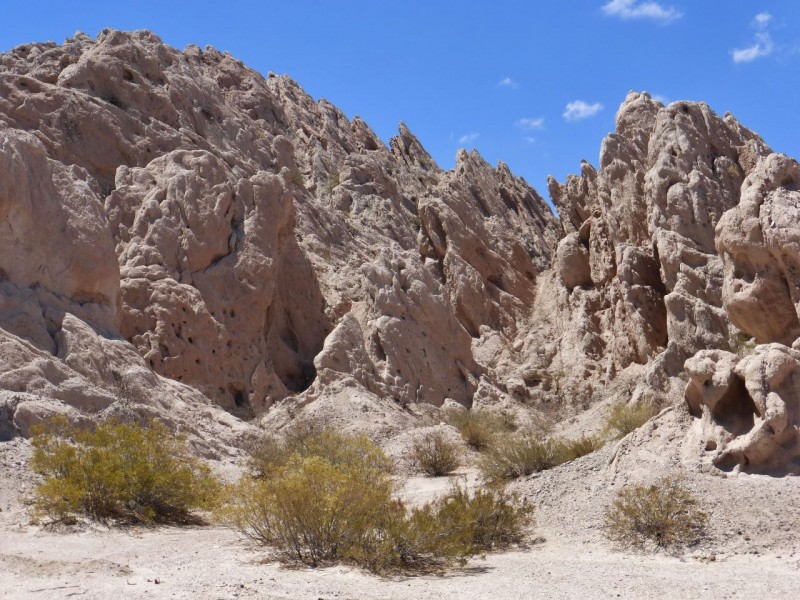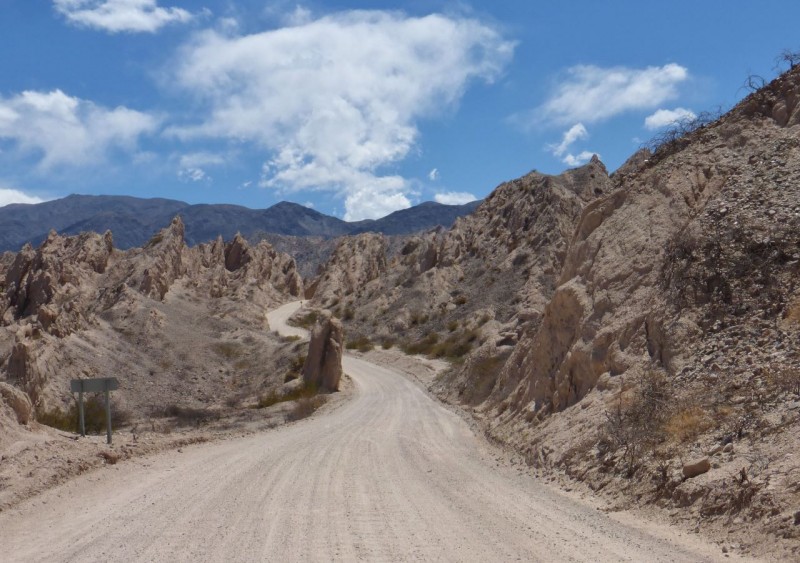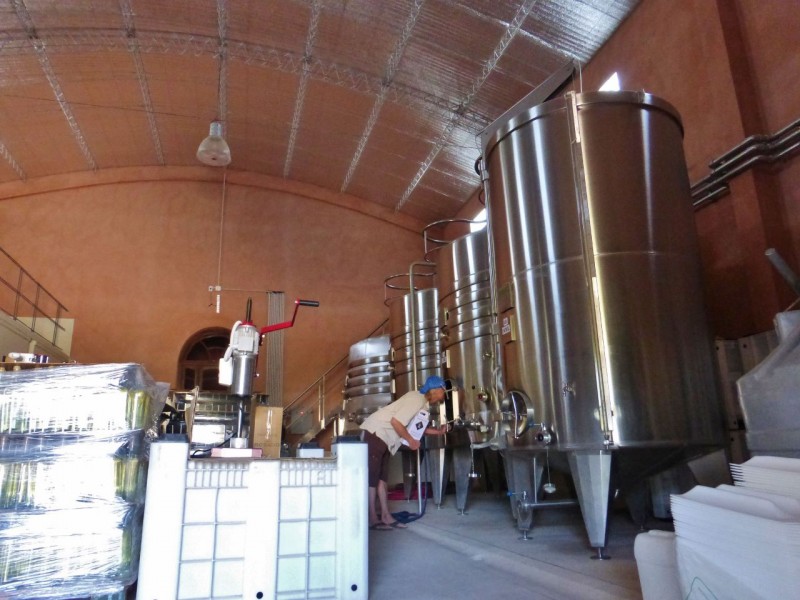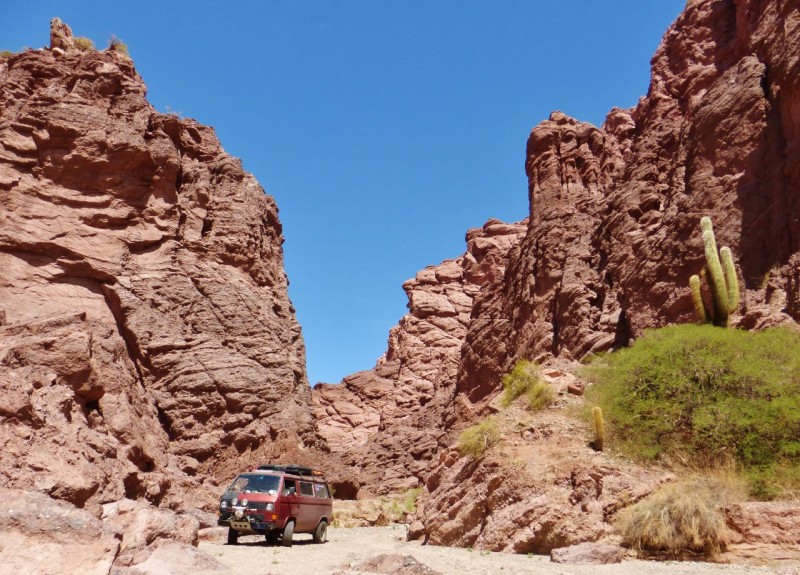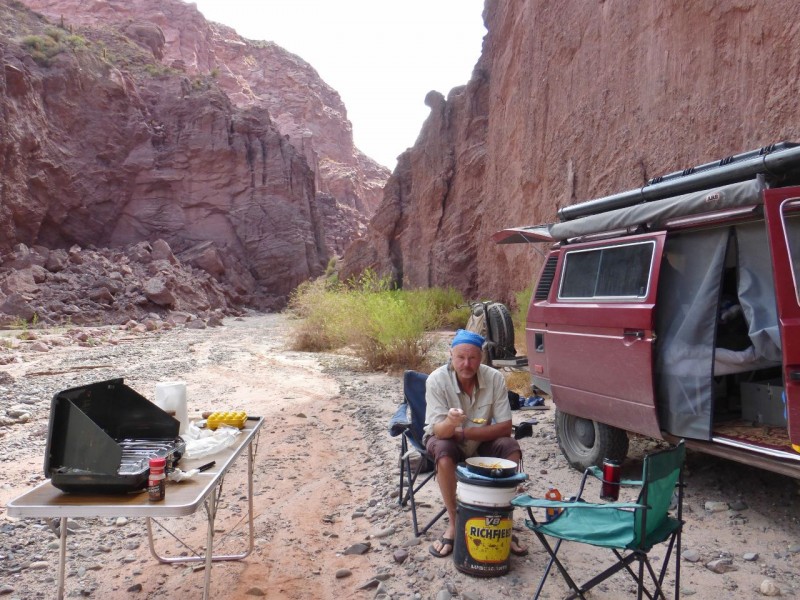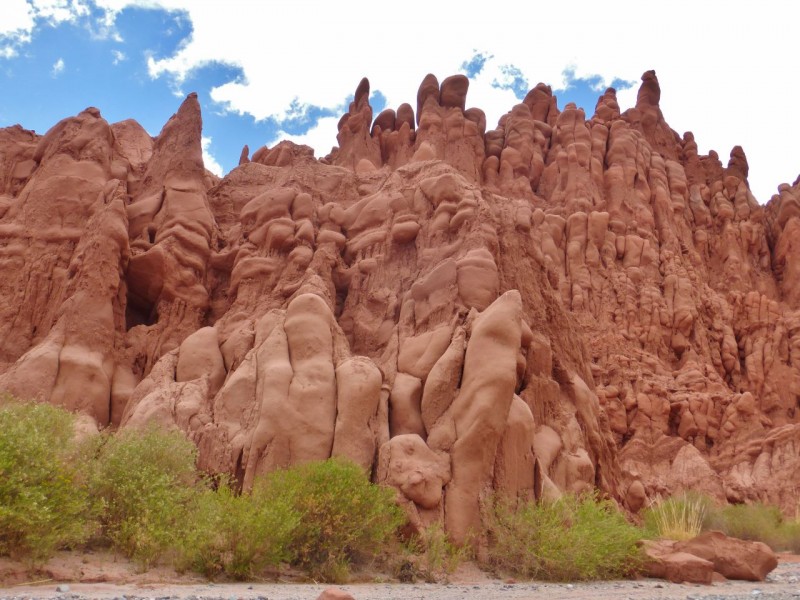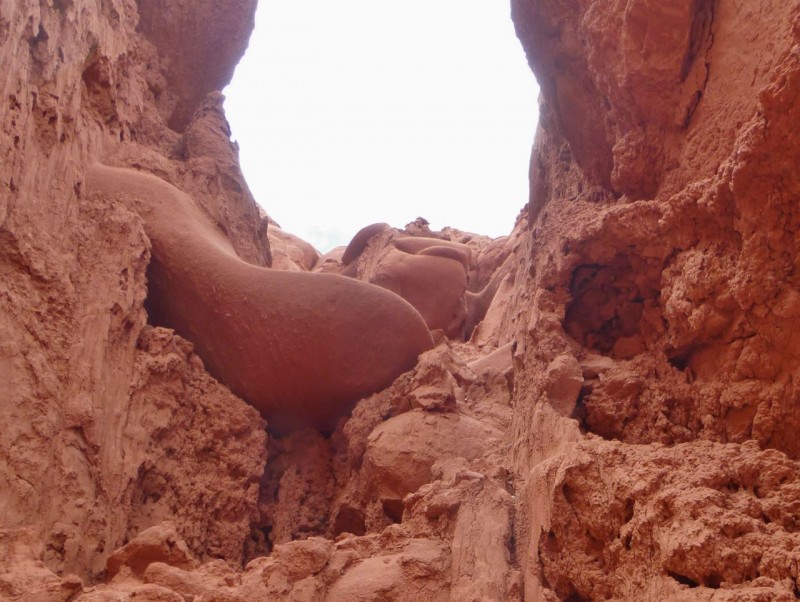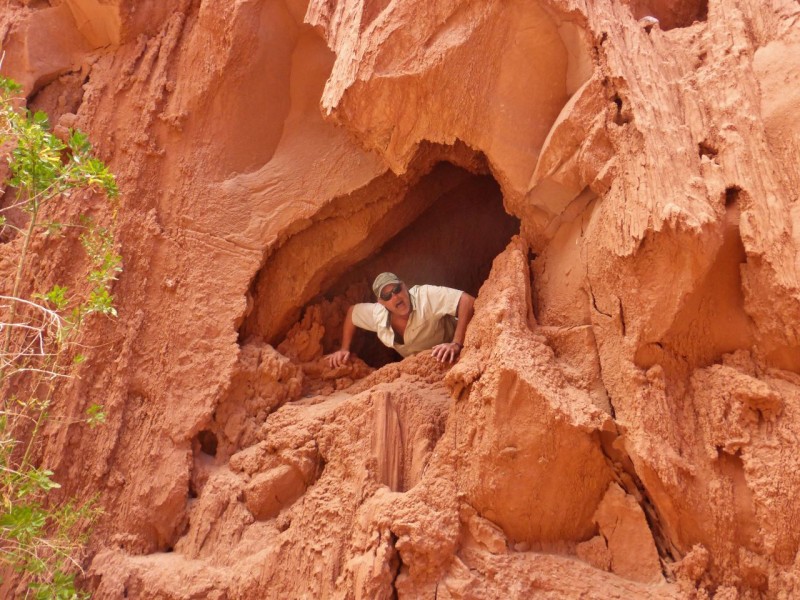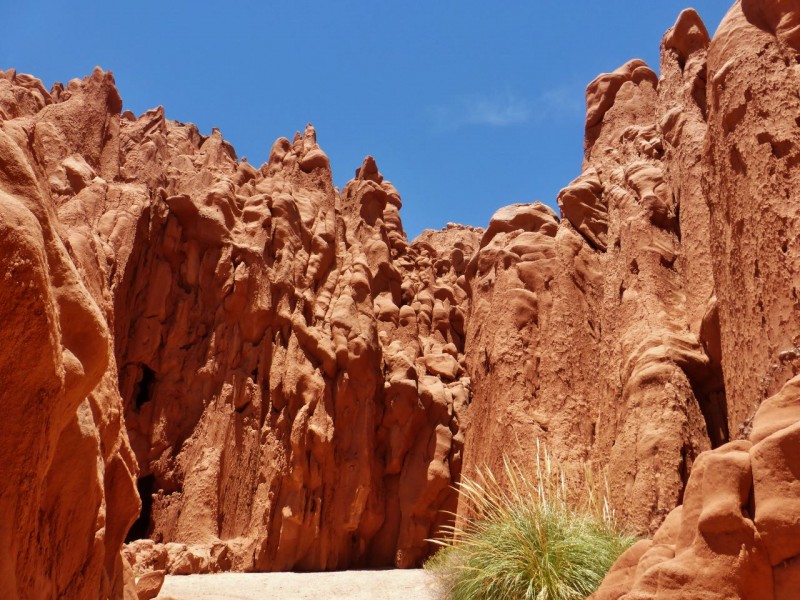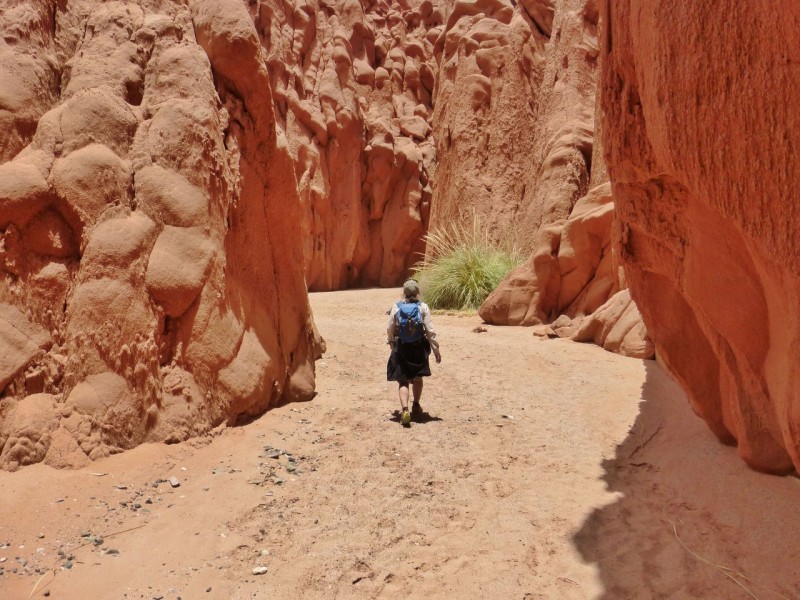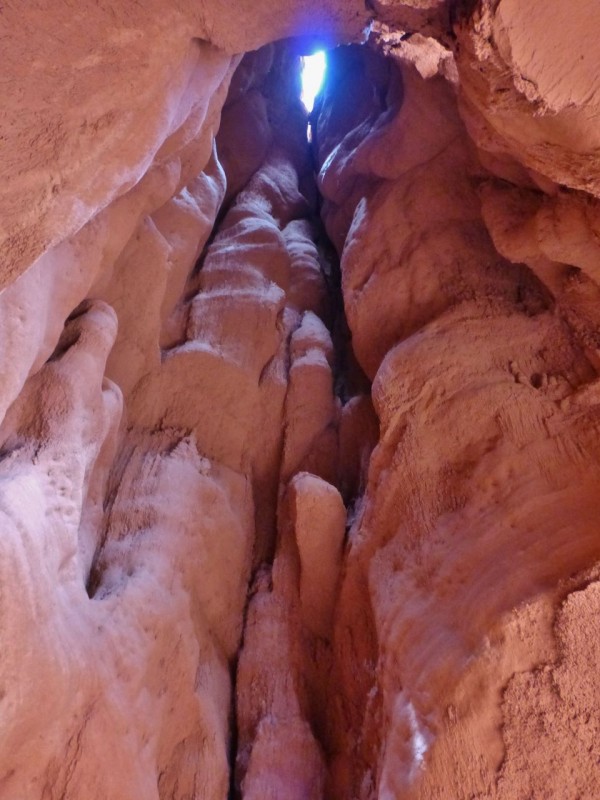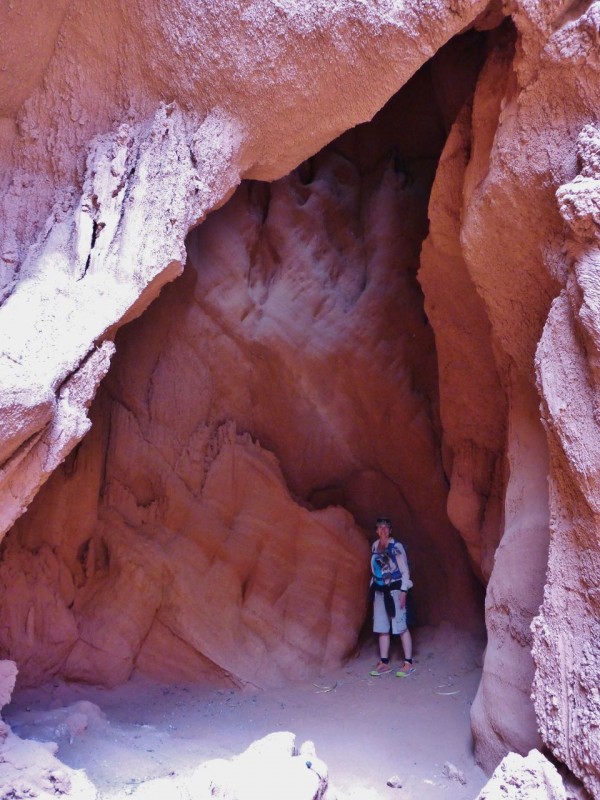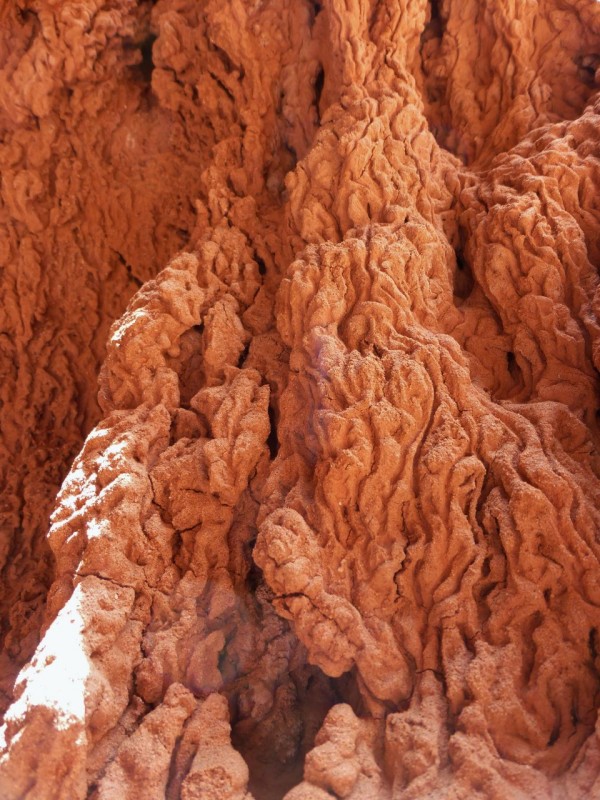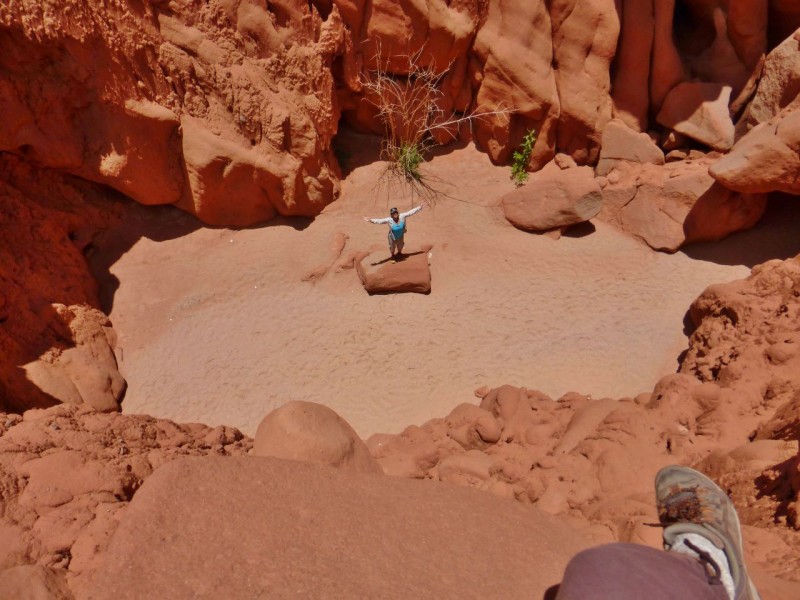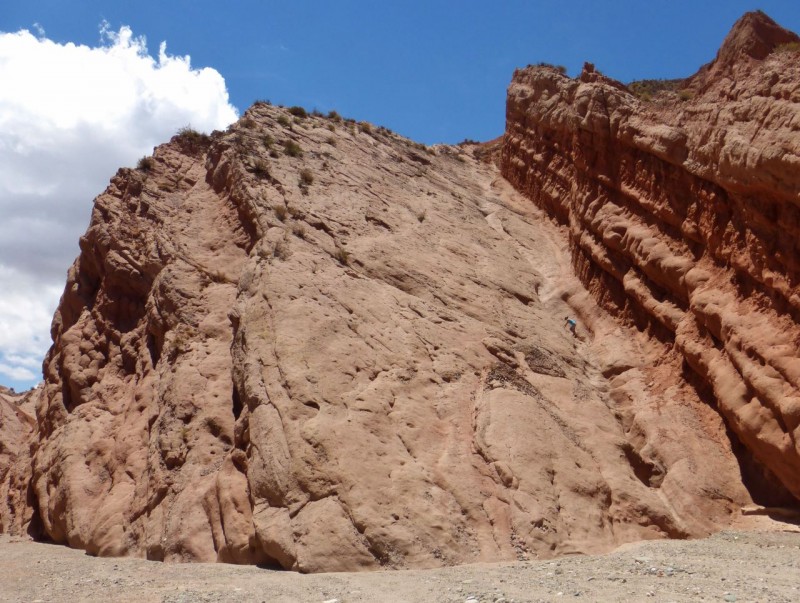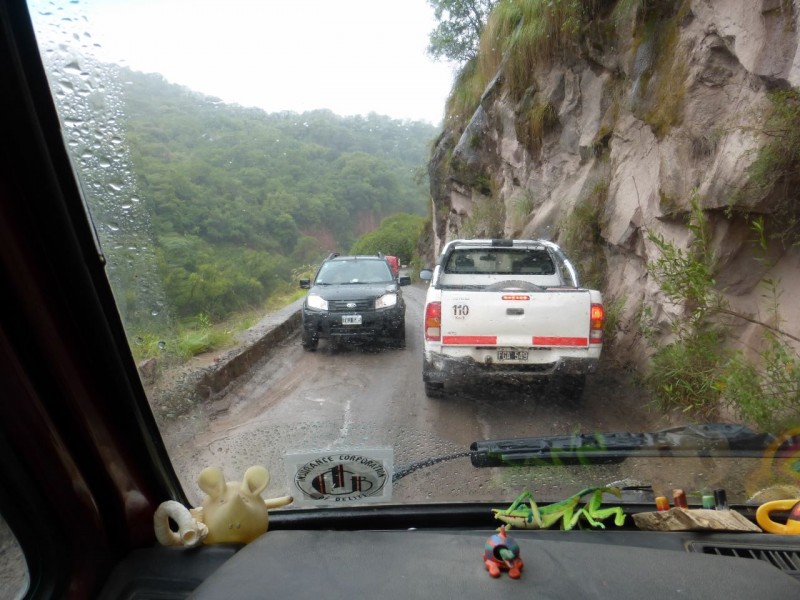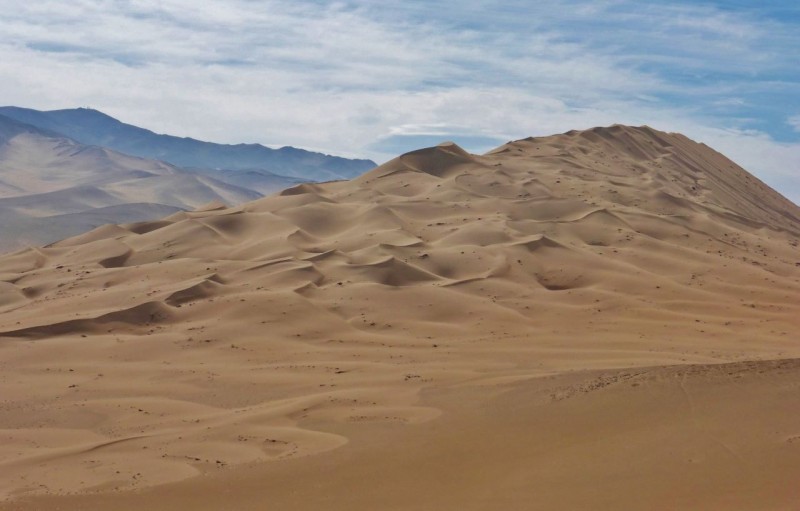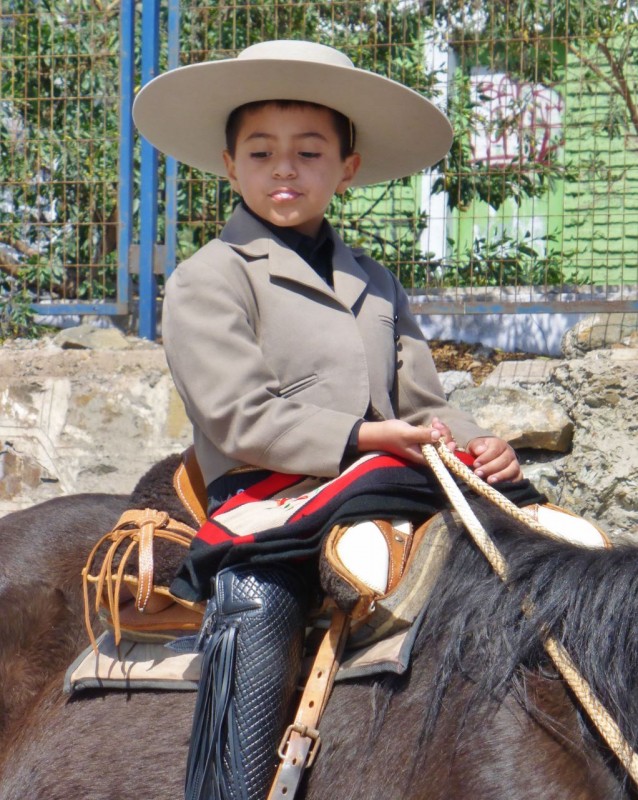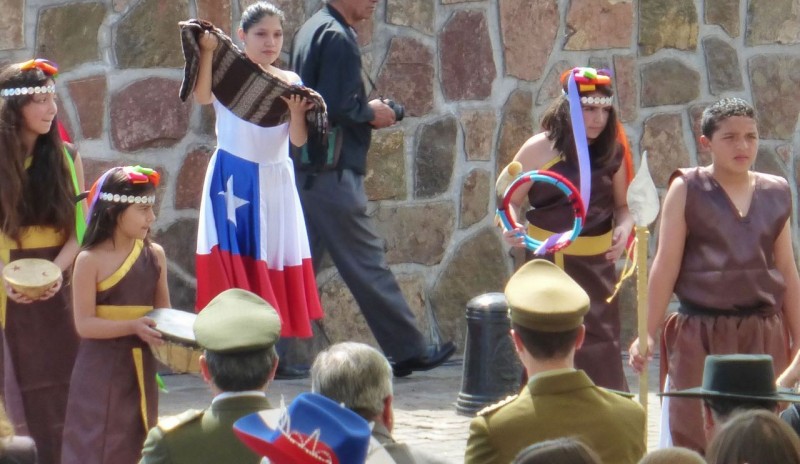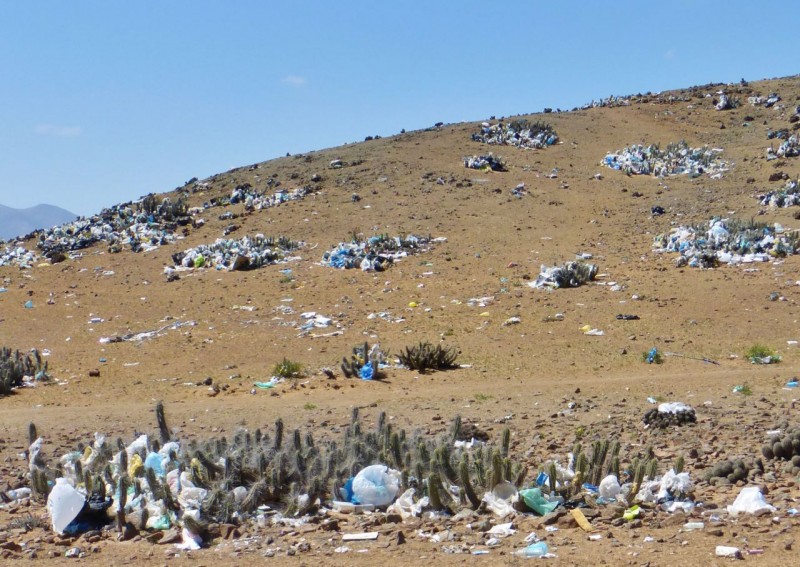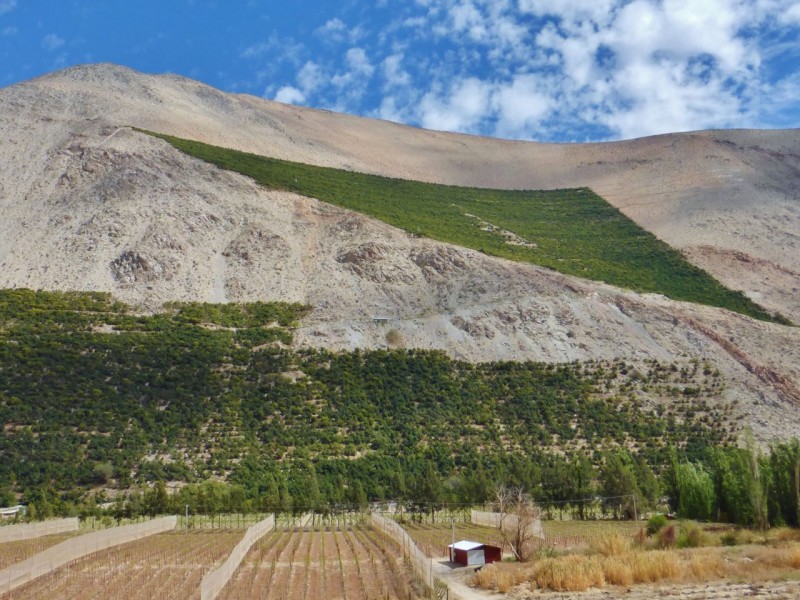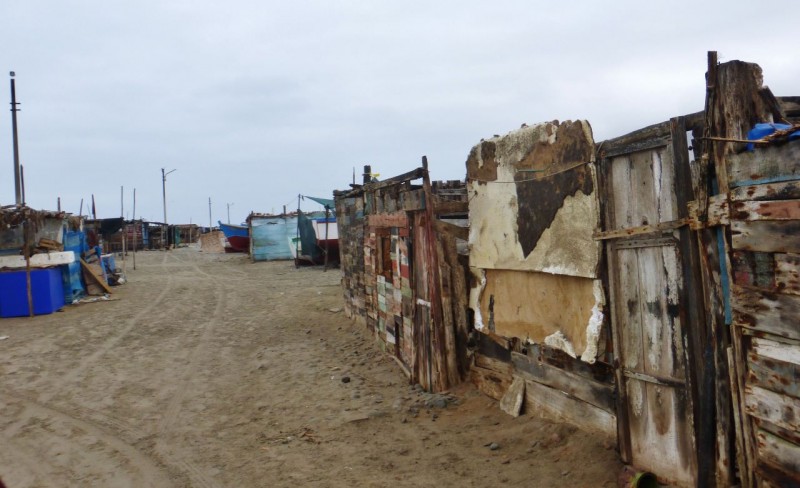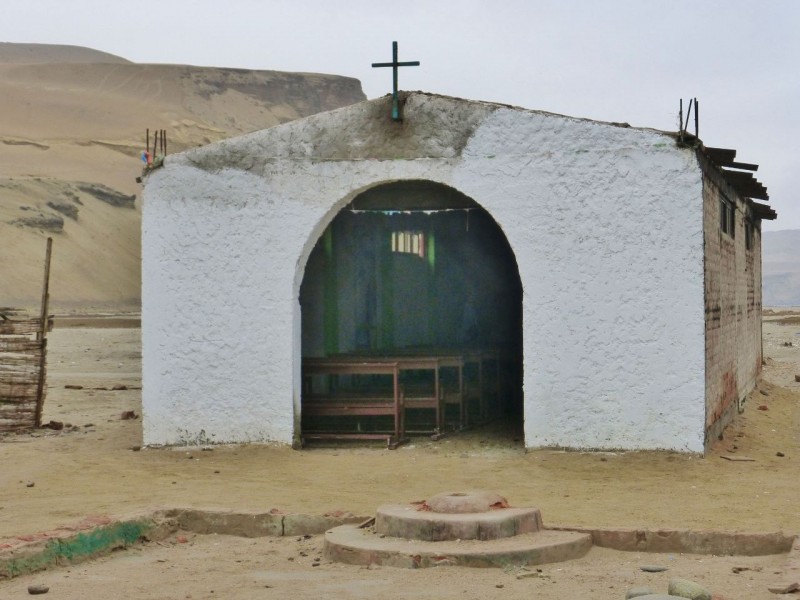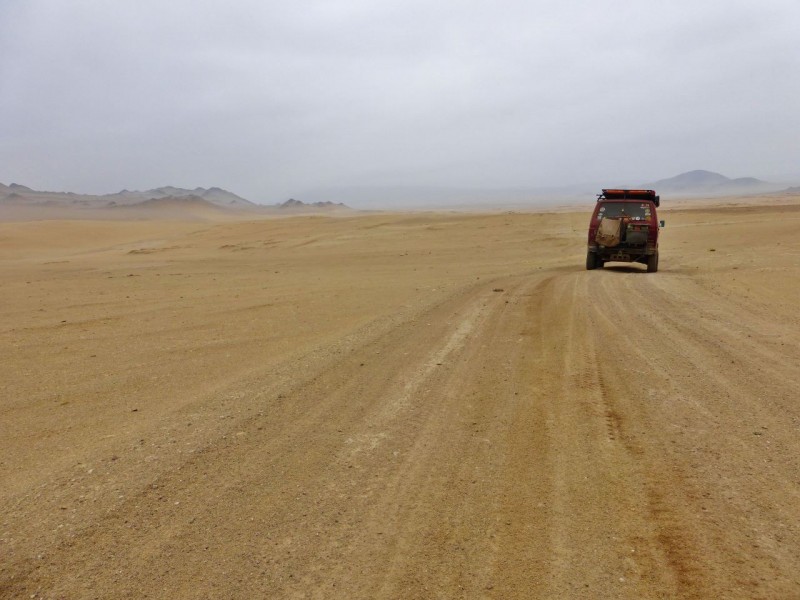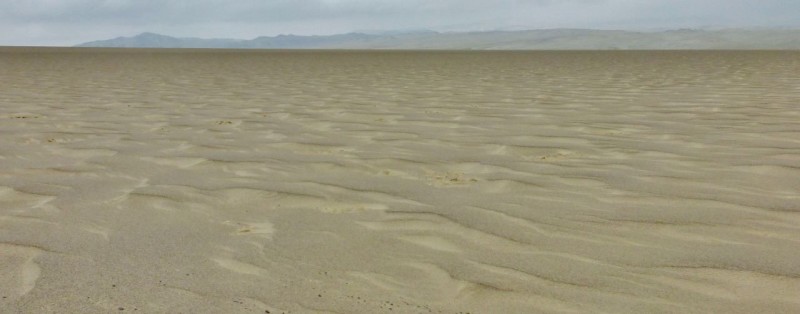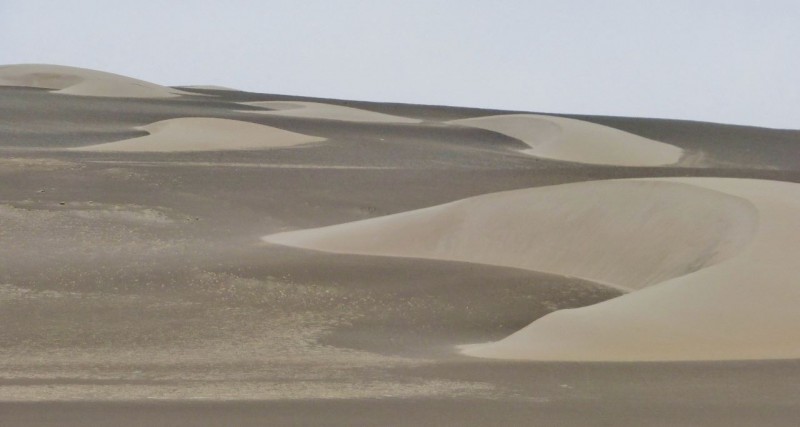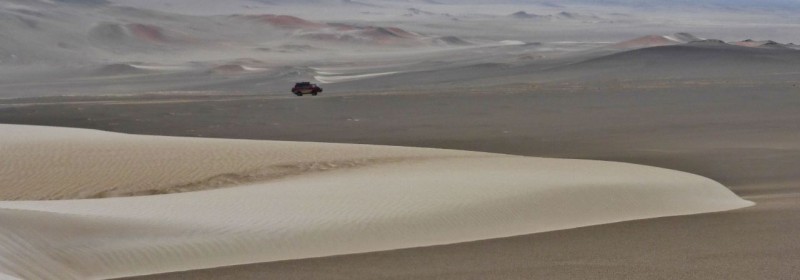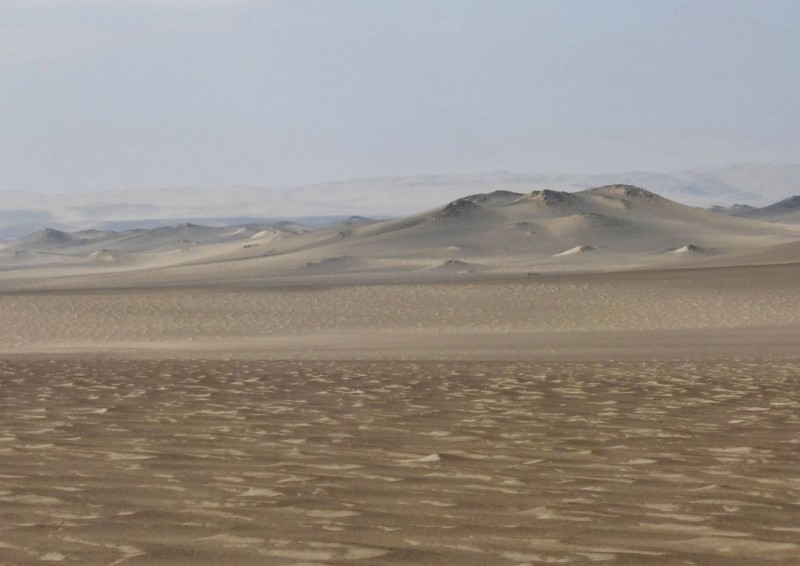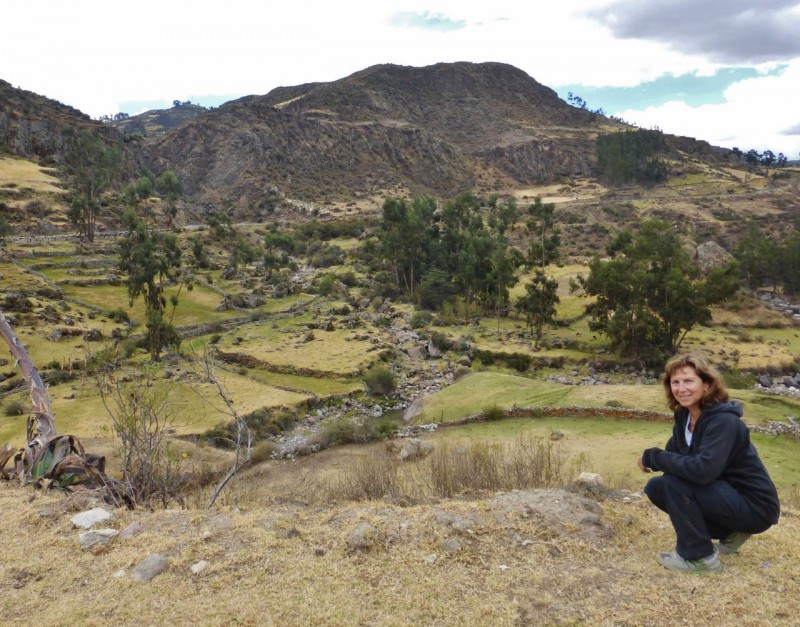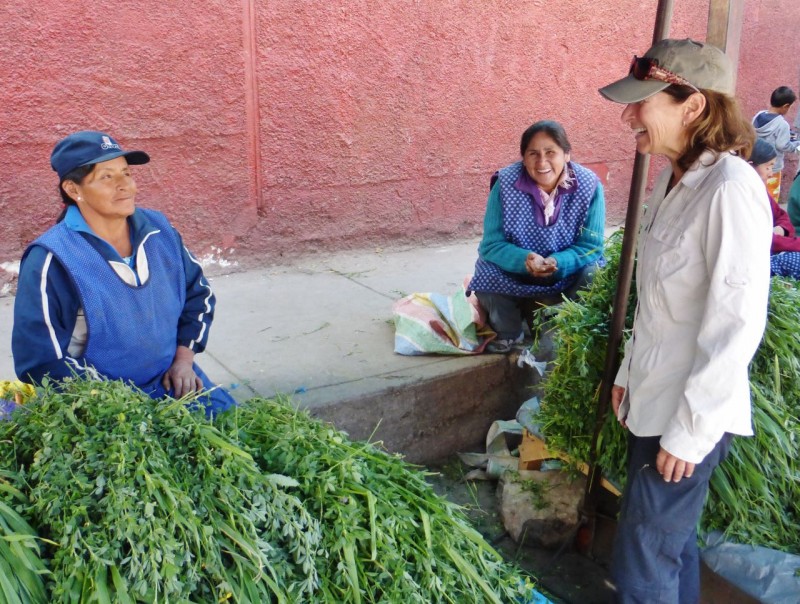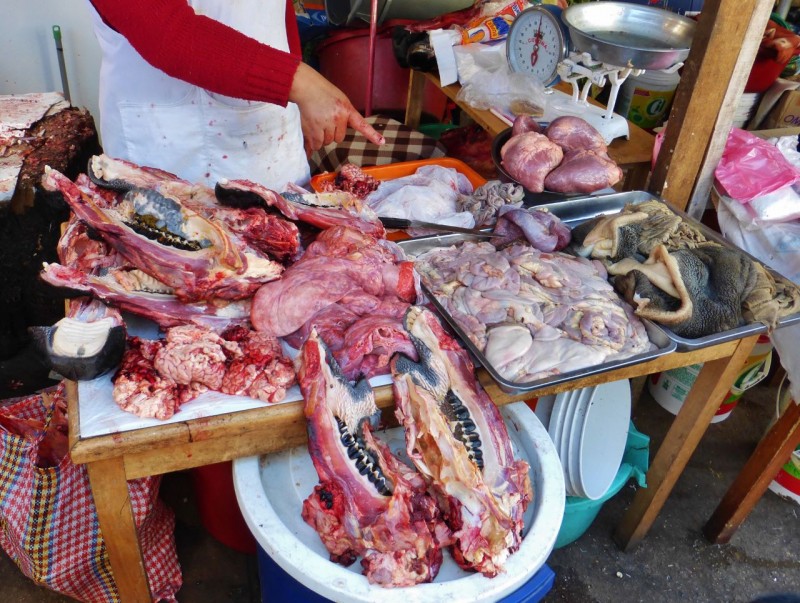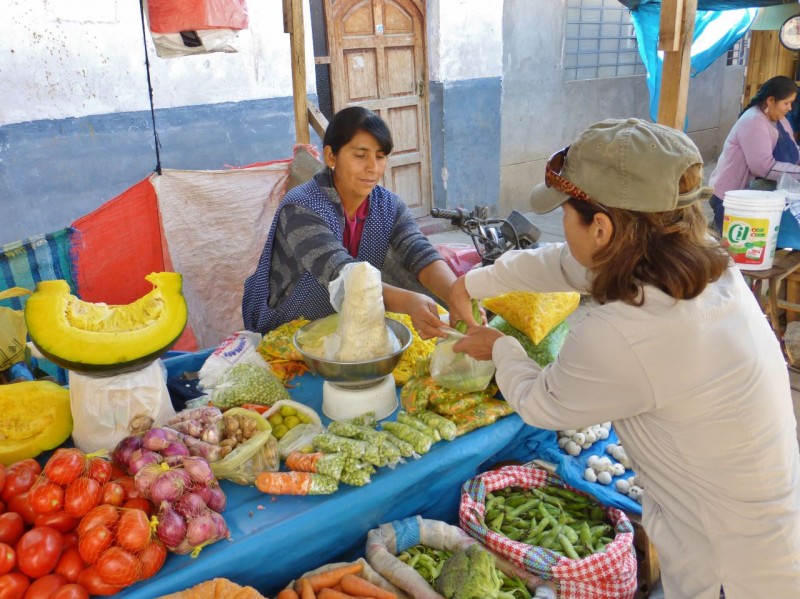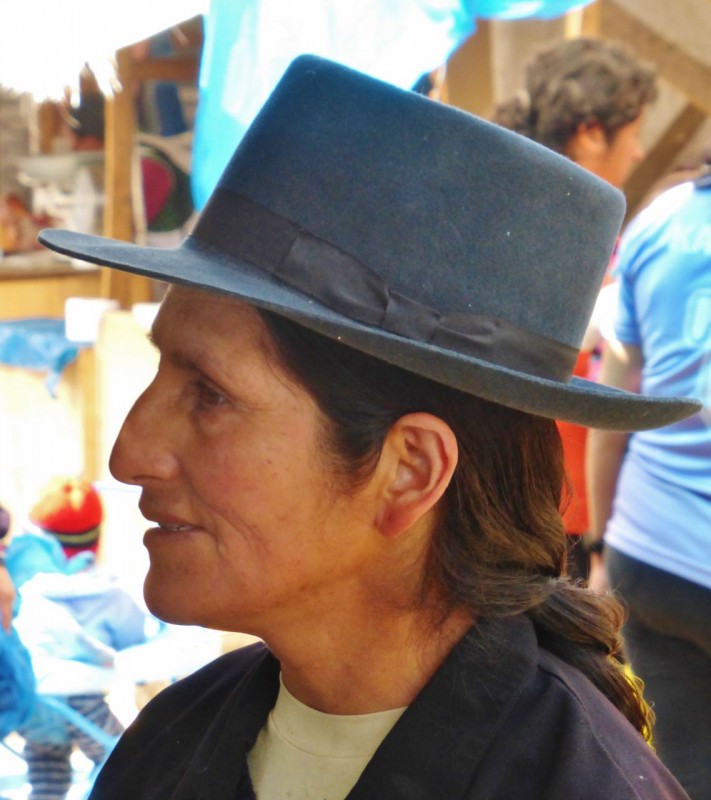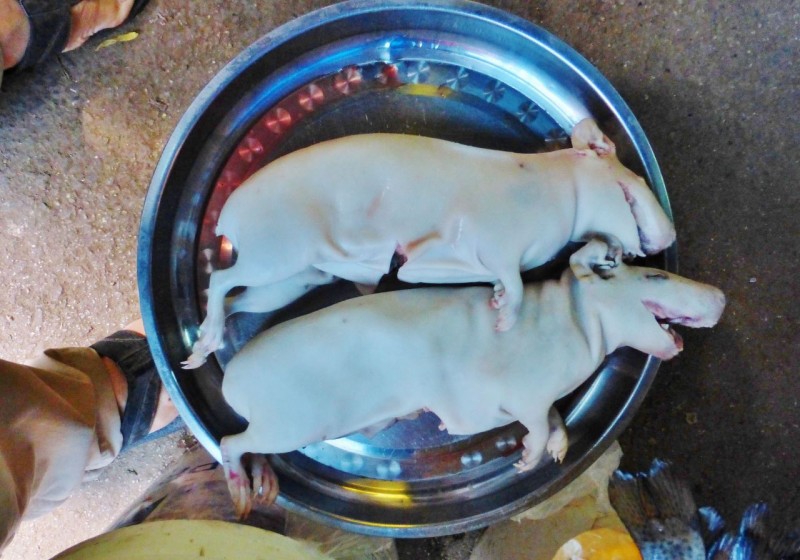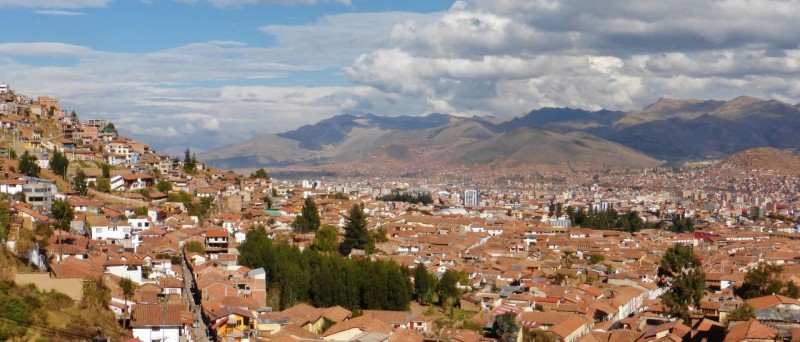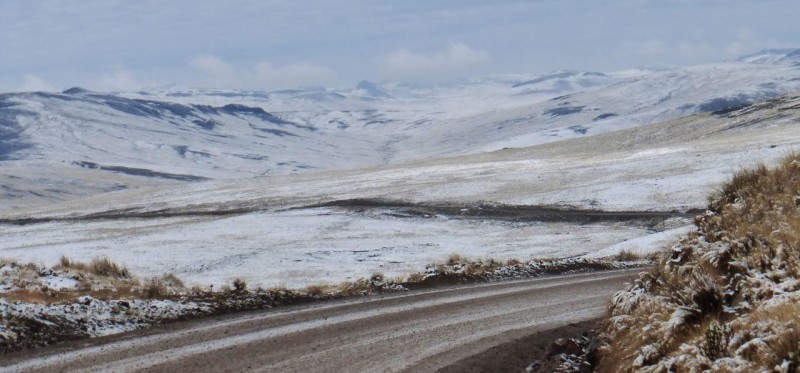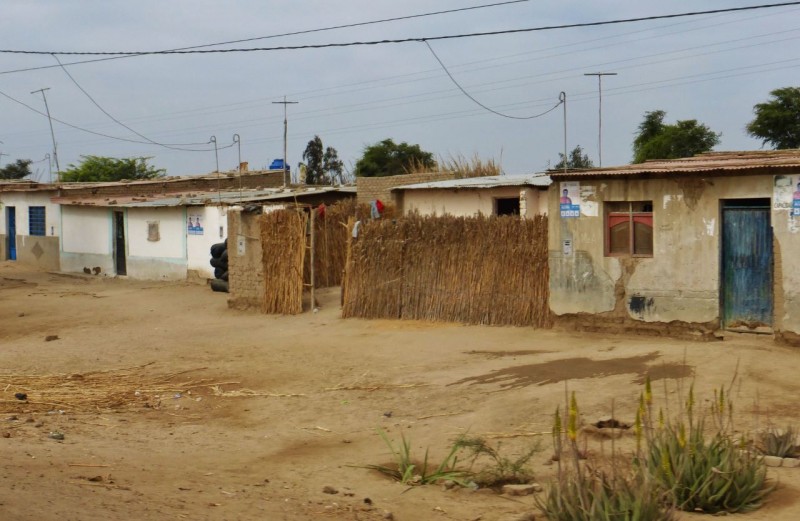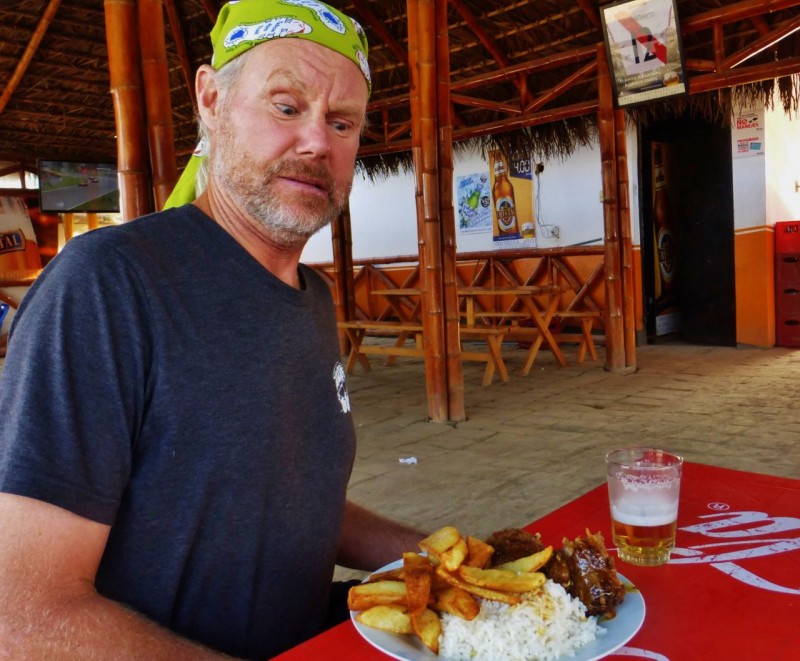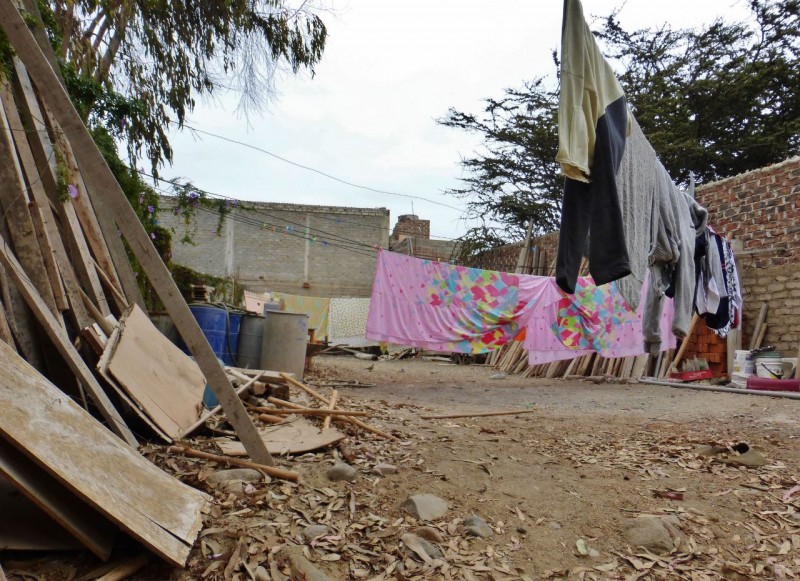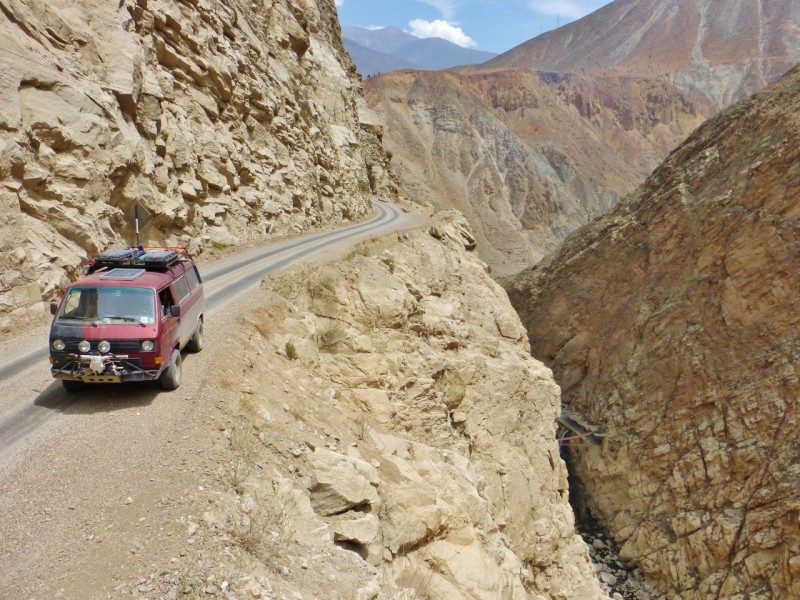Yes, we know. It has been six weeks since our last blog post and many of you are wondering what the heck happened to us. We have been home in Nevada for over a month already and the reality of regular life sure has a way of jumping right in and taking over. Several times in the last couple of weeks Ned and I have looked at each other and said, “did we really go to South America?!!”
Despite the high expectations of exploring the Chilean side of Patagonia and the Carretera Austral, Ned and I couldn’t shake our slightly deflated feelings of the trip being over. Having reached our “goal” of driving to the tip of South America, our journey back north again to Santiago was definitely wrought with Short Timer’s Disease. To top it off, my mother was dealing with serious health issues, and the pressure to get home was immense.
Nonetheless, we made the most of the drive back up to the closest port from which we could ship Charlotte home. Our amazing friend, Sebastian was already working on Charlotte’s ship passage from Valparaiso to Long Beach. It took us 18 days to cover the 2,000 miles north, and as usual, there is a lot to tell about! Please enjoy this blog as we rattle down more bad wash board roads, do four ferry crossings, chase pigs, fix broken Charlotte parts, don Gore-Tex in rain forests and, of course, enjoy more spectacular scenery.

After two fabulous nights camping (with our equine neighbors) in the Parque Nacional Tierra del Fuego, we made our way back to the town of Ushuaia where we stayed another two nights. El Wagon restaurant became our home away from home in this surprisingly touristy town at the end of the world. Alejandro (above) and Vierna (below) were warm and friendly, and we enjoyed three wonderful meals with them.
We had no idea what to expect either on the island of Tierra del Fuego or in Patagonia proper, but somewhere in our minds we had visions of harsh landscapes and lonely outposts. So far we were finding rampant tourism, complete with crowded cities and the burned out clerks and restaurant staff who wait on difficult visitors day after day. Our friends at El Wagon provided a refreshing respite.

On our final day in Ushuaia, we stayed at El Wagon until 6:00pm, finishing up the last blog, so we only made it 70 miles north to camp on the shores of lovely Lago Fagnano.
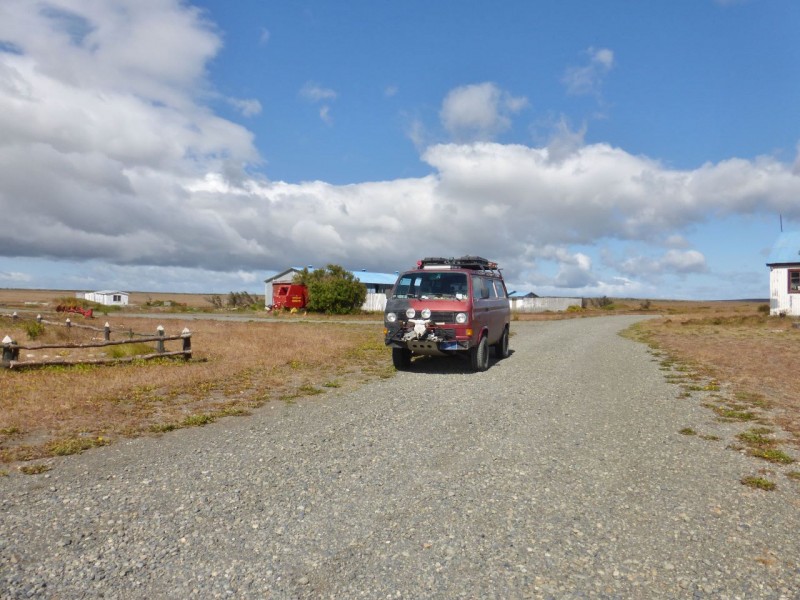
High-Fiving each other for making the final turn north, we retraced our steps, crossing the border back into Chile and saying farewell to Tierra del Fuego and the Straights of Magellan as we made the short ride ferry off of the Island.
We were running low on supplies, and the previous night’s über satisfying camp dinner consisted of peanuts, cheese and beer. Breakfast had not been much better, so we were looking forward to a good meal and a good market in Puerto Natales, about 100 miles west and north on the Ruta 9 from the ferry crossing.
Unfortunately, fate had other ideas. The three of us were cruising along near dusk, peacefully enjoying the wide open windswept steppes when we heard a terrible grinding noise coming from Charlotte’s rear end (no, we did not put beans in her fuel tank). Needing to get off of the highway and investigate the problem, we limped down a long driveway leading to this desolate, tumble-down estancia (ranch).

Having heard of the famous hospitality of Patagonia’s many estancias, we hoped this might be a great opportunity and fantasized about joining a big ranch cookout where lots of cordero (lamb) was being roasted on open pits and gauchos serenaded us with Chilean folk music…nope.
Daniel and Marilynn were about as run down as the ranch (the Estancia Cacique Mulato), but were very nice, welcoming us to camp for the night (a good thing since Charlotte wasn’t going anywhere!). Marilynn offered me the use of the kitchen, but not a morsel of food. The ranch was huge and signs of former grandeur were everywhere. The main house was an enormous Victorian, sad and boarded up while Daniel and Marilynn lived in a small hovel near the pig pens. Although Daniel told us that he ran 20,000 head of sheep, it looked as though they were too poor themselves to offer us a meal. Ned and I tucked into Charlotte for the night, munching on more peanuts and cheese and dreaming of cordero asado.

After a rainy night and another snack breakfast, Ned went to work on Charlotte, uncovering a very broken CV joint. The good news was that the intrepid Car Whisperer had, not one but two, spares. He tucked in for a long greasy job, while I went off to see about lending a hand on the estancia.

From a nearby field I heard the frantic squealing of unhappy pigs. Taking off in that direction, I ran into two old ranch hands pushing a wheelbarrow loaded with a lumpy white sack. I said hello, then noticed that the bag was moving! Actually it was writhing. Afraid of what I would find, I asked, “Que es?” “Cochinoitos!” they said, grinning from ear to ear while untying the bag for me to take a peak. Sure enough, eight tiny piglets poked their little pink noses out and my heart sank to think that they were just too cute to eat. It took a bit of diplomatic probing, but I happily found out they were simply moving the babies to get them out of the cold and would return for the mother. More questions revealed, however, that they would be ready for the market in another five months.

You’ve just gotta be smarter than a pig. I never did find out why Mama Pig did not frantically follow the piglet laden wheelbarrow, but she did seem to have fun toying with poor old Juan. She calmly let him approach, even offering her nose to the lasso…
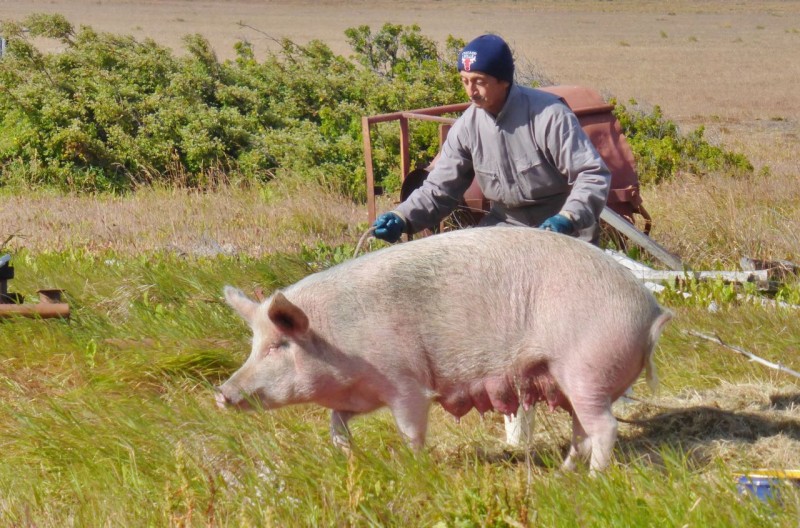
…then wheeled away only to stop and happily begin to root around in the dirt. This went on for at least ten minutes. I kept asking if I could help, and Juan breathlessly kept saying, “No gracias.” It was a pretty comical show to watch but even more fun when I finally joined in. Enrique (slightly younger than Juan) eventually got the lasso on one of Mama’s back feet, and they began to herd her toward her babies. With a twenty foot lead on the rope, Mama Pig led us on a merry chase, darting off in every direction but the right one. Poor Juan even dropped the rope two times, giving me the heroic opportunity to jump on it and stop the pig. Yeah right. At one point the three of us, waving our arms and hollering like madmen, nearly had her cornered. I am ashamed to say this would have ended the fun had I not given quarter when the pushy pig barreled right toward me. Yup, I was a chicken, but Mama outweighed me by several hundred pounds, and I do value my life. We all looked like idiots, but it was very entertaining, my only regret being there are no photos to share.

By now I was (as Ned said later) an official pig farmer, and there was more work to be done. Another mother and her babies needed to be relocated so the game was repeated.

This time there were eleven of the cute little things, and Juan and Enrique showed their confidence in my newfound pig husbandry by letting me pick a couple of them up by the back leg (the only way to do it so they said) and plunk them into the sack. Mostly I just held the bag.
By the time we got Mama #2 and babies moved, Ned had finished changing the CV. We said our goodbyes to Daniel, Marilynn, Juan (who gave me a hug) and Enrique, and trundled on north.
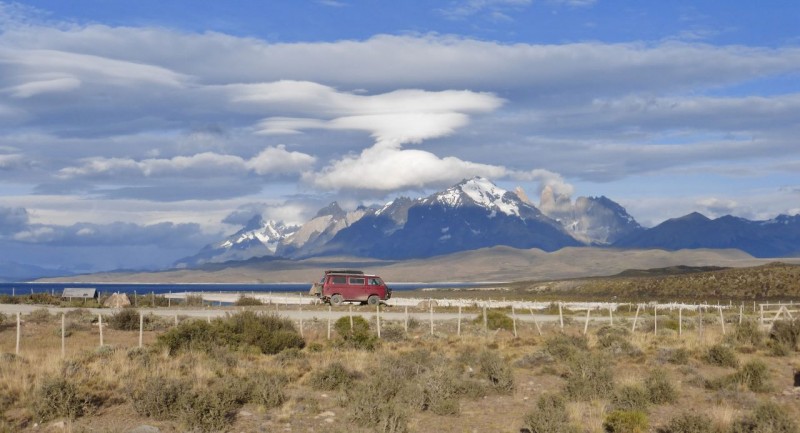
After blissfully devouring cordero asado in a restaurant in Puerto Natales, we restocked our larders and drove on to the famous Parque Nacional Torre de Paine. It was late when we arrived, so we opted to camp at an official scenic lookout. Thinking that the majestic towers would look fantastic in the morning sun and that the place was deserted, we saw no problem with the plan.
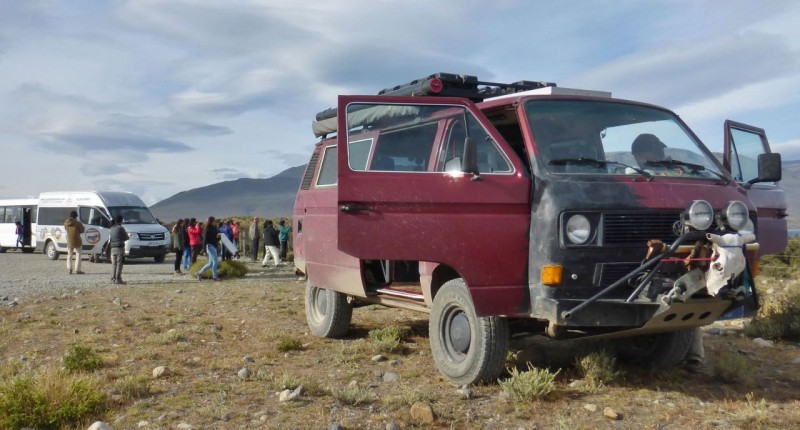
…but just about half way through our morning exercises, buses and vans carrying dozens of tourists showed up to shatter our peace. I even caught one snapping a shot of Ned as he finished his pull-ups. Ok, I admit, we were in a Park, camping at a posted lookout, doing funny looking exercises in a funny looking van, but we still felt like monkeys in a cage.
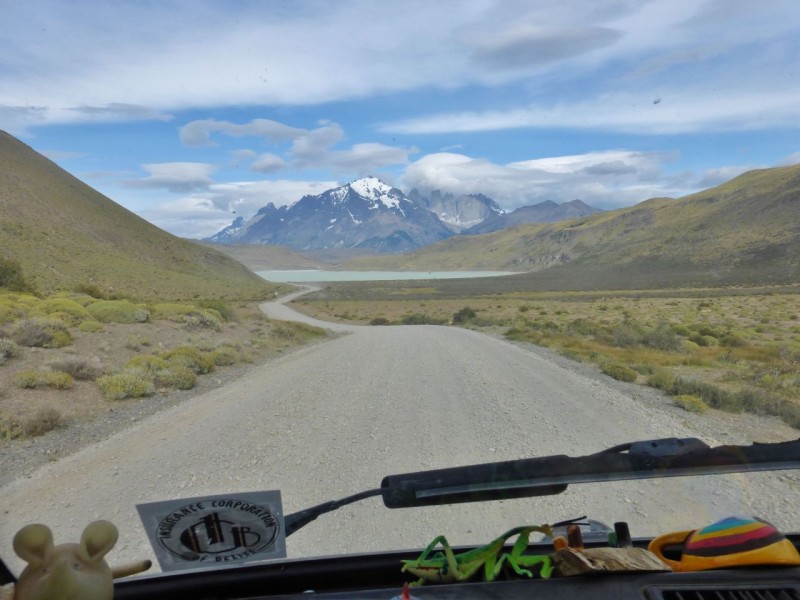
The weather was typical of Chilean Patagonia, extremely cold and so windy I was nearly knocked off my feet several times. Cliffside hiking didn’t sound very fun, so we just drove the big loop around the park enjoying the fantastic scenery.
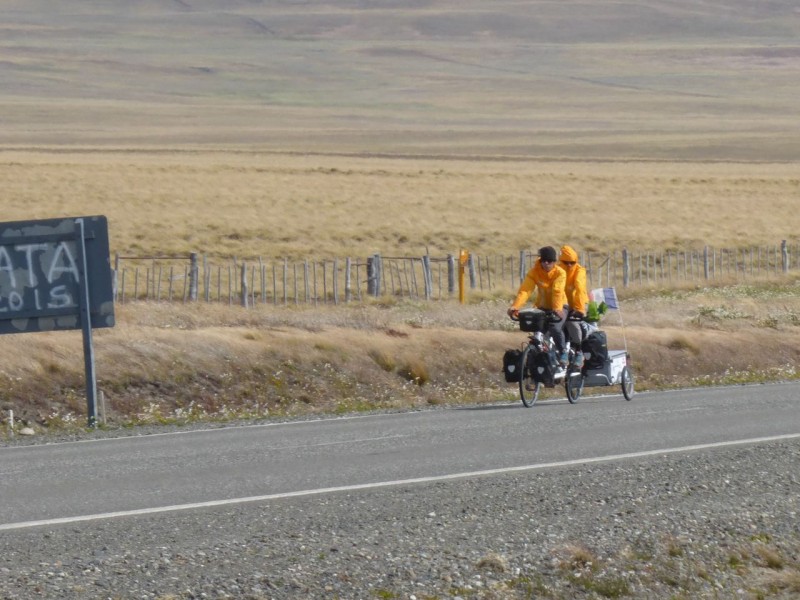
We passed dozens of cyclists braving the wind and cold and making us feel like old weenies living in the lap of luxury. These two teenage boys from France were pedaling a tandem bike the length of Patagonia. They should have incredible stories to tell their kids.

The road north in Chile ends after Torre de Paine, so we crossed back into Argentina, retracing our steps until we reached Paso Roballo, east of Cochrane where we were able to cross back into Chile and finally onto the famous Carretera Austral.
Toward the bottom of Paso Roballo in the Valle Chacabuco we entered land owned by the shiny new Patagonia Park.
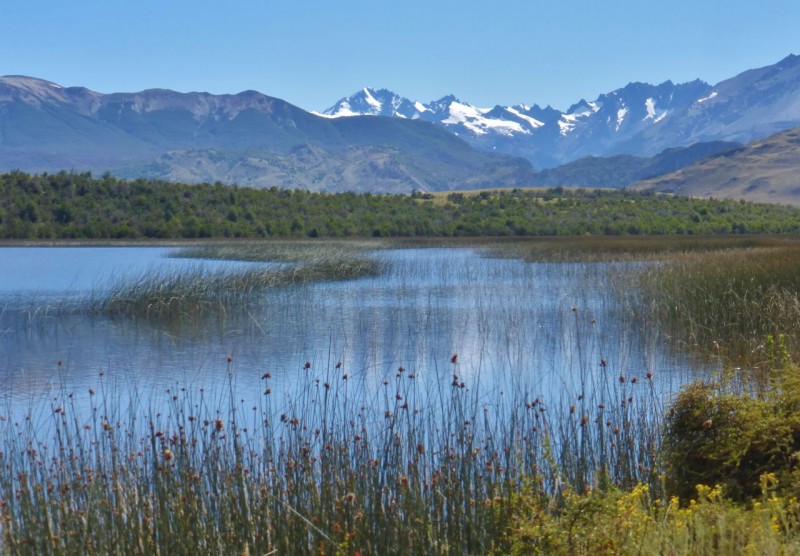
Rescued from overgrazing, these 170,000 acres, previously a huge, hundred year old sheep ranch, were purchased ten years ago by Kris and Doug Tompkins, well publicized environmental rights activists, and, respectively, the former CEO of Patagonia (the clothing company) and the founder of The North Face & Esprit clothing empires. Their goal has been to restore the land to nature, removing all the fencing, as well as all foreign flora and fauna, while introducing human tourists, providing them with hiking trails and fancy lodging. Eventually they plan to give this preserved land to the Chilean government to manage as a national park.

PATAGONIA WITHOUT TOMPKIN$
Without getting into touchy details (I’ll save that for the book!), it turns out that there is quite a controversy surrounding the land’s purchase and the Tompkins in general. Sheep ranching in the valley has been the mainstay of the local communities, and many people lost their livelihoods. Weighing human needs against the need to preserve beautiful places on our planet is a tough challenge.

The creators’ vision when building Estancia Valle Chacabuco was to capture the grandeur of the old lodges at Yosemite and Yellowstone. We were actually a little surprised and put off by the excessive opulence. To us, the upscale country club atmosphere appeared quite out of character with the Patagonian surroundings.
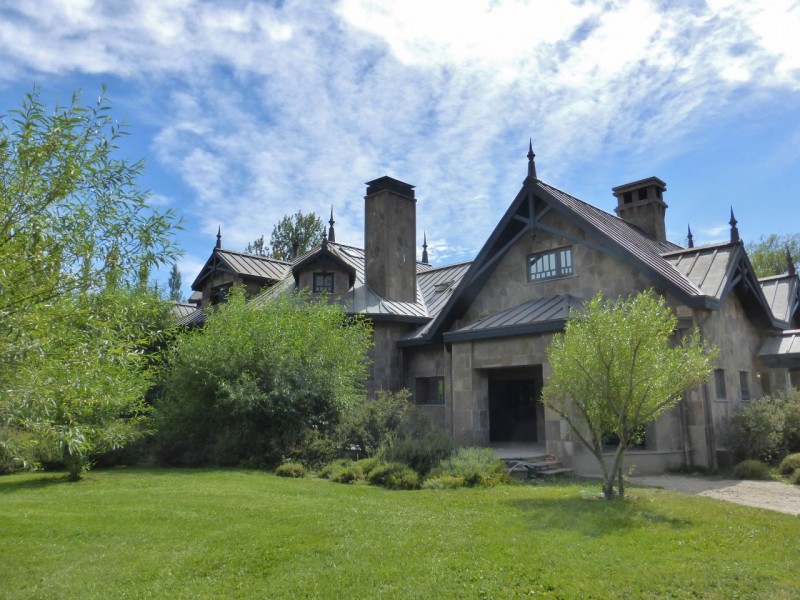
Despite the Tompkins’ obvious distain for all things requiring energy and motorized vehicles, and their hype about the irresponsibility of leaving large “carbon footprints,” this lodge was build on a massive scale, involving a lot of machinery and fossil fuel to construct, and it now requires more energy use to sustain it. The hypocrisy of it all rubbed us the wrong way…

…to stay in this small room. It was obviously beautiful, but the snobbery of the staff and the inability for average income people to enjoy the place was off-putting to us.

This reading room was full of coffee table books co-authored by Doug Tompkins, berating everything from energy use to mass food production. We agree that the glaring challenges of pesticides, GMO’s, pollution and animal extinction are terrifying. I also pragmatically know that rare is the person who is willing to give up driving, flying, boating and eating mass produced food. Doug Tompkins, himself, soars all over Patagonia in his own small airplane, burning plenty of fossil fuel. My issue with the offering of coffee table books was not in pointing out the problems, but in not offering practical solutions. Suggestions on par with sending our daily living conditions back those of the poorest villages we passed through in Guatemala (for example) or reducing our offspring to one child per couple are not practical solutions in this modern world.

Ned was particularly amused to find this book. In his words, “Isn’t Tompkins’s airplane as much a “thrillcraft” as my Jeep, race cars or Charlotte? Hypocrite!”
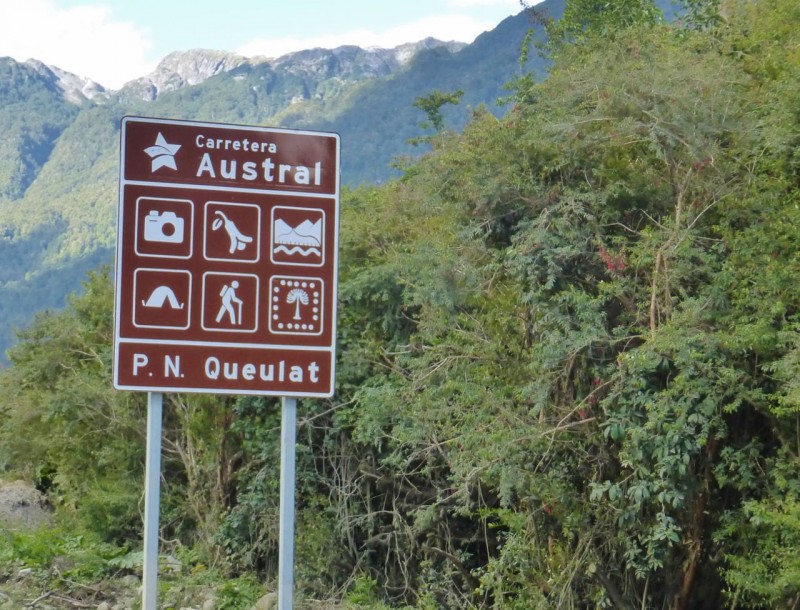
Carretera Austral literally means the Southern Highway, which is kind of funny since it was the roughest, slowest, most washboard infested road we’ve been on yet. Nearing the end of our journey, Charlotte was exhibiting a worrying number of ailments. Rather than being exciting, the rugged terrain only gave us visions of poor Charlotte literally shaking apart. We were also on the wet, cold Pacific side of Patagonia now, and while beautiful in its own way, rainforests are just not our favorite. The constant rain, cold, bugs and lack of open land made camping less fun and exercise scarce. (And yet we still saw many cyclists toughing it out here, battered by the elements…really making us feel wimpy!)
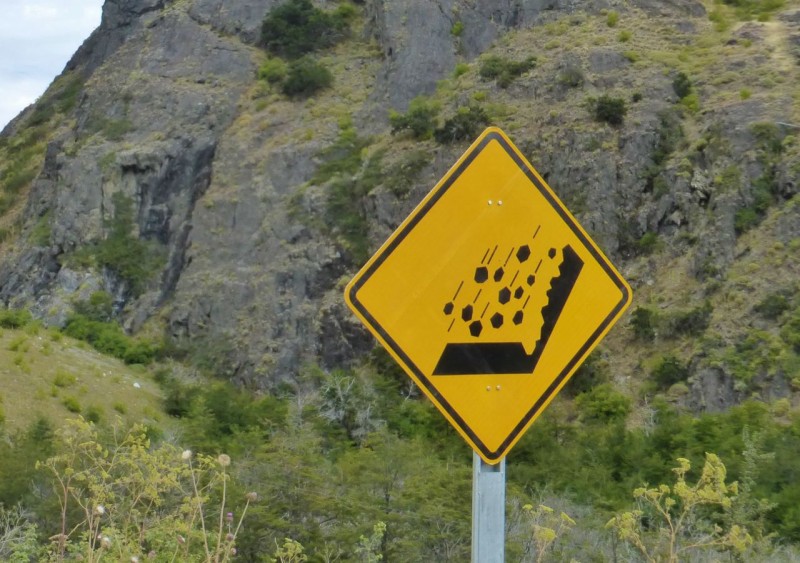
We’ve seen these falling rock signs all over Chile and have dubbed them “The Fast Rocks Sign.”
Do rocks really fall faster in Chile?

The sun came out and lifted our mood as we drove along the magnificent turquoise Lago General Carrera, the largest lake in Chile and the second largest in South America.

We passed this sign advertising the Marble Cathedral and natural camping. We had no idea what it was, but it sounded intriguing.
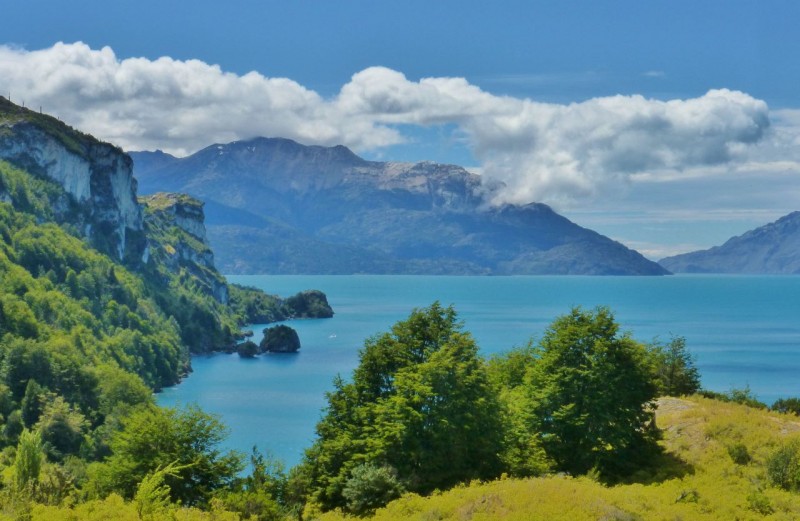
We drove down a very steep dirt road, enjoying the scenery but worry about breaking another CV which was making horrible noises as we descended the grade. If another one broke, Charlotte would never make it back up the arduous climb.
Once at the bottom, we found that we could bush camp for free and were able to book a boat ride to the Marble Cathedral in the morning. We met several fellow travelers (even a VW enthusiastic Argentinean couple in an early splitty Bus) and had a quiet night in semi privacy.

By morning the rain had returned but we were determined to see the Catedral de Mármol, whatever that was.
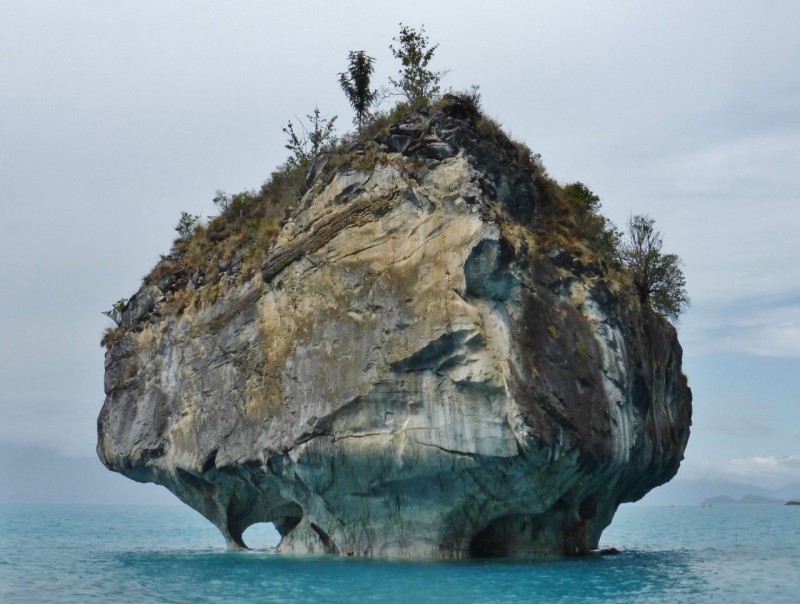
When we arrived we were stunned. This is the Catedral de Mármol, but the spectacle did not stop here.

The lake shore was lined with marble caves carved by wind and water, suspended over the glacial turquoise waters. Despite the rain, I could not stop taking photos. It was truly one of the most beautiful places I’ve ever been, certainly one of the most unusual.
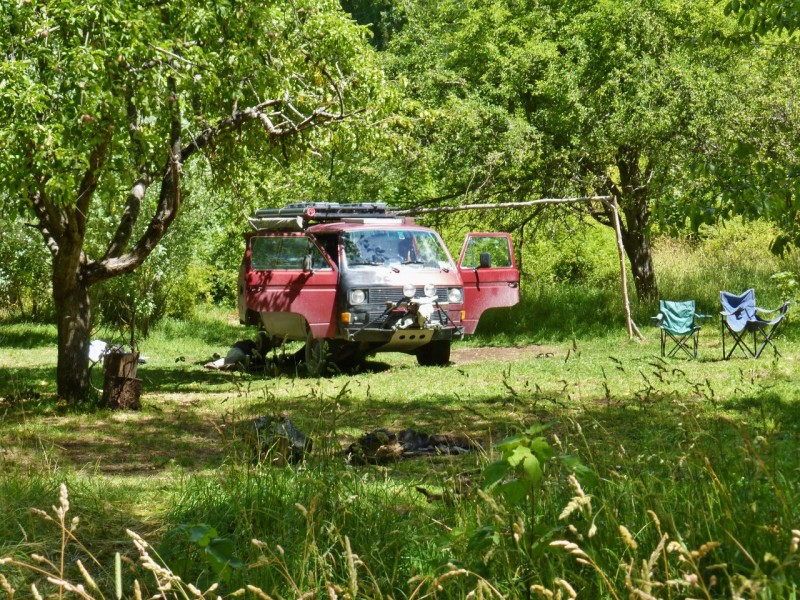
Look closely. Can you see Ned under Charlotte (again)? Taking advantage of our nice camping spot and using the last spare CV, Ned got Charlotte repaired and up the hill. Now it was a race to get to Santiago before another CV (or something else) broke.

…Taking showers wherever we can.
Desperately in need of a good wash, we spotted an abandoned campground and drove in to find clean water for Charlotte’s heat exchange shower and rare privacy.
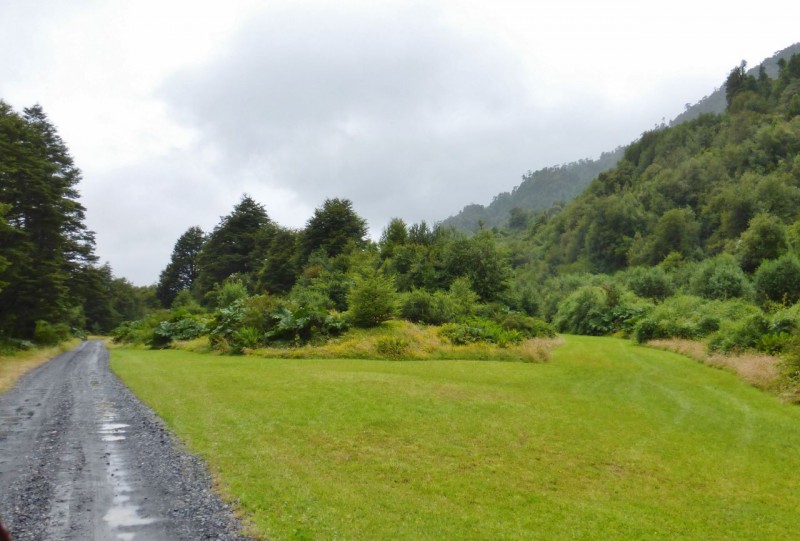
Continuing north we came to the Tompkins’ first Park, Pumalin. The park is immense, covering 760,000 acres. This was the Park entrance at the south end, near Chaitén. Unfortunately, signs everywhere indicated camping was only allowed in walk-in campgrounds. Camping in or near your vehicle was glaringly prohibited. In light of the obvious usage of gas powered mowers to manicure the vast amount of lawns in the park, we found the bias against motorized vehicles puzzling.
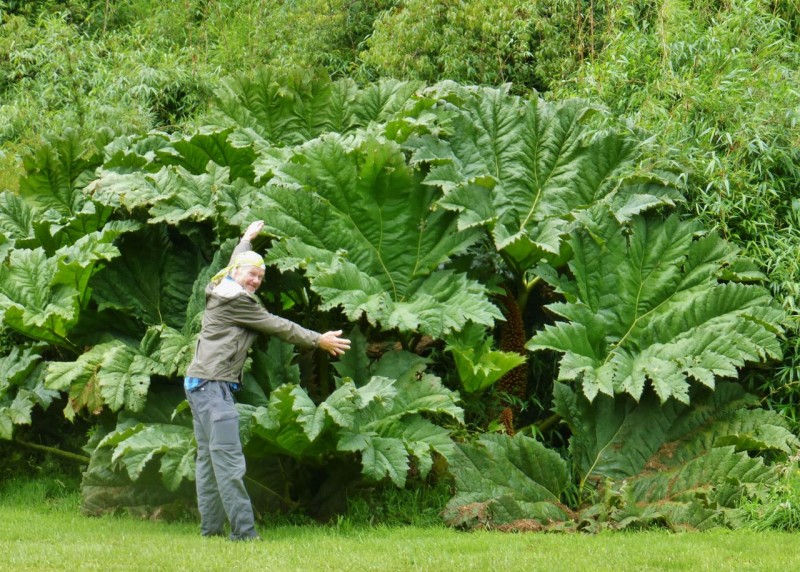
…and a botanist’s dream! The forest was full of unusual and beautiful plants, including these mammoth leafy things (we are obviously not botanists)…

The unfortunate thing about Pumalin park, is that it essentially cuts Chili (being very narrow) in two. With the Pacific archipelago on the west, and the Argenitina border on the east, there is no way to drive north/south through the park. To go north, we needed to take a series of ferries to continue our journey, or make a 500 mile detour east back in to Argentina. The town of Chaitén was the jumping off point for the first ferry, and we were very much looking forward to having a nice breakfast in a warm restaurant. When we arrived, however, we found the town in horrible shape. The houses and buildings were ramshackle and/or boarded up, and the only restaurant open was freezing cold and the employees unwelcoming.
This van (above) says “Chaitén is Not Dead.” We disagreed. It was Sunday when we arrived, and we were dismayed to find that the ferries were all booked until Wednesday. At this point, we just wanted out of there. We made the decision to drive 100 miles back south and then east on the bad washboard roads to what we had heard was a cute town called Fulaleufú.
Note: We did find out in Fulaleufú that Chaitén was buried in ash in 2008 when Volcan Chaitén erupted, essentially killing the poor town. Perspective really is everything. Doing a little homework beforehand might help, but we really do like discovering as we go.
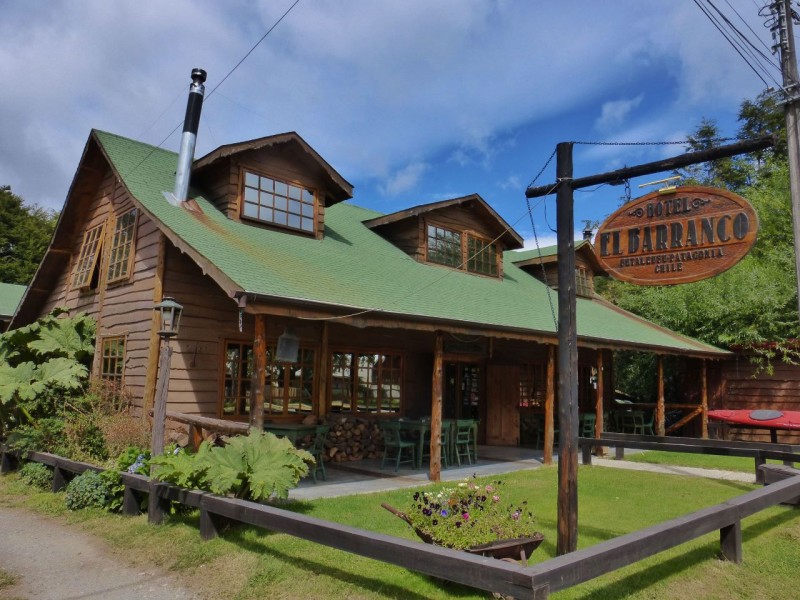
Fulaleufú was a wonderful stopover. We stayed at this great lodge, a welcome respite from cold, wet camping.

Ned spent most of our two days in Fulaeufú working on Charlotte, trying to shore up an increasing bad coolant leak – another curse stemming from our alternator bracket issues. I worked on photo editing and relaxed in the warm luxury of our beautiful room.
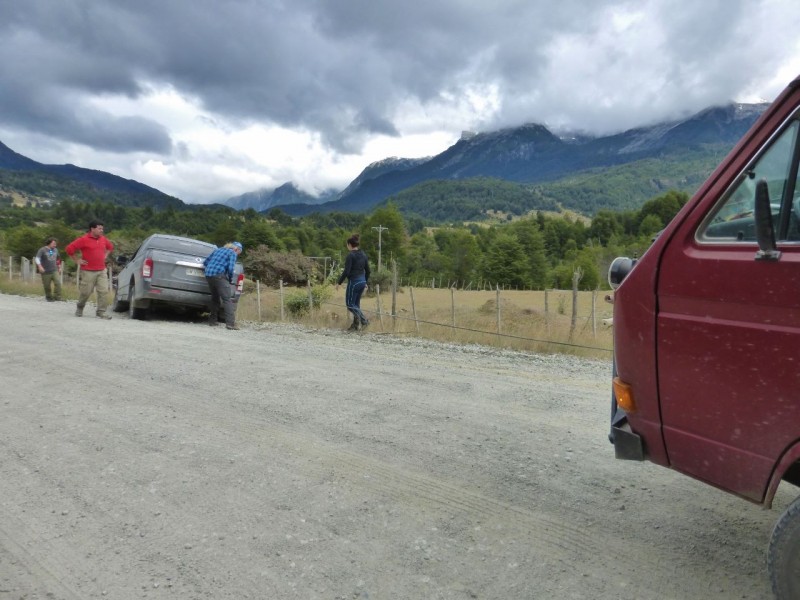
On the way back to the coast from Fulaleufú, Ned and Charlotte rescued another vehicle which had slid off the road and into a ditch. It was only the third time we’ve used the winch, once to pull ourselves (Bolivia) and twice to help others (Mexico and here).

Finally it was ferry time. It took us three boats and 12 hours to travel 30 miles, but we finally were able to continue north.
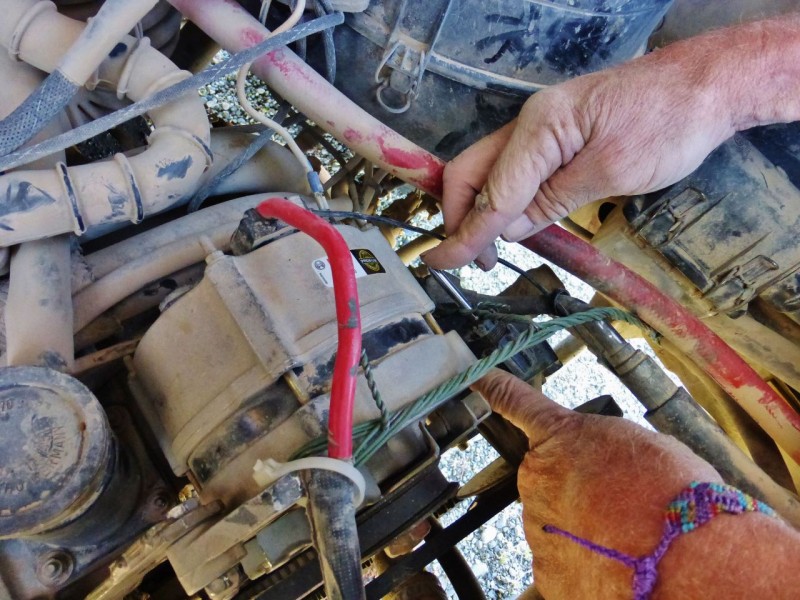
Another broken alternator bolt, another clever Ned fix (note the green wire). It seems baling wire and duct tape are holding Charlotte together these days.

Our final camp, just south of Santiago was quiet, but it was a little anticlimactic. We were suddenly aware that the trip was coming to an end and were feeling a little sad. It was fun, though, looking back and coming up with some intereting statistics. Since returning to the trip in December, we have spent 75 nights on the road; 55 camping in Charlotte (46 bush camps and 9 in campgrounds or driveways) and 22 nights in hotels.
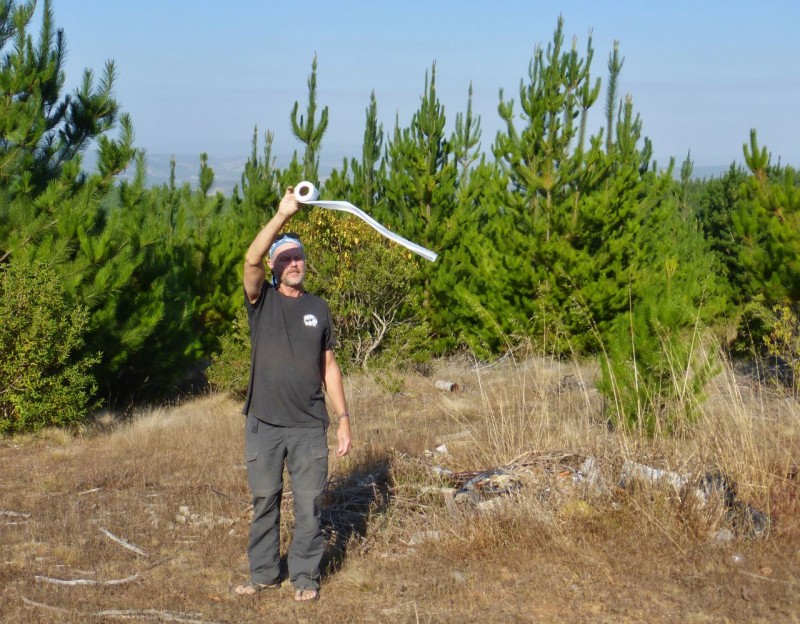
Over the last 14 months of the journey we have come up with a very technical method for determining which way the wind is blowing. This is necessary so we can park Charlotte to block the wind for cooking.

And speaking of paper products, this has been an ongoing topic of deep discussion as, in country after third world country, we’ve found next to useless paper towels and toilet paper. We were delighted to find in Chile a brand comically subtitled “Evolution.” They are almost as good as the dozens of brands we are offered in the U.S. and are capable of absorbing at least some liquid before disintegrating.

Back in Santiago, I just had to show Ned the MallSport (the one where I got an army knife and dumbbells back in December). We ate lunch in the warm sunshine, watching surfers try their skill on this man-made wave. Very cool.
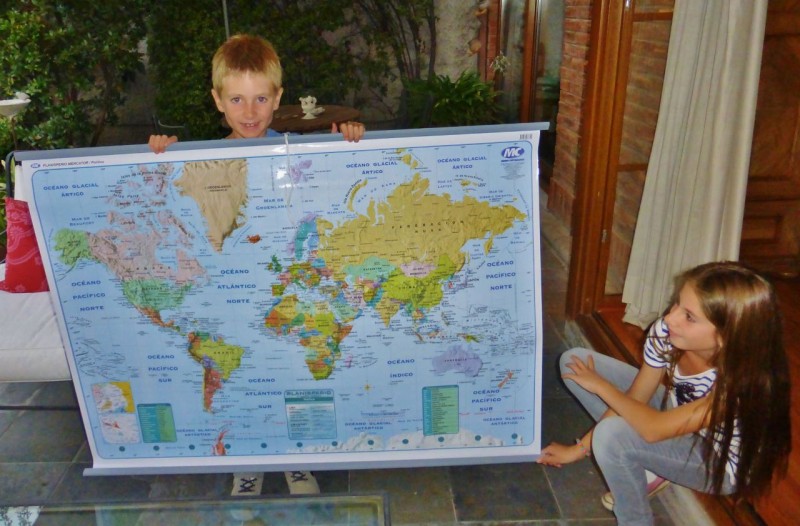
It has been summer vacation and all the schools have been on holiday since we arrived back in December, so we have not been able to give away any more of the world maps we bought in Ecuador. Sebastian and Luz’s kids, Seba and Amelia turned out to be enthusiastic recipients.

In the meantime, Sebastian, a true gift to us, had busily been setting up Charlotte’s shipping. He was able to line up passage for her the same week we rolled back into Santiago. Despite it being a very hectic time in Sebastian’s normal work life, his hours of preparation made everything go smoothly when we all arrived at the port in Valparaiso. Ned was able to load her and tie her down himself, so we felt more secure about her month-long boat ride up the Pacific to Long Beach. We had to air her tires down to almost flat to get her into the container, then drain all the gas and disconnect her battery.
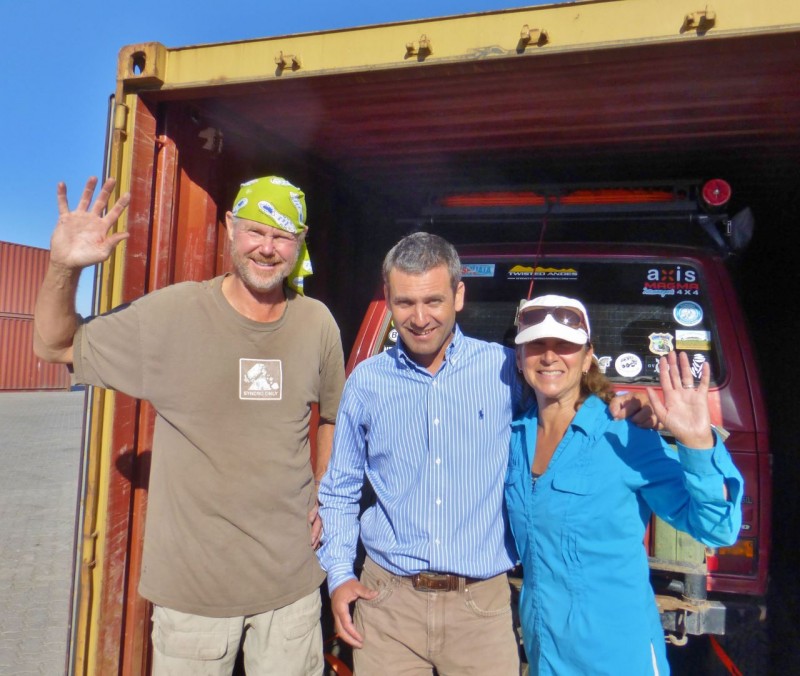
After fourteen months and 29,400 miles, our South American odyssey came to an abrupt end.
A million thanks will never show our appreciation for the selfless Sebastian who, along with his wonderful family and friends, made our time in Chile extra special.
The day after loading Charlotte, February 19th, 2015 we said goodbye to South America and flew 30 hours home to face reality…
Stay tuned next time as we reveal a mini-trauma that occurred in the shipping process and cover the retrieval of our beloved Charlotte from her watery vacation. As this goes to press, her ship is supposedly docked in Long Beach waiting to be unloaded… Our plan is to fly to L.A. and drive her home to Minden on her own power (questionable at this point). If she rolls into our own driveway she will have covered just 100 miles shy of 30,000 miles since rolling out of it back in December 2013. What a THRILLCRAFT!
“Turn Around Charlotte, There Ain’t No More Road!”
It feels like a month has passed since our last blog from Viña del Mar, but it’s only been a couple of whirlwind weeks, packed full of adventures and stories. We’ve driven nearly 3,000 miles, crisscrossing back and forth from Chile to Argentina several times, enjoying fantastic food, great people and scenery that still astounds us. Enjoy this new blog post as we drive to the End of the World and have some fun along the way! Ned and I left Viña del Mar, Chile (North of Valparaiso, near Santiago) on January 10th, hitting the I-5 (PanAm) to make some time getting south. We found Chile’s central agricultural region similar to California’s San Fernando Valley and oddly named the same. Chile’s San Fernando Valley boasts the same I-5 running north/south, is nestled between the coastal range and the Andes and has McDonald’s and Shell gas stations dotted along the highway. It even has lots of fruit stands and highway exits with names like Tracy and Santa Cruz. It was eerie, and we had a hard time believing we hadn’t dreamed the whole trip, ending up back in Fresno.

But then we turned east to cross the Andes into Argentina. Definitely not in central California! I almost want to call this post, the blue water blog. This lake was just the first of many of the most incredibly blue bodies of water I’d ever seen. From azure to turquoise, these last two weeks have been a blue lover’s paradise.
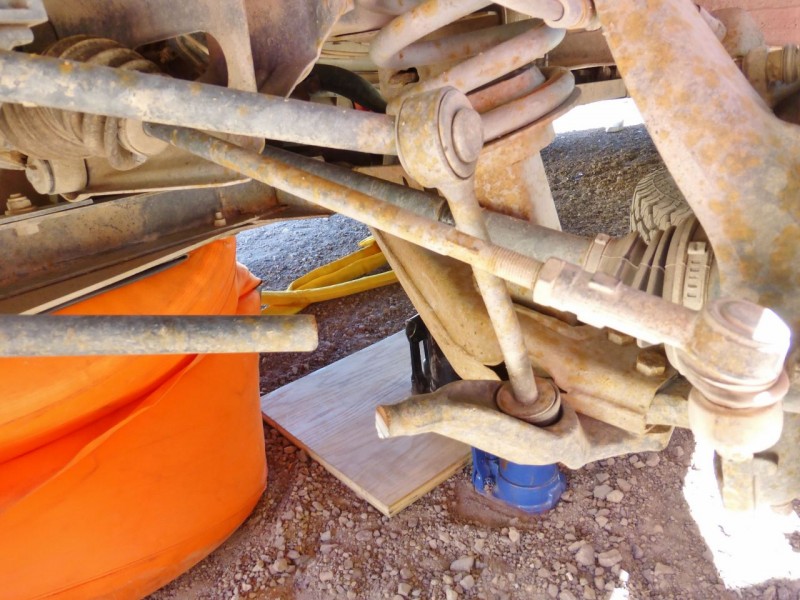
Having exported ourselves from the Chilean side of the border on the Paso del Guanaco, we were in the 20 mile No Man’s Land stretch between Chile and Argentina when we heard a horrible pop followed by metal on metal grinding. Ned got out to take a look, and from somewhere under Charlotte, I heard a stunned, “Holy Shit!” Not a good thing to hear from the driver/mechanic/car whisperer. The left front radius rod had snapped in two. It was a freak (“never seen that before”) injury to poor Charlotte, and Ned said we weren’t going anywhere until we got the broken part to a welder. A welder? You mean like the one we have on board that we can’t use due the alternator fiasco? Yup.
Ned managed to get Charlotte off of the road onto the shoulder with much noise and histrionics from the broken suspension. At that point I took inventory of the situation. We were on a nearly deserted dirt road, 50 miles from the nearest town of Malargué. It was hot and violently windy. Hundreds of huge, biting flies were attacking us with the speed and accuracy of professional snipers. And we hadn’t imported ourselves into Argentina yet. We were in No Man’s land and had no legal papers. Hitchhiking to Malargué would involve getting in and then back out of Argentina.
Then there was a decision to make. Would I stay to watch over Charlotte while Ned hitchhiked the 50 miles to town? Or do we both go, leaving Charlotte unprotected? A horrible choice either way. With no cell signal, no way to communicate and only the vicious flies for company, I knew my wait would be torture. It could be hours or days before Ned got back, and it was too hot to stay inside Charlotte.
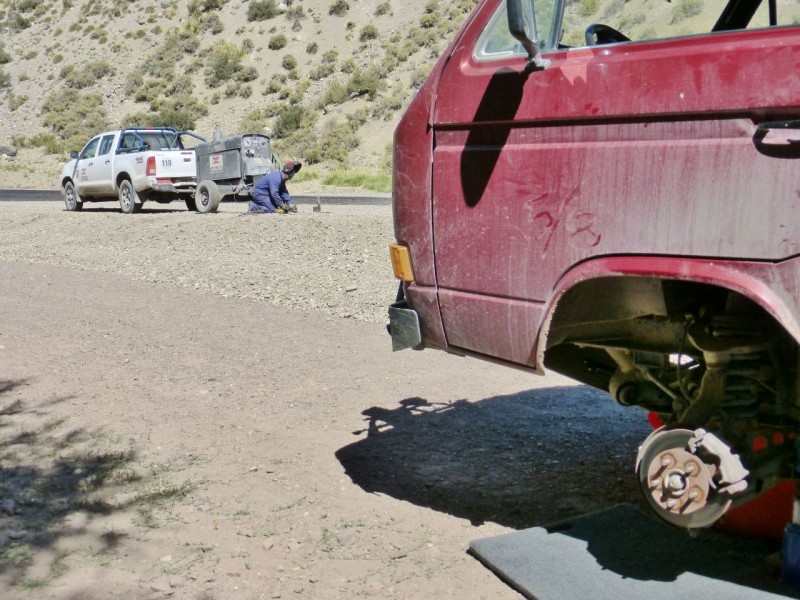
While I was pondering our predicament, Ned was busy removing the broken part. I had just grabbed my backpack (having made my decision to go) when, to our utter disbelief a truck pulling a small trailer came trundling down the dirt road…In a stunning display of providence, on the trailer was an arc welder!
Ned flagged the truck down, and two very nice construction workers got out. We showed them the broken part, and with absolutely no fuss or fanfare, they proceeded to do a professional job of welding the piece. The whole thing was surrealistic. There. Fixed. Like it never even happened. All of my worrying for naught. The world never stops amazing me.

With all three of us legally imported into Argentina, we got back on the iconic Ruta 40 and continued south. We drove through beautiful arid country, stopping by a river to barbeque steaks and veggies, eventually finding a camping spot in a dry wash, hidden from the road.
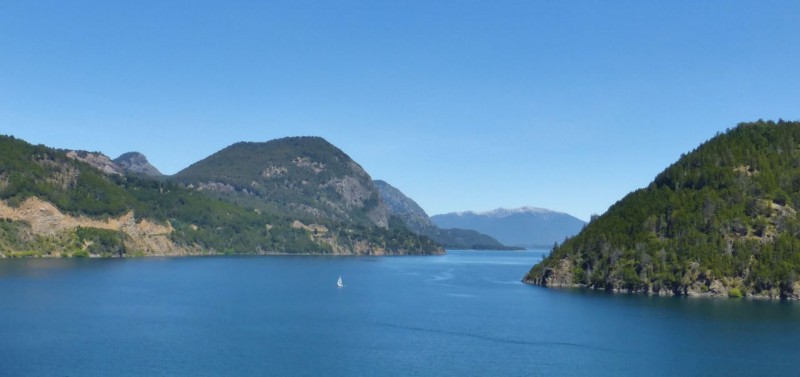
The next day, after breakfast and exercises in our peaceful wash, we continued following the zigzagging Ruta 40, making 400 miles. By dark we found ourselves in a ranching area, still arid and open, but completely enclosed by fences. We had nowhere to camp for the night. We drove and drove, but found no hidey holes, no dirt track, nothing. We were just outside the resort town of San Martin de Los Andes when we spotted a sign for camping. We rarely succumb to campgrounds, but it was 10:30 and we were exhausted. We pulled in, parked in a corner, and fell fast asleep.

We awoke in a cool, quiet forest, surrounded by dense oak and pine. The campground was whisper quiet, immaculately clean, civilized and very…comfortable! It was as if we had suddenly been airdropped overnight and woke up on a different planet. Gone were the mud huts, the dust, the native people, the garbage, the harshness of life. I couldn’t decide if it felt fabulous or flat-line. There was nothing very foreign or exotic, but it was pretty nice.
We had breakfast in the touristy, but charming, San Martin de Los Andes, and continued on following the gorgeous Ruta de Siete Lagos (Road of Seven Lakes).
Clear turquoise water pooled in sparkling streams and tranquil alpine lakes, while stark, snow speckled crags stood sentinel. But gone were the soaring heights of the more northern Andes. Snow at elevations of 4,000 to 6,000ft in the height of summer was a sure sign that we were getting to southern latitudes.
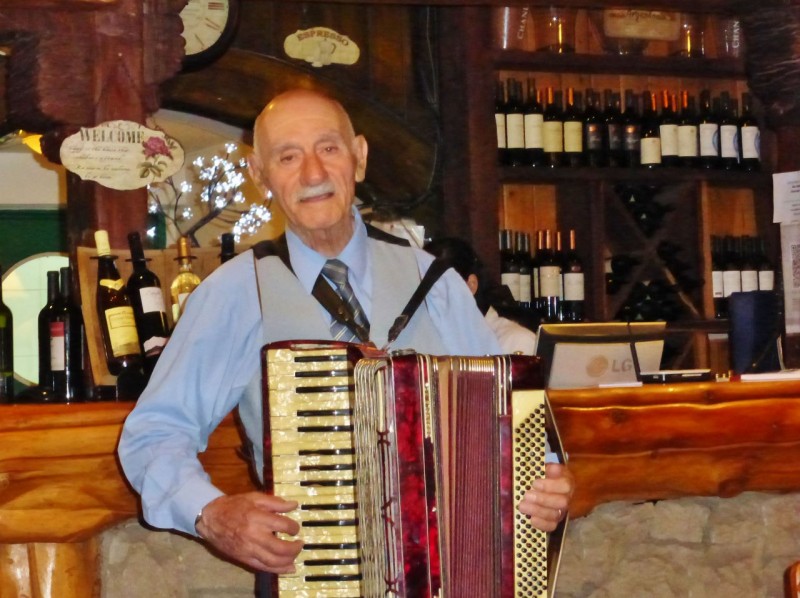
We landed in the bustling city of Bariloche with high expectations, but, having sped through two lovely resort towns along the Ruta de Siete Lagos to get there, were disappointed. Gone was the alpine setting, gone was the charm. It just wasn’t our kind of town. We stayed one night and had a nice dinner where this accordion player, who was very charming, entertained us.

By sheer accident (needing gas) we stumbled upon the very cute town of El Bolsón, where a lively festival was in full swing. Street musicians were playing, and the atmosphere was relaxed and uplifting with a decidedly bohemian feel.
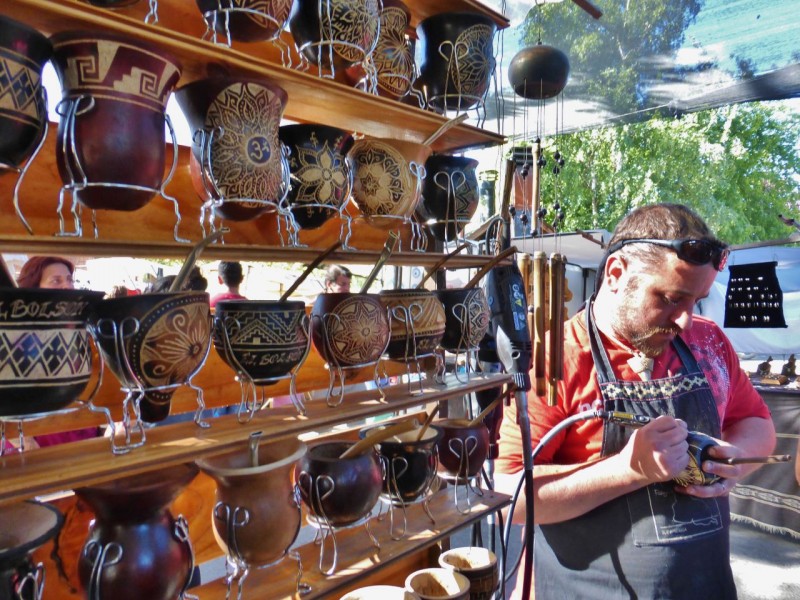
Unlike many “Artisan” fairs, where it seems most of the wares are mass produced, the artists here displayed beautiful, hand crafted art. This man was carving lovely designs on gourds for drinking mate (pronounced ma-tay). Mate, short for Yerba Mate, is an herb which is packed in a mate vessel (of choice), covered with hot water and drunk through a straw-like contraption (called a bombilla). Argentineans love their mates and are often seen ambling down the road, sipping on their mates with hot water thermoses (for refills) slung over a shoulder.
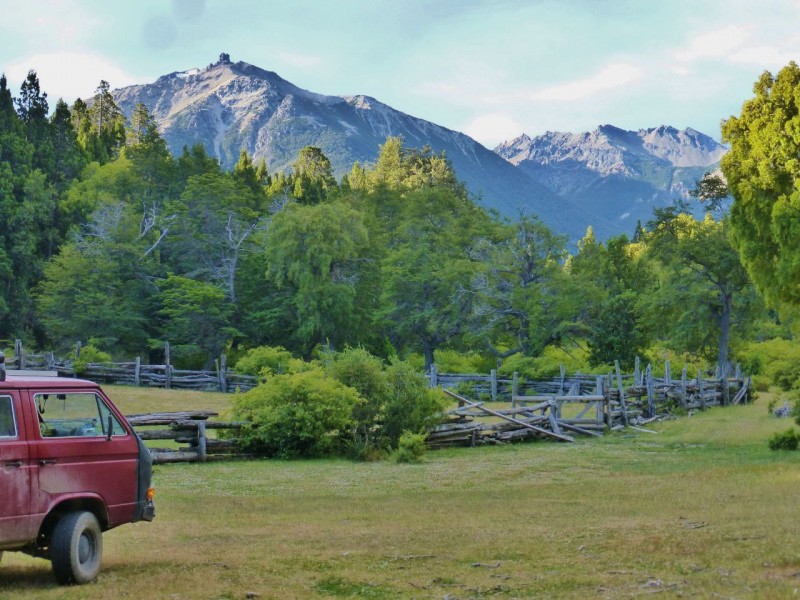
We ducked off of the 40 to drive down the RP 71 through the Parque Nacional Los Alerces (named for an alpine tree), but it was getting dark. Just before the park entrance we spotted a small opening in the fence, and followed a dirt track into paradise; a lush meadow surrounded by beautiful trees and craggy mountains. There was also a wonderful, old split rail corral, but it looked like no one had used it for years. The night was star-filled and fabulously peaceful. We read later that Butch Cassidy and Sundance had a ranch very near this area, hmmm…?

Morning in paradise.
Ned, having bought a gourd in El Bolsón, is now our resident mate expert, but still generously makes me my morning coffee. We spent the whole morning in our tranquil cow pasture, relaxing with our hot beverages of choice, eating breakfast and working out, even romping through the meadow like youngsters.

Ah, but we do still love the wide open desert. Another lovely camp down a lonely dirt track off of the 40. Dipping from arid to alpine provided refreshing contrasts.
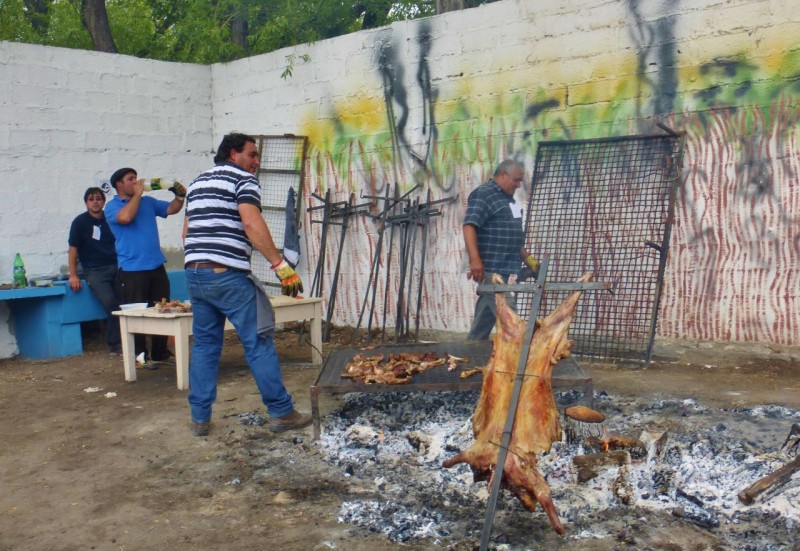
Another festival, another sharp contrast. In Rio Mayo, we spotted a sign saying “30th Annual Festival Nacional de la Esquila.” We had no idea what an esquila was, but there were lots of people milling around with a totally different feel than El Bolsón. No hippies here. We were now in Argentine Patagonia, sheep country, so we weren’t surprised to find lamb roasting on open fire pits. We had heard that “cordero asado” was the traditional food in this area, but we had no way of knowing…
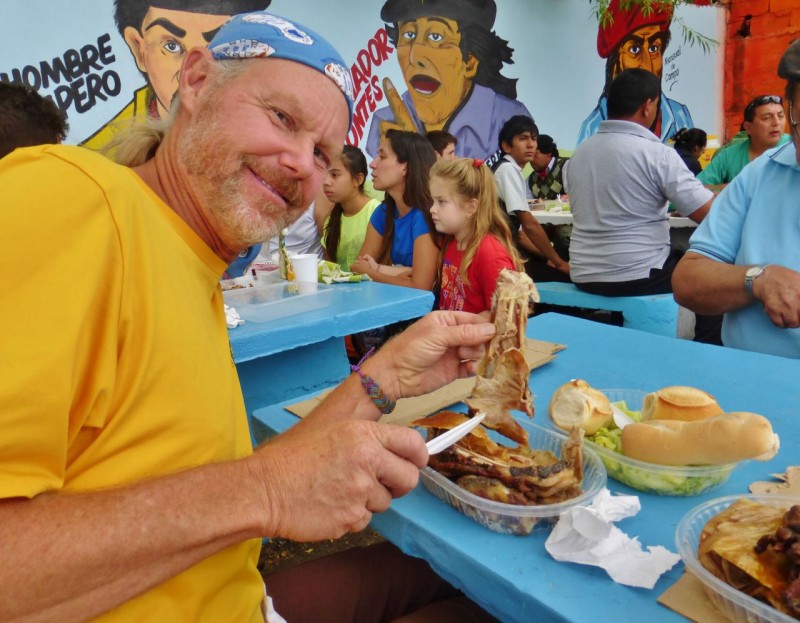
…just how wonderful it was! We jumped in line for our cordero and sat with the locals to enjoy the tender, crispy, succulent treat. The funny dudes painted on the wall behind Ned were comic renditions of different gaucho personalities.

Walking off our lamb feast, we found, not handmade crafts, but tons of cheap Chinese clothing and plastic crap, items useful in rural and ranching homes. It was a dose of reality.
Then we found the contest and figured out what esquila was…shearing! It was a sheep shearing contest and it was brutal. And exciting. And real. I know for some of you who are vegetarians and/or animal lovers, watching us munch on lamb bones is a bit tough, but this will be worse. We spared you some of the most graphic shots, but these are still pretty harsh.
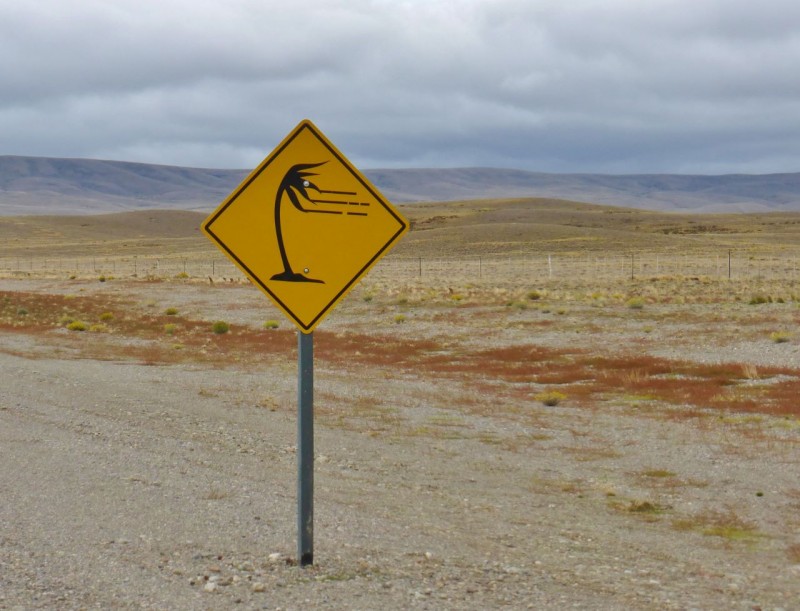
Another favorite sign…yes, wind has been our constant companion here in Southern Argentina.
At this point we were feeling a bit of urgency. We were around 700 miles from Ushuaia, a town on the island of Tierra del Fuego and the southernmost point we could drive to. But we were somewhat on tender hooks. Poor Charlotte was suffering with coolant leaks and subsequent overheating, a gear oil leak, an exhaust leak, a clacking CV joint, a brake squeaking and tires that kept plaguing us with flats. We were feeling the need to beeline south to Ushuaia.

But there were just so many wonderful diversions along the way. We spotted a sign saying Cuevas de Los Manos (Caves of the Hands) and just had to go look, following a nasty washboard road 30 miles to this canyon.

The Cuevas de Los Manos are actually a big deal. It is a huge archeological site, and we paid to have a tour. There were 20 people in our group, but the energetic guide spoke rapid-fire Argentinean Spanish (which is nearly undecipherable). Juan (or John as he asked us to call him) was not an official guide, but was a youngster proud of his English and working here for the summer. He tagged along to translate, but ended up giving us and two Germans our own private tour.
When asked if he liked his job, he replied, like any 21 year old would, that the 15 day stints without Wi-Fi or a cell signal were torture. John did a fantastic job and had a dry, witty sense of humor. His English was heavily accented but very good.
At one point when the German couple was lagging behind, taking photos, John turned to us, and with absolutely no trace of an accent said, “Oh for the love of Christ,” and tramped off to round up his wayward tourists.
John is hoping to get accepted to a university to become a biologist. I think he’ll do just fine.

There were thousands of hands “stenciled” on the long wall, preserved by an overhanging cliff. The astonishing thing is that they were done 9,300 years ago in a two color process. One color (paint made from local minerals, flora and spit) was put down as a base. The second was sprayed by mouth through a straw over the artist’s own hand.

These ancient people relied heavily on the guanaco. Archeologists believe this was painted during a time of thinning herds and depicts pregnant guanacos with the fertility symbol of the full moon.

Onward, toward the town of El Chaltén, the “Trekking Capital of the World” and the jumping off point for mountaineering in the area around the famed spires of Fitz Roy.
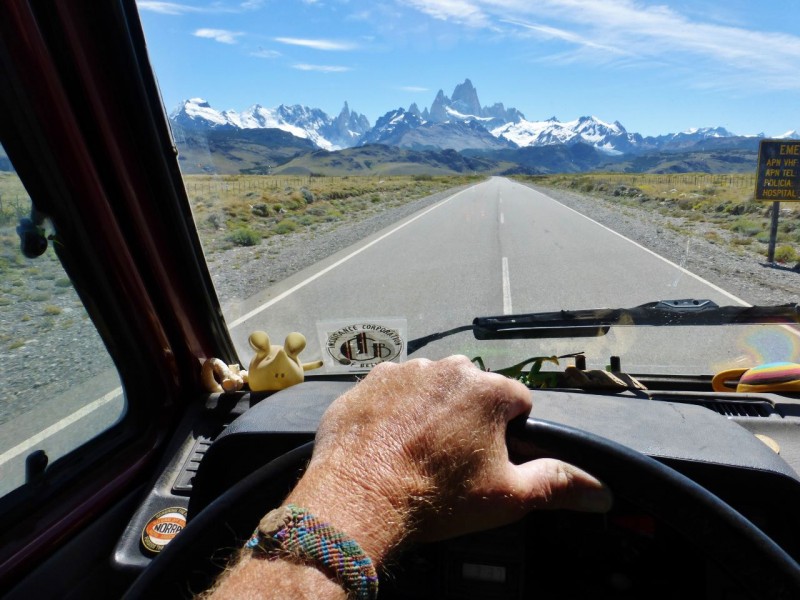
Driving into El Chaltén, we got our first glimpse of the stunning Fitz Roy. Chaltén is a relatively new town, built only in the 80’s to support the booming interest in trekking. We stayed two nights in the town campground (which was filthy), but enjoyed some really great meals…
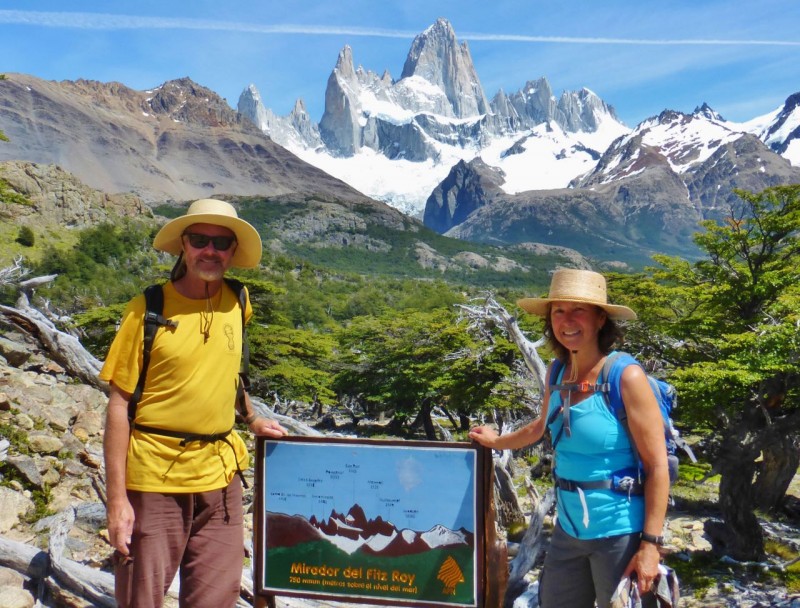
Ned’s cousin Charlie had told us, “Fitz Roy is loved to death.” That’s an understatement. We found ourselves on the trail with dozens of hip 20-something Bobby Backpackers. We thought we were pretty cool too, until we saw this photo of Ma and Pa Kettle.
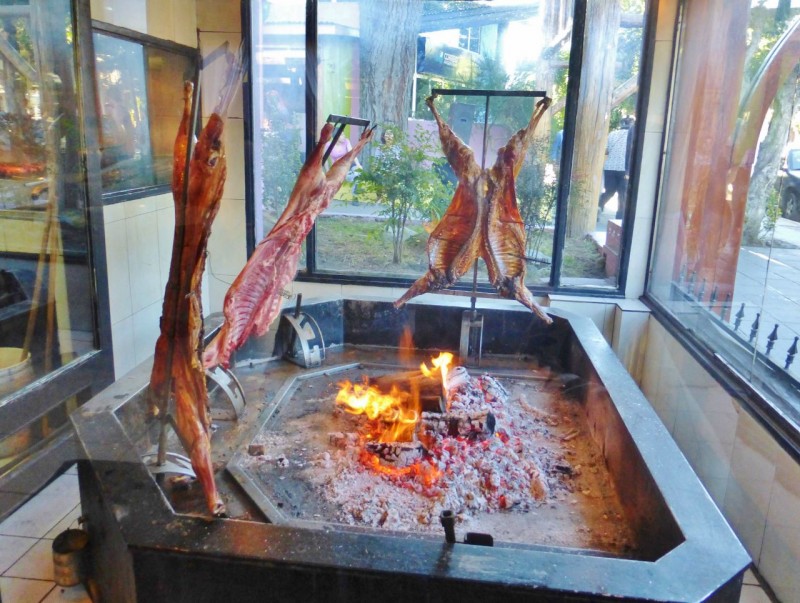
Our next stop in Argentine Patagonia was El Calafate, the gateway to the area’s most spectacular glaciers. Here we happily found wonderful hardware and auto parts stores, both with incredibly helpful guys at the counters. Ned was able to get critical supplies needed to work on some of Charlotte’s ailments. We spent only one night, anxious to get out to the park to see the glaciers.
Our first cordero asado had been at the shearing festival where we paid 100 pesos (about 12 bucks). Our second was in El Chaltén where we paid 150, but it was equally as delicious. Now addicted, we had some here in the higher end tourist area of Calafate. The presentation was certainly nicer, but we paid 230 pesos and it was dry and tasteless by comparison. Lesson learned.

Approaching the Parque Nacional los Glaciares, we got our first look at the mammoth Perito Moreno Glacier.
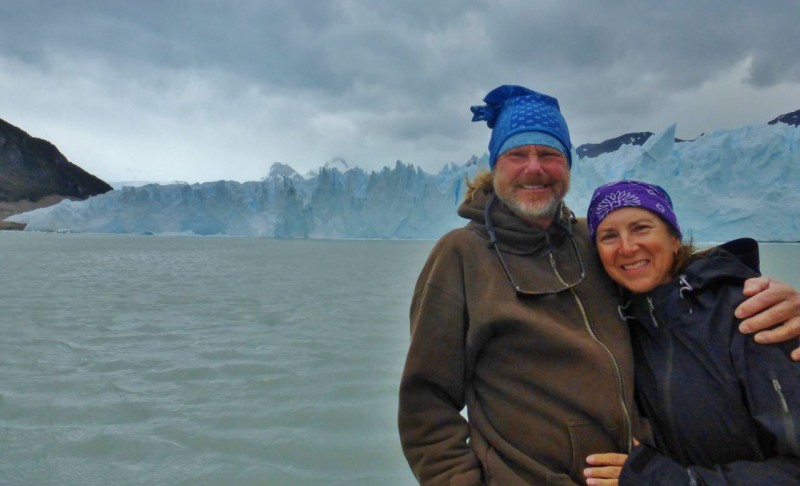
An hour long boat ride gave us an impressive, up close view from the lake. It was cold and rainy, but beautiful.
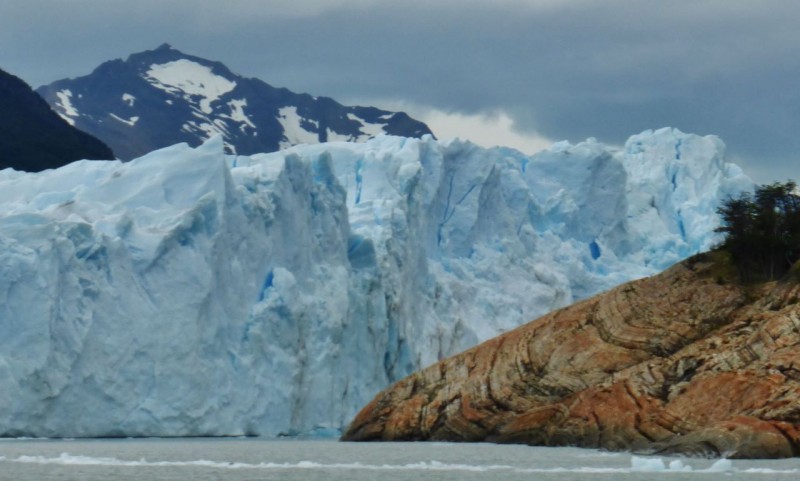
Perito Moreno (named for an early explorer) marches at its glacial pace to the edge of Lago Argentino, covering 97 square miles in ice. It is 19 miles long, and averages an incredible 240 feet above the surface of the lake.
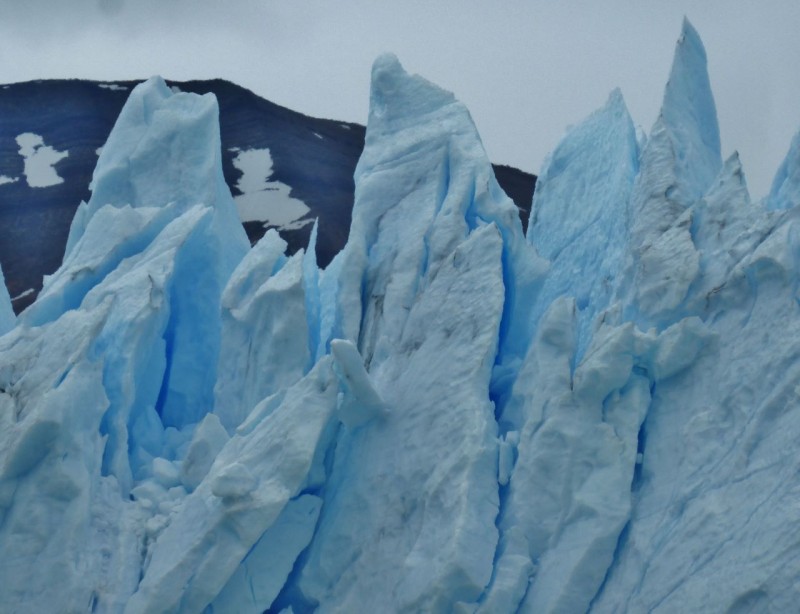
Looming 25 floors above us, the ice creaked and groaned ominously. From time to time, massive chunks “calved,” falling into the lake, producing a mighty splash and booming thunder.

Once off the boat we took the hike to the northern side of the glacier to see it from a different perspective.
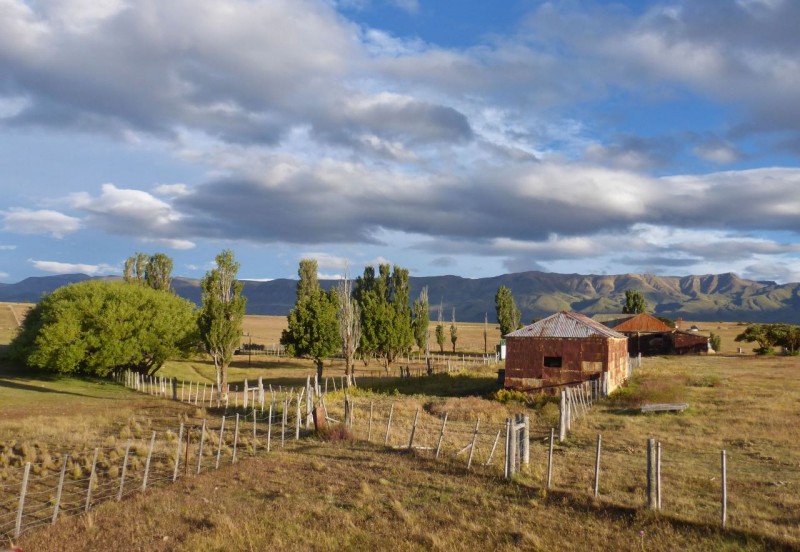
The park campground was accessible only by a 20 mile washboard road. Not really excited about another campground, we followed a faint track in the grass to this abandoned ranch. We parked next to the fence, over a rise and completely out of sight of the road. It was one of the best camps ever.
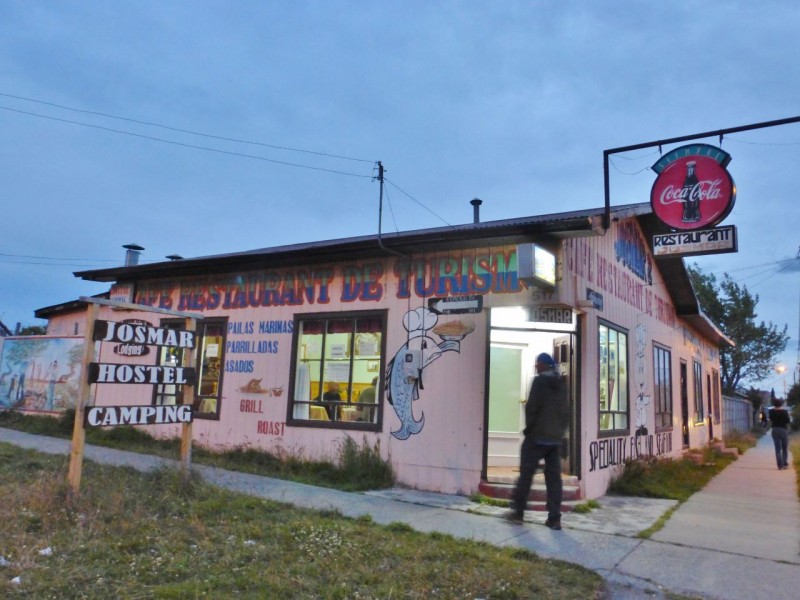
Crossing back into Chile to the town of Puerto Natales, we finally found new shoes for Charlotte. Unfortunately we had to wait until morning to have them installed, so we stayed at this funky campground for the night.
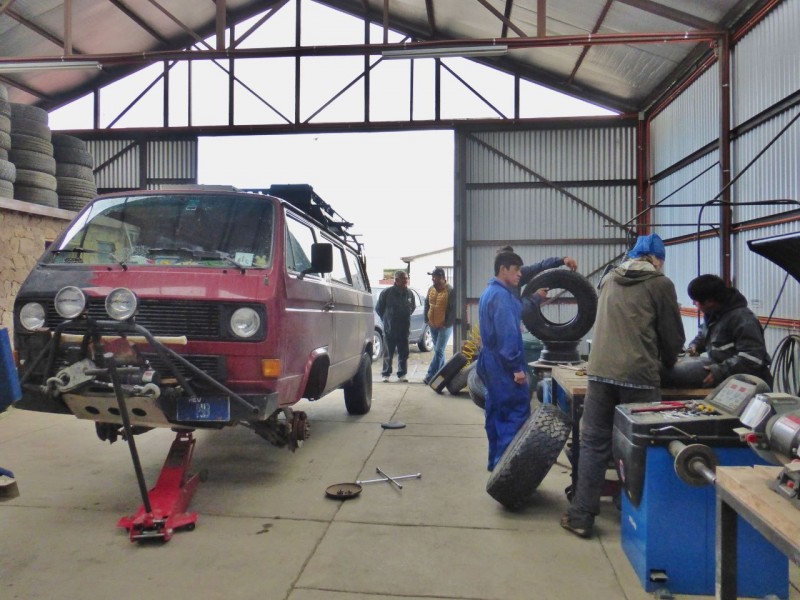
Never trusting anyone to do the job right, Ned supervised while the guys installed Charlotte’s new tires. The Car Whisperer had also put a new gasket in the leaking exhaust and stop-leak gunk in the radiator. Both fixes, while temporary, appeared to be holding, so tires were the next big relief.
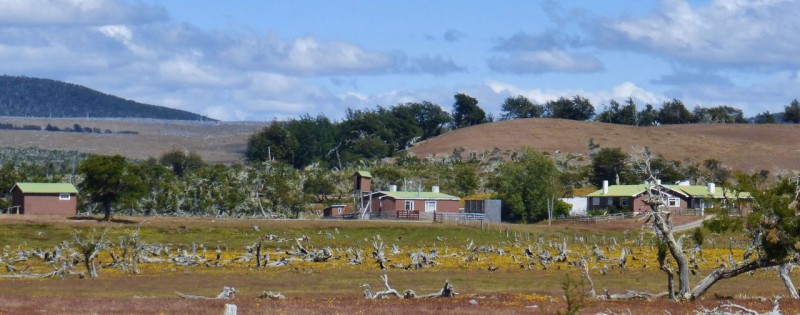
The Estancias (Ranches) in Patagonia are gorgeous. Tidy and well kept, each ranch sported uniform colors on the roofs of their buildings. Some roofs were bright red or yellow, some a mellow green like this one.
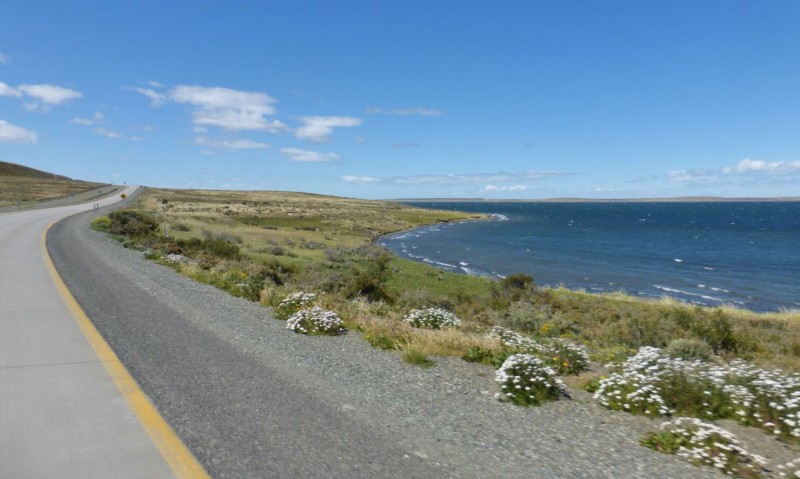
From Puerto Natales we took the Ruta 9 south, then the 255 east where we came to this big water way. Looking on our map app, I could see that it was the first place where the waters of the Atlantic meet the waters of the Pacific. It seemed pertinent. And then it hit me. This was the Straights of Magellan! I don’t know why, but this got me very excited. A place we learned about in grade school! Explorers! New world! And we were getting so close to Ushuaia.

Along the beautiful blue waters of the Straights, we came upon this historic Estancia and decided to look around. We were in for some big surprises.

Around the back of the biggest building we found some work going on. Gauchos were herding and separating sheep.
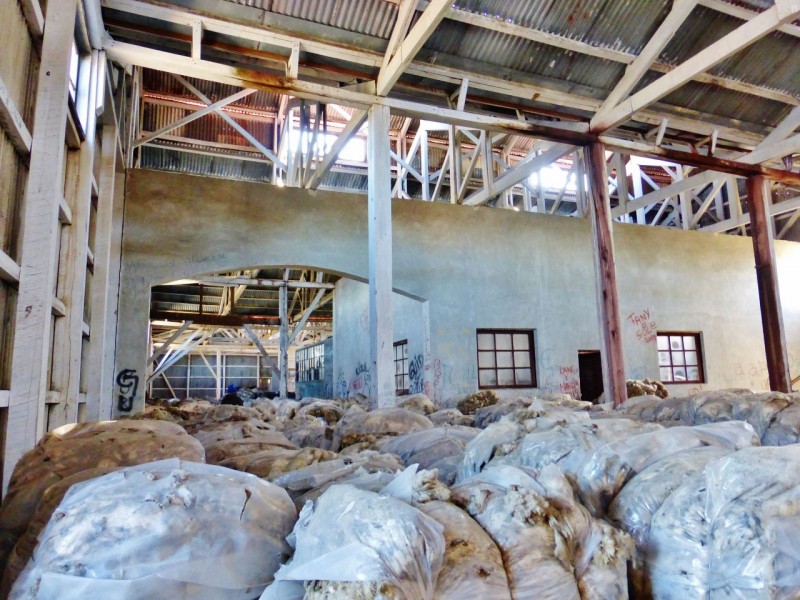
Exploring inside the building, we discovered hundreds of huge bales of wool. We thought we were trespassing and crept around stealthily…

…only to walk right into this scene. Instead of being angry, these gauchos welcomed us, and invited us to get closer to the action.
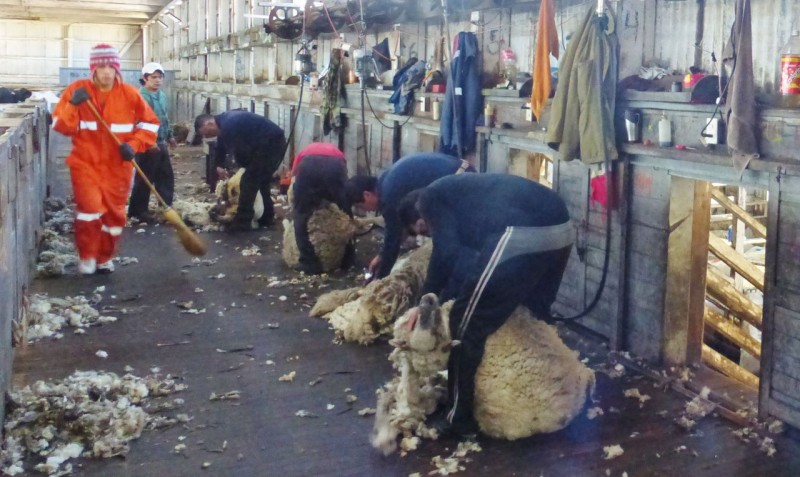
By another stroke of good fortune, we had arrived at this Estancia’s shearing time. But this was no contest, this was the real deal. The guys worked so fast that all of the photos of hands are blurry. I felt guilty being in their way, as they had obvious deadlines to meet, but they could not have been kinder.

The sheep were also treated much more gently. They were not tied and quietly submitted to the shearing. The whole time we were there, we saw no bloody cuts, but the work still got done fast.

The gaucho behind me thought it would be fun (or funny) to see if I would hold a fleece (yes, this is an entire sheep’s coat). I knew the fleece was filthy and greasy with lanolin, but I couldn’t resist. It was really dirty, but sooo soft!
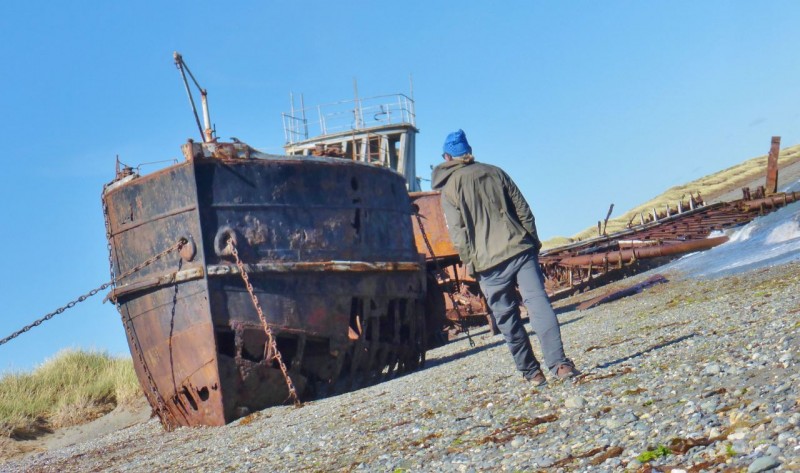
Another visual treat on the Estancia…two shipwrecks!
Both ships were in use in the Straights in the late 1800’s, wrecked in the early 1900’s.

Getting closer! We were on the Ruta Fin del Mundo…the Road to the End of the World! This was also the first sign pointing to the island of Tierra del Fuego.

We arrived at the Puerta Delgada and boarded the ferry to the island. It was an efficient 20 minute crossing of the Straights of Magellan.
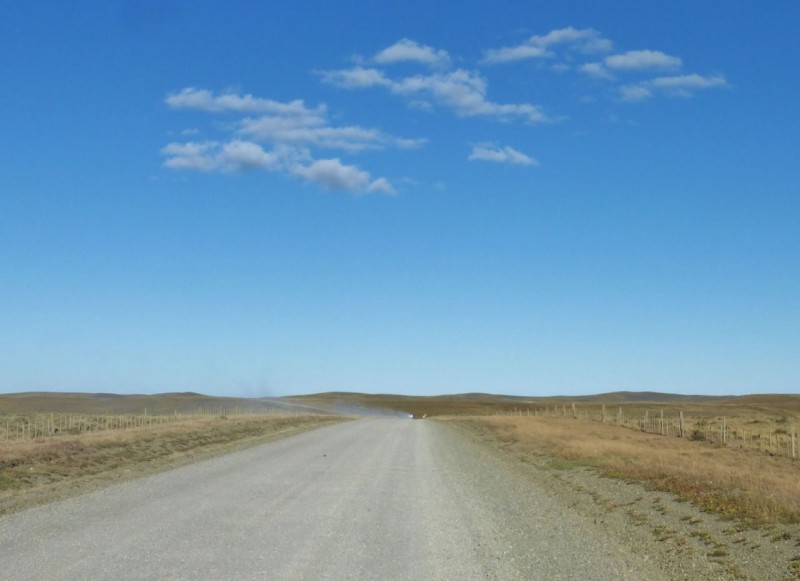
Tierra del Fuego? Land of Fire? Really? It looked more like Nebraska. But it was still very exciting to be here.
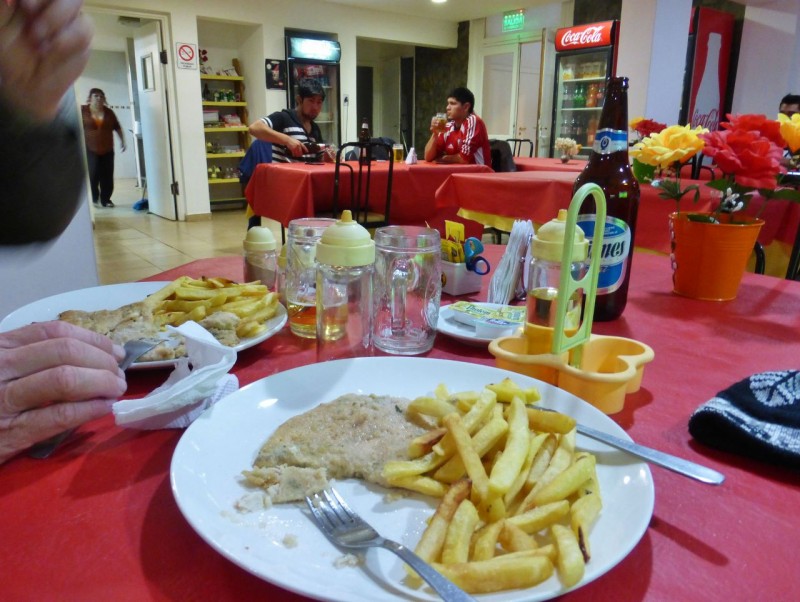
After nearly 100 miles of torturous washboard roads, we drove back into Argentina for our final push to Ushuaia. But it was getting late when we made the border crossing, so we had some dinner at this fine hostel in San Sebastian, a dusty, border outpost. The gal at the counter said they had Chicken Suprema or Bisteca Milonesa. “What’s the difference?” we asked. “One’s chicken, the other’s beef.” Ok, we’ll have the chicken. We waited an hour and half, finally eating our mystery chicken and fries at 11:00pm (have I mentioned that these people eat late??!!). We were so tired, we drove around to a road construction site a couple of hundred yards from the hostel. We bedded down, thinking that tomorrow was Sunday and no one would show up at the site.

Wrong! We woke to the sound of tractors firing up. Oh crap! We scrambled to get dressed and out of there as the grader worked back and forth right in front of us. But the guys were cool, smiling and waving as we drove away. Ned grinned and said, “You want to drive to Ushuaia today?” How cool is that? That’s exactly what he said the day we left home 13 months ago. 13 months ago we were 27,000 miles away. Now we only had 170 miles to go to get to Ushuaia!

Ok, getting to Ushuaia was cool, but, checking the map, we found it was not the farthest point we could drive. We needed to go another 20 miles into the Parque Nacional Tierra del Fuego, where the Ruta 3 would finally end at the southernmost point. We weren’t done yet, and neither of us was ready for a city.
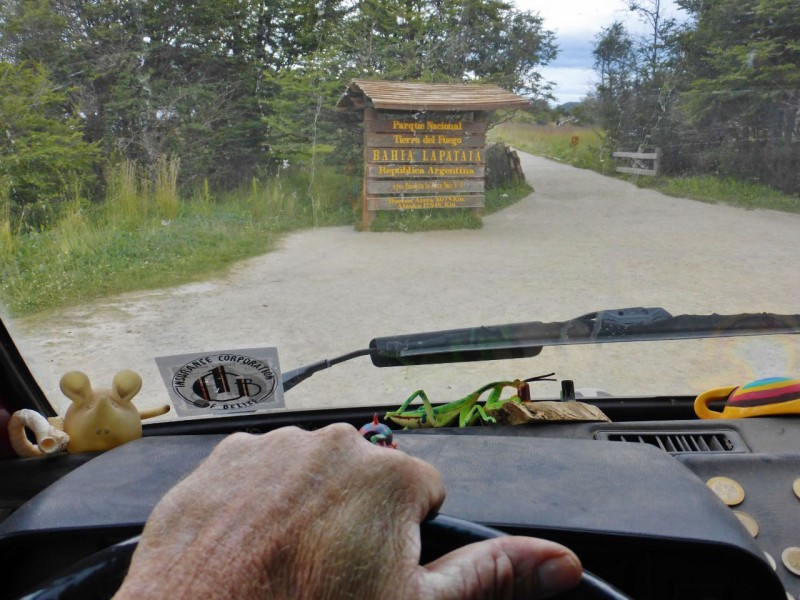
“Turn around Charlotte, there ain’t no more road!!” Driving through the park we finally arrived at the Fin del Mundo…

…the End of the World!
A happy moment for Ned, Kat, and Charlotte (and Vaca Muerta too, who has been our good luck charm since Baja Mexico).

Exploring the park, we found it gorgeous, but very cold and drizzly, even now, the warmest time of a southern hemisphere summer.

Ushuaia was infamous for its brutal prison in the early 1900’s and this historic train that runs through the park was the prison train. Now it carries happy tourists through the lovely park.
As I was trying to get this great photo of horses grazing peacefully with the train going by, the horse behind ruined my shot by nagging and pushing the other one into action. I swear it was a dare because he finally got the other one going and I watched in amazement as they raced over the tracks right in front of the train.
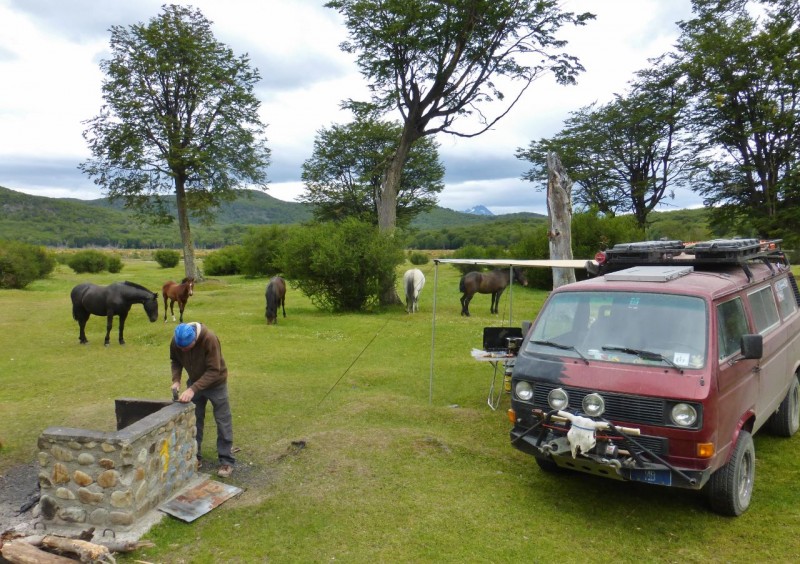
Our entrance fee included two free nights in this incredible, primitive campground. Our only neighbors were very quiet (and four legged).
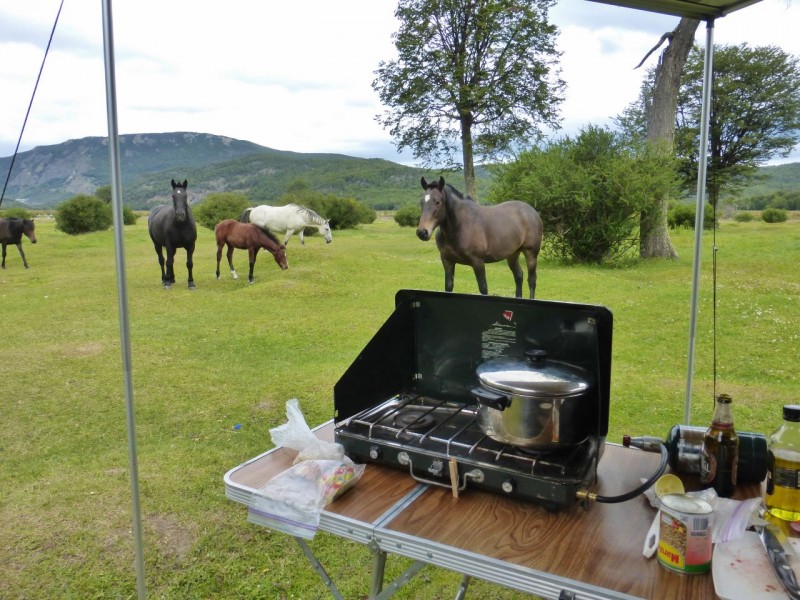
They did want to know what was for dinner, though…and they would have liked it! Not being well provisioned with fresh food, I scrounged up a vegetarian dish:
Sautéed onion and garlic in olive oil
Add:
1/2 beer
Some water
Diced potato
Quinoa
Can of lentils
Diced tomato
Hot curry powder
Tandoori spice
Dash of cumin
Basil
Salt and pepper
Splash Balsamic vinegar
Not bad for a veggie meal!

The next day we did a wonderful 5 mile hike to a lookout over the Beagle Channel which lies south of the island of Tierra del Fuego. The forest had a mysterious, quiet feel, aided by the fact that we saw no one else the whole hike.

It felt wonderful being here at the End of the World. The three of us have driven 27,000 fantastic miles together, and it’s not over yet. We still have to drive 3,000 miles back to Santiago, Chile, the closest port where we can feasibly ship Charlotte home to the west coast. We focused on southern Argentina on the way down. On the way back north we plan to cover southern Chile. Still to come…exploring Chilean Patagonia and the famous Carretera Austral!
Chile Part Two – Geysers, Ghosts, Dunes and Dakar

Kat and I are back in central Chile after a couple of amazing weeks in the northern parts of this country doing and seeing some unusual things. When we left our story in the last blog, we had just entering into Chile from Bolivia on the right side of the map (top finger). We spent the New Year holiday in and around the quaint, if touristy, town of San Pedro de Atacama, crawling around in surreal caves and freezing while watching hot geysers blow off steam. From San Pedro we once again took the back (i.e. dirt) way south across another salt flat and miles of empty desert before hitting the Pan American Highway at the finger on left side of map. But before we could make a quick run to Copiapó (a small city we spent time in last September trying to get Kat well) we had to spend a day and two nights with some ghosts while attending to Charlotte’s needs… Read on.
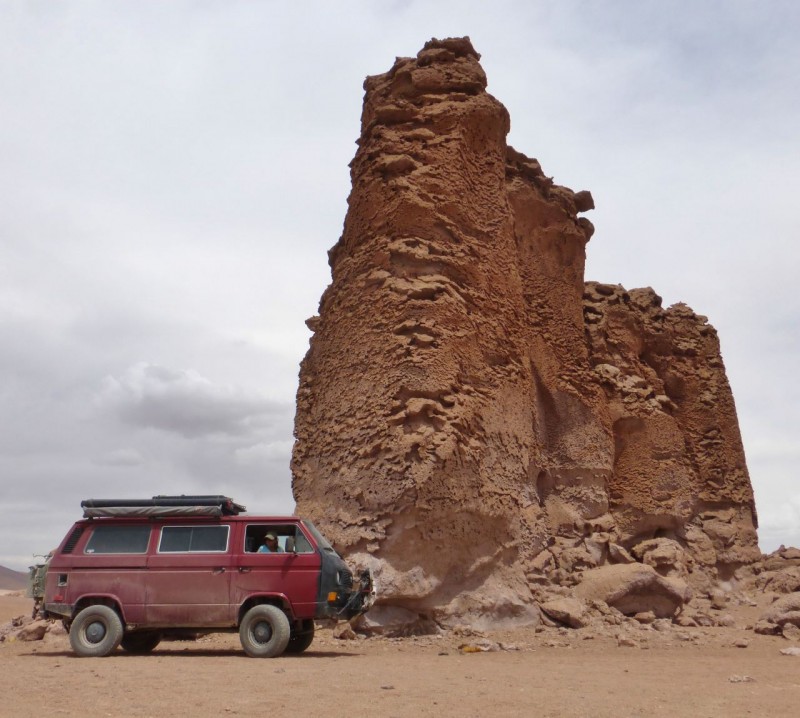
Within 10 miles of crossing the border into Chile we were back on pavement and already seeing signs we were in a much more advanced country. This particular border crossing is unusual as the Chilean entrance is in the town of San Pedro de Atacama, 27 miles southwest from the Bolivian exit border. In between is a no-man’s land that runs between the two countries and also touches the border of Argentina. Within this no-man’s land is the Reserva Nacional Los Flamencos. We headed there to kill some time and to eat up all the fresh food we still had, not wanting to hand it over to the Chilean border guards. Chile is the only border we have crossed that is extremely strict, enforcing its laws to the letter when it comes to protecting crops by restricting the importation of foreign food.

Done playing with the rocks, we headed into San Pedro and officially crossed the border – only losing some eggs in the process. The adobe town of San Pedro is full of tourists from all over the world. Some are there to take the Land Cruiser 4X4 tours we saw in Bolivia; some for the numerous attractions around San Pedro itself. The town is brimming with trinket shops and good restaurants. We stayed in a cute hotel, washed off the Bolivian dust, wrote the previous blog and re-stocked Charlotte for the journey south.

A maze of caves and caverns was a highlight. All were open with no restrictions or safety precautions for anyone to crawl around in to their heart’s content.

On New Year’s Eve we drove 70 miles up hill to Geysers el Tatio. San Pedro is at a low 8,000ft, but once again we found ourselves back at 14,000ft for the night. We passed these guys munching a watery meal along the way.
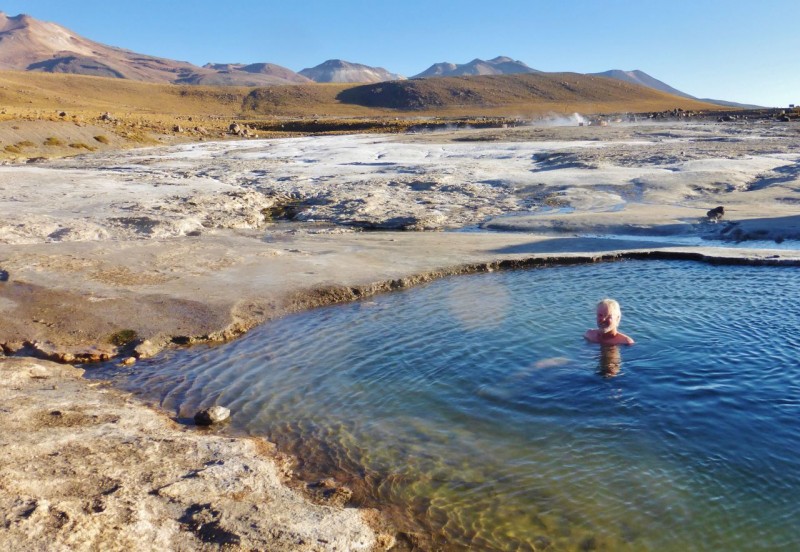
This pool was designated for swimming but we found it rather tepid – except when a boiling hot jet would suddenly shoot out of the bottom and burn your butt! Yikes!

We arrived late in the afternoon and found we had the entire place to ourselves. The dozens of tour busses and hundreds of tourists that visit these geysers every day were long gone. We soon found out why. First, the wind… we took cover behind this crumbling shack in order to cook our New Year’s Eve dinner. Even at 8pm it was still this light out.
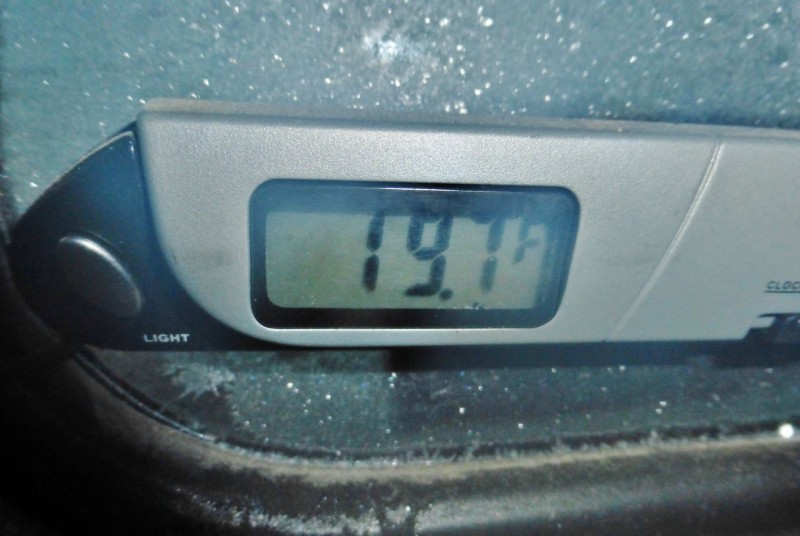
Then the cold… It was 19.7F inside Charlotte at 6am New Years Day when we got out of bed. However, at 4am when I checked, this thermometer read 14.6F! Note the ice on the window glass. Yes, we have a heater – a very expensive gasoline powered one that I installed especially for this trip. But, it won’t fire up above 11,000ft! I think it has something to do with jetting but I can’t get parts for it anywhere. So we freeze.
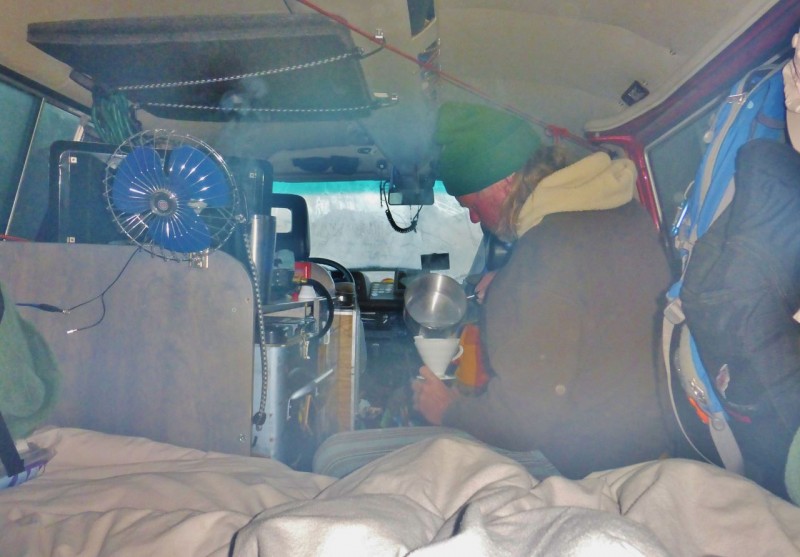
Ah, but the good ol’ Coleman stove (28 years and counting) always fires up and makes hot water for tea and coffee and warms Charlotte in the process.

The reason we got up so damn early was to see the geysers at daybreak, a time when all the tour buses show up, so we figured it must be good. It was.

The cold air really makes the steam show up and puts on quite a show. Despite the cold, we both agreed camping alone at this desolate place and waking up to this display on New Year’s Day beat the hell out of getting up at 4am in San Pedro and riding a bus for two hours to share the scene with us, as dozens of tourists did.
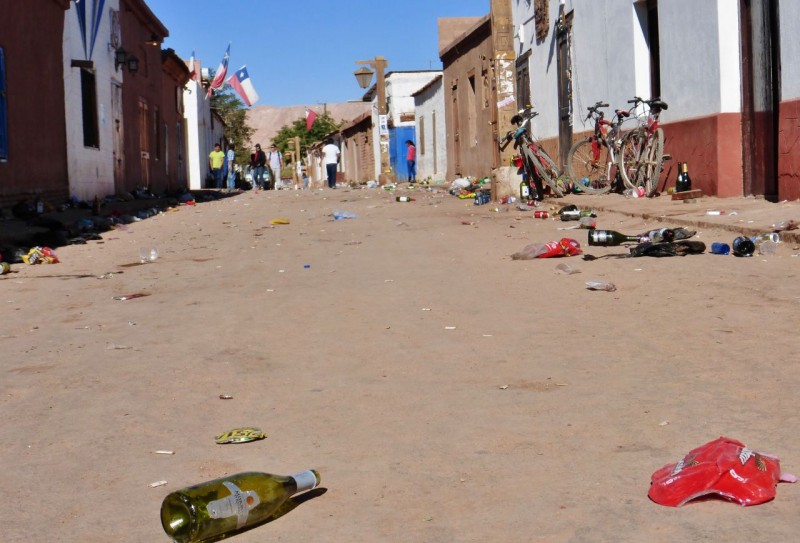
Back in San Pedro for a late New Year’s Day breakfast we were even happier we had our quite night at 14.000ft. The main drag looked a bit worse for wear the morning after.

On the road and goin’ south. The Salar de Atacama salt flats are a bit rougher than the Bolivian ones.

There are some huge mines in remote northern Chile and huge trucks to go with them. Check out this monster in relation to the power pole.
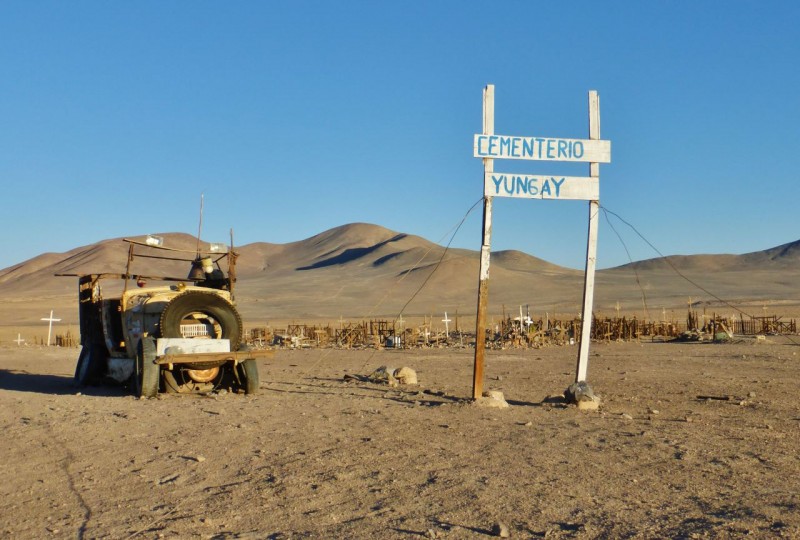
Late on New Year’s Day we came across this sad, desolate graveyard, pretty much in the middle of nowhere. There was no town of Yungay to be seen but the ‘yard did sport the remains of a Model A.

We had to stop and check it out. It seemed odd that in a country full of rocks and not a tree for miles, there were few headstones and everything was made of wood. Most of the dates ranged from the ‘20s through the ‘50s with a few as new as ten years ago.

Returning to Charlotte we found the ghosts didn’t want us to leave. This was the second of two flats we had had that day. Our trusty Generals that have treated us so well are getting pretty thin after a year of torturous roads. We had a slow leak in the morning in the right rear after returning from the geysers. That tire had a tube in it due to a sidewall rock slash back in Columbia, so I couldn’t plug the new leak. All the llanterías (tire shops) in San Pedro were closed for NYD so I opted to just put air in it every hour or so… that worked until about noon when POW, the tube let go. On went our brand new Bridgestone spare which had been along for the ride since Arequipa, Peru. I attacked this new left rear “ghost flat” with the tire plugs, but after wasting five of them, trying to plug the rather large stone cut in the center of the tread (which kept whistling air like the ghost winds blowing around us), I resigned to the fact that bigger labor lay before me.

We made camp where we broke, right in the middle of the road next to our new friends. So much for that pact about finding a hiding place every night. We hadn’t seen a car all afternoon so we figured it would be a pretty quite night. It was.
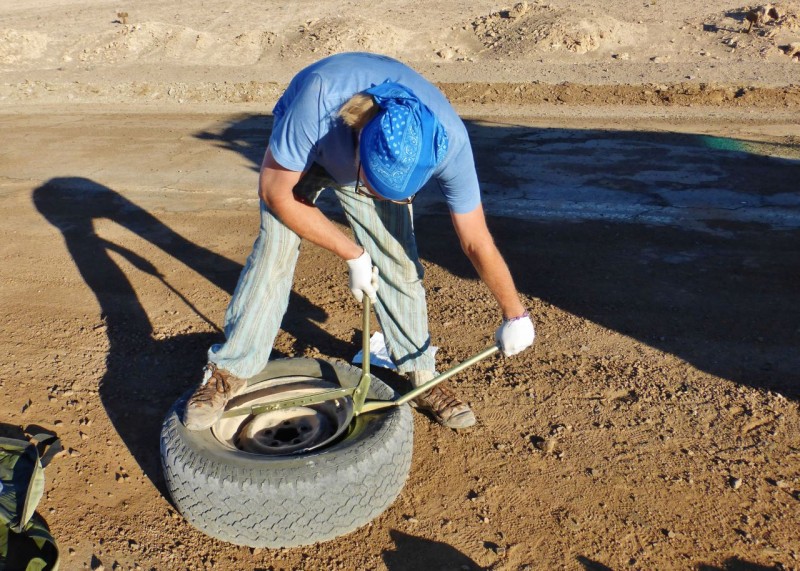
I opted to wait until morning to take the obstinate tire off the rim and patch it from the inside. All went well and our Australian Tyre Plyers tool had the tire dismounted in no time…
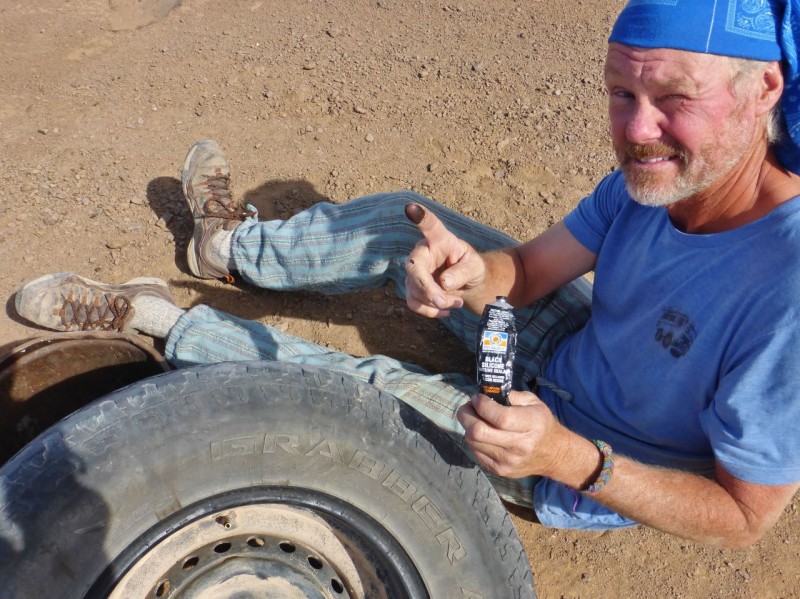
After some head scratching (fleas?) and “what would McGyver do?” thinking, I decided that maybe silicone would hold a tire patch at speed and in this heat…? It won’t vulcanize the rubber like cement, but it is pretty tough…??
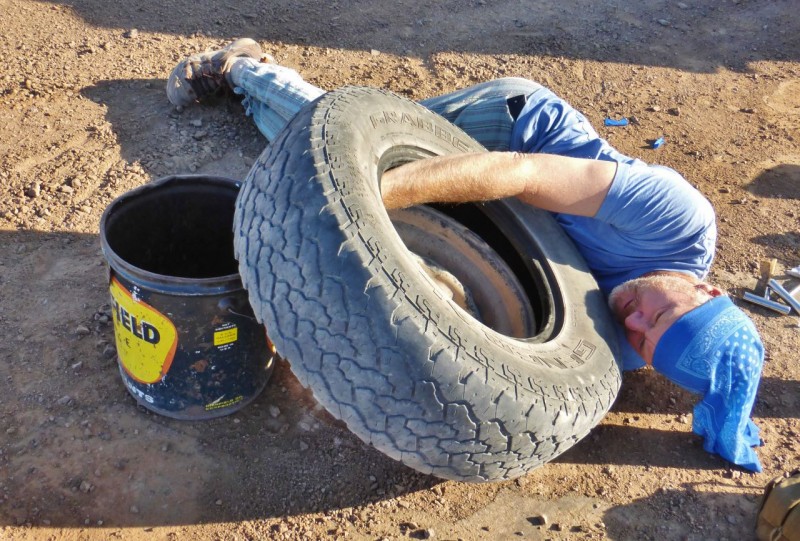
Pleeease Work! It’s a long way to somewhere hitchhiking with you oh rubber buddy, Old Pal. Reading the silicone tube three times I confirmed that for the stuff to reach maximum strength you must wait a full 24 hours. Kat and I have not sat in one place for 24 hours since we meet each other 10 years ago. Not on this trip, not with ghosts, never.
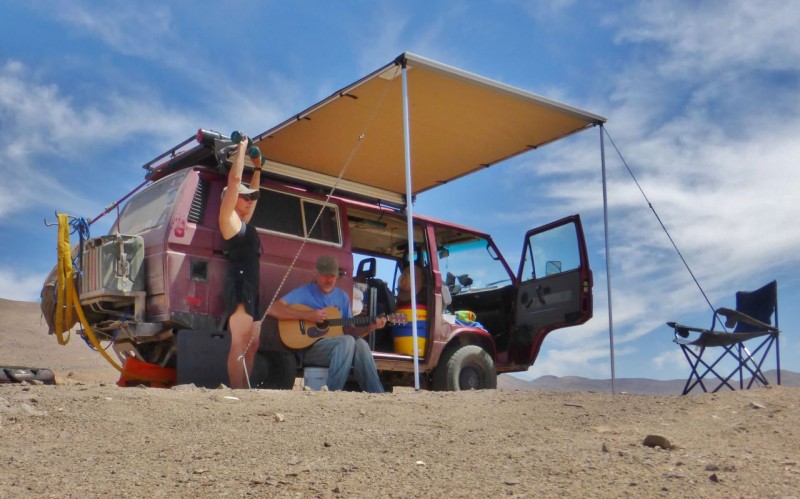
We waited a full 24 hours! All day and another night with the ghosts. In that time ONE car drove by – and he didn’t stop.
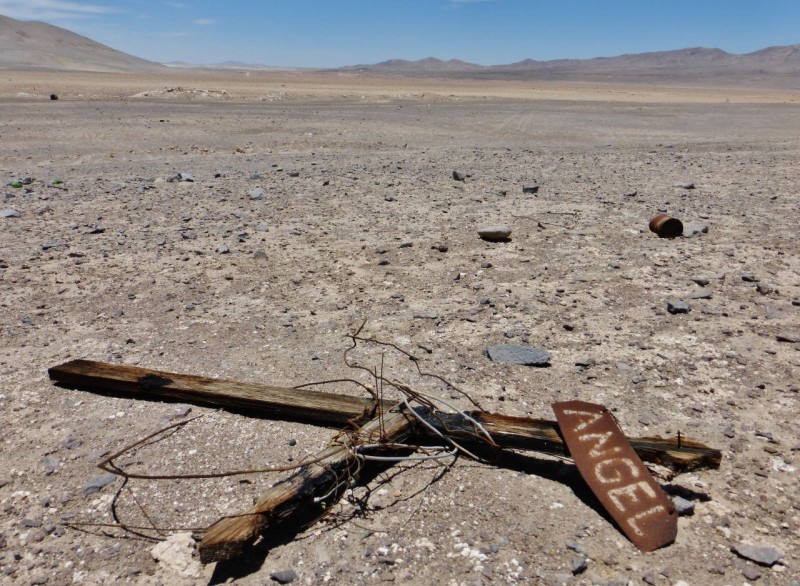
Kat took pity on fallen Angel, his/her cross was burned through and tossed carelessly out in the lonely desert, away from the others.
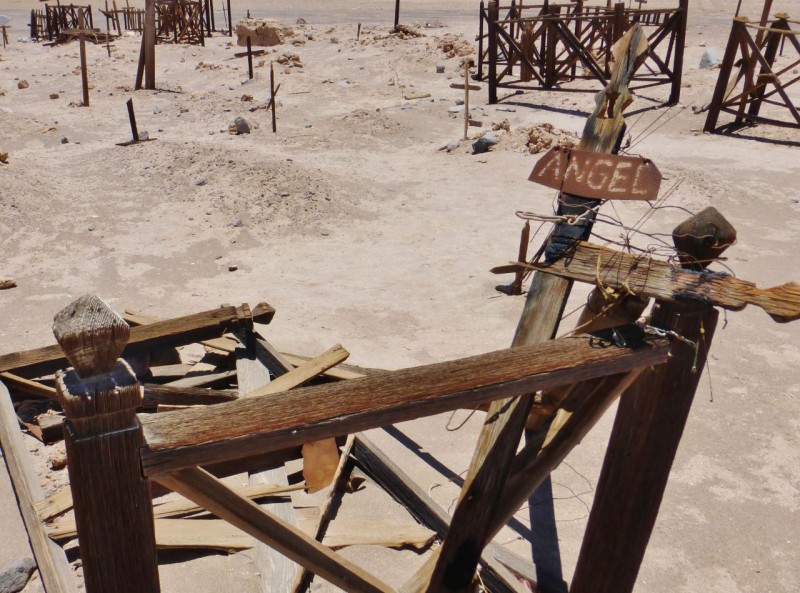
Repositioned on an unmarked grave we figured we’d earned some ghost brownie points – unless it was the other residents that cast Angel out into the desert…?
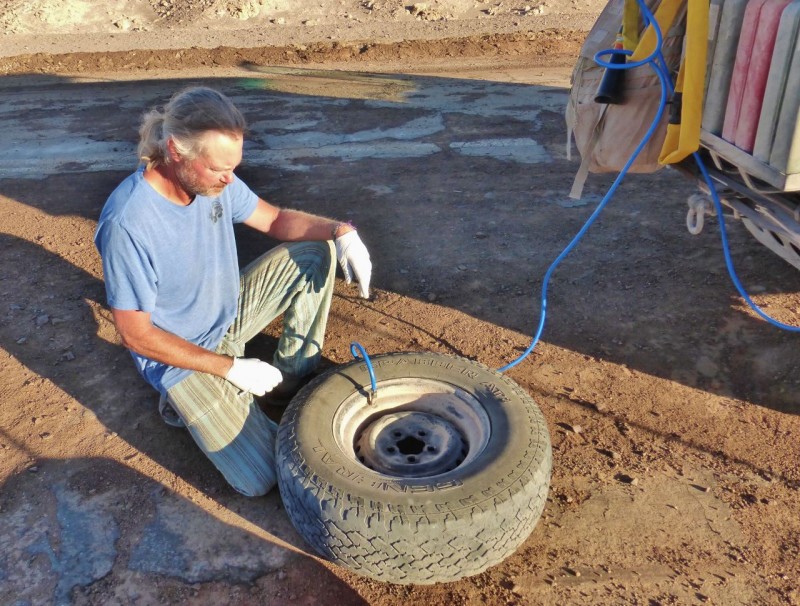
The second morning I aired ‘er up and voila, silicone holds rubber patches! In fact it is still holding as of this writing about 900 miles and 10 days later!

After the graveyard we rolled 250 highway miles down to Copiapó where we restocked the fridge and headed out to the beach. There we met our good friends, the Varas family, and a bunch of their friends, all spending their summer vacation at Basecamp, a cool, private campground with showers, a kitchen, clean campsites, a beach and security for all one’s toys. Since we are all gear-heads, our main goal was to watch the famous Dakar Rally Race pass through the huge sand dunes nearby. After Dakar we shot straight south, retracing the route we took last September towards Santiago, the furthest point we’ve driven south so far. As I write this we are again on the coast in Viña Del Mar, a resort town northwest of Santiago. It’s a good place to scrub the sand out of every orifice, do our laundry and have good WiFi for this blog, but we are anxious to keep going south, south, south and make it to the tip of the continent by the end of January.
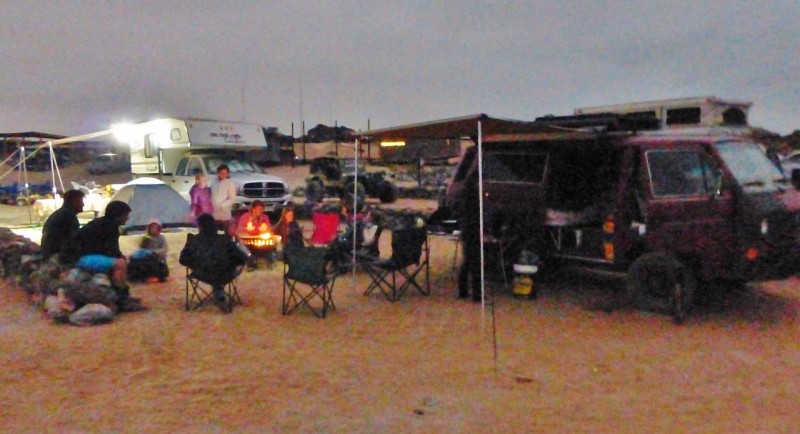
This is a terrible picture but it gives an idea of what camping at Basecamp looks like. Good friends, good times, happy kids, campfires, good stuff.

The Varas family has quickly become very special to us since we first arrived in Chile. Sebastian, his beautiful wife Luz and their two awesome kids, Amelia and Seba have gone way above and beyond to make us feel at home in their country. It was a joy to see this happy, close family at play on their summer vacation. It was Sebastian who arranged storage for Charlotte when we had to go home in October/November. He has hooked me up with shops in Santiago where I could work on Charlotte, introduced us to his friend, Boris, who races a Mini in Dakar and who loaned us our indispensible Polaris UTV to chase the race. He even visited us back in Nevada when we were home in October and he was in the States for business. He designed and built his Willy’s Jeep from scratch and it is one of the finest I have seen anywhere in the world. This machine ROCKS, especially in the sand where its owner is a master at driving in the stuff.
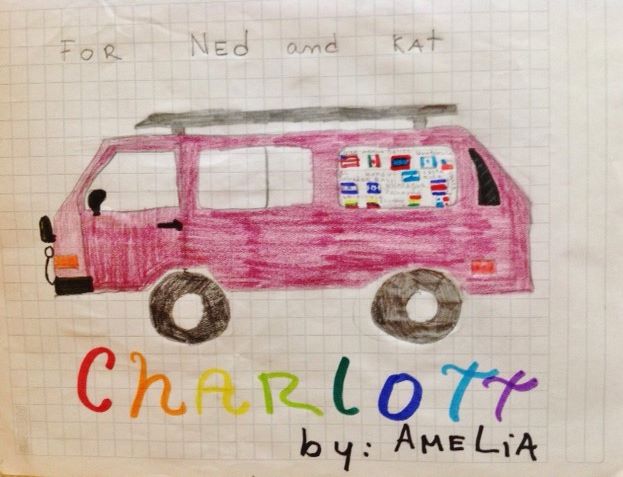
Amelia drew us this sweet portrait of Charlotte while we were watching the Dakar. It is so special to us! We plan to frame and hang it permanently in our rolling home.
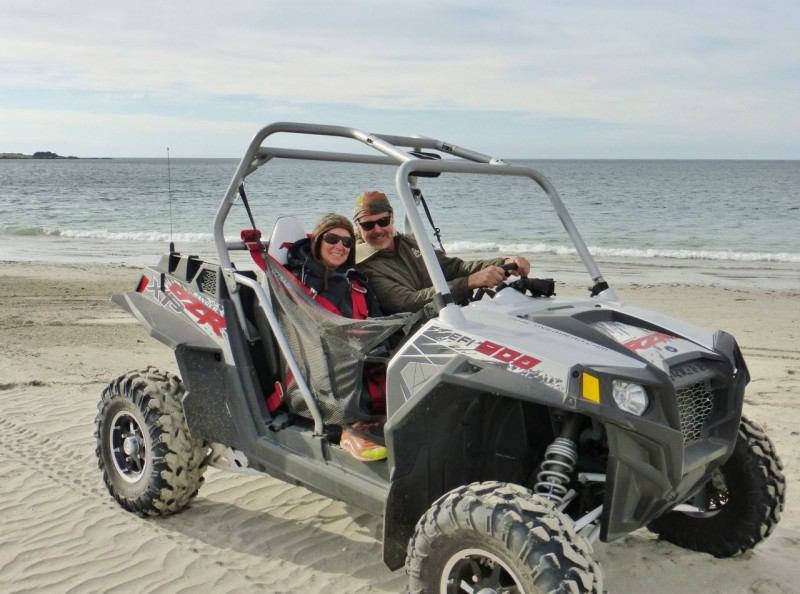
Our “golf cart.” When Sebastian’s friend Boris Garafulic offered us the use of his Razor for watching the Dakar Rally I had no idea how perfect it would be and how much it would add to the whole experience. This generous offer by a man we barely know, so completely contributed to this experience of a lifetime, that I am at a loss for words on how to thank him. I don’t even know how to reach him since, as I write this, he is still out there competing in the two week long Dakar.
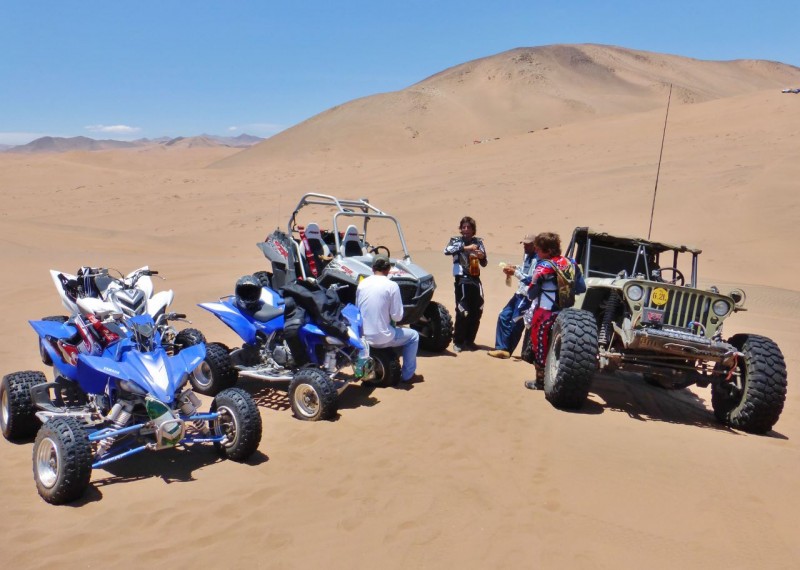
The big day arrives. Here we have just unloaded all of the toys for an epic day in the Atacama dunes; both watching the Dakar race up close, and having an indescribable blast romping through these mammoth mounds going from one race point to another. The experience and memories of this day will be etched in our minds forever!
I won’t go into detail about what the Dakar is and bore all of you non-motor -heads. Those of you who are, already know, but if you’re curious, Google: Dakar. I could spend pages explaining. Suffice it to say, it is by far the largest and most grueling motorsports event in the world. This year it pitted 665 competitors and 414 machines against nature for a full two weeks, covered three countries and 9,000 kilometers. It was watched by 3.9 million spectators worldwide in 2014 but strangely, it is not well known in the USA.
Being in South America during a running of the Dakar, there was no way I was going to miss it, even if we had to drive half way across the continent. As it turned out, Sebastian and friends never miss it either and know the dunes around Copiapó like the backs of their hands. These incredible sand dunes are also one of the toughest parts of the race. Having the best local guides and being loaned a perfect machine for the sand (our Razor) we were about to experience a chance of a lifetime.
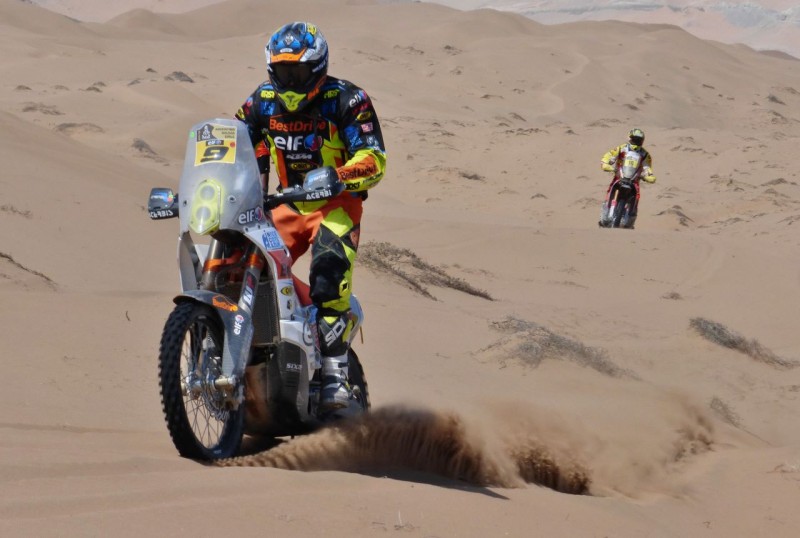
Motorcycles made up 168 entrants this year. The leaders showed up first, about an hour before the first cars. At this point these athletes had already raced 500kms that day and had been at it for four days straight!
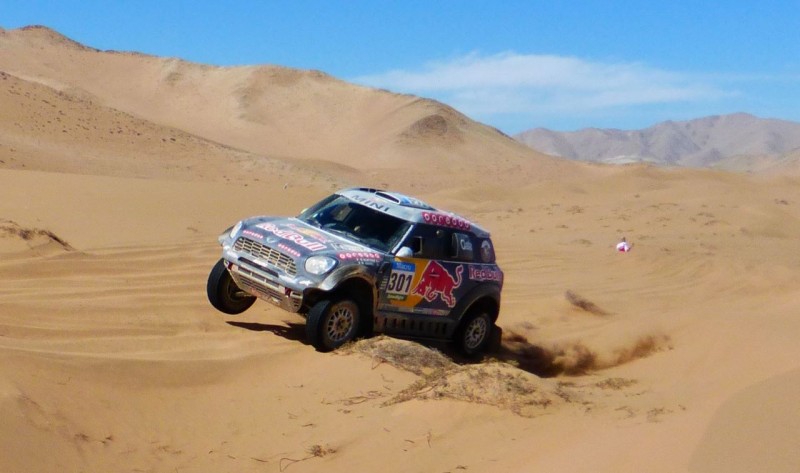
The factory team to beat this year, and for the last several, is Mini (aka BMW.) I thought these micro-cars looked silly as race cars tearing through huge sand dunes, but with enough factory money and backing, anything with wheels can be a contender.

This is Boris Garafulic racing a Mini under the colors of Chile. He was running about 17th overall on this day. He is the owner of our Razor so graciously loaned to us. He gave us a wave as he flew by. It was great to know he saw us, undoubtedly by spotting Sebastian’s unique Jeep.
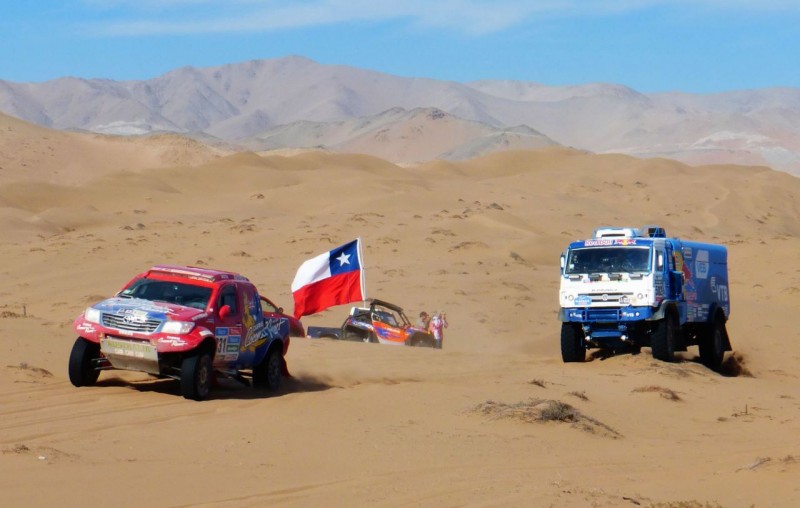
Then came the trucks! These things are the show of Dakar. Huge diesel rigs with over 1,000 horsepower and four wheel drive, they run faster than many of the cars and were flying through the huge sand dunes like our little Razor, except that they weigh 14,000 pounds. Here a Russian Kamaz is running down a lowly Toyota pickup. The Razor with the Chilean flag in the background is a spectator.

This roller coaster-like area was particularly fun to watch as the competitors wound their way through huge bowls of sand. Here the scale of the dunes can sort of be realized as the huge trucks look like little toys. I have driven the sand dunes of Glamis, Dumont, Pismo, the Oregon coast and even a bit of the Sahara in Africa, all famous dune areas. All of them combined would make up a tiny toy sandbox in a corner of this immense dune system in the Atacama Desert of northern Chile. The sheer size (some are over 3,000ft tall!) and vastness of these dunes is incomprehensible.

“Robby! Robby! Robby!” Robby Gordon obviously has a bigger fan base down here than he does at home. You could hear the chant rise through the crowd as his bright orange Gordini approached. Putting on a show as always, the car was off the ground more than on and was obviously carrying more speed than most, but he was still running way back in the pack due to a breakdown on day two. Robby Gordon has been trying to win Dakar for ten years and is the only American to persistently try to conquer this European dominated event. His one-man, one-car, underdog approach is commendable when stacked up against the huge, multi-car, mega-money factory teams. Unfortunately, it looks like 2015 won’t be Robby’s year either.

As night fell the dunes became surreal as shadows played havoc with depth perception. Still, late running racers thundered on, their multiple HID lights making crazy patterns across the mounds of endless sand.

For some the shadows took their toll. These poor guys were just two kilometers from the night’s bivouac which was just over this one last dune. Instead, they rolled and may have spent the whole night there. Sebastian tried to winch the 14,000 pound monster over but all he did was drag his own Jeep and the Toyota attached to it several feet forward.
The bivouac itself was yet another unbelievable sight, a huge tent city which is erected every night and covers maybe 20 acres. It travels with the race, complete with kitchens serving meals and showers and bathrooms to accommodate all the teams. Huge team-owned semis, set up as support shops for the race cars, are lined up in rows with mechanics working all night rebuilding the race machines so they can tackle another grueling stage the next day.
Beguiled, Bogged and Blotto in the Bolivian Boonies

When Kat ended the last blog we had just enjoyed three days at a fun, horsey guest ranch 30 miles south of the city of Salta, Argentina (just off the map to the south). Our adventure continued with three days in Salta getting the last blog out, doing laundry, restocking Charlotte’s shelves and exploring the heart of this, while large, very humanly vibrant city. Notwithstanding it’s a city, we enjoyed our time there immensely (surprise), but were ready to push on into the wilds of southern Bolivia.
We’d read much about the poverty, corruption and desolation that this land-locked country offers, so we planned accordingly with full food, gas and water stores. As usual, it turned out that reports were exaggerated, and we found Bolivia, like everywhere else we’ve visited, to be friendly, fascinating and full of wondrous sites. We really only scratched the surface of this rather large country, only covering its southwestern corner, an area containing vast salt flats and endless open desert devoid of human civilization like towns and paved roads. In other words, our kind of place! Instead of heading straight into the desert though, we did drive 200 miles out of our way to visit the country’s capital, Sucre. We wanted to get a taste of the urban side of Bolivia and we couldn’t have picked a better city. Even every Bolivian tourist we talked to assured us Sucre is their country’s jewel. Sucre also marked a turning point where we pointed Charlotte southward, once again heading towards our overall goal of reaching the tip of this amazing continent. Soon enough we were driving on endless salt flats and enjoying ourselves in total isolation – with a bit too much alcohol as the photos will tell! From the Saltar de Uyuni we bounced 268 miles over the worst washboard roads I’ve ever had the displeasure of experiencing. But the beauty and desolation of southwestern Bolivia more than made up for the price we paid in rough roads. This area quickly became yet another highlight of our trip.
We hope you enjoy this blog, resplendent with dust, salt, booze, vast vistas, critters, locals, washboards and did I mention dust? Oh, and Happy New Year to you all!!!

Since it’s the holiday season we’ll start off with the best Cabernet Sauvignon we found in Argentina. The Pietro Marini winery is located in Cafayate, a town we stayed in a week earlier. We should have taken a tour. We enjoyed this bottle at the Jovi restaurant in downtown Salta, a landmark which has been serving amazing regional wines and delicious steaks for over 50 years.

Our waiter Roberto has been working at Jovi for 42 years. He recommended the Cab and served us with an old world hospitality not found much these days.

Our favorite breakfast spot quickly became Alicia’s which we visited twice. Isabel was the head honcho in the kitchen and insisted she put on a clean red chief’s jacket before I took her fuzzy picture. Here she displays freshly made empanadas, minced meat and vegetables wrapped in a pastry crust – delicious!
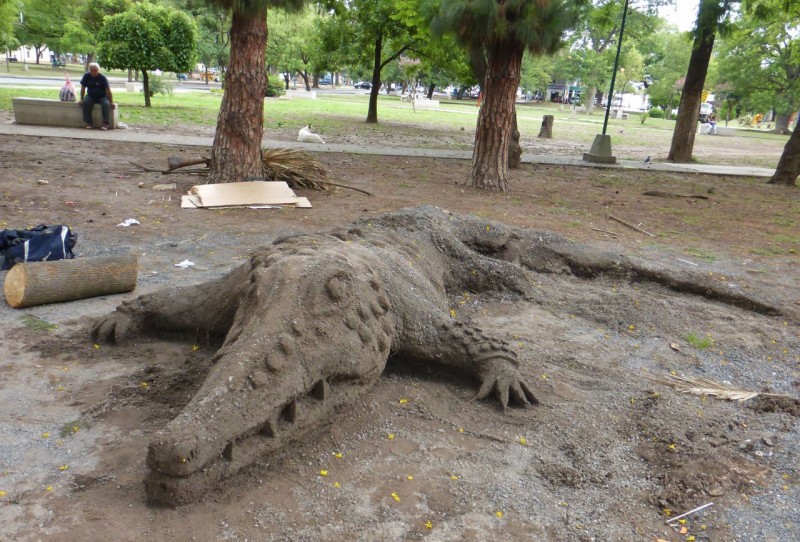
Lyle the Crocodile? We spotted this clever sand creation along the sidewalk while strolling around Salta on a Sunday afternoon.
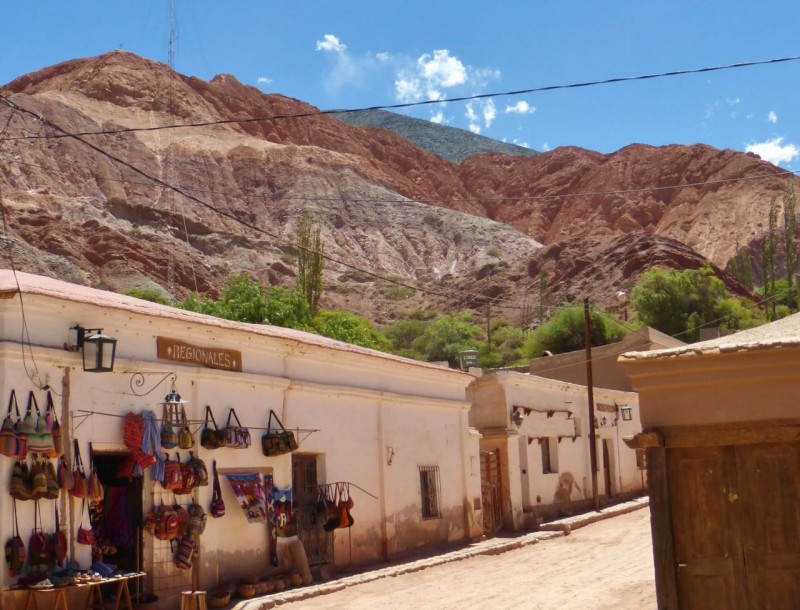
On the road and heading north to Bolivia we stopped for a peek at the town of Purmamarca, known for its seven color hills which tower over the dusty tourist shops.

Close to the Bolivian border, following Ruta 9, these “potatoes au gratin” like hills came into view.
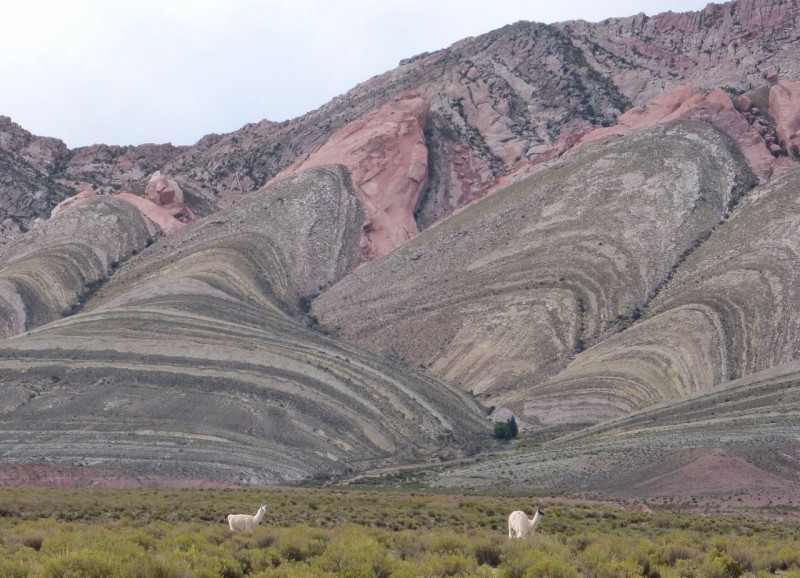
Finding a dirt road heading towards the hills, we were able to get closer to these amazing geological wonders.
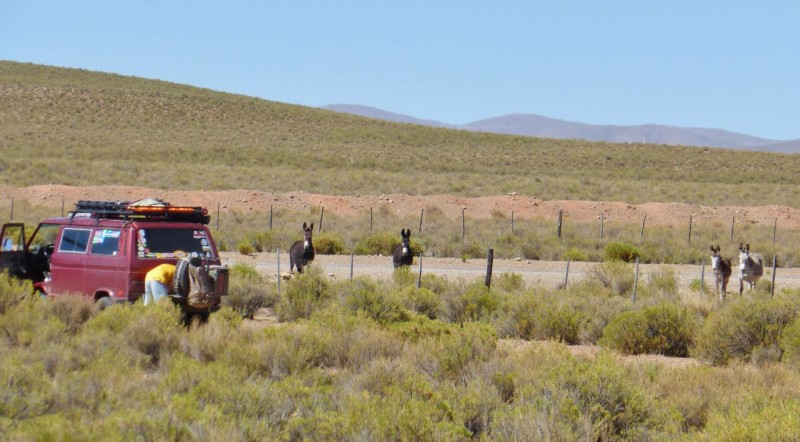
Before hitting the Ruta 9 again the next morning, I stopped to check our ever present coolant leak and was again watched over by curious locals.

For miles along Ruta 9 we ran parallel to an abandoned railroad track and an old telegraph line. All the poles, made from steel rail tracks placed vertically, sported perfect glass isolators; the kind I know people back home love to collect but can’t find in the American West anymore.
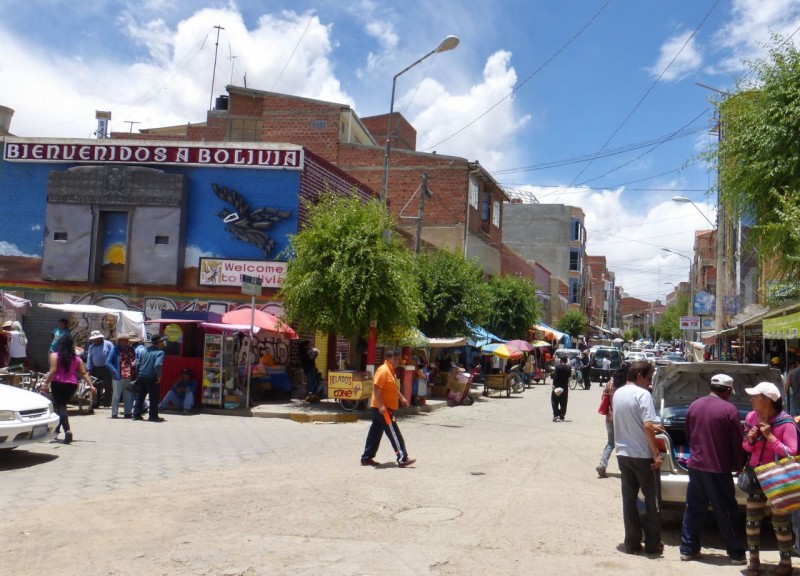
Bienvenidos a Bolivia. This was the main drag of the border town of Villazon just after going through the usual third world border hassles. After our efficient, no-nonsense crossing from Chile to Argentina, we just had to laugh at the silly antics of backward country bureaucrats.
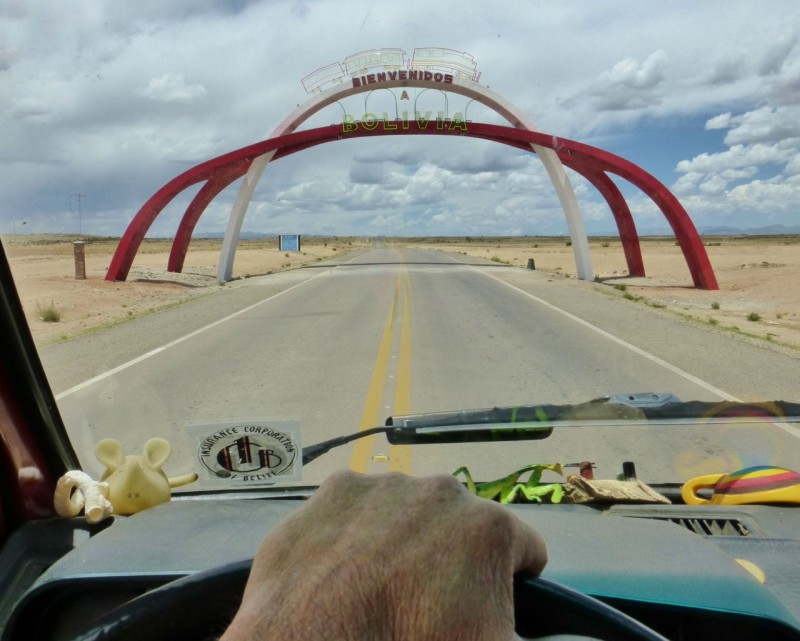
Leaving the bustle of Villazon we crossed under this elaborate welcome bridge leading into the desert. It was the first sign that Bolivia might not be exactly what we expected.

At first chance I added the Bolivia sticker to our collection of now 15 countries we have passed through – and reflected that this is our last sticker for this continent.
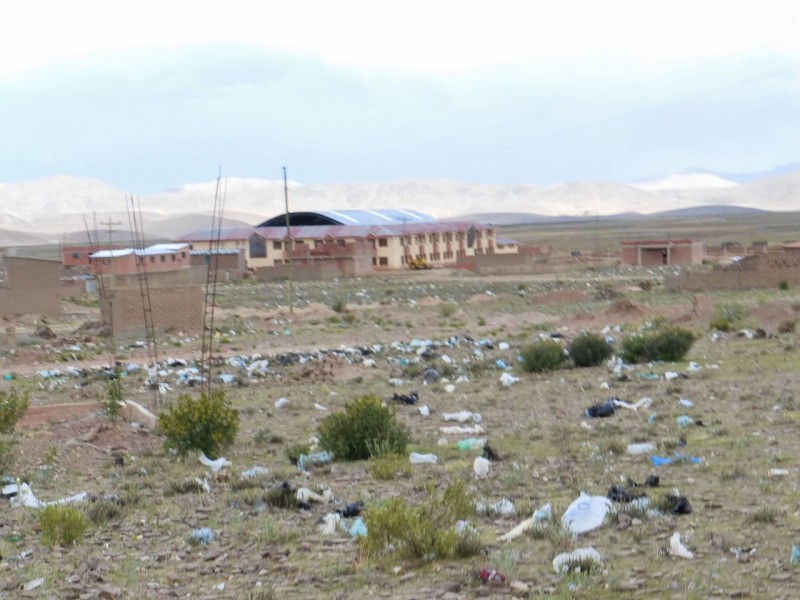
After a couple of hours of driving and seeing no towns we took a side road around the grimy mining town of Potosí, which took us to the even grimier village of Belén. Approaching the town revealed the persistent problem of plastic trash in countries with no garbage collection programs.

While most gave our clattering bus a cautious stare, we got a smile out of a few. Note the braided pigtails and long skirts with sweaters.

These gals had it a little more together with a clean street to sell their fresh fruit on and ice cream to go around!

Further on down the road we camped our first night in Bolivia with this incredible view to wake up to.

We had a couple of steaks and some veggies in the fridge that were going a bit “off” to our tender gringo tummies, so Kat wanted to give them to a local. Her first approach, speaking in Spanish and not carrying the food, was to a woman standing in her front yard. Upon Kat’s approach the woman turned in terror and ran into her home! We realized these local natives probably don’t speak any Spanish and without showing the food, didn’t have a clue why we were stopping our big red box with the dead cow head and approaching them. Kat’s modified second try to this gal and her child, who were walking down the highway, was more successful. As I pulled off the road, Kat hopped out with steaks and veggies in hand. The woman grabbed the child and quickly headed to the opposite side of the road. Kat pursued, food outstretched. Finally the woman stopped and acknowledged the gift with a shy, fleeting smile, then quickly ushered her child onward and swiftly continued down the road as I tried to sneak this photo. Kat noted that she appeared quite young, maybe early 20s, but was already missing several teeth.

We arrived in the capital of Sucre with the intention of just checking the city out, restocking supplies and headed for the desert. But a quick walk around the main square told us this was a place to hang for a while. Sucre was unlike the Bolivia we had seen so far.
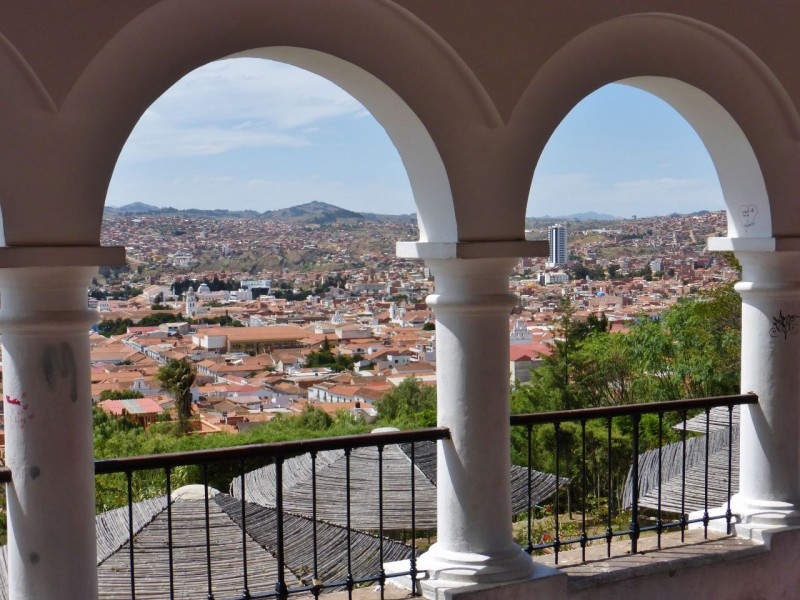
A view of the charming city of Sucre as seen from the mirador, the lookout point atop La Recoleta hill and the spot where the capital city was founded in 1538.

The beautiful main square convinced us we needed to stay. Kat poses with a statue of Bolivia’s namesake, Simon Bolivar. Note the gorgeous landscaping throughout the square.
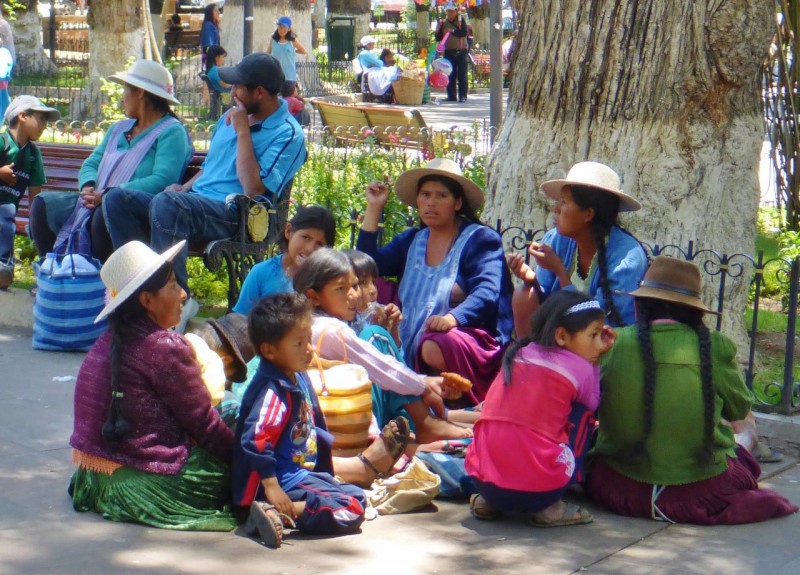
Being Sunday and close to Christmas, lots of local families were out enjoying the unusually beautiful weather in the main square. Situated at 9,000 ft, the city is not known for its heat, even in the middle of summer.

Duh! Which way do I go? The crosswalks split in the middle of the street with separate walk/don’t walk signs for each direction. Walking around had me more confused than driving!

We gave this little street beggar toast with jam and butter in exchange for a big smile. Wonder where she spent her Christmas?

The main open air market was a cornucopia of beautiful fruits, veggies and beautiful, friendly Bolivians eager to serve us…
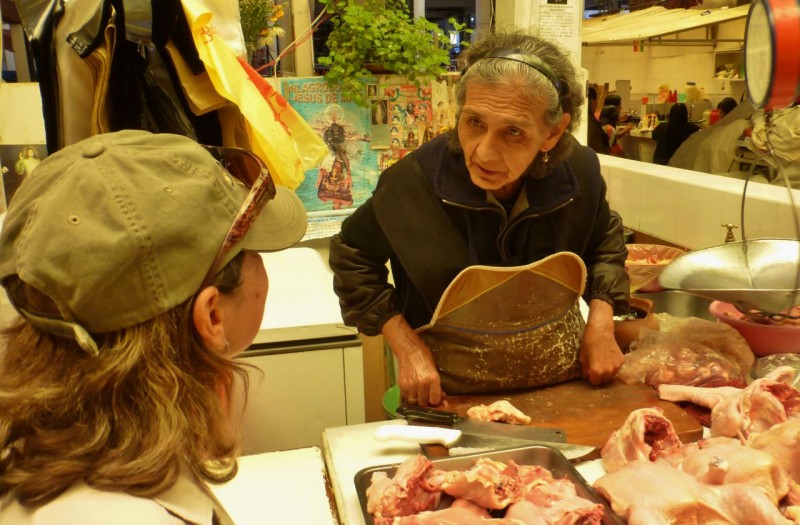
Victoria sold us some fresh chicken and happily de-boned and diced it for us while we told her about our trip. She wished us safe travels and to go with God and all will be well.

We checked in to the Capital Plaza Hotel, a beautiful old colonial right on the main square – for $55 bucks a night.
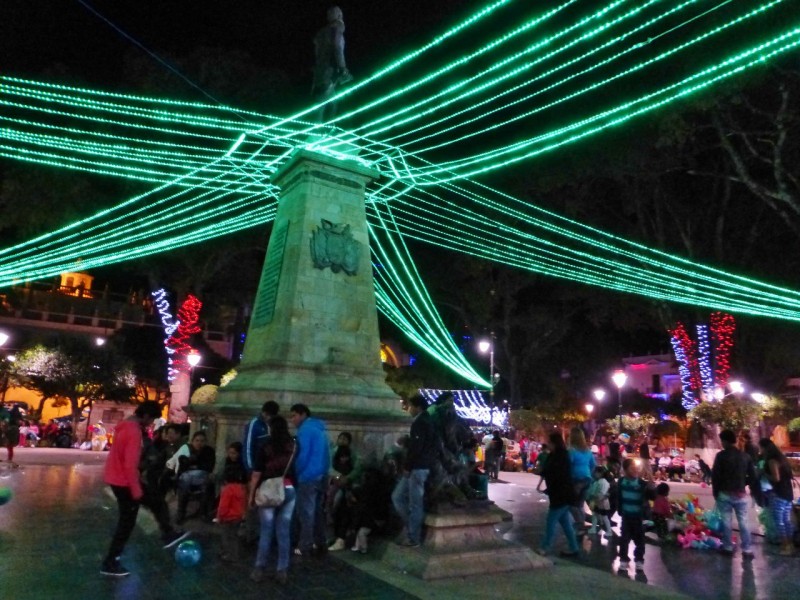
At night the main square came alive with the Christmas season. Throughout the month of December, either in Argentina or Bolivia, we have not seen much fanfare about Christmas. Only now, a few days before the 25th have the decorations come out. Nowhere in stores do you get the barrage of sell, sell, selling of material stuff, such a welcome relief. It seems here in Latin America the true meaning of Christmas, celebrating Christ’s birthday, is alive and well. The Holiday has not become a commercial excuse to buy a bunch of crap.

Waking up the morning of Dec 23rd and looking out our kitchen window almost looked like we had a big front lawn. Where is the white picket fence?

Lately we’ve been pretty good about our morning stretches and exercises, thanks to mild temps, no bugs and great hidden camp spots. Our Mac’s Tie Downs Utility Mat helps too.
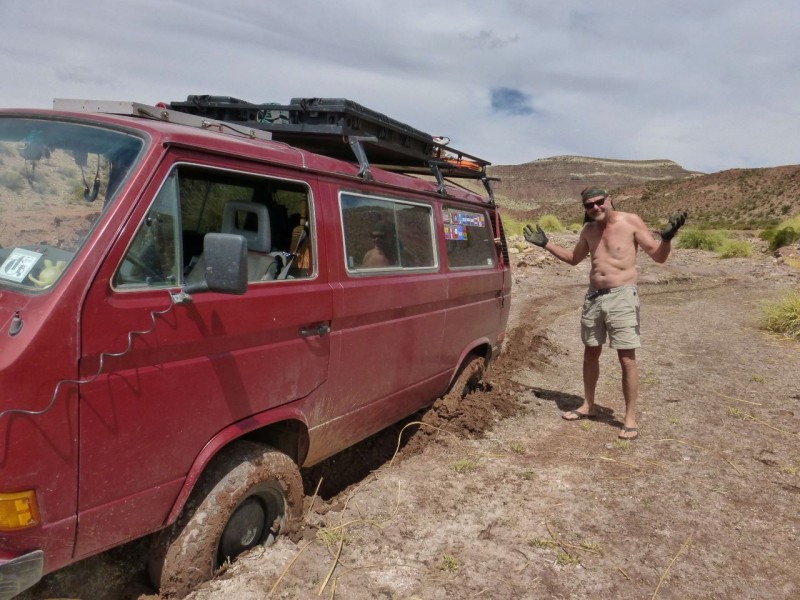
After carrying around a winch and a ground anchor for just over a year, 21,000 miles and lots of nasty dirt roads, we finally needed them! Leaving our river bottom camp site I wasn’t paying attention (fiddling with the stereo) and missed applying the VW Syncro four-wheeling creed of “use momentum.”

Kat demonstrates the proper technique for setting a Pull Pal winch anchor in soft ground while I control the winch, a technique she has come to master over years of four-wheeling together.

Yes! Its working! The Pull Pal took hold and our trusty Warn winch, riding dormant for a year, drags poor Charlotte through the muck.

The Pull Pal is a life saver when there are no trees, rocks or another vehicle around to anchor your winch to.

Dropping down into the town of Uyuni, Bolivia on the edge of the Salar de Uyuni, the endless salt flats seen in the distance.

We picked up this grateful miner hitchhiking about ten miles out of town. We hadn’t seen another car heading our way all morning. We never did get his name but gathered in local dialect Spanish that he had family in Uyuni and was excited to see them for Christmas.

We took a quick look around town but decided to head straight for the salt flats for some isolated camping before Christmas Eve. On the edge of the salt lies the Hotel de Sal, a hotel made completely out of salt! The walls, furniture, beds, wall hangings, staircases – everything is made out of the stuff! We had to check it out, and although cool, Charlotte looked a lot more appealing.
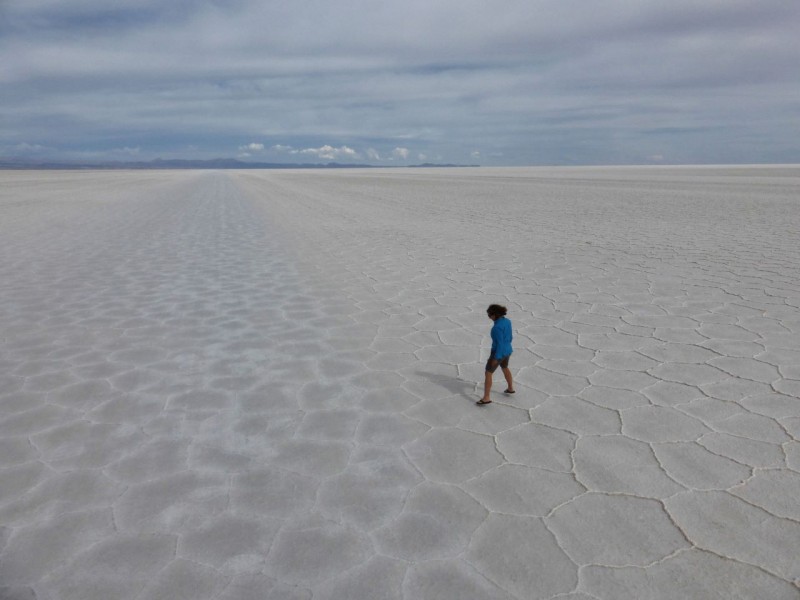
On the salt at last! We’d been looking forward to this part of the world for a long time. Kat immediately jumped out and played hop-scotch in the bizarre polygon patterns formed in the salt bed.

Then we took the obligatory silly photos that everyone takes on the endless horizon. We’ve seen some very clever examples on the internet (Google Salar de Uyuni – more images if you need more than our two). There are also some really beautiful ones, taken when the sky and light are just right and there is water on the salt. These are some of the images I saw years ago that inspired me to want to come to this part of the world. Check them out.
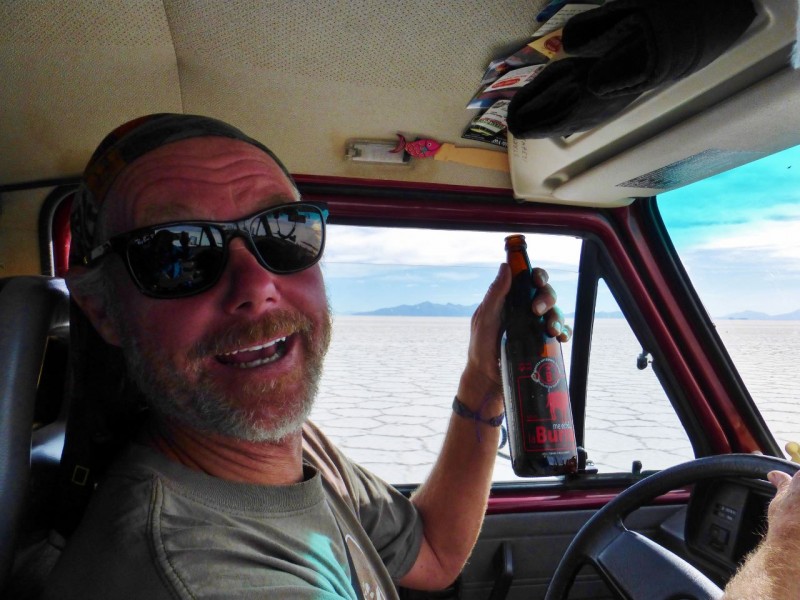
Then we got into the beer… La Burra, which we picked up in Argentina, has an 8% alcohol content and, combined with the excitement of reaching the salt flats and no lunch,… well the next few pics will explain.
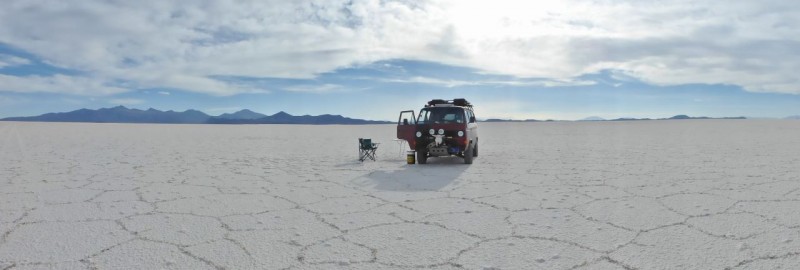
Don’t drink and drive, ha! You might hit something out here! After a few large 360s and weaving through some imaginary salt cones (I think they were imaginary), we wisely made camp in the middle of nowhere.
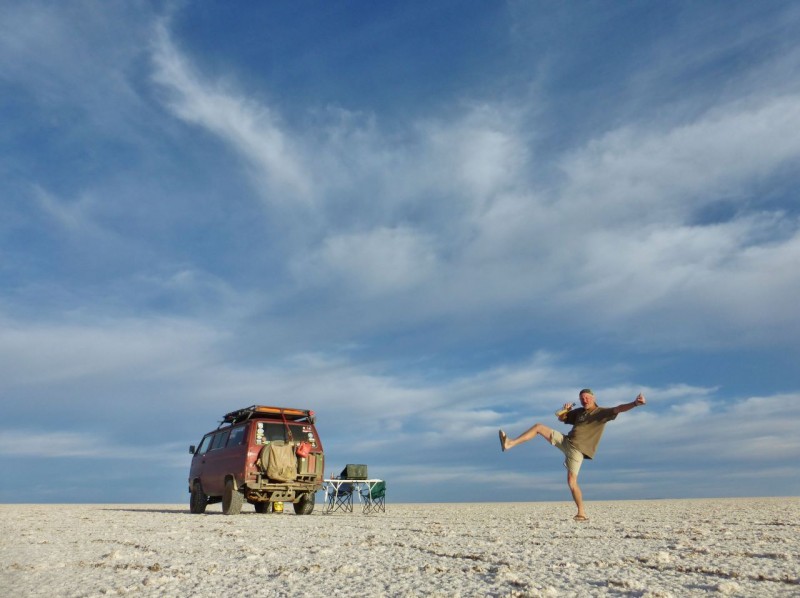
They say Tequila makes your clothes fall off, but in our case, it seems to make our arms and legs fly around.
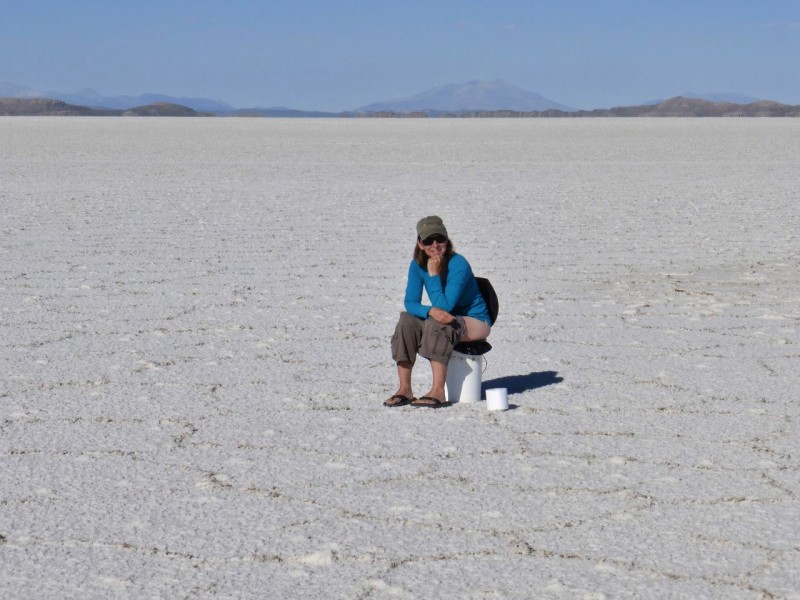
The next morning… this is almost TMI but we finally used our Sit, Shower, Shave unit from Synergy for its intended purpose instead of just our trash can. It’s good to be green when you can’t dig a hole.

Charlotte just wanted the salt off of her after 120 miles of driving on the stuff.
We ended up doing a big loop, mostly following the tracks of dozens of tourist filled, guide driven Toyota Land Cruisers. I swear EVERY old FJ80 in the world has wound up in Uyuni, Bolivia doing duty as a 4X4 tour bus. Although these photos look like we are the only ones around for miles, the truth is by day, these tourist haulers were never very far out of site during our entire time in southwest Bolivia. Another myth busted as we thought we’d really be “out there.” At least they disappeared at night, leaving us alone to camp in quiet seclusion.

Back in Uyuni Charlotte got a Christmas present in the form of a partial bath from this happy guy. He actually gave Kat a big Christmas hug after his work was done.

Of course we had to restock our beer supply. This is one of the cool little walk up stores where you stand at the gated entrance and the proprietor/owner gets you what you want.
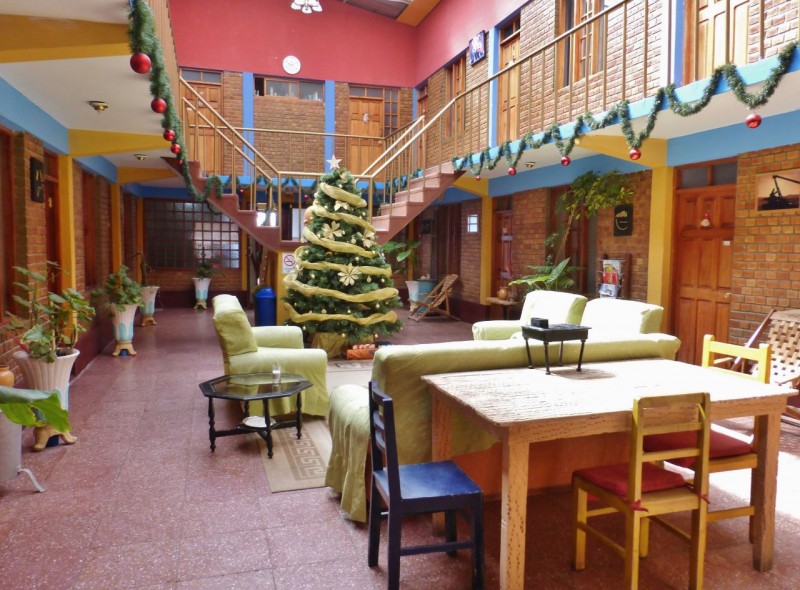
We checked in to the Toñito Hotel for a much needed shower on Christmas Eve. We had big plans to attend midnight mass in the old town church just to watch the locals, but alas we failed; a combination of lasting hangovers and months of a propensity towards early bedtime hours.

This is Chris, an American from Boston who owns the Minuteman Pizza restaurant inside the Toñito Hotel. He is married to a local gal, Suzi, whose family owns the hotel. Minuteman is by far the best eating in Uyuni.
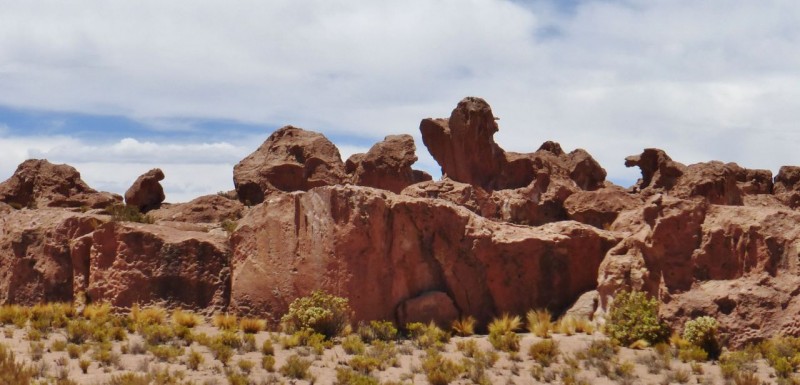
Stocked up with all the water, gas and food we could carry we set off Christmas Day for the “wilds” of southern Bolivia. Everything we read made it sound like we were really heading into nowhere – and we really were, as the photos show. However, I think we’ve spent more time further from people in the Nevada deserts than in Bolivia. Land Cruisers full of tourists with hired driver/guides were everywhere. We never saw another private vehicle though. Where ARE all those Overlanders in their fancy 4X4s?

We passed by these awesome rocks a couple hours out of Uyuni and had to stop and play on them like little kids.
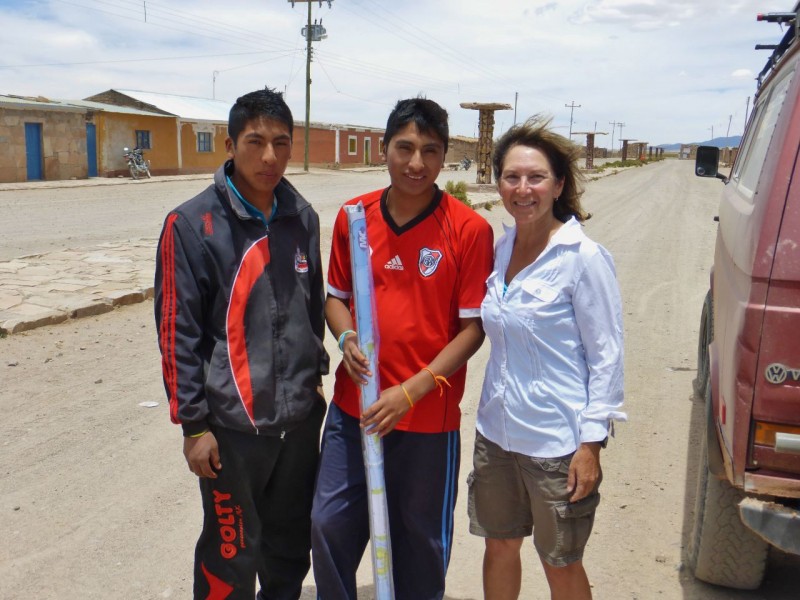
In Villa Alota we passed by yet another school, closed because its summer vacation down here. Remember back in Columbia our awesome experience “teaching” school for a morning in a remote school house? We vowed to do more and bought world maps in Ecuador to give out to schools. Kat’s illness in Peru and our extended stay at home pushed our time frame into summer vacation for schools down here. Since returning, every potential school we’ve seen has been sans kids. Bummer. We decided to ask in this tiny burg of Villa Alota for the school master in hopes of giving a map to him/her for the coming year. Instead we got a promise from these two boys that the map would get into the right hands. Well, maybe… at least one young guy in Bolivia might now have a world map on his wall at home.

But there was no shortage of tracks to follow. At first we thought the famed Dakar race course had run through here leaving all the deep ruts. However no amount of race traffic we’ve ever seen in Baja or Nevada has left this much destruction. It soon became apparent that all these tracks were from the tourist laden Land Cruisers whose drivers take their clients anywhere they want.
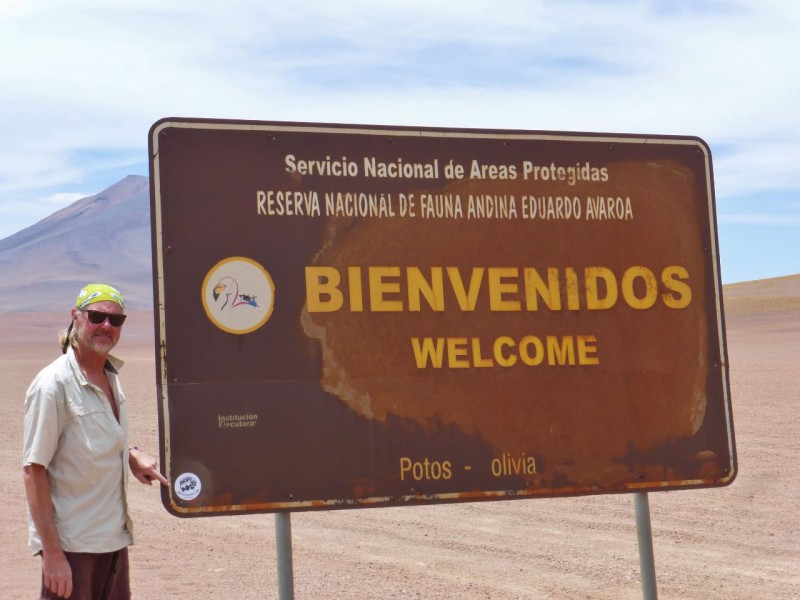
The Reserva Nacional de Fauna Andina Eduardo Avaroa will never be the same after we stickered it up with official Charlottamiles stickers. We’ve been leaving these stickers all over South America, so if one of you ever comes across one take a photo and please let us know.

Way too many fuzzy flamingo shots. After shooting a million shots these past weeks we realized the anti-shake feature on our little camera got turned off. Shit, we’re such professional photographers!
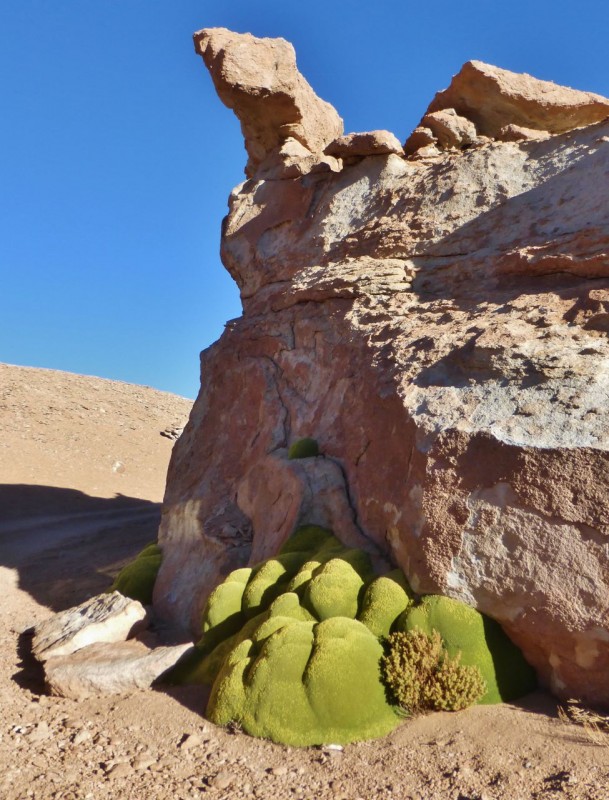
The only green things around for hundreds of miles were these crazy, moss-like growths which are called Llareta. They are a high altitude relative of parsley! The plant can live up to three thousand years, and its oozing resin is super flammable. We only saw it in one area where we happened to camp for a night.

This poor little fox seemed to pose for food. He was in an area near Laguna Blanca which was particularly heavy with Land Cruiser traffic.
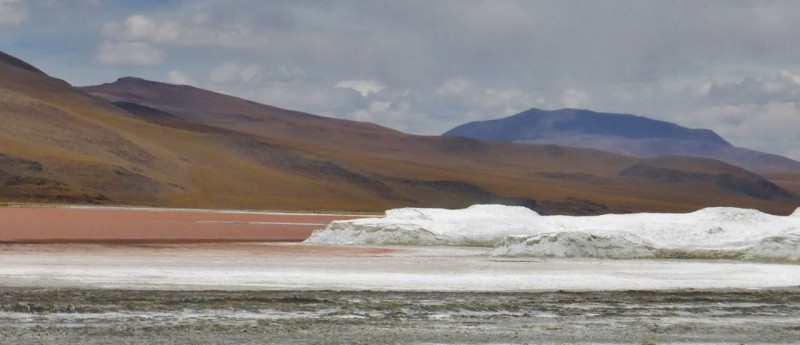
Laguna Colorada is named for its red color which changes hues throughout the day. We had pretty cloudy skies so while the colors were lacking, the “icebergs” made up of borax, salt and ice (!) were fascinating. Although it was mid-summer and mid 70s temps during the day, it still dropped below freezing every night.
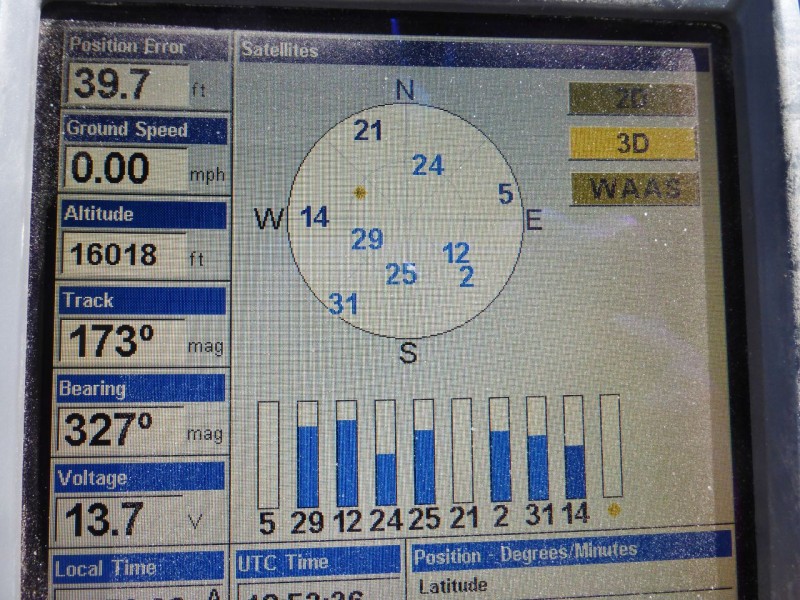
Being in the Andes mountains, all of southern Bolivia is above 12,000 ft which helps the ice stick around too. We took this shot of our GPS when it hit 16,000 ft, but the highest we saw was 16,200. I think that’s the highest Charlotte has driven yet.
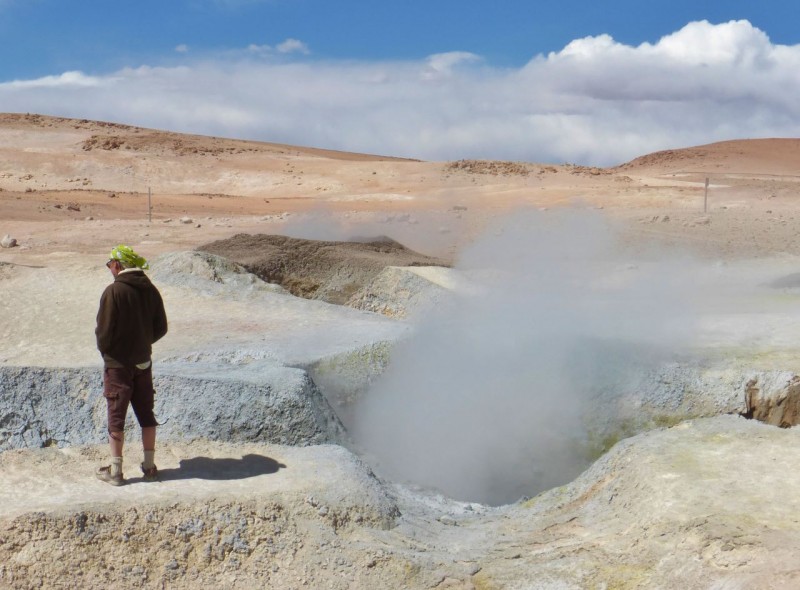
The steam rushing out of this hole in the ground must have been 200 degrees and going 100 mph. Standing next to it really gave you a sense of the power of mother-nature.

Charlotte ran like a top despite being pounded by endless washboards and slathered in endless silt. I don’t think we’ll ever get all the dust out of her nooks and crannies. Oh well, patina.
This is the high tech Bolivian exit border with Chile. The entrance border into Chile is 27 miles down a paved “international” road in San Pedro de Atacama. And by down we mean down! We’re at 14,000 ft here but when we hit San Pedro the GPS read 8,000 ft!
Stay tuned next time as we make our way a second time down through northern Chile. We plan to stop at Basecamp and Copiapó to meet up with our Santiago friends, Sebastian, Peter and José and their families who are spending their summer vacation camping at the beach. A highlight will be watching the famous Dakar Rally Raid pass through the dunes outside Copiapó. Sebastian and Pete will have their high horsepower jeeps and have arranged for a Razor XP1000 UTV for Kat and me so we can all journey deep into the dunes and chase the race. WooHoo! Can’t wait…
Back in the Saddle in Northern Argentina – Red Rocks, Red Wine and 20,000 miles!
Greetings from South America again, finally!
Ned and I have only been reunited with Charlotte and back on the road for two weeks, but so much has happened (including hitting 20,000 miles since embarking a year ago) that it feels like a month. Our adventures continue to inspire and humble us as we make more wonderful friends and stumble upon some of the earth’s most astonishing scenery.
We have taken almost 700 photos during these two weeks, and have had to cull them down to about 250 “keepers.” Of those, we had to choose which ones to share on the blog and have had a tough time, since I typically set a 75 photo limit. We ended up posting 110 of our favorites, so this is a longer than usual blog. Please just enjoy the photos or follow along as we retell our stories.

Our (wonderful) friend Leonard took us to the Reno airport at 3:30am on November 4th.. After 23 hours of travel time, including an overnight red eye flight, we arrived in Santiago, Chile on the 5th with absolutely no problems. Our local Chilean friend, Sebastian, picked us up and brought us to his home where his wife, Luz made us a much appreciated breakfast.
Charlotte had been kindly welcomed and safely housed at the home of Sebastian and Luz’s friends, Pete and Carolina, and we found her hale and hearty…just a little dirty!
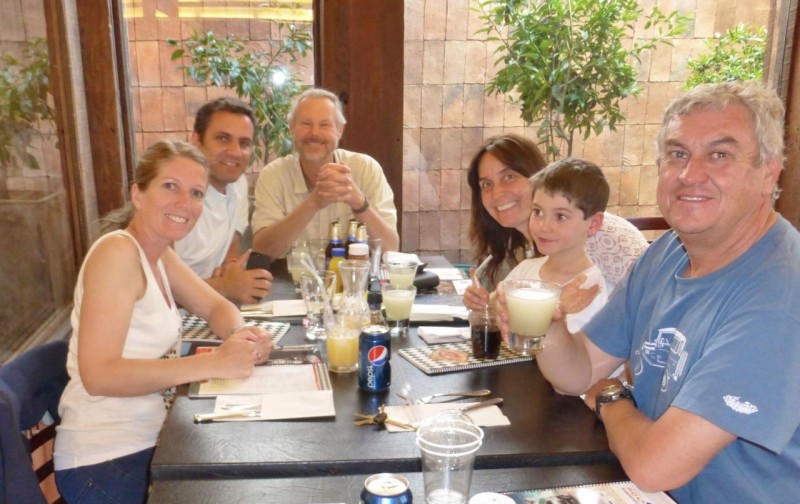
After a much needed nap at our hotel, we enjoyed a great dinner with Sebastian, Luz, Pete, Carolina and all their kids (3 of them off playing in the restaurant supplied playground!). The strong local drinks, Pisco Sours (also famous in Peru), guaranteed a great night’s sleep.

It is now summer in Santiago, and the weather has improved since we were here in September. It was hot and sunny when we woke, so I set off on foot to hunt down two improbable items. First, I needed to replace my (almost) confiscated Swiss Army Knife that I carelessly left in my carry-on back pack. Reno Airport security, of course, discovered it, so I left the security area and found a woman cleaning the slot machines. She was a bit startled, but pleased to be the new owner of my trusty, 20 year old knife.
Secondly, I decided that this 54 year old body needed some dumbbells to help stay in shape on the road. Now where in Santiago would I find those things? The staff at the hotel tipped me off to a place called the Mallsport, which I assumed would be a big sporting goods store. I took off and walked the nearly three miles in the heat, and was astounded to find, not a store, but an entire MALL of sporting good stores! Was I a happy camper or what??
I had a blast, going from store to store, back in the groove of speaking Spanish, feeling healthy, and successfully acquiring my new knife and hand weights. I love Santiago!
In the mean time, Charlotte needed another new alternator bracket (we brought three back with us!), new plugs, cap and rotor, and a new oil pressure switch installed. She also needed her gear lube, coolant, and oil topped off. So Ned, the ever trusty car whisperer got to do some wrenching in the summer heat. He didn’t have as much fun as I did, but his efforts were greatly appreciated by both me and Charlotte.
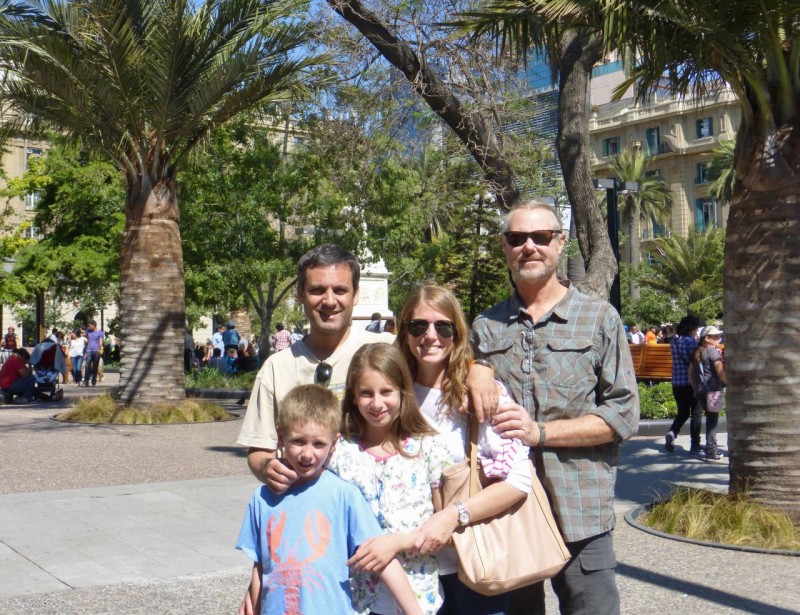
Later that day, Sebastian, Luz, Emily and Seba (short for Sebastian) treated us to a tour of lovely, downtown Santiago.
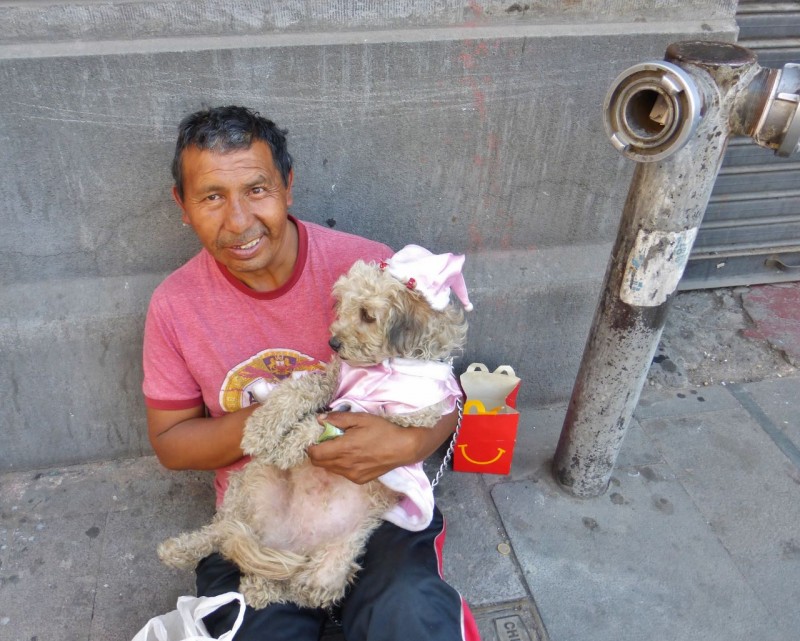
We walked passed this guy and his princess-clad pup and I had to get a shot. He happily accepted a 10 Peso note (about $1.20) for the favor of taking his photo. Note the McDonald’s Happy Meal box.

The tallest building in South America. You can even almost see the snow capped Andes through the haze.

Ned will share this one, of course:
Sebastian had been telling me about this friend of his that had some “amazing” cars. As I was interested in seeing them, he arranged a visit. We only saw part of the collection which is scattered at various properties around town. These beauties were housed in the basement of a beautiful home in the foothills of Santiago. Amazing does not begin to describe the caliber of these vehicles. Seen here left to right are an Audi Quatro Works Rally Car converted to street use, a Porsche 959, a Porsche RSR and a brand new, just-arrived-that-week McLaren 650S Sprint, the first and only one in South America. Rarified stuff indeed in any country! Behind me is a Porsche Carrera GT and another, one year old McLaren. These cars’ owner also races in the Dakar in a Works Mini. We plan to catch the Dakar race next month in northern Chile when we meet back up with Sebastian and family in Copiapó.
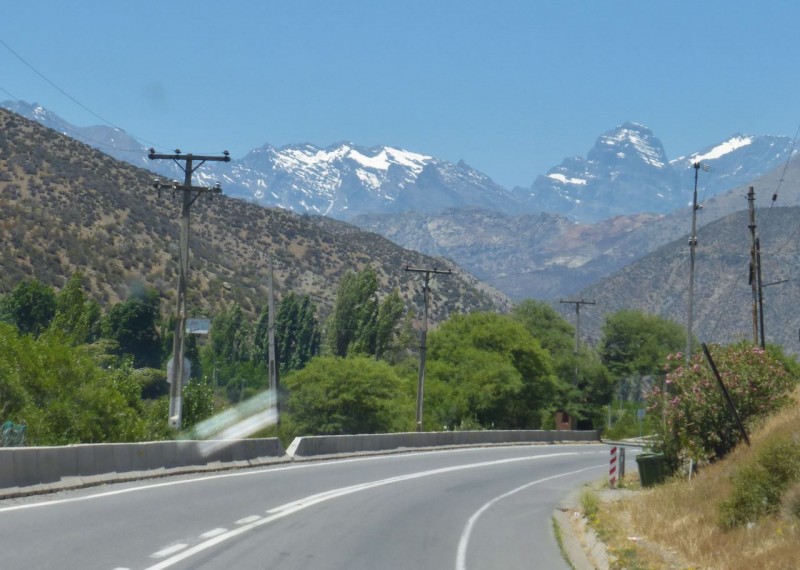
On Sunday the 7th we left Santiago and found ourselves excited to be heading east, crossing the great Andes Mountains and into another new country…Argentina.
Our plan for the next month is to cover northern Argentina and work our way up to Bolivia. We skipped Bolivia earlier this year due to my illness and the fact that it was freezing cold. Once in Bolivia we plan to check out the famous salt flats in the southwestern part of this landlocked country. This should bring us into 2015 when we have a date during the first week of January with Sebastian and Pete to meet them and their families for camping on the beach at Basecamp (which we visited back in September). The plan is to watch the world famous, three-week-long Dakar Rally Raid race as it passes through this area in the sand dunes of the Atacama Desert. After this exciting reunion with our Chilean friends we will high-tail it south, through Patagonia, to the tip of this amazing continent, our final goal of the whole trip.

There are several border crossings over the Andes between Chile and Argentina, but this one is famous for Los Caracoles Pass which boasts 30 steep switchbacks and is listed as one of the10 most dangerous roads in the world. We found the 10,000ft pass to be fun and interesting, but much tamer than many other passes we have crossed over this past year. I just wouldn’t want to attempt it downhill in the ice and snow of winter!
Note: Charlotte is posing here for the photo; we actually drove UP the pass.
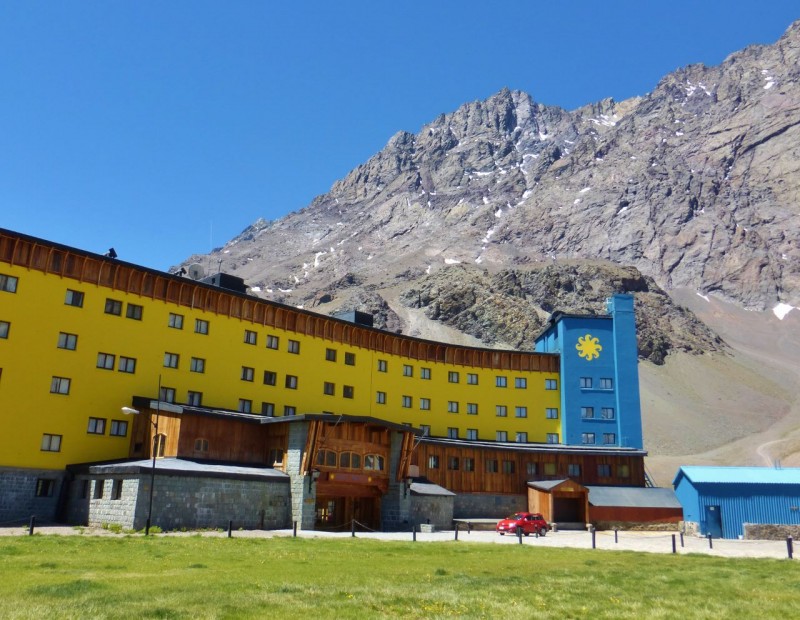
Once over the pass, we found dozens of little (and big) ski resorts. We decided to stretch our legs and take a look around…
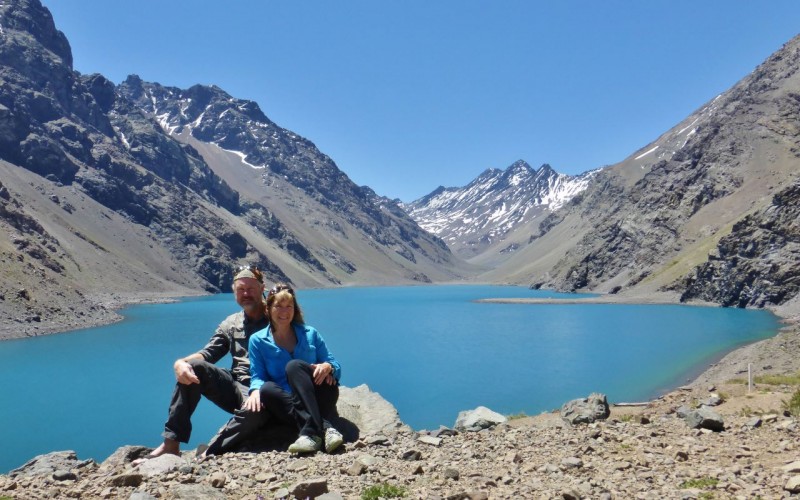
…and found this little turquoise gem hidden behind that big yellow monstrosity! If we hadn’t stopped, we never would have seen the gorgeous Lake Inca.
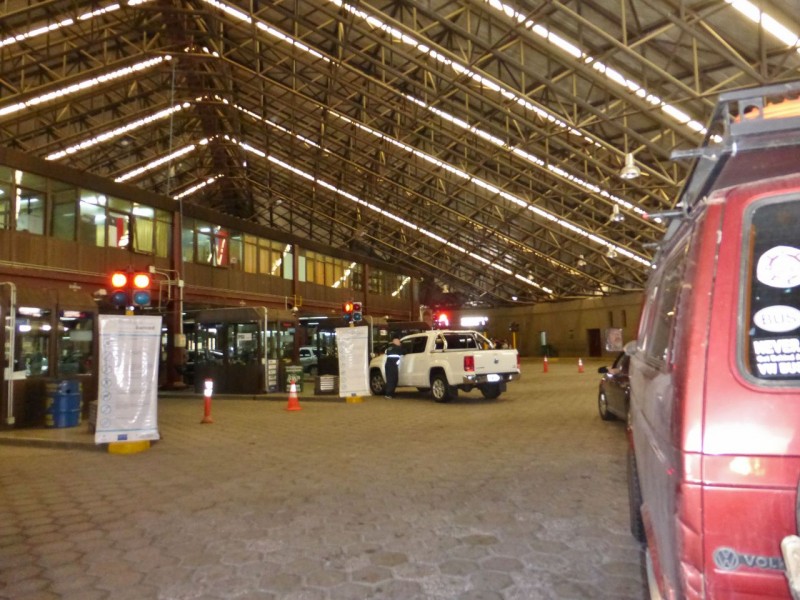
This was by far the best border crossing ever. It was not only indoors, out of the heat of summer, (and snow of winter), but it was also an incredibly civilized cooperation between Chile and Argentina, whereby both the exit and entrance desks with their respective officers sat side by side in the same room! This made the whole border crossing process a breeze. What a concept!

We were efficiently directed down this “assembly line” of Immigration and Customs. The officials were friendly and polite and the whole thing took about 10 minutes, as it should be. By comparison, the histrionics and delays at other countries’ crossings sure seem like unnecessary displays of power and control.

A brief view of Aconcagua, the highest mountain in the western and southern hemispheres, at 22,837ft. No immediate plans to climb it.
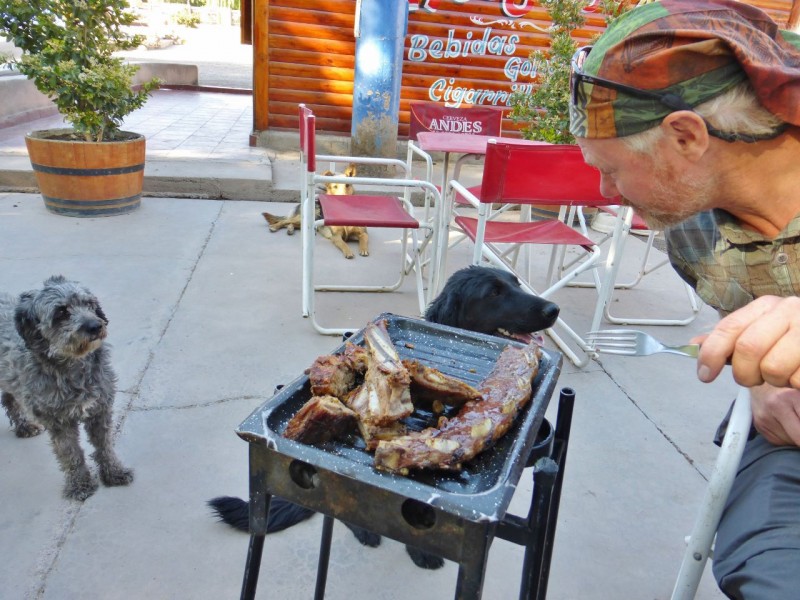
In the cute little town of Uspallata, at the bottom of the pass, we were treated to an Argentinean specialty, Chivito, which is roasted goat. Apprehensive at first, we were hooked after the first bite. The local dogs were hoping otherwise. Absolutely delicious!

Of course, as his T-shirt shows, he’s a big fan of all things Volkswagen! He was pretty happy with the stickers.
Lautaro’s dad, Roberto, the restaurant manger, also came out to say hello.
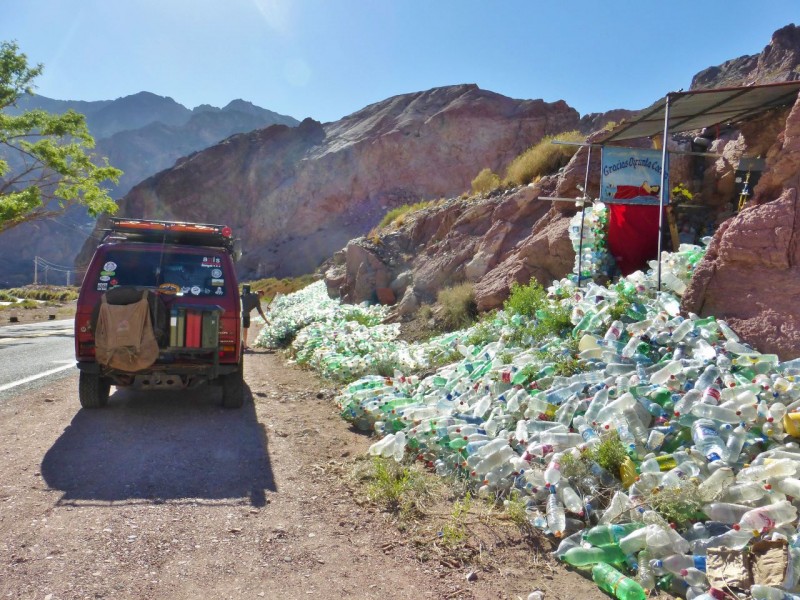
Like many of these, predominantly Catholic, Latin American countries, Argentina has its share of roadside religious shrines. The Argentineans have come up with an unusual way to recycle plastic bottles by leaving offerings of water to the saints. On the way to Mendoza, we spotted this huge collection, by far the biggest one we’ve seen to date.

100 plus degree heat found us sweating in the non air-conditioned Charlotte and also sharing a gas station bathroom with this hot dog. Still no paper, soap or seats.

Our experience of Mendoza was of an ugly, grimy city. Perhaps we were tired, hot and crabby and only saw the bad side. We got some crummy food at a grimy grocery store, had a good navigation fight, and got out of there.
We found this out-of-the-way wash on a dirt road off of Ruta 40, had some beer and cheese for dinner and camped for the night.
In the morning Ned decided to remove the skid plate which had been incrusted with fluid/oil leaks and road dirt to the point where it was going to rub a hole in the bottom of the transmission if something wasn’t done about it.

While we had enjoyed our last three nights of camping out in the desert, we were not enjoying our sweaty selves. We felt about as encrusted as the skid plate.
Then, miraculously, about 10 minutes out of camp we spotted a rare desert river with clear water. We quickly took advantage of this hidey hole under the overpass for heavenly baths in the Rio Huaco.
Ned and I have a long history of being “Trolls Under the Bridge,” so this was a particularly fun stop.

And what better time to roll across the 20,000 mile mark!!!
This was the mileage Ned wrote on the headliner the day we left home last December 21, 2013.
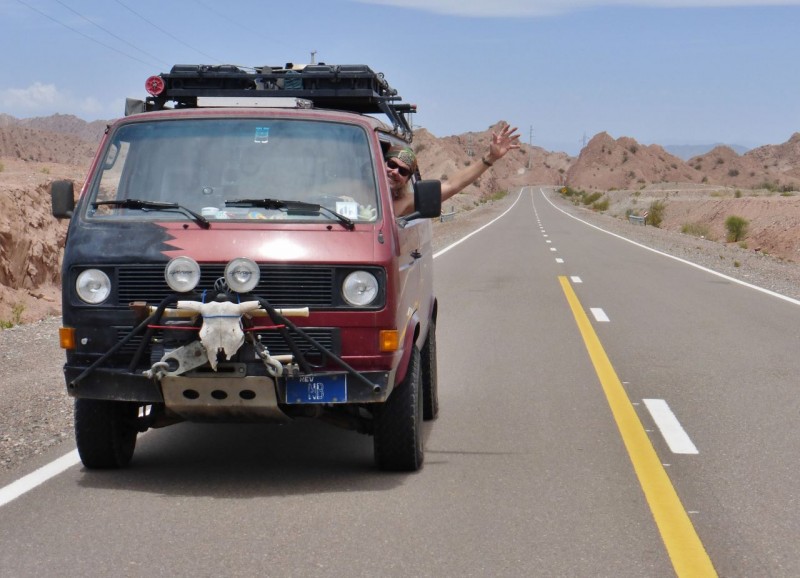
Hitting 20,000 road-trip miles while driving down lonely highway 150 toward Parque National Talampaya in Argentina. Pinch me!

Sebastian and Pete had been to Parque National Talampaya and, in spite of having to take a tour truck into the park, had highly recommended a visit.
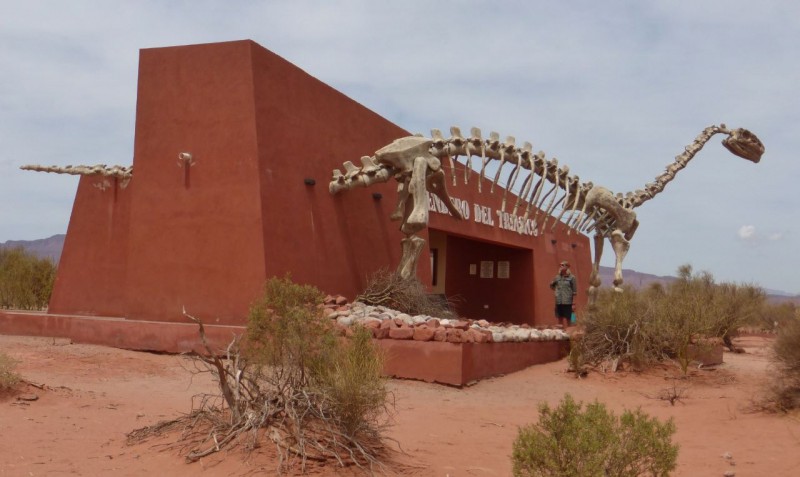
The park entrance was a remote outpost in the desert, but boasted a cool dinosaur display. We enjoyed it while waiting for our tour.

In spite of being bused in with a handful of other tourists, we found the canyon spectacular, reminding us of Moab, Utah. And yes, the air conditioned vehicle was a nice respite from the hundred degree heat.

Our wonderful native guide, Oscar, showed us around, pointing out several places with ancient rock carvings.

Another dry wash, another nice, quiet camping place.
The night skies have been spectacular, but odd. I can’t really say that I’m an expert on constellations, but somehow, we just know our own sky. Here in the southern hemisphere, it’s beautiful, but unfamiliar, feeling somehow alien.
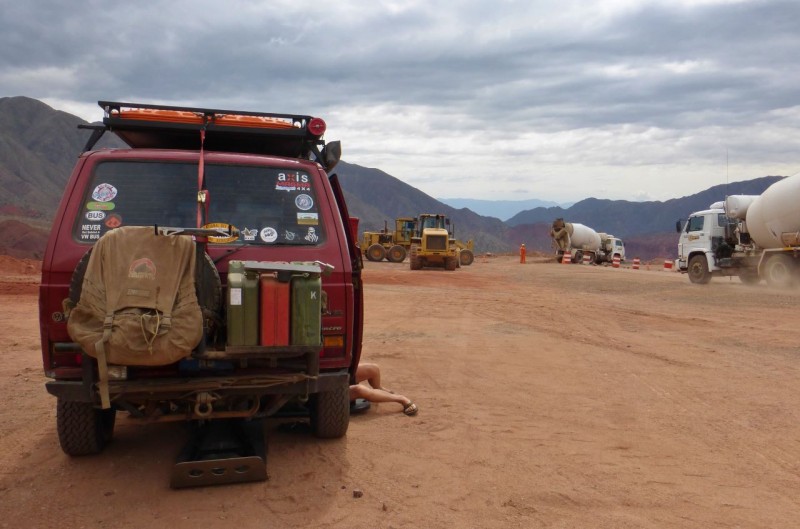
A two hour stop for road construction had us grumbling until Ned said something about “making lemonade” and took the opportunity to reinstall the now shiny clean skid plate.

In the cute town of Cafayate, we got a little hotel room for showers and stocked up on food at the always fun local markets.

Yup, another wonderful use for soda bottles…first, water offerings to favorite saints, now Christmas trees.
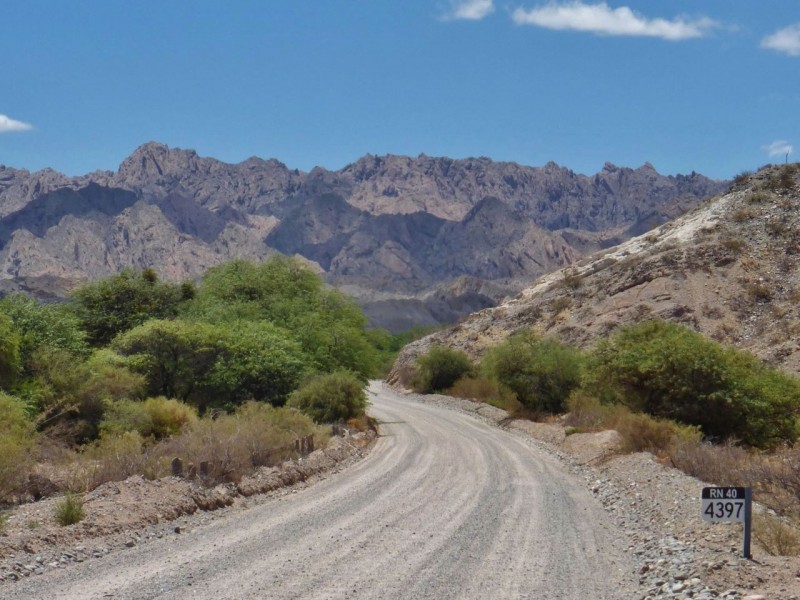
Remarkably, the Ruta 40, the historic North/South Route through Argentina, turned to dirt. The mile marker is claiming 4,397 kilometers (2,732 miles) from the southern end of the country…our ultimate goal. So why are we are heading north?
Having missed Bolivia because of illness, we are heading there now, and enjoying spectacular Northern Argentina in the process!
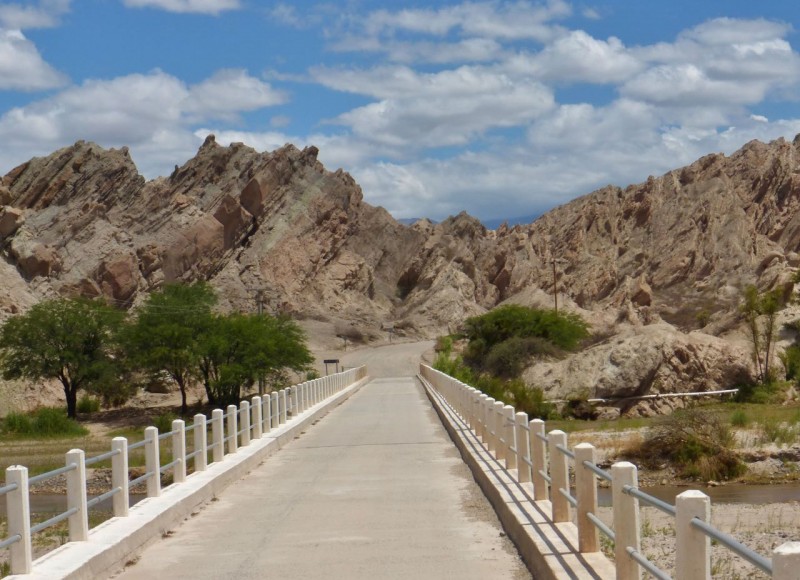
The owner of the hotel in Cafayate had told us about these fantastic rock formations along the Ruta 40. Come along as we drive through Las Flechas (The Arrows)…
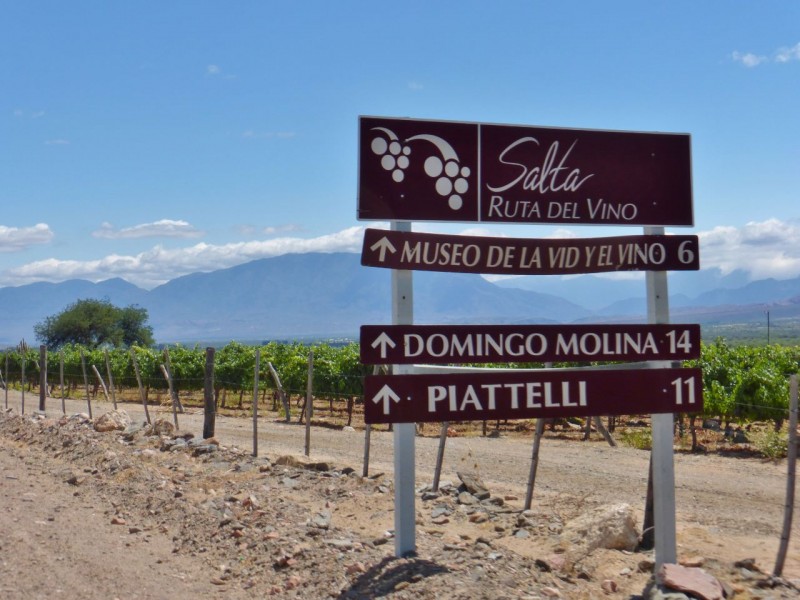
As many of you know, Argentina is famous for wine, and we found ourselves on the spectacularly scenic Ruta de Vino.

Neither of us are big fans of wine tasting, but I pestered Ned into stopping at Bodega El Cese, where Ivan showed us around and gave us some yummy samples. This particular winery was only opened in 2013, with the vines planted in 2009.
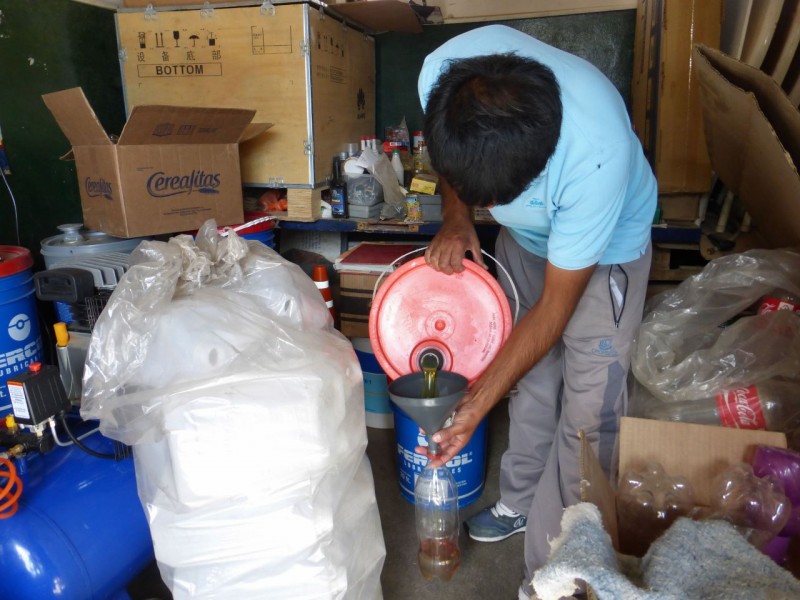
In the tiny village of Molinos, we found yet another use for soda bottles. Ned had been searching high and low for Charlotte’s gear oil, and finally found some here…but in big buckets.
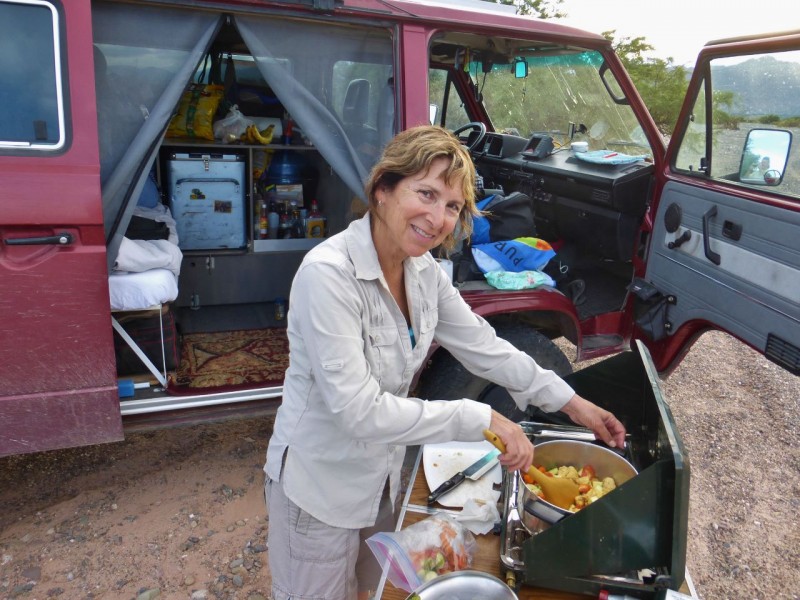
While looking online at the Salta region (northern Argentina) we found an obscure reference (in Spanish) to a place called Las Cuevas (caves) de Acsibi. It looked gorgeous and was only accessible by four wheel drive up a remote dry river bed outside the small village of Seclantás. We were intrigued to find the caves, neither of us having bothered to get the GPS coordinates. We asked many locals, but few had heard of them. The Challenge was on!
After considerable inquiry, including the Police at Seclantás, we were 75% sure we had found the correct wash (dry river). It was getting dark, so we camped for the night, having driven about five miles off road, hoping the storm clouds on the horizon wouldn’t change the waterless status of the river. The temperature was also blessedly cooler, and checking the GPS, we found we were at 8500 ft. elevation. Nice.
Dinner was a great one-pot meal full of fresh chicken and vegetables from Cafayate…

…accompanied by a great local beer… La Pecadora (The Sin!). At 6% alcohol (strong for beer), it was still wimpy compared to the 11% one we still have in the fridge!

Had to take this shot…these industrious little guys made off with a piece of cheese at the astonishing rate of 6 inches per minute (yes, we timed and measured). We never even found them until they were all the way on the other side of Charlotte from where we ate!

In the morning, we drove another six miles up the river bed, finding, at last, an opening to a red rock canyon. We must be on the right track! Unfortunately, our voltage was reading low at only 12.9, spelling a possible problem with the alternator – again! And we were 11 miles up some desolate wash. The anxiety of a potential rain storm and a subsequent flash flood was now added to the possibility of a dead battery. But it sure was beautiful. And…out on a limb is where all the fruit is, right?

So we parked, and I made breakfast while Ned investigated the voltage issue. Reattaching the main lead stopped the immediate problem, but the battery was still not fully charging.

Voltage problem at least temporarily solved, and rain clouds having broken up a bit, we relaxed and headed off on foot in search of the illusive Cuevas de Acsibi.

We had no idea if we could find the caves, or what we were really even looking for, having only seen one photo. But it was beginning to be irrelevant. What we were seeing was stunning enough!

The canyon kept dividing, and we kept following our noses, trying to decide which fork would lead to a place where the walls would narrow considerably. We had slogged up the sandy canyon floor for two hours when Ned finally climbed to a good lookout spot (can you see him?). He called for me to go back to the previous fork, being pretty sure he had spotted a good “narrows.”

The walls not only narrowed, but the formations became even more bizarre and beautiful. I still must have food on my mind; these look like potatoes.

This was the very cave from the internet photo, identifiably by this unique and spectacular formation.

I had, sadly, lost my cool little tripod at Lake Inca, so we had to prop the camera up on my backpack for this shot.
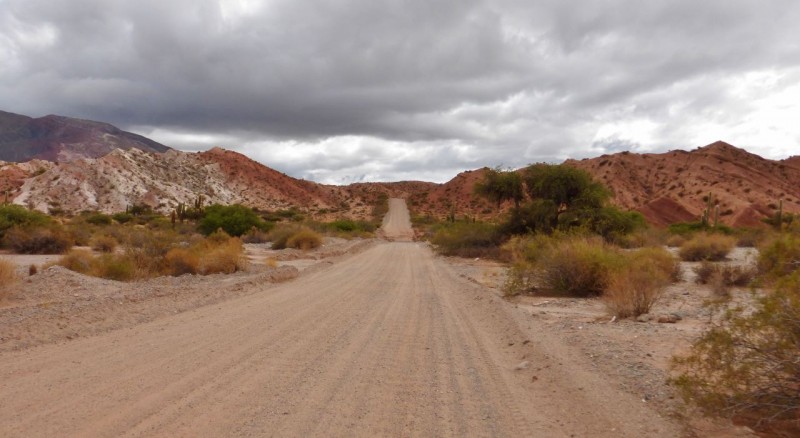
After another peaceful night camping in the canyon, we headed east from Seclantás on the RP 42S, finding another deserted dirt highway. By the time we broke camp that morning, we had spent two blissful days without seeing a single road, car or person…certainly a record for this trip.

We turned east again onto the RP 33 toward the little village of Chicoana, where were to stay at a horse ranch for a couple of days. We crossed another steep pass, the Paso de Fauna, at 10,600ft., leaving the arid desert behind, suddenly entering into a world of lush foliage, dense fog and constant rain. The road also turned to mud and was super windy, with sharp curves and hairpin turns. The limited visibility, steep drop offs, wash outs and fallen rocks made this run similar to the “Trampoline of Death” pass we did in Colombia.
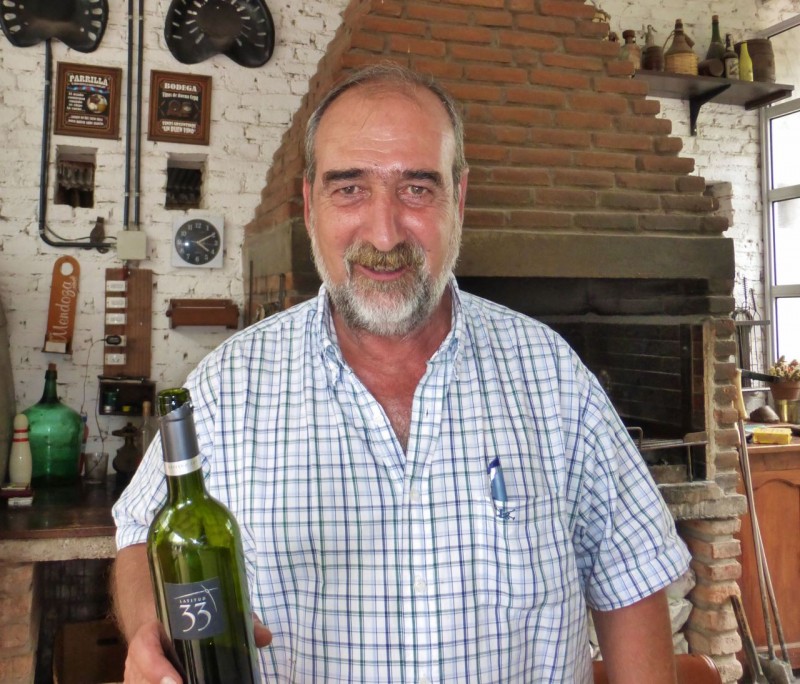
Enrique, the energetic and charismatic owner of Sayta Cabalgatas (Argentinean for horseback riding), greeted us with warmth, enthusiasm and never-empty glasses of delicious red wine. Our hosts also included Enrique’s daughter, Laura and a French couple, Nicolas and Justine, travelers on a long term working stop-over at this delightful guest ranch.

…We had arrived just in time for what turned out to be a rather famous daily lunch. All these other people were one-day clients, there for a horseback ride and a meal before being bused back to the city. It turned out we had the whole place, and the owner’s wonderful hospitality, all to ourselves for the rest of the day and evening.

The table was laid with copious amounts of salads, vegetables, potatoes, and the most incredible grilled meats we’d ever tasted; filets, sausages, ribs, pork bellies; it all kept coming in mouth watering excess, as did the wine! By the time we were finished, we were beyond stuffed and not just a little looped. We staggered off to our cute little room for a nice siesta.

The eating customs in Argentina are really the most different we’ve encountered yet, probably due to the European influence. Lunch is served around 2:00pm. Tea with bread and jam happens at 6:00pm, followed by a supper of tamales and empanadas (meat or cheese filled pastries) at 10:00pm. I found the lunch to be perfect, but, not being a big bread eater, it was tea only for me at tea time. And by 10pm, I was not only still full from lunch, but also totally ready for bed. In addition, breakfast is served at 10:00am (shown above in the wonderful kitchen). But breakfast is only bread and tea or coffee. I kept waiting for the eggs, but when the cooks sat down to eat, I embarrassedly asked if there was more. Laura seemed puzzled and said, “No, there is bread and butter and jam.” I smiled and ran to grab a protein bar. It turns out that this bread-only-for-breakfast is consistent throughout all of the hotels and restaurants we haunted.
Argentineans also take siesta time seriously. After lunch, all stores and restaurants are closed and the streets are deserted until 7:00 or 8:00 at night. Then the towns and cities come alive.
Another interesting and definitely different detail is that the bathrooms in all of the hotels we have stayed sport fine bidets (Webster definition: “a bowl like a small toilet with faucets that is used for washing your bottom”).
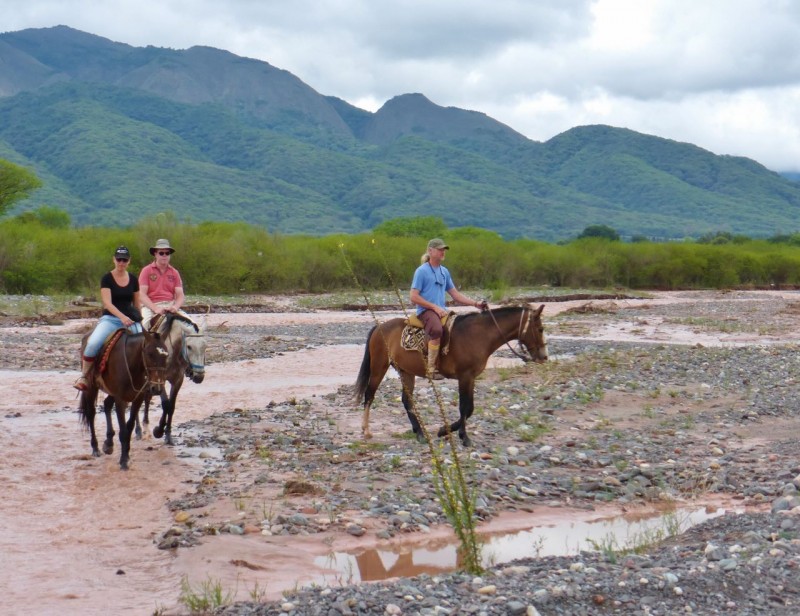
…and a fun ride. Ned, as always, prefers cars, but tried riding again just to be a good sport. I took another jaunt in the afternoon, while Ned politely declined. (Don’t tell him I told you, but I’m going to want to do another ride in Patagonia!)
We stayed at Sayta for two relaxing days, enjoying ourselves immensely. There was no internet, just time for good food, good wine, and getting to know new friends, both hosts and guests.
Coming up next…we are heading for Bolivia, the least developed, most remote, but possibly the most scenic country yet. We probably won’t have any internet access there (heck, we’re worried about getting food, water and gasoline!) so if you don’t hear from us, we wish you all a wonderful holiday and fabulous New Year!
Awesome Atacama, Obstinate Ailment – Chile Part 1
[For those of you who are either not signed up to receive email updates or who somehow missed the last two emails, I have posted copies of them below. The first email, from September, explained that we were coming home for good medical care and the second, from October, was an update on my health progress. If you like, you can scroll down below this post to get caught up.]
Having been home for a month, it feels strange to look back on my travel journal and attempt to write this blog. It has taken me the entire month to accomplish what, at times, felt like a hopeless endeavor…getting well. But I have learned a lot in the process and have gained some interesting insights about comfort zones.
The bug that had plagued me since Peru turned out to be pseudomonas pneumonia, a hard to kill bacteria. The doctors were puzzled because it is an infection that usually jumps on board patients who have been hospitalized for long periods of time. Nonetheless, the culture came back positive for this bad actor and, after six courses of oral antibiotics, I finally had to have a PICC line put in. A PICC line is a tiny plastic tube that is inserted into a major vein (mine was put into my upper/inner arm). The tube runs from the insertion point all the way to the heart. This port gives intravenous access for what are called infusions of antibiotics. And yes, it not only hurt going in (it was not supposed to), but it really gave me the creeps. After all my poor body had been through, having this foreign object in me was hard to bear.
I gave myself the infusions twice a day for four days, but the PICC line never stopped hurting. An ultrasound eventually found dangerous blood clots, and the PICC line had to be removed. I was relieved on one hand to be rid of the invasive contraption, but also terrified that the infection had not been fully eradicated.
Thankfully, the four days of IV antibiotics were enough, and the infection did not reemerge. But it was a physically and emotionally trying time. Lingering symptoms made it feel that the pseudomonas was still lurking, and it took many more doctors’ visits, CT scans and lab tests to confirm that it was only residual inflammation in my lung lining and sinuses.
One of the benefits of having naturally large personal comfort zones is that Ned and I are not only able to embark on adventurous journeys, but we thrive on them. I never thought about it before, but reflecting now on our journey, I realize that when we are on the road, we are constantly on the hunt for the most basic human needs…food, water and shelter. We do carry a few days worth of supplies, and Charlotte is, herself, our shelter, but finding good stores and camping spots is a constant challenge. The experience is immensely different from being home where we take our simple comforts for granted. While some people would be uncomfortable at best and terrified at worst to live like this, Ned and I consider it all part of the adventure and take it in stride.
As the weeks went on, however, and the illness progressed, my comfort zone began to shrink. It was neither fun nor exciting not knowing where we would camp at night, and far from being exhilarating, the extreme elevations and cold temperatures now meant severe chest pain and inability to breathe. By the time we made it through the arduous flight home from Santiago, I had a comfort zone about the size of my bedroom. I have never been more grateful to be home in the beautiful United States where our lives are easy and convenient (and the toilets have seats!).
Our home became my haven and except for doctors’ visits, I did not want to leave it. Unlike my normal state, I felt fragile and afraid, as if the tiniest cold draft would cause yet another relapse. But here is where I have gained valuable perspective…comfort zones and the way we think about them, like most everything else in life, are a matter of perspective. I am ashamed now to admit to being a bit judgmental towards others who are uncomfortable venturing beyond their safe zones. Individual experiences and temperaments influence how we see the world and we each determine the size and shape of our comfort zones depending on our own circumstances. There is no right or wrong. That being said, I do believe that, in some cases, pushing ourselves beyond what we think we can endure can reap incredible gains in self confidence and worth, but it has to be a personal decision. My own shrinking comfort zone has taught me just how inappropriate it is to judge another’s. The decision to stretch or not to stretch is private and personal.
I know it’s been a long time since our last post, but I deliberately put off writing this blog until I felt hale and hearty again. Yesterday I celebrated wellness with a blissful three hour solo hike/run on the mountain, and it was heaven. My muscles felt weak and slow, but my lungs were clear and painless, and it was a great victory over illness. A month ago, having battled ill health for so long, the thought of setting out again in early December to continue our journey was frightening. Today, my perspective is totally different, and I’m eager to get back on the road.
My experience with Lyme disease has taught me not only to be patient with myself, but also that we can always endure more than we think we can. There were countless times in the last two months when I thought, “I can’t take any more!” But there I was, soldiering on. Of course, I was never alone. The love of Ned, family and friends and the infinite kindness of doctors, nurses, and support staff saw me through each difficult day. Many thanks to all of you!
And now, let’s get back to our story…

September 9, 2014
Peru/Chile Border
The drop from Arequipa (Peru’s second largest city), at 7,500ft elevation, to sea level was mercifully rapid. While 7,500ft was better than 15,000ft, with asthma and pneumonia, I was still struggling to breathe and was praying that sea level would be better. I was on another course of antibiotics from the clinic in Arequipa, but they did not seem to be working.
The scenery became more beautiful as the world’s driest desert unfolded before us, but, sleeping in the back of Charlotte, I once again missed most of it. With Ned still not feeling well and my fever hovering around 101° we found ourselves merely surviving, unable to savor or even appreciate our surroundings. The black cloud was still with us.

Sea level brought not only a bit of relief for my breathing, but sunshine too!
I was dreading an arduous border crossing into Chile and popped Tylenol to help endure it. Thankfully, it turned out to be relatively painless, and the hour and a half passed in a fog of semi awareness.

Bordered by the Pacific Ocean on the west and the Andes Mountains on the east, Chile’s geography is quite unique. While merely 217 miles at its widest point, Chile is 2,670 miles long, reaching down through Patagonia toward the Antarctic Circle.
Our drive from Arequipa (shown on map) and through the Chilean border brought us to the northern coastal town of Arica where we got yet another hotel room. It was incredibly frustrating to be surrounded by gorgeous desert and not only being cooped up in a hotel, but paying for it too! However, still choking, coughing and feverish, I was happily accepting any comforts I could find.
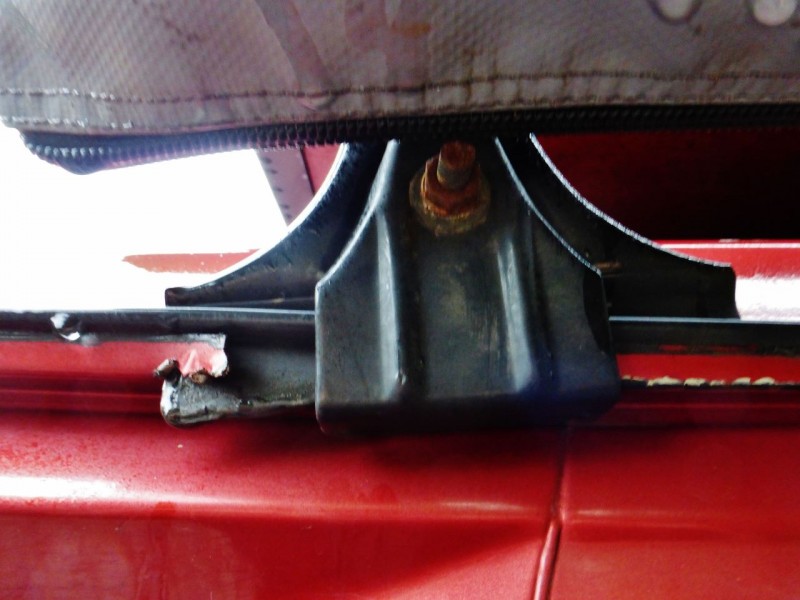
After Charlotte’s alternator bracket repairs in Cusco, she was back to running well. Her only ailment was that thousands of miles of rough dirt roads were causing the feet of the roof rack to break through her rain gutters. It was a bit disconcerting, wondering if the whole roof rack would abandon its post and fly off somewhere along the way, but it would have to wait until Santiago. It would be a big welding job, and in Santiago we had friends with shops where Ned could do the repair.
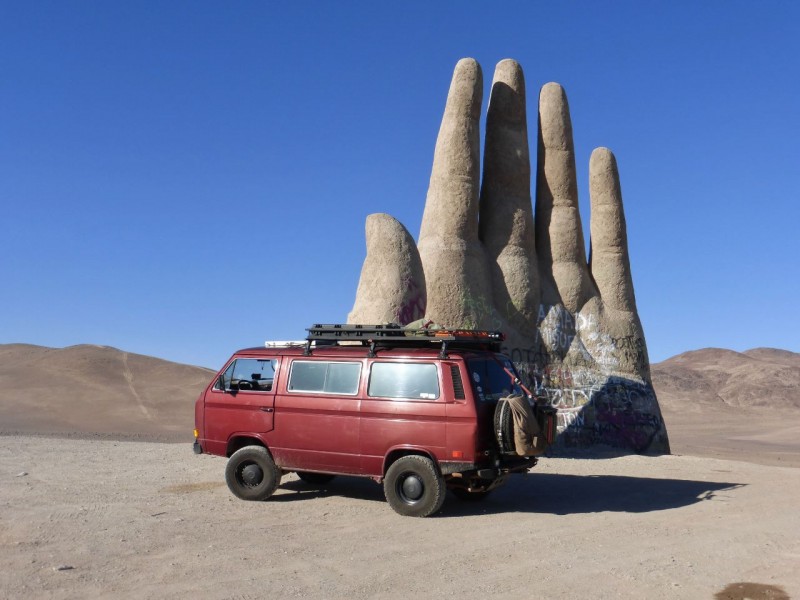
From Arica we set our sights on the town of Copiapó. As we had thought, Chile was a lot more developed than any other country we had visited, so I had high expectations for good medical care in Copiapó. Also, from there it would be a quick flight to Santiago where I knew there was an excellent private hospital if needed.
This was the most incredible stretch of the Pan American Highway yet. Ned made 400 of the 700 miles to Copiapó, and we never saw so much as a blade of grass or even a single town. For desert rats like Ned and me it was sheer bliss. We love the stark beauty and wide open vistas of arid climates and this was the ultimate.
Along the way we were delighted to see the Mano de Desierto (Hand of the Desert), an iconic concrete sculpture grandly poking out of the sand beside the Pan Am.

Most of the towns in Northern Chile are situated along the coast, so we dipped west off of the Pan Am to get some dinner in Antofagasta just after dark. It turned out to be a mistake. The seedy city was full of bars and casinos and was singularly devoid of decent looking restaurants. I was still miserably choking and coughing, and we settled on the speed and convenience of McDonald’s in sheer desperation. We left the city as quickly as possible, and, back on the Pan Am, Ned was able to find this funny hidey hole where we could camp, unseen from the highway. The night passed peacefully, and I woke feeling a little better.
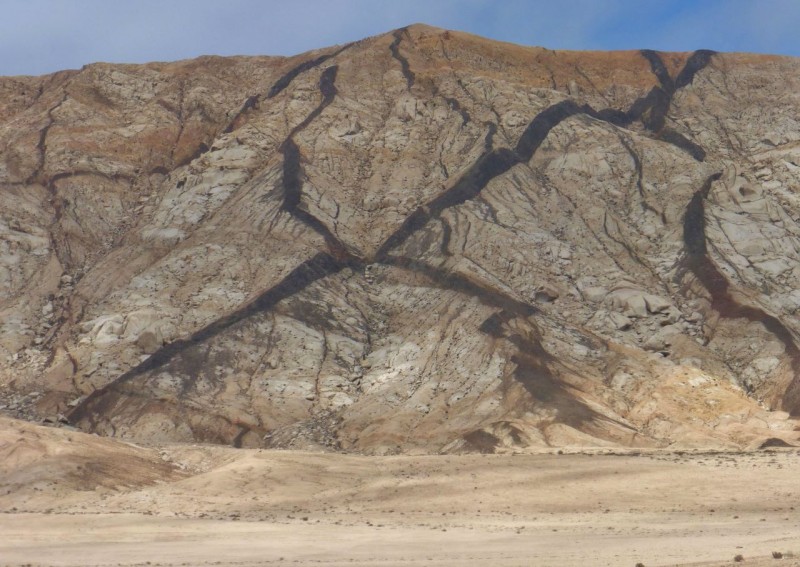
With my fever lower, I was able to sit up front with Ned, have a nice conversation and enjoy the wonderful scenery of the Atacama Desert.

The great Atacama is the driest place in the world, with some weather stations having never received any rainfall. It is also the oldest desert. Most areas have experienced “extreme hyper aridity” for at least 3 million years and some as many as 200 million years.
The terrain of the Atacama is reminiscent of Mars, not only visually, but scientifically too. Research on the lifeless soil has assisted in space exploration, while filmmakers have enjoyed the unlimited Mars-like landscape as sets for their sci-fi movies.
We finished our mad dash to Copiapó the next day and stayed for five days. The medical clinic was clean and modern, and the doctor there gave me another course of antibiotics that she insisted would work.
Following is an excerpt from my travel journal: “Clinica Atacama way more civilized! Modern, clean, efficient. Unfortunately urgent care full of very sick miserable babies. At one point, waiting to get chest X-ray and blood work, had two screaming, in pain babies in the room and I ended up crying too. This is just too much. How much more can I handle? I’ve been very sick for a month. Have not worked out or enjoyed myself, have lived in fear of being this sick far from home, and I’m so tired if it all. This is where I could give it all up and go home. Somewhere I have to find the strength to keep fighting. I need my spirit back not just my health.”
Copiapó was a cute desert/mining town, but we didn’t get to see much of it. The doctor had ordered bed rest for me, so I only ventured as far as the hotel restaurant. Ned, on the other hand, spent his time doctoring Charlotte. Not only did her brakes need changing, but also, as he predicted in the last blog, the monster reinforced alternator bracket caused one of the two puny 8mm mounting studs to sheer off in the engine case. Ned had to drill the whole mess out, and then tap the hole for a 10mm bolt. He was also elected to restock our food and water.
In general we found Chile to be relatively modern, but just as expensive as the United States.
Crossing the border, there were two things that changed dramatically. First of all, the time jumped two hours ahead, which meant that it didn’t get light until 8:00am and dinner was eaten around 8:00 or 9:00. The second and most wonderful phenomenon was that the food became miraculously delicious! After months of dreary Colombian and Ecuadorian food, we found our meals in Chile to be diverse and tasty.
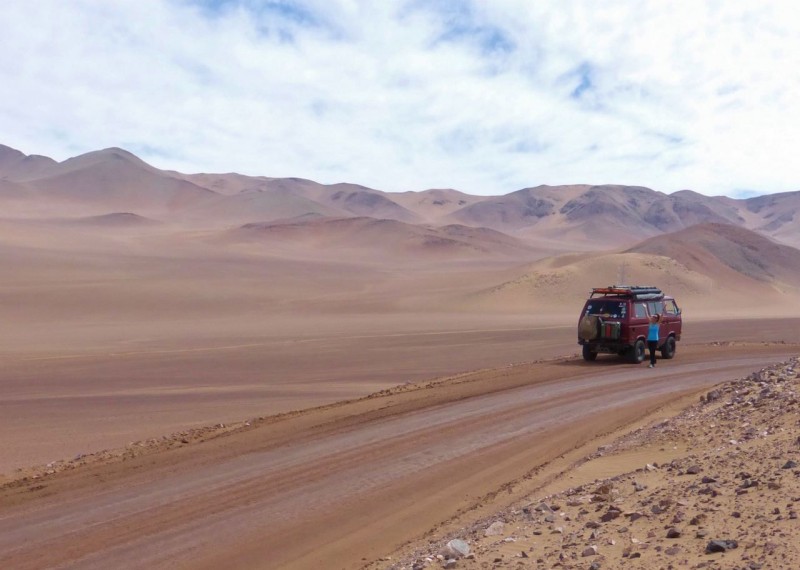
We left Copiapó and drove into the desert where we wandered around and camped for four days. The temperatures were perfect, and the air was dry and crystal clean. The Atacama had been high on the “places most excited to visit” list, and we were thrilled to be there. Surely this was where I could get finally well.
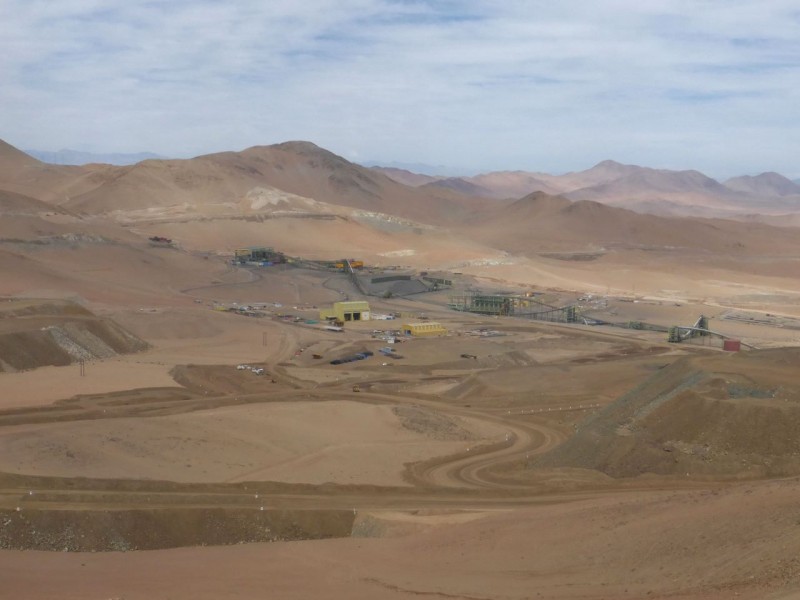
Mining is the greatest economic asset of a desert, and here in the Atacama, copper and nitrates are the most common minerals extracted.
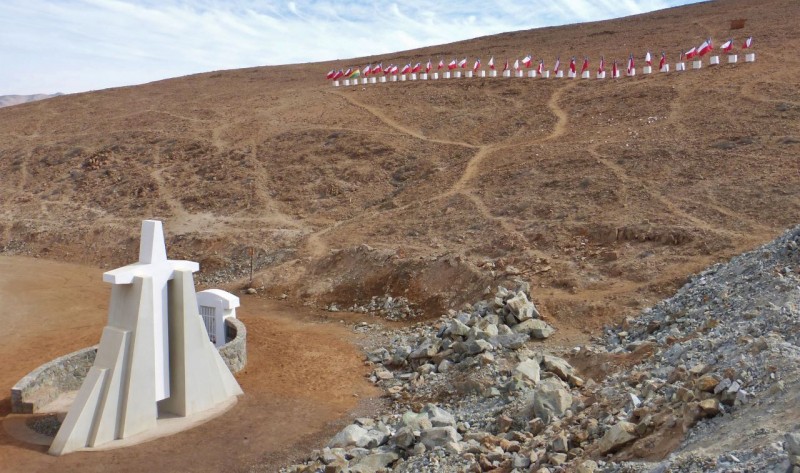
One of our goals was to visit the famous San Jose mine where, in 2010, 33 miners were trapped and dramatically rescued after 70 days. We had no idea what to expect when we arrived, and were hoping for a mine tour. We found, instead, that the mine had been turned into a giant museum commemorating the rescue, and no tours were available that day. The place was deserted, and the lone caretaker said we were free to wander around on our own. Oh goodie. In my feeble condition, I had been hoping for the golf cart tour!
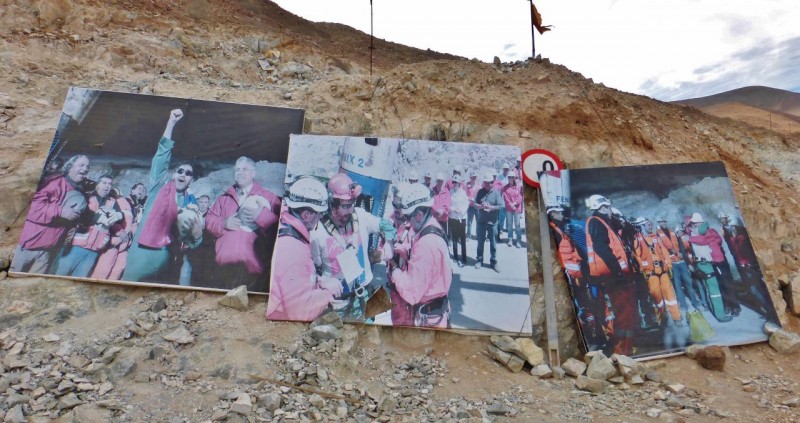
We did explore a bit, but I was so weak and breathless that Ned had to continually stop for me to catch up. Among the museum displays were these giant victory photos of some of the miners as they were brought out of the mine.

The rescue effort included not only locating the miners, but also boring a tube 2,300 feet deep through solid rock. This was the capsule that was built to retrieve the miners one at a time. That had to be an incredible feeling; to be lifted to freedom in that capsule after being trapped for 70 days. Look closely…Ned’s in there!

This is the carved reproduction of the first note written on a scrap of paper by the miners once they had finally been located. A small bore had been drilled first to pass food, water and communication. The note says: “We 33 are fine in our refuge.”

After visiting the San Jose mine, we drove several miles completely off of any roads, settling into this fantastic camping spot.

You can see here that Ned was definitely feeling better, and having been the one to stock up our food supplies, had giant burgers on the menu.

I got out of bed long enough to munch down a burger patty while Ned attacked his masterpiece. He then took an exhilarating hike to work it off. Climbing to the top of a giant dune, he got to run back down the sandy slope barefoot like a little kid. I crawled back to bed in Charlotte, green with envy. Ned returned just before dark, exclaiming, “I feel alive!” Yes, definitely jealous.

We meandered south for the next couple of days, and signs of life began appearing. Huge swaths of purple splashed across the hillsides turned out, upon closer inspection, to be beautiful fields of flowers.
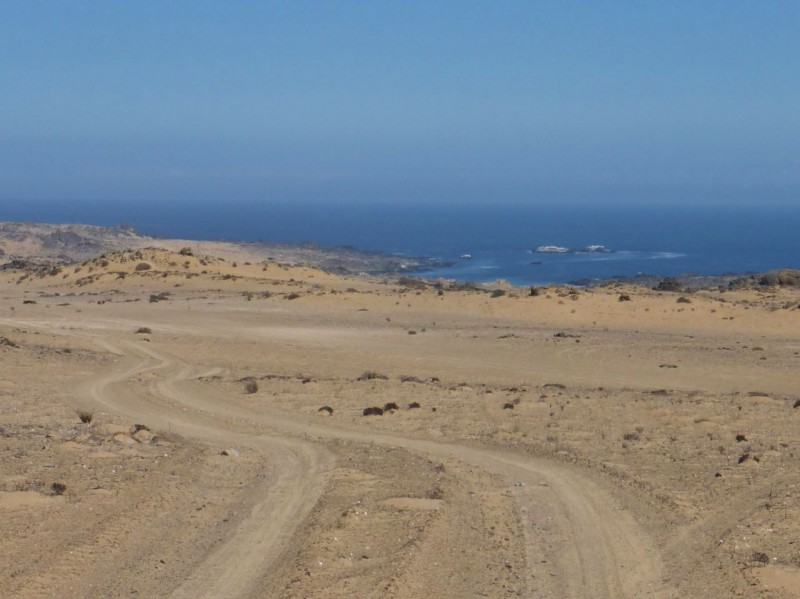
One of our contacts in Santiago was a man named Sebastian, who was friend of a friend. We had yet to meet him in person, but he had already been incredibly helpful to us. Sebastian had told us via email to visit some friends of his who owned a beach resort in the north called Basecamp. This remote sand track leading to Basecamp looked promising.
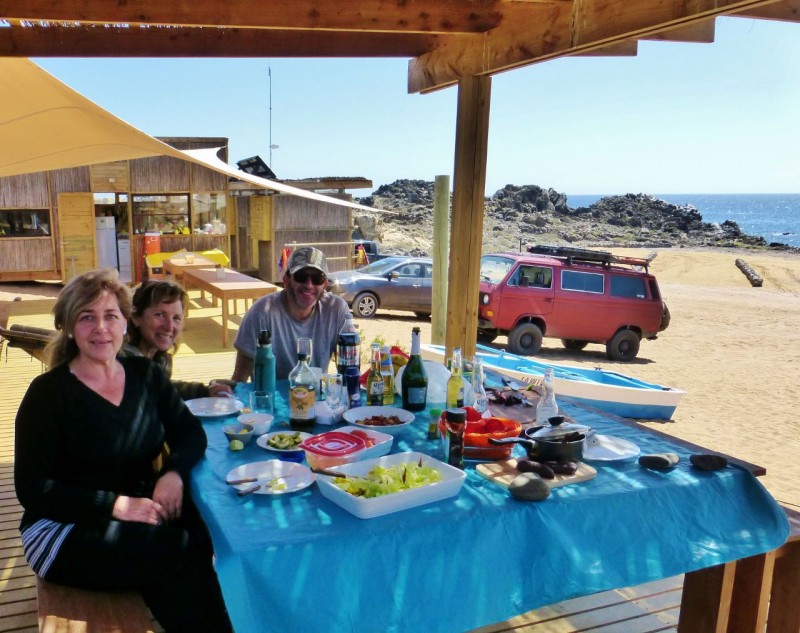
We were not disappointed. José and Marcela were warm and gracious, laying out a gorgeous lunch of barbecued beef and lots of yummy fixings. Their little resort is the perfect remote beach getaway place, sporting luxury dome tents, camping spots and a kitchen. We enjoyed a leisurely afternoon chatting with our new friends, but opted to continue pushing south rather than stay the night. My fever had subsided, but I was still having difficulty breathing. The hospital in Santiago was looking like our next big hope.

The antibiotics, while not working 100%, were at least keeping the fever down, and I was able to continue putting one foot ahead of the other. We passed the next couple of days in solitude, enjoying beautiful scenery and camping in gorgeous spots.

Coincidentally, it was Chile’s Independence Day, and we watched as people and horses lined up for a big parade. Oddly, when we looked back on our photos we noticed that there were not many big smiles.

It appeared as if the history of Chile was being played out, and it was fun to see in spite of not feeling well.
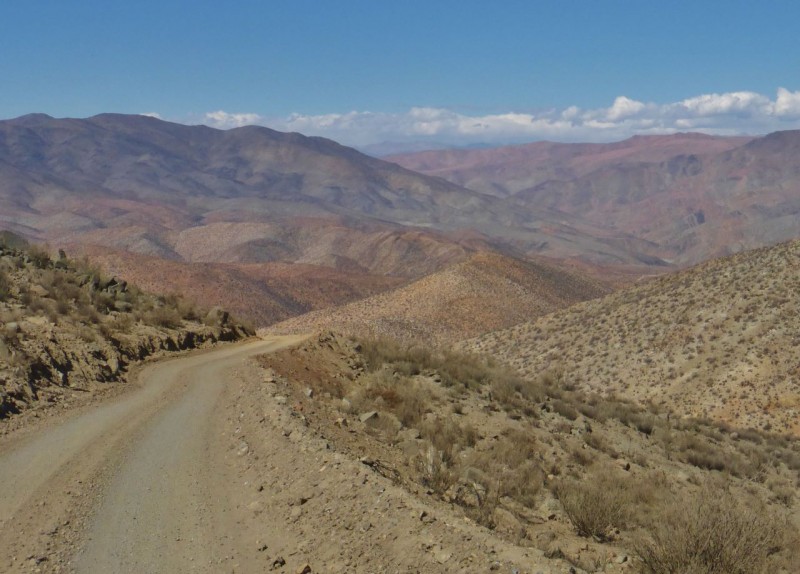
From Huasco, we decided to take another dirt road south. Being sick makes the risk of remote roads a bit higher, but we had been enjoying the desert so much we were not quite ready for the Pan Am. This whole area reminded us a lot of Baja.
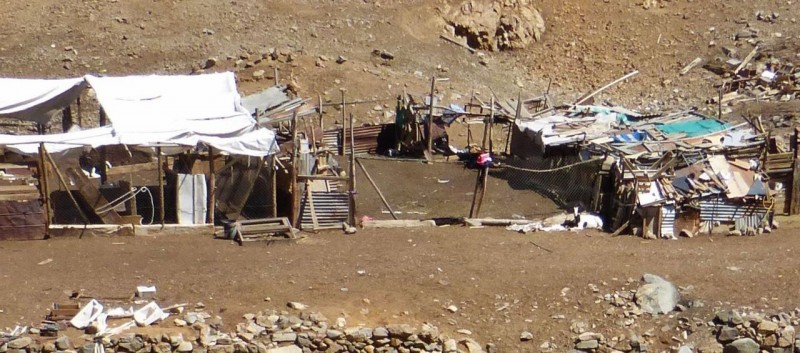
Small mining claims dotted the hillsides, and all of the dwellings looked liked this – ramshackle and poor.
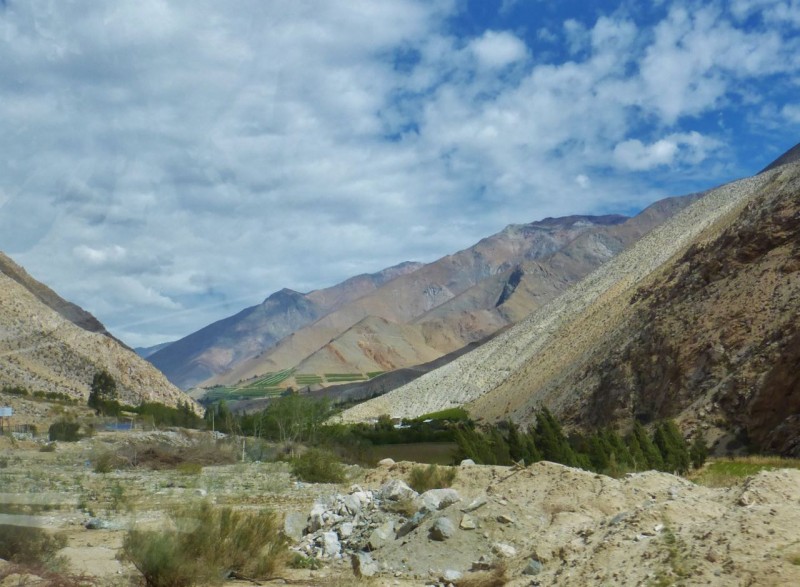
Sebastian had suggested that we visit the Valle de Elqui, which is a lush, river valley known for growing the grapes used to make Pisco. Pisco is a brandy-like liquor and is widely enjoyed in Peru and Chile in a drink called a Pisco Sour.

We stopped to explore the tiny but touristy (mostly Chileans and European backpackers) town of Pisco Elqui.

Dinner in Pisco Elqui was delicious and included a sampling of Pisco…straight…just to see how it tasted. It was not delicious. We had the bartender turn it into a Pisco Sour and it went down just fine floating in a tasty sweet and sour mix.

Continuing south, we found ourselves on yet another dirt road. We kept saying that we needed to spare poor Charlotte for the arduous roads through Patagonia and Bolivia, but we just can’t seem to stop seeking the roads less traveled.

On September 20, we cruised right in to Santiago. Surprisingly, there was no traffic and no navigation fights. The only bad thing was the horrendous smog. Santiago is in a gorgeous setting surrounded by snow capped mountains but you can’t see them! We drove right to Hotel Acacias de Vitacura, and were instantly charmed. Sebastian had made the reservation for us and it was perfect – a balcony overlooking a lush garden, a fridge, and HEAT again for the first time in the whole trip. The room was done all in white with a white carpet and we cringed knowing we (dirt bags) would trash it!
I had finished my last course of antibiotics two days before and was already struggling with another relapse. I pulled out a business card José (from Basecamp) had given me and began to experience the true kindness of Santiagans. José’s brother was a doctor at the Clinica Las Condes, the very hospital I had found on Google, and José had given me his cell phone number. I hesitated to call on a Saturday night, but I was beginning to feel desperate.
Dr. Bravo could not have been nicer. Far from being annoyed by my call, he was expecting it. José had filled him in previously, and he was ready to set me up with a specialist. I was to call him back on Monday morning at 8:00am. I was close to a melt down at this point, but had high hopes of the specialist being able to cure me.
By Monday I was feeling even worse, but Dr. Bravo came through. In spite of it being the Monday after a long holiday week, he was able to get me in to an Infectious Disease doctor at 1:00pm. Ned had arranged to work on Charlotte’s roof rack and replace the worn out upper A-arm bushings and upper ball joints at a friend of Sebastian’s, so I took a taxi to the clinic (which was serendipitously only a mile away).
I waited less than five minutes to see the doctor, who came to greet me personally. Dr. Blamey then proceeded to listen, in detail, to all that had happened since the illness began in August. He also asked pertinent questions, gave me an exam and patiently spent an entire hour with me. In the end, he said I still had a raging sinus infection and prescribed another antibiotic, a steroid nasal spray and an expectorant. As I departed, Dr. Blamey gave me a big, warm hug.
Interestingly, when I arrived at the clinic, I had noticed a lot of hugging going on between doctors and staff and I experienced a moment of uneasiness at first. After all, here in the United States, we are well tuned in to the potential pitfalls of sexual harassment. But here in Santiago, Chile I found it heartwarming, and my hug from Dr. Blamey was a welcomed comfort.
Dr. Blamey had also set me up to see an ear, nose throat doctor who was equally as patient and kind. Unfortunately, he said I was battling allergies as well and prescribed four more drugs, on top of the three I was already on, one of which was oral steroids. I have for years, chosen alternative, natural medicine over traditional pharmaceutical medicine, even for Lyme disease, and the thought of taking seven drugs was horrifying. Ned and I had a long hard discussion, weighing the option of “drugging up” and continuing on or flying home. It was a hard decision, but once made, home sounded like paradise.

We discovered a big indoor mall near our hotel and spent a couple of hours enjoying modern comforts and escaping Santiago’s damp, smoggy air. We were even entertained by the parking garage (have we been in the sticks too long?). The red lights indicate that the stall is occupied, while the green says it is available so you don’t have to drive up and down the aisles looking for a spot. Wow, who thought of that?
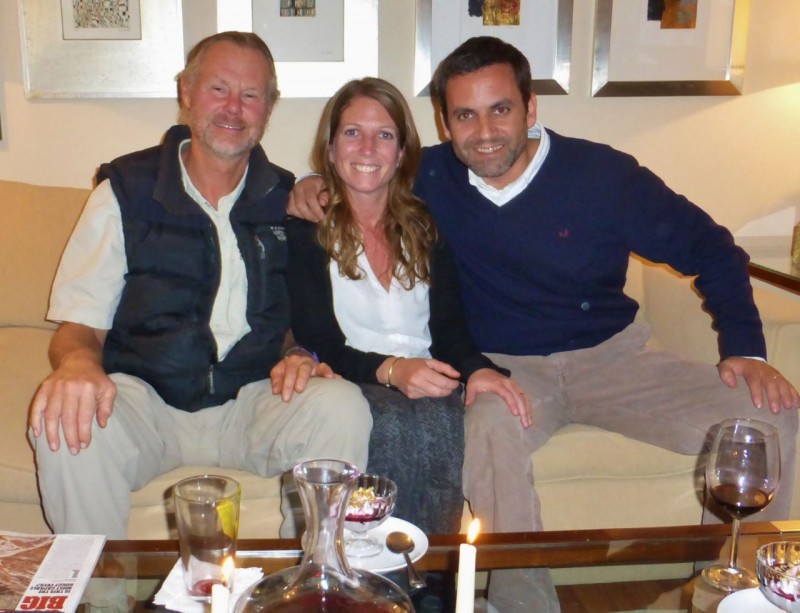
We finally got to meet our new friends, Sebastian and Luz, who were introduced to us through friends in the jeeping world. We had a wonderful meal at their beautiful home, realizing instantly that we were kindred spirits. We are looking forward to spending more time with them when we return in December.

Sebastian, ever helpful, introduced us to a friend of his who provided this cozy, temporary home for Charlotte. See you in December, Charlotte!
Catch up with us again in December when we return to take on Bolivia, Patagonia, Argentina and the very tip of the continent…Ushuaia…this time brimming with health and energy!
Special Update from Home – I’m Alive! October 15, 2014
Special Update
Minden, Nevada
October 15, 2014*
*(This post is a copy of an email alert that was sent in October)
Hi everyone, I’m alive!
Thank you all for your warm wishes, thoughts and prayers. I know it’s been a long time since you’ve heard from us, but I really wanted to report when I was 100% well. Unfortunately, it has been a rough road back to recovery. My doctors and support staff have all been amazing, but we haven’t gotten me back to fighting condition. There are still lingering symptoms and complications (which will hopefully be sorted out in the next couple of weeks), but I am a lot better. I have been able to get out for a few walks, a few errands, a few dinners out and, sadly, lots of doctor visits. Although I love our adventure and am looking forward to getting back on the road in December, I am unbelievably happy to be home while going through all of this. I have a lot of perspective to share on comfort zones in the blog I am currently working on (teaser photo of the incredible Atacama desert above). Thanks again for your many thoughtful emails, and keep your eyes out for the new blog in the next few days!
Hugs and best wishes to all of you, Kat
Special Alert from Santiago, Chile! September 24, 2014
STOP!
Ned & Kat Alert!
Santiago, Chile
September 24, 2014*
*(This post is a copy of an email alert that went out in September)
After one month of sickness, taking six different antibiotics, prescribed by seven different doctors, from five different hospitals in two separate countries, Kat is still not well and we have made the decision to get her home to her regular doctor. Besides whatever she is currently suffering from, Kat has Lyme Disease which seriously compromises her immune system. Throwing antibiotics into the mix is a recipe for long term disaster.
We want to enjoy and savor every minute of this once-in-a-lifetime trip, and for the last month we have not. We have rushed through Peru and now, northern Chile, in an attempt to get to better climates, better altitude, better weather and/or better medical facilities. While the hospitals here in Santiago, Chile have been wonderful, the doctors’ answers are typical; throw more and more drugs at the situation. We do not feel this is a smart solution for her overall health.
We had planned all along to return home for the month of November for business reasons. Now we will just add in October. Look for a blog update within a week or so to bring the site up to date with our current location in Santiago. Don’t give up on us. We will be back in action starting in December when we will get to Bolivia (which we’ve currently had to skip) and then head for Patagonia at the tip of this amazing continent, which has been our goal all along.
Fouled by Fever in Peru – Part 2

We spent three days and nights in the capital city of Lima hoping the urban, civilized environment, coupled with decent food would improve Kat’s health. She had been suffering from bronchitis, asthma and lingering influenza for over two weeks at this point. Finally we couldn’t stand our itchy feet anymore and hit the road south on the last day of August. We really are not very good at staying in one place for more than a day or two.
We decided our route for the southern half of Peru would repeat the driving route we took back in 2008 from Lima to Cusco, just to see if our opinion was different now, considering the “Peruvian Funk” we were experiencing this time. We really enjoyed this drive six years ago in our little rented Suzuki. It had been one of the highlights of a two week trip whose main goal had been to hike the Inca Trail from Cusco to Machu Picchu.
Heading south from Lima our first stop was the Reserva Nacional de Paracas west of the town of Ica. We had blown right by this area in 2008 and WOW, we had really missed something. After a night in the Paracas and an amazing drive through the dunes, we continued south to Nasca where we turned east and inland for the high Andes, arriving in Cusco at 12,000 feet, two days later. At this point we were now BOTH sick…
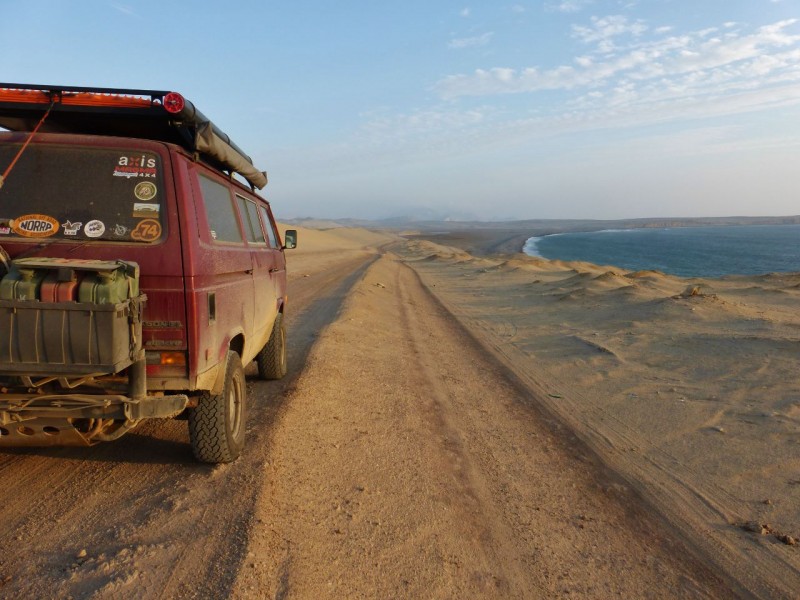
The pavement stops shortly after entering the Reserva Nacional de Paracas. At first we followed this well traveled track along the coast, marveling at the endless views.
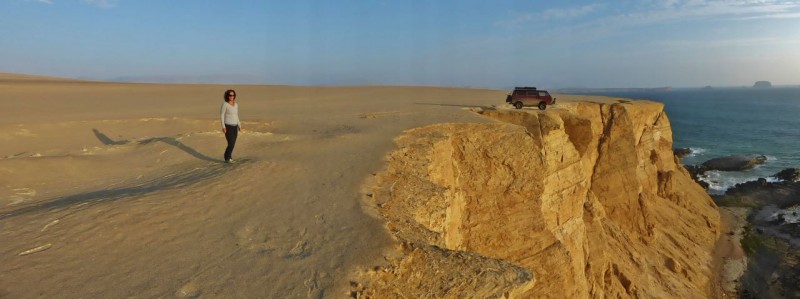
The track eventually just disappeared but we continued on, following the coastal cliffs south. Of course I couldn’t resist the challenging parking opportunities.
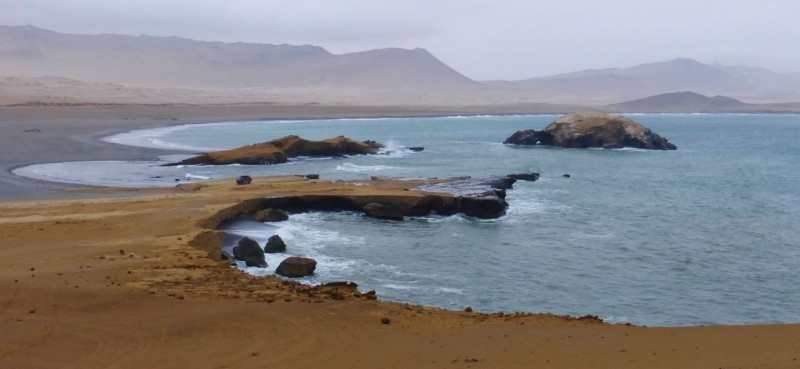
Can you spot Charlotte? This is where we camped for the night. It doesn’t get much more remote than this. Poor Kat could hardly breathe that night and the dense fog that rolled in didn’t help. I wished she were feeling better because, for me, this was one of the highlight spots of the entire trip thus far.
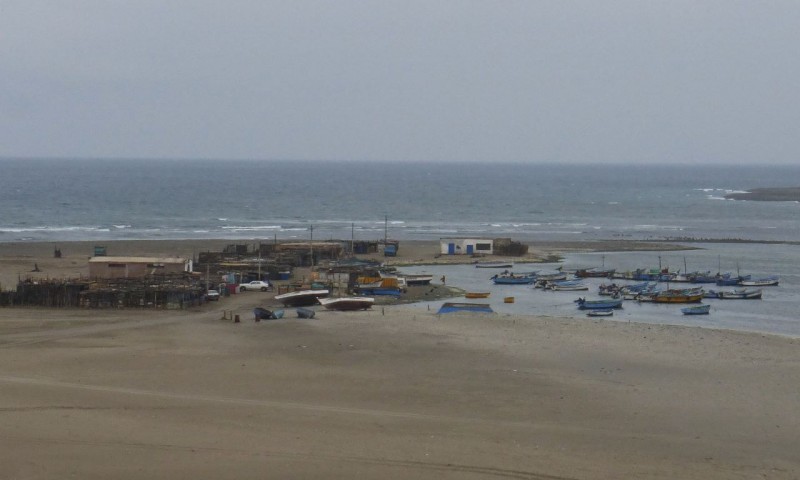
The next morning, September 1st, we continued along the coast, following a faint track and our GPS. At mid-morning we passed through this very rustic fishing village, precariously perched on a sand bar.

Wondering what was behind those tumbled down driftwood walls, I climbed on top of Charlotte for a look… more tumbled down stuff secure inside!

These km markers became our guides. We would get to one, then scan the horizon for the next, spot it and then head for it. All morning we found our way through endless sand dunes this way. For me, it was the absolute highlight 50 miles of the 18,000+ miles we have covered so far. Unfortunately, poor Kat continued to suffer and was not enjoying it half as much as I was. A pity because it is her favorite landscape too.

Eventually we drove far enough eastward and ran into the main highway again, just north if the small city of Ica. We restocked the fridge and drove out to the oasis of Huacachina, a tourist trap nestled in the middle of giant sand dunes with a scummy pond as a focal point in the center of it. We pretty much took the picture and left.

We continued south past the famous Nasca lines, through the town of Nasca and eastward into the Andean foothills where this photo was taken. The Nasca Lines consist of hundreds of huge (500+ feet across) geoglyph drawings of spiders, monkeys, birds, fish, sharks and lizards among other things, made by ancient Nasca peoples around 400 to 600AD. To really do them justice you need to go up in an airplane to see them. We were too cheap the last time we were here to do that, settling for some crummy photos taken from a hill just off the highway. This time the Peruvian Funk prevailed and we didn’t even stop for the crummy photo.

Our first spotting of a Pampa Galera or Vicuña, a critter that is smaller than a Llama and known for its soft wool coat. We remembered seeing these guys everywhere along the roadside back in 2008 and this trip confirmed they are still there – everywhere.

2014
As expected, we just weren’t digging the drive as much as the last time. Maybe it was all so new and different in 2008. We were fresh off the plane from home and on a two week vacation. This time we have been immersed in the Latin American culture and scenery for months and have gotten a bit jaded. Or maybe we just felt like crap. Kat wasn’t getting any better and I was starting to feel the hint of a fever coming on…
Anyway, in these next four shots we amused ourselves with “before and now” shots. It took forever to find the perfect spot where we had taken the same shot in 2008. Using a different camera with a different depth of field didn’t help either, but anyway, for fun here they are. Note the difference in time of year, the 2008 shots being taken in March during the rainy season.

Snow up at 18,000 plus feet. We took this shot at 15,000 feet alongside the highway. It doesn’t even snow at this “low” elevation. It should be mentioned that the trash problem that bugged us so much in the north was much less prevalent in the south. They still trash their country worse than most everywhere else we’ve been, but it’s just not as obvious in the south.
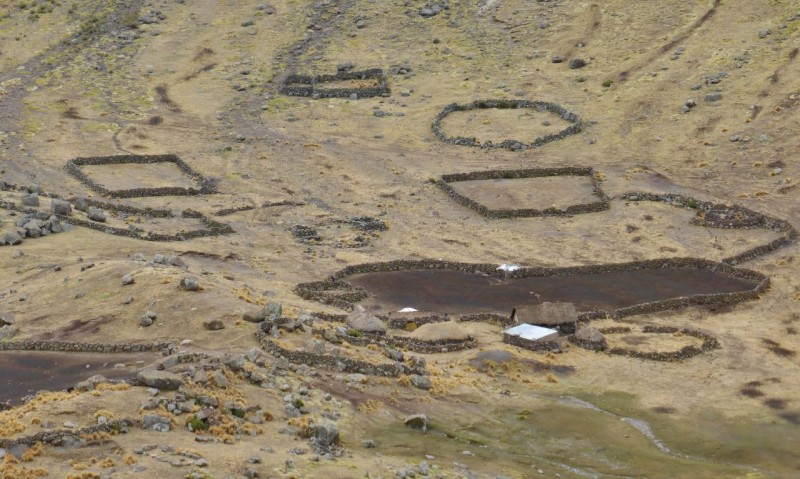
Use what you’ve got. This rather large spread shows how the local herdsman utilize the available rocks for all their fence building –and barn building –and house building.

We camped two nights en route to Cusco. The first night was on a dirt track that led to a mine. Of course we had visitors. It continues to amaze us that just when we think we are in the middle of nowhere, people appear like vapor, wondering what the hell we are doing. Of course the miners were no exception, appearing with flashlights as soon as it was too dark to see anything. They were friendly and just curious and bored, eventually leaving us alone and walking back to the mine where they were presumably guards. Around three AM, more mine workers began to pass our camp, first on motorcycles and then by the truckload, piled into smelly diesel flatbeds which ground them up the hill to another long work day. What a life.

Back in 2008 one of our favorite stops on the way to Cusco was the open air market in the town of Abancay. Despite our poorly condition, this stop could not be missed. As before, it was a magical place with the most friendly vendors and crazy sights imaginable. All you vegetarians beware of the photos below!

Kat told all the ladies I loved taking pictures of pretty girls. That accounted for some easy shots.
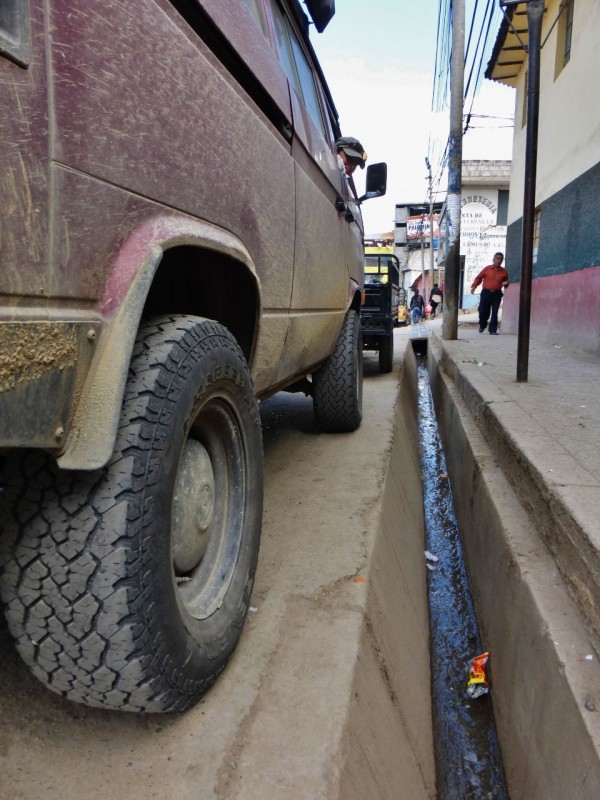
We remembered these crazy curbs from 2008, too. Puts a whole new perspective on getting parallel parking just right.
After Abancay it was just a few more hours to Cusco but everything went to hell. My fever went on a tear, making driving these windy roads a chore. Kat was passed out on the bed in back, practically comatose when Charlotte decided to get into the act and shredded all her belts on a particularly nasty cliffhanging stretch of roadway. To get to the engine the bed needs to be pulled up so there went Kat’s rest. Upon tearing into it I found the alternator mount cracked – again. Fu**ing Volkswagen design. The alternator and its mounting brackets have been the mechanical bane of the whole trip. All the mounts and the alternator were new in La Paz, Baja after our debacle with the welder alternator. Since then Charlotte in general has been a mechanical rock. The charging system has worked flawlessly except for the main power wire breaking off the alt. stud in Palenque, Mexico. Then we had belt destruction occurring around Baños, Ecuador when I first found the alternator mount cracked. I had a guy weld the cracks there but now they were back, worse than ever. In a feverish haze I installed more belts and we limped into Cusco.

The Quinta LaLa Overland campground just outside Cusco where we stayed two nights. I’m still not sure I like staying in these Overlander “coagulation” points. It seems most of the people we run into at these places are going from one guidebook recommended campground to the next, mostly hanging with others from their same country and even traveling together from one recommended safe haven to the next. Then there are all the mixed horror stories they share of places to come and what to expect/not expect. I think I prefer what Kat and I have been doing, driving blind with no guide books at all, staying wherever the end of the day finds us and mostly just conversing with locals.
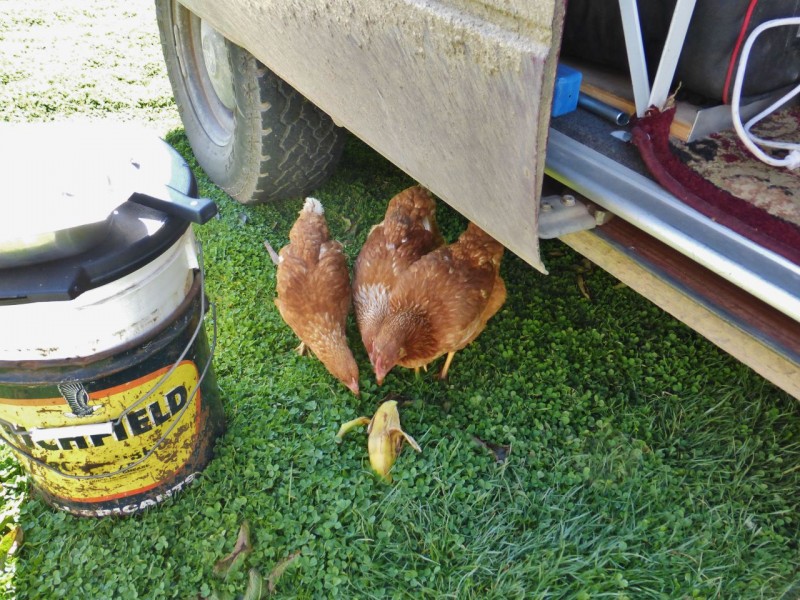
Curious chickens check out an unripe banana at the Quinta LaLa campground. A good thing about these places is the wealth of info shared, such as where to find a good welder who could fix my busted bracket. It turned out Cusco featured a mobile mechanic (via taxi) who had the market cornered on Overlanders and their problems. I jockeyed for the work time of “Juan” with several Germans who seemed in need of his services at the same time. Juan spoke pretty good English and quickly grasped my ideas on how to modify the stupid VW designed bracket and add some more strength to the wretched part, already work hardened and metal fatigued from it’s last welding session.
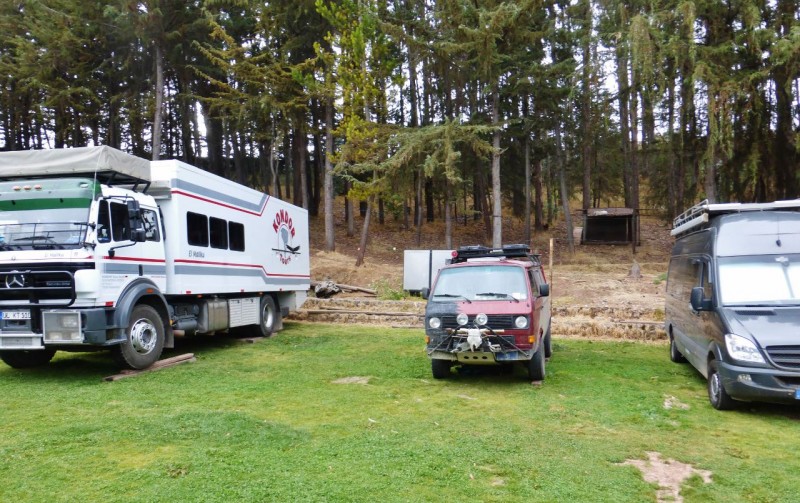
Juan needed a day and a night to perform his magic. We were both so sick now that we just lay low at the campground. The weather was freezing cold and it rained off and on the whole time. All we wanted to do was get out of there and keep going south. Any magic about being in Cusco, Peru was lost on us. The fact that we’d been here before probably added to our lack of curiosity. We had no desire to repeat a visit to the tourist trap that is Machu Picchu. Seeing it six years ago was a climatic let down compared to the four day hike on the Inca Trail we undertook to get there. We were in no shape to do the hike again and the über expensive train ride to get to MP proper wasn’t even on our radar. So we waited between these huge RVs, one from Germany and one from France, wondering how either of them could have experienced half of the places we’ve been to, just due to their sheer size.
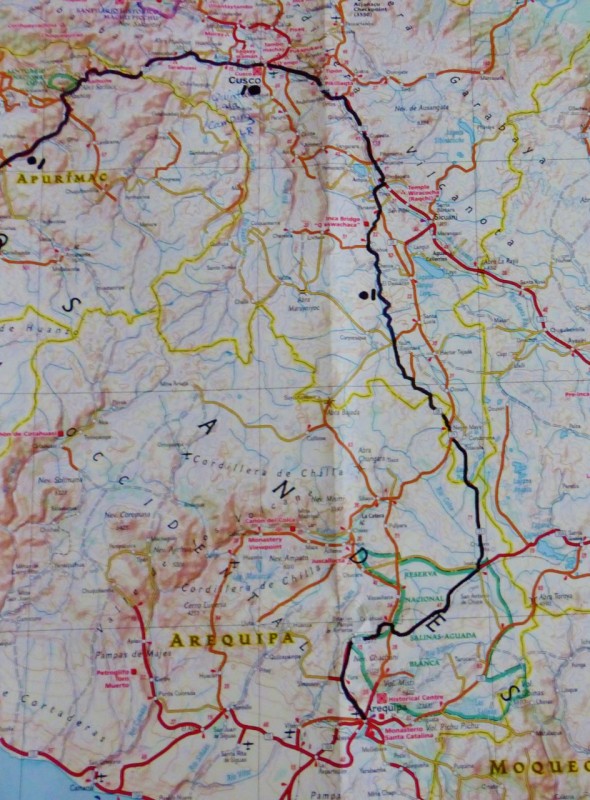
Finally the bracket was returned. Ol’ Juan added so much material to it I could barely recognize the original part. Of course all that strength added weight which had me concerned that now the weakness would just move down the line – to the two wimpy 8mm bolts that hold the thing to the engine… Still feverish, I put everything back together in a freezing rain, loaded a shaking Kat into the back and got the hell otta there, hoping that by going south, back towards the coast, it would get lower in elevation and warmer. Ha!

…and the altimeter went up! To the highest we’ve driven during the entire trip, 15,841 feet to be exact. It took us two days to drive to the city of Arequipa where we hoped to find a decent hospital if needed. Kat had been sick for almost a month now, even after being on two different sets of antibiotics. I lost the fever after three days, but was left with the same nasty cough and congestion as Kat and had a somewhat small elephant sitting on my chest 24/7. I think we had the worst driving day of the trip the second day out of Cusco. We’d spent a freezing night hidden behind a small knoll alongside the road. The icy fog was our best camouflage. The next day the road deteriorated into muddy slop, coating Charlotte top to bottom in a milkshake-like goo. Kat was out cold on the bed and I drove in a fever induced, delirious haze, pretty much akin to the mud covering all of Charlotte’s windows. Then the road ahead appeared blocked by several semis all stuck in the mud attempting to climb a small hill with their huge loads. As I stepped out into the ankle deep goo to access the situation, I discovered our left rear tire completely disintegrated, it was nothing but a muddy blob attached to the rim. In my weakened, high feverish state it took me over two hours to change that stupid tire. I guess it didn’t help that we were at 15,500ft and I already couldn’t breathe thanks to my goop filled chest. I was so covered in mud and so disgusted I never even took a picture. We rolled into Arequipa late in the day and found a nice hotel in the old colonial part of town. How they let us in and allowed Charlotte into their garage is beyond me. We left a trail of mud all the way to our room. I had to ask them for a hose to wash the mud off of Charlotte’s shift linkage. I couldn’t get her into reverse to pull into the garage!

And so here we are in Arequipa, Peru, less than 100 miles from Chile and once again hanging in a city we don’t want to be in while we attempt to get well. After spending the day getting a new tire and caving in to having Charlotte professionally washed for the first time since leaving home (the rains had been doing a pretty good job up until the mud bath) I found Kat in the emergency room of a third world clinic looking like this. She had spiked another high fever and had dragged herself into a taxi and gone in search of answers. Instead, she found a complete lack of English spoken, substandard, shabby facilities, dirty bathrooms with no soap or towels and total confusion. When I arrived she was dazedly looking back and forth between two different doctors, neither of whom could agree (in Spanish) on what was wrong with her. One kept asking if her stomach still hurt, conjecturing that it could be E. coli from Peruvian cheese (!), and the other insisted it was a bladder infection! Since she had already given detailed information about her RESPIRATORY symptoms, we couldn’t figure out where the gut diagnoses came from! I could read her face at that point, silently screaming, “Get me the _____ out of here!” Finally, they listened to her re-explain her condition and, despite telling her that her chest X-Ray and blood tests were fine, sent her off with yet a third round of antibiotics. We went back to the hotel disgusted and frustrated with Peru overall. At this point we just wanted to get to Chile. Maybe things would change in Chile…
Fouled by Fever in Peru – Part 1
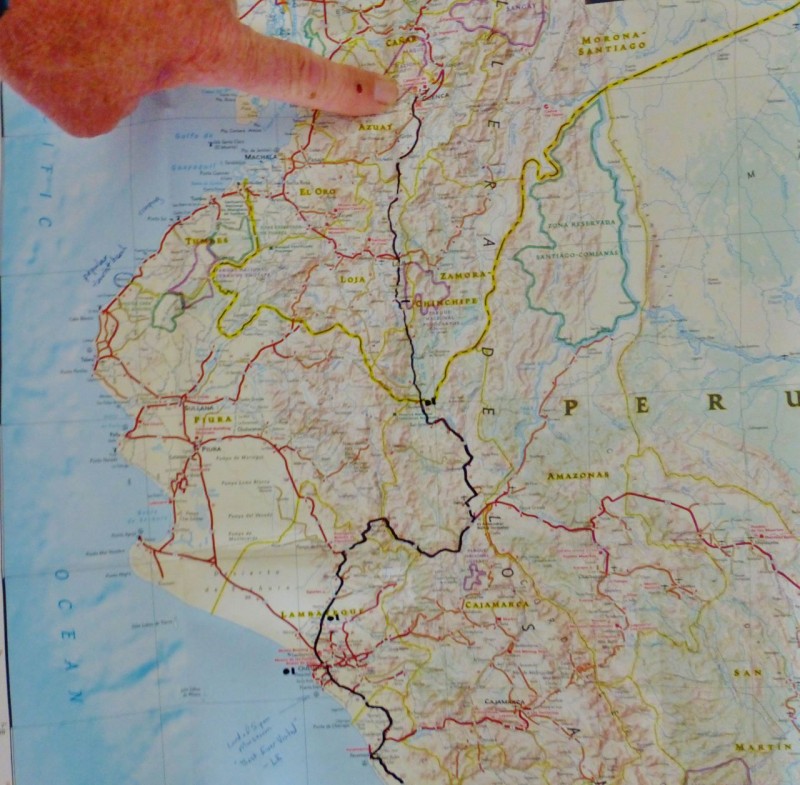
Once back on the mainland of Ecuador after our amazing week in the Galapagos, we headed to the small city of Cuenca to visit our new friends, the Schneewinds. From Cuenca we traveled windy, mountainous roads to the quirky, gringo-ized town of Vilcabamba where we stayed four days in a cute, walled compound with our own private cabin complete with porch and parking for Charlotte. It was very relaxing and we hated to leave for the Peruvian border. Maybe we should have stayed…
Since Cuenca, Kat had started feeling weak, had a mild fever and was showing signs of bronchitis. We crossed the border (yellow with black dotted line on map) on August 22nd and entered Peru, our 13th country. Kat and I traveled in southern Peru in 2008 and loved it, but we knew nothing about the northern part of the country. With Kat’s condition worsening, I drove down out of the mountains towards the coast, hoping the lower elevation would help her breathing. Along the way we passed through one dingy town after another, all full of garbage riddled streets, uninviting smells and unhappy looking people. We stayed one night in a hotel in the unexciting city of Chiclayo, hoping Kat would get better, (no luck) and one night camped in the most disgusting “horse resort” where the animals were mistreated and everything we touched, including the ground the place sat on, felt like it was giving us a disease. The only humor to that night was being awakened to a dreadful racket on Charlotte’s roof and the whole vehicle shaking. Looking out I found a goat on her roof! We did have one outstanding cultural experience while in this area when we visited the Lord of Sipán museum in the town of Lambyeque. Unfortunately we were not allowed to take any pictures of this museum, which is said to be one of the top ten in the world. We found it to be a spectacular presentation of the burial rituals of the Moche peoples who inhabited this region 1700 years ago. Google it for more info and to see illicit pictures. We continued south along the coast, hoping for nicer conditions and better health for Kat, but the filth continued and a kind of third world funk was settling over us.
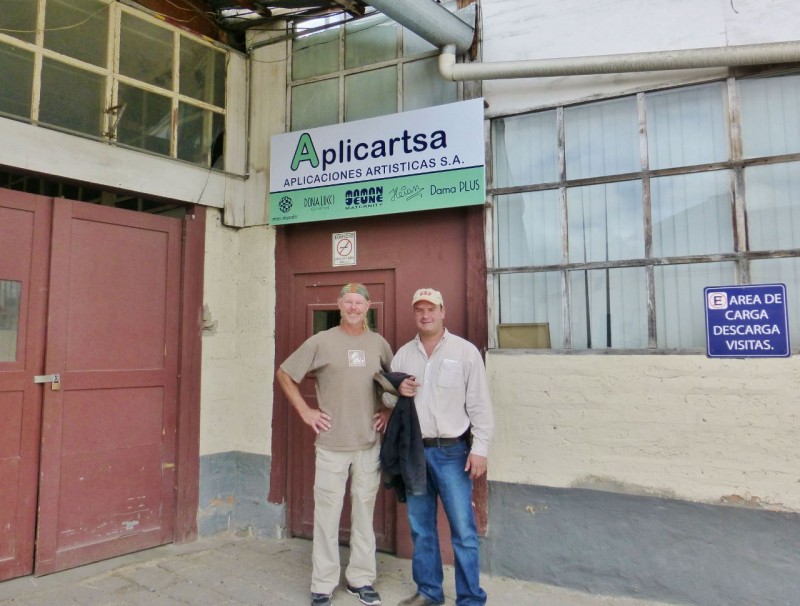
Hans Schneewind is a second generation Ecuadorian. His grandfather emigrated from Germany to Cuenca and started a clothing manufacturing business. The Scheewinds you’ll remember from our earlier Ecuador blog, (you ARE reading every one, correct?) we met on the beach, when Hans admired Charlotte as we drove by the family’s rented beach house looking for a camping spot. We promised to visit them when we passed through their home town of Cuenca.
Hans took time out of his busy day to give us a tour of his clothing factory.

The factory specializes in children’s school uniforms and doing embroidering of garments for other, larger factories in the area. There seemed to be a lot of manual, tedious work going on. Hans explained that the gals who work here make US$342 per month and that’s a high wage!
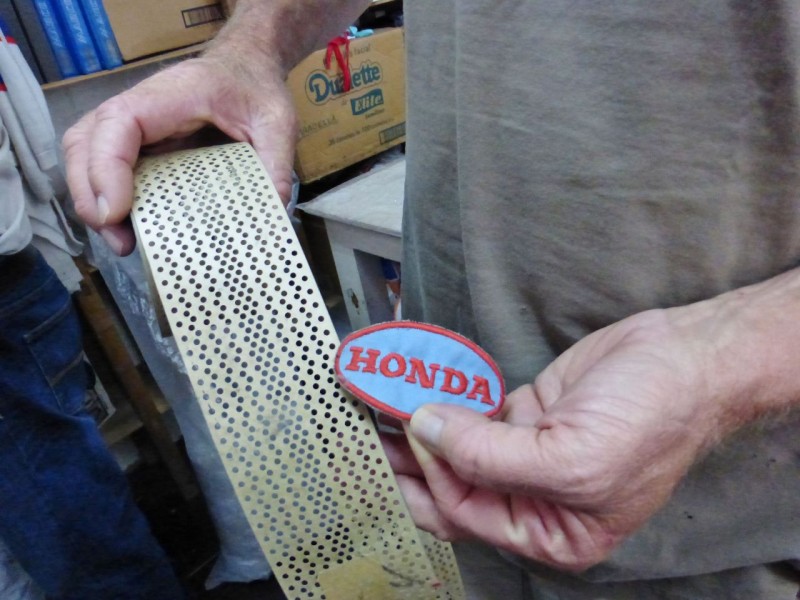
But less than fifteen years ago, embroidery was created by a mechanical machine that read a ticker-tape like strip. The code on this strip produced this little Honda patch. Hans showed us shelves full of hundreds of these now obsolete tapes. It their day, each tape cost the company US$6,000 each and was only good for one style of patch.
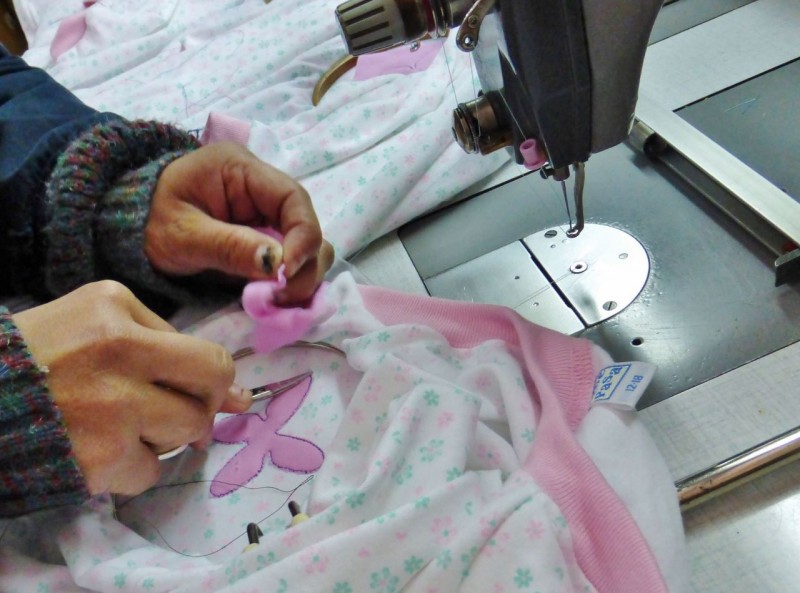
The hand work going on was amazing. After the pink star-like thingy was sewn onto the garment by a machine, a lady hand cut away the excess material with manicure succors, one after the other, all day.

We camped one night in Hans and Elizabeth’s driveway, playing our favorite new game “Rummikub” with them late into the night. Hans’ pride and joy is his immaculate bay window Westfalia which his father originally purchased in the ‘70s. Charlotte’s road weary body and paint looked pretty sad by comparison.

Our next stop after leaving Cuenca was the Parque Nacional Podocarpus where we camped one night. We actually snuck in after hours, spent the night and went for a hike the next morning. This shot was taken when we tried to leave, got busted and had to pay the entrance fee.
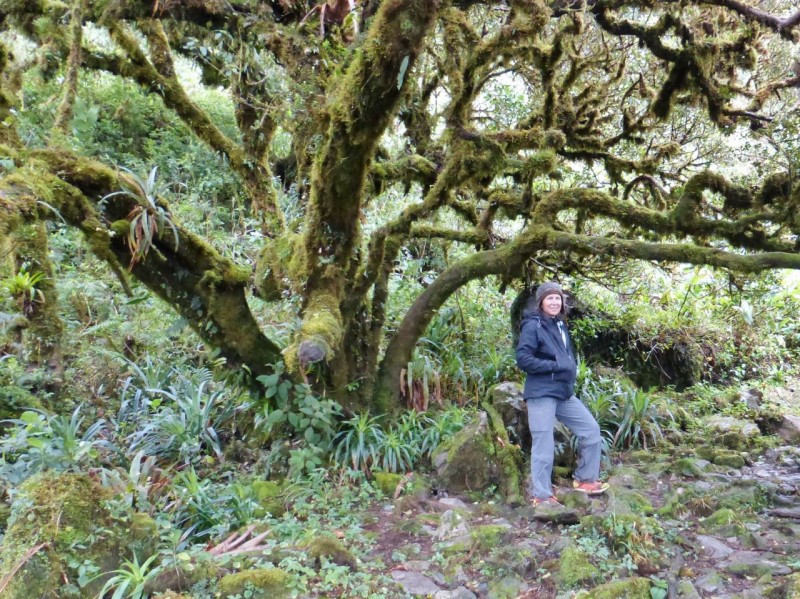
The hike was only 5km, just over 3 miles, and should have been a piece of cake. Yeah right. After hiking straight up for two hours only to reach freezing cold winds and socked in clouds, we ashamedly turned tail and beat it back down the way we had come. This bus livin’ has destroyed whatever fit condition we used to be in. In fairness to Kat, this was the first day she was starting to feel bad, so we’ll blame “our” poor performance on that!
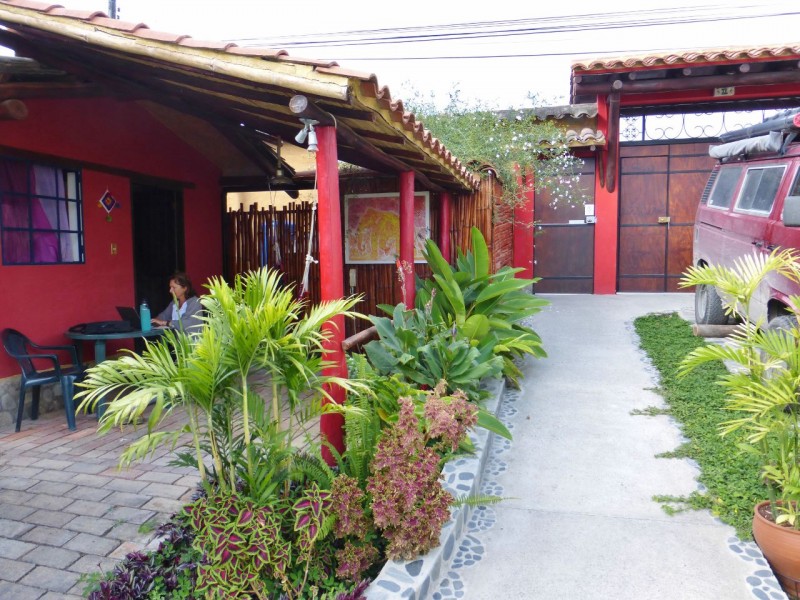
These were our digs in Vilcabampa at the Rendez-Vous. We had our own little cabin, a porch with a handy hammock and Charlotte within reach. Best of all it was $28 a night including breakfast! We should have stayed longer.

Although we diss on towns that seem too touristy or “gringo-ized,” lately we seem to be gravitating towards them for good food if nothing else. Vilcabampa featured several awesome eateries. This seafood paella with homemade Sangria cost 21 bucks and was to die for at a Basque restaurant owned by an ex-pat Spanish lady.

Another favorite was this bacon stuffed gnocchi with scampi (foreground) and homemade vegetarian ravioli (on my fork) all made with local, organic ingredients. These delectable yummies were found at an earthy little corner outfit owned by a Swiss chef and his Spanish wife. This meal, complete with local beer and a big salad set us back 25 bucks.
Like I said, towns full of foreigners are generally cleaner and have great food, but in spite of enjoying Vilcabampa, we kinda had to laugh quietly at the town’s adopted inhabitants. They mostly appeared to be old hippies who burned themselves out long ago and were now looking to re-find their youth by hanging out in a backwater Ecuadorian village, waiting to discover who they really are. Vilcabampa is reputably known for its magical “qualities” which have produced longevity among the local tribes, some reported to be 120 plus years old. So the burnt out ex-pats sit around the square, drinking organic beer and smoking healthy grown-in-Vilcabampa cigarettes, eating at the health food juice bar (which appeared to be making a killing) and paying to bathe in the healing waters from the creek up the canyon. All the while they wait for their youth to return.
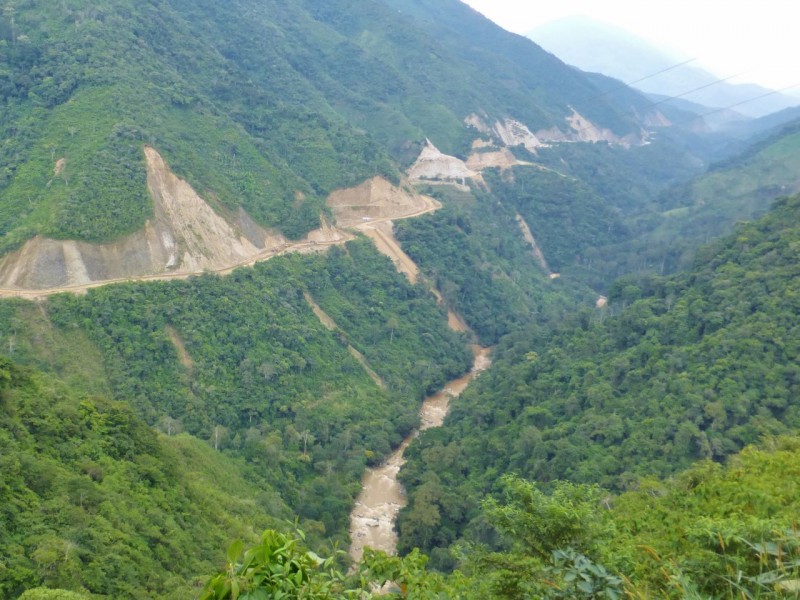
The road from Vilcabampa to the remote Peruvian border crossing at La Balsa. Charlotte got her muddiest yet on this road, which was full of construction. It took seven hours to cover about 80 miles.

La Balsa was the sleepiest, quietest border crossing ever. We were the only vehicle crossing into Peru and it appeared there hadn’t been another in quite a while. The Peruvian guard was so slow on his computer that we jumped in and filled out some of the forms for him! He also appeared colorblind as he never did figure out Charlotte’s color but asked us what it was repeatedly. By the time he was finished it was dark, so we asked him if we could camp on the “lawn” in front of the border hut. No problem! The whole experience was such a switch from our usual border experiences where we have crossed fingers for no trip halting red tape, and can’t wait to get as far away from the area as quickly as possible.
We spent a peaceful night, except for around 4am when we were awakened by the sound of horrible, native singing accompanied by top volume, Peruvian rap music. (For lack of a better description) We both peaked out, expecting to see some kid in a car parked with his stereo blaring. Instead, in the single yellow street light, we viewed two guys and a donkey ambling down the street. The donkey had a boom box strapped to its back. Welcome to Peru.

Northern Peruvian roads are littered with these Moto-Taxis which are darting everywhere, making driving among them hellish.

At one point we were starving so we stopped for a local meal at this open-air restaurant. Whatever they were cooking was bubbling away in huge pots, heated by a wood fire below.

This one is for Colin at Mac’s Tie Downs. Always keep a firm hand on your load, least it fall off on the next pothole!

Working our way down the coast we stopped in the beach resort town of Huanchaco, just above Trujillo on the map. Further south we headed inland through the beautiful Cañon del Pato (Duck Canyon) and along the snow capped mountains of the Cordillera Blanca.

Several Overlanders’ blog sites we’ve been following all highly recommended visiting Huanchaco for its amazing surf and unique reed rafts used by the local fishermen for centuries. I don’t know what we’re missing here, but we found the place filthy, with flat surf and no fisherman fishing, just the famous boats propped up for tourist photos. From the color and texture of the ocean I wouldn’t be quick to eat any of the fish that came from these waters. Note the dead pelican on the beach next to beachgoers who seemed to think nothing of it.
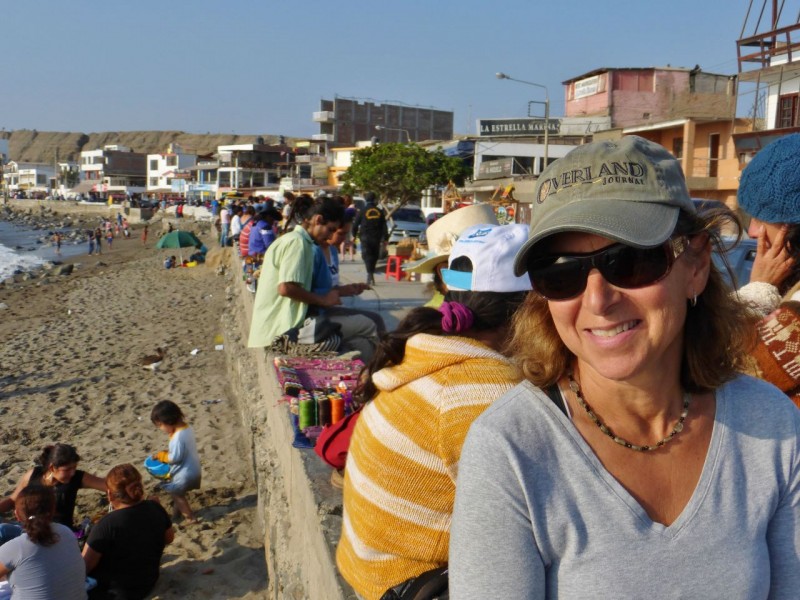
We put on our best smiles and strolled the Malicon, looking for the allure. All we found was a dirty beach, cheap trinkets and bad smelling food. The next day, Kat’s fever and coughing, complicated by asthma, prompted her to see a local doctor who prescribed antibiotics.
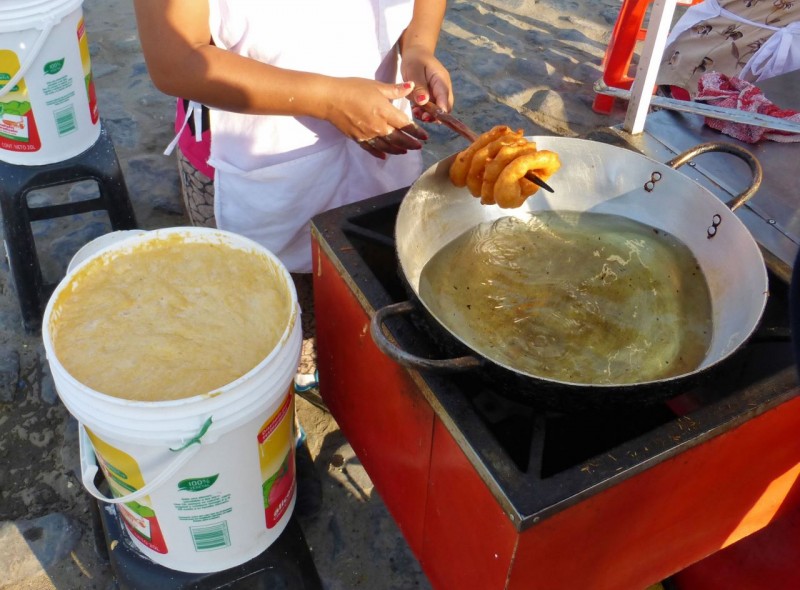
Never did get the name of these things but they started out in the bucket on the left. A finger was stuck into the sticky paste, whipped in a circular motion and flicked out, producing a round blob of the stuff which was then flung into the bubbling grease and fried into a kind of lumpy donut. They were served with syrup and people were eating them like mad. I guess we’re missing the Peruvian experience ‘cause neither one of us wanted anything to do with them.
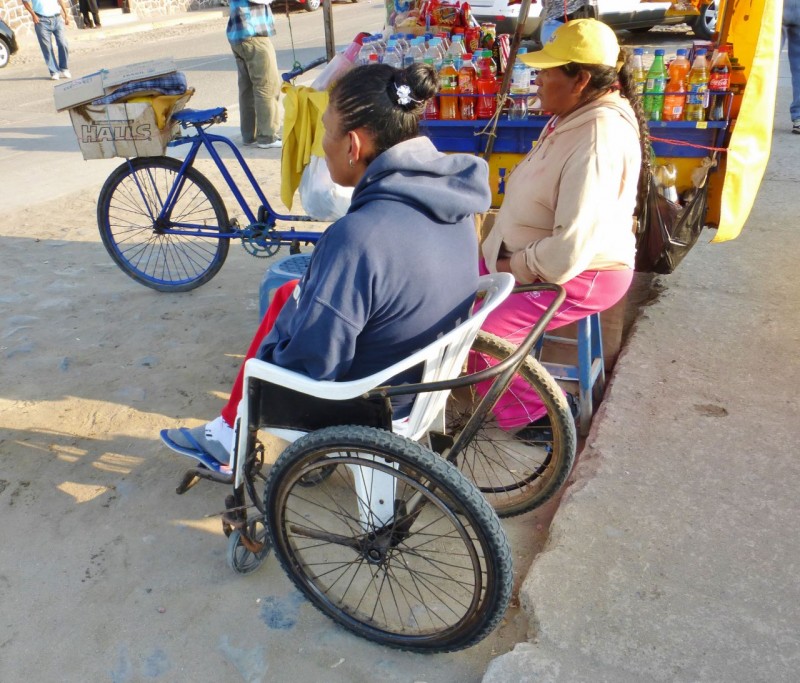
This was cool. We spotted this very well worn Free Wheelchair Mission wheelchair and its owner parked along the street in Huanchaco. Kat and I have been big supporters of this organization, even traveling to El Salvador a few years ago to deliver the chairs. You can find more info on this charity elsewhere on our web site. I couldn’t get a face shot of this woman as she hid in shame when I tried, and mentioning FWM resulted in blank stares. No matter, the point is she was out in the world, experiencing life, instead of shut away and forgotten in a dark corner somewhere, all because of a $78 wheelchair given to her thanks to some anonymous donor.

It’s not every day you have a camp spot with turtles coming by to visit. This guy seems to be looking at Vaca Muerta in the same way many humans do… huh??

This has to be the best starter castle we’ve come across. Yes, the guy in the brown coat actually lives here, squatting on this cliff side.

It continues to amaze us how one soul can work so hard to have a nice looking place, complete with a little “yard” in front, while the next door neighbor’s place is a complete dump. But I guess it’s like that all over the world.
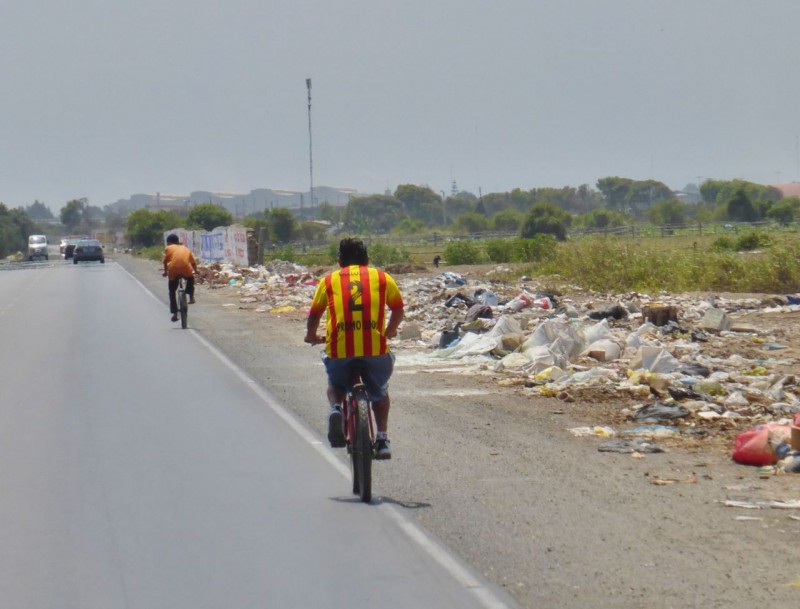
I hate to keep harping on the filth, but really? This was a common scene everywhere near urban centers in northern Peru.
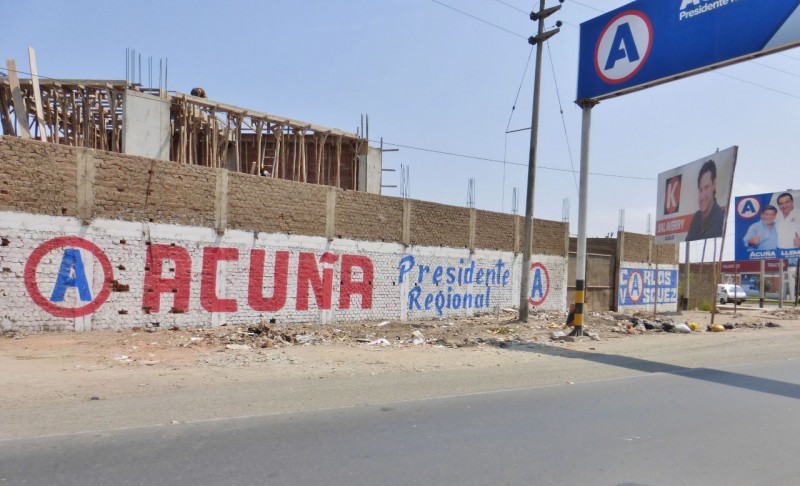
Another common scene was these huge political campaign “posters” hand painted everywhere. Wonder if Acuña, if he gets elected, will do something about all the trash in front of his sign.

We left the coast north of Chimbote and headed into the vast barren desert that makes up much of the Peruvian coastline. This terrain is our favorite, reminding us of our beloved Nevada deserts and the wilds of Baja. We were overjoyed to be driving along endless straight roads through empty nothingness. No more windy mountain passes. No more jungle and rain forests. No more rain. Well, at least not for a few days.
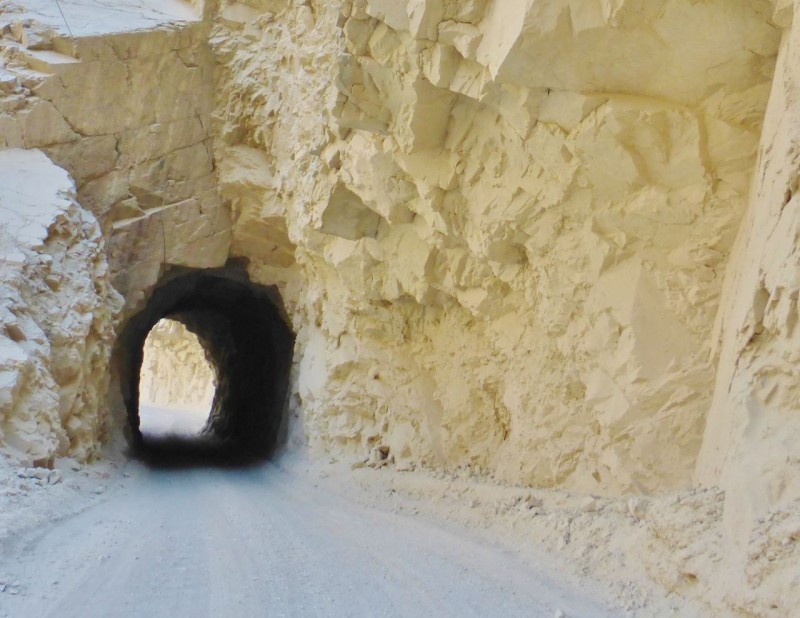
The drive through the desert let us into Cañon del Pato which features over 40 hand dug tunnels, allowing the single lane road to pass through the unbelievable landscape.

We’ve never seen these cute little guys before – or since. They were only about six inches tall and almost as round. These were the only ones we saw.

You’ve gotta wonder how bright you are to be driving around on roads where all the locals have wire mesh guards on the tops of their vehicles to protect them from falling rocks.
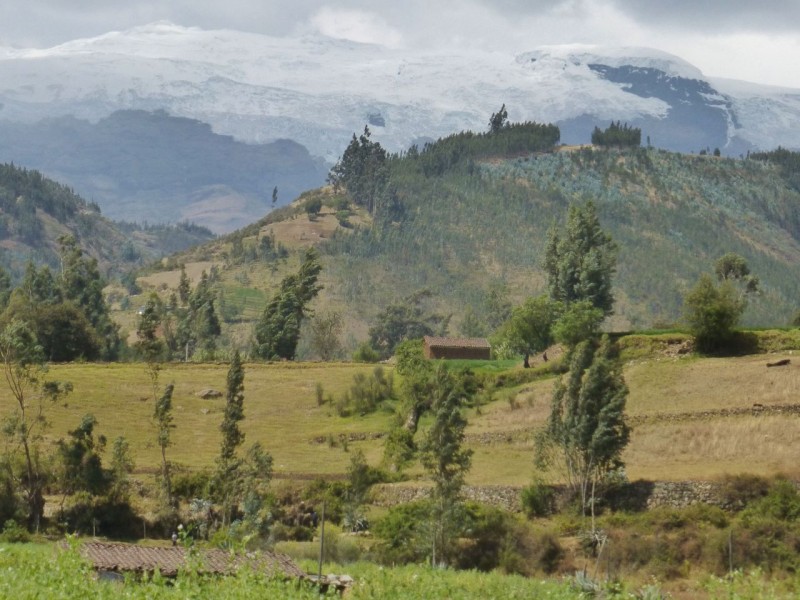
This was about the only shot we took of the snows of the Cordillera Blanca. There were numerous remote roads that led up into these mountains and stories of great hiking and rock climbing in the area. However, our funk was worsening along with Kat’s breathing, so we just kept on moving. The drive through Duck Canyon made this run inland well worthwhile, but we hardly did the area justice, missing plenty of cool stuff I’m sure.

From the Cordillera Blanca we drove west again, back to the coast and back into our favorite desert terrain. Then we headed south along the barren coast to the capital city of Lima where we hoped a stay in a nice hotel in an urban environment would shake Kat’s illness and our increasing Peruvian funk.

An interesting “sandwich” I had one day. The yellow was cold mashed potato with chicken, avocado and tomato sandwiched inside, different and pretty good. Inka Cola, a Peruvian standard since 1939, made with real coca leaves.
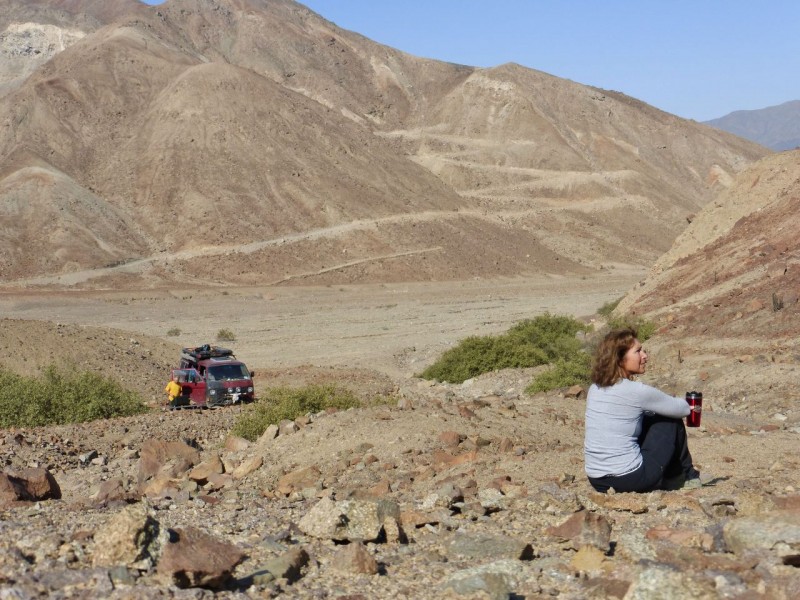
Camped back in the desert, I made us breakfast while Kat was banished from my kitchen. Still feeling like crap, she amused herself by taking timed photos of the scene.
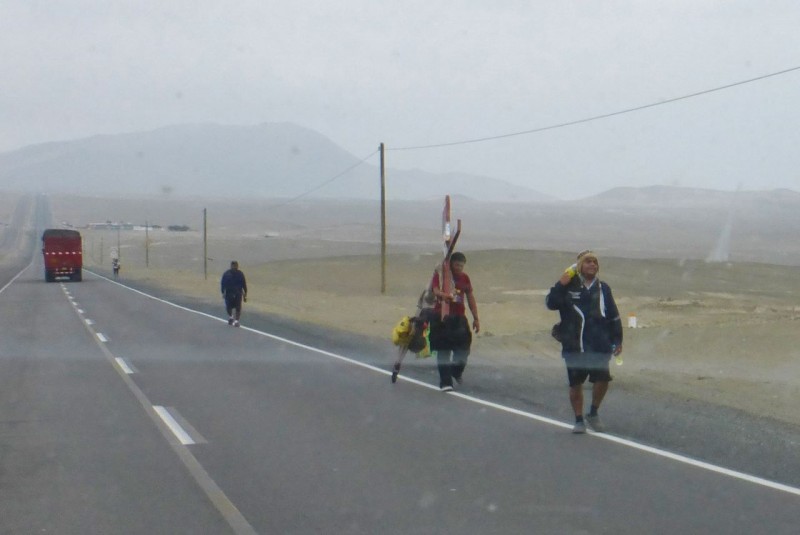
Along the Pan Am heading toward Lima we passed dozens of religious pilgrims walking north. Some were hauling huge crosses with a wheel affixed to their end to ease in dragging them along.
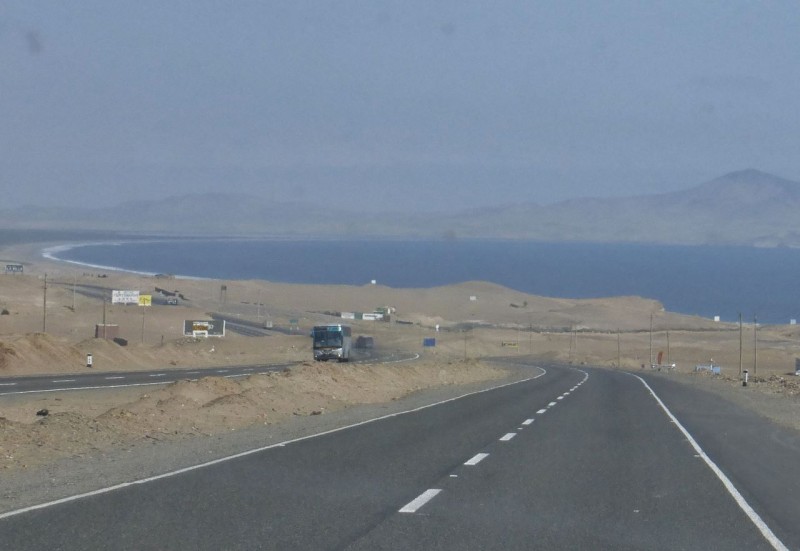
Close to Lima the roads improved to probably the best we’ve seen in 18,000 miles. Four lanes, no traffic and beautiful views of the Pacific lifted our spirits somewhat.

The view from our hotel room in the Miraflores area of Lima, where we stayed three nights, hoping a dose of the modern world would shake off the funk. It helped, but Kat continued to cough, despite the antibiotics, and I continued to wonder when I was going to catch this thing, living in such close quarters… At this point she’d been suffering for 11 days with what we’d decided was a respiratory flu.
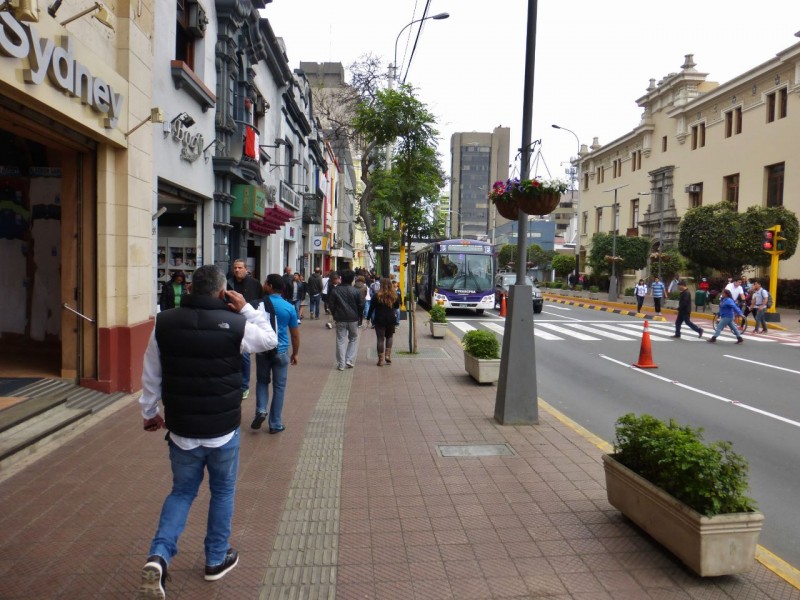
We wandered around the high end Miraflores area a bit, taking in the urban sites. We even went to a movie and a department store –whoohoo! Kat rested in the hotel while I changed Charlotte’s oil and rotated her tires in a deserted parking lot down by the beach. At 18,000 miles and counting, this was the fourth time I’ve performed this ritual.

For a country so covered in its own trash, we found it particularly interesting to see a city worker hand scraping chewing gum off the sidewalk!

This Swiss (!) place around the corner from our hotel quickly became our favorite restaurant. It was so good we stayed another day in Lima just to have dinner there again.

For once we don’t have pictures of the food because we ate it too quickly. These were our favorite waitresses at the Swiss place who couldn’t have been cuter. Shirley, in the middle was Peruvian and named thus because her parents liked Shirley Temple. Antonia was from Romania and had come to Lima with a boyfriend who had subsequently dumped her. She had been in Peru for two years but said she was sad and lonely and was thinking of going the join her mother in Germany, but didn’t look forward to it because she thought Germans were so cold. We wanted to adopt her! Here was this cute young girl with no country, no home, no family and looking at a dim future in a country she didn’t want to live in. We are so lucky to be Americans.
Watch for Peru Part II to find out if the southern half of the country lifts the funk. Does Kat get better? Do I get sick? Stay tuned!
